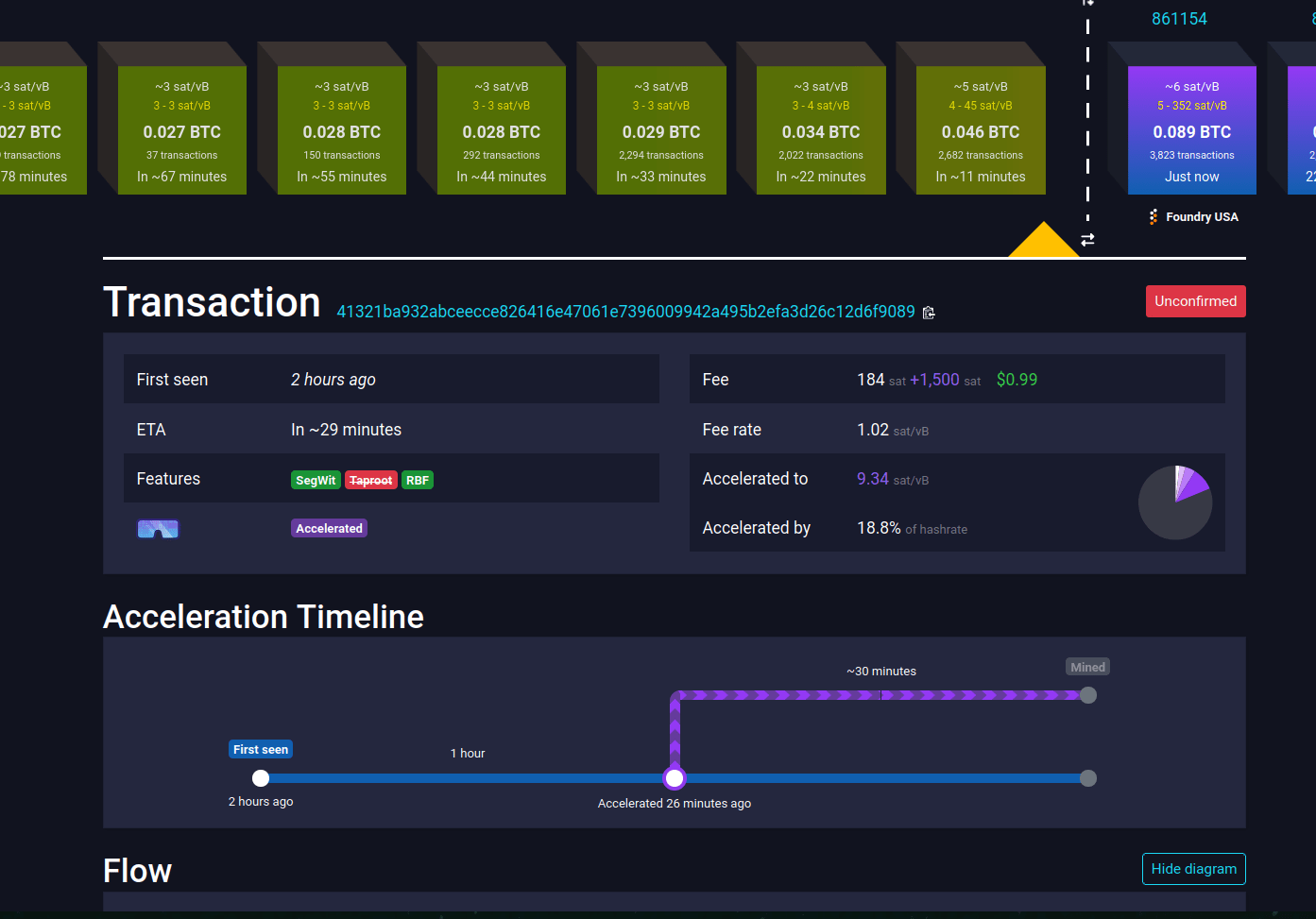-
 @ a95c6243:d345522c
2024-11-08 20:02:32
@ a95c6243:d345522c
2024-11-08 20:02:32Und plötzlich weißt du:
Es ist Zeit, etwas Neues zu beginnen
und dem Zauber des Anfangs zu vertrauen.
Meister EckhartSchwarz, rot, gold leuchtet es im Kopf des Newsletters der deutschen Bundesregierung, der mir freitags ins Postfach flattert. Rot, gelb und grün werden daneben sicher noch lange vielzitierte Farben sein, auch wenn diese nie geleuchtet haben. Die Ampel hat sich gerade selber den Stecker gezogen – und hinterlässt einen wirtschaftlichen und gesellschaftlichen Trümmerhaufen.
Mit einem bemerkenswerten Timing hat die deutsche Regierungskoalition am Tag des «Comebacks» von Donald Trump in den USA endlich ihr Scheitern besiegelt. Während der eine seinen Sieg bei den Präsidentschaftswahlen feierte, erwachten die anderen jäh aus ihrer Selbsthypnose rund um Harris-Hype und Trump-Panik – mit teils erschreckenden Auswüchsen. Seit Mittwoch werden die Geschicke Deutschlands nun von einer rot-grünen Minderheitsregierung «geleitet» und man steuert auf Neuwahlen zu.
Das Kindergarten-Gehabe um zwei konkurrierende Wirtschaftsgipfel letzte Woche war bereits bezeichnend. In einem Strategiepapier gestand Finanzminister Lindner außerdem den «Absturz Deutschlands» ein und offenbarte, dass die wirtschaftlichen Probleme teilweise von der Ampel-Politik «vorsätzlich herbeigeführt» worden seien.
Lindner und weitere FDP-Minister wurden also vom Bundeskanzler entlassen. Verkehrs- und Digitalminister Wissing trat flugs aus der FDP aus; deshalb darf er nicht nur im Amt bleiben, sondern hat zusätzlich noch das Justizministerium übernommen. Und mit Jörg Kukies habe Scholz «seinen Lieblingsbock zum Obergärtner», sprich: Finanzminister befördert, meint Norbert Häring.
Es gebe keine Vertrauensbasis für die weitere Zusammenarbeit mit der FDP, hatte der Kanzler erklärt, Lindner habe zu oft sein Vertrauen gebrochen. Am 15. Januar 2025 werde er daher im Bundestag die Vertrauensfrage stellen, was ggf. den Weg für vorgezogene Neuwahlen freimachen würde.
Apropos Vertrauen: Über die Hälfte der Bundesbürger glauben, dass sie ihre Meinung nicht frei sagen können. Das ging erst kürzlich aus dem diesjährigen «Freiheitsindex» hervor, einer Studie, die die Wechselwirkung zwischen Berichterstattung der Medien und subjektivem Freiheitsempfinden der Bürger misst. «Beim Vertrauen in Staat und Medien zerreißt es uns gerade», kommentierte dies der Leiter des Schweizer Unternehmens Media Tenor, das die Untersuchung zusammen mit dem Institut für Demoskopie Allensbach durchführt.
«Die absolute Mehrheit hat absolut die Nase voll», titelte die Bild angesichts des «Ampel-Showdowns». Die Mehrheit wolle Neuwahlen und die Grünen sollten zuerst gehen, lasen wir dort.
Dass «Insolvenzminister» Robert Habeck heute seine Kandidatur für das Kanzleramt verkündet hat, kann nur als Teil der politmedialen Realitätsverweigerung verstanden werden. Wer allerdings denke, schlimmer als in Zeiten der Ampel könne es nicht mehr werden, sei reichlich optimistisch, schrieb Uwe Froschauer bei Manova. Und er kenne Friedrich Merz schlecht, der sich schon jetzt rhetorisch auf seine Rolle als oberster Feldherr Deutschlands vorbereite.
Was also tun? Der Schweizer Verein «Losdemokratie» will eine Volksinitiative lancieren, um die Bestimmung von Parlamentsmitgliedern per Los einzuführen. Das Losverfahren sorge für mehr Demokratie, denn als Alternative zum Wahlverfahren garantiere es eine breitere Beteiligung und repräsentativere Parlamente. Ob das ein Weg ist, sei dahingestellt.
In jedem Fall wird es notwendig sein, unsere Bemühungen um Freiheit und Selbstbestimmung zu verstärken. Mehr Unabhängigkeit von staatlichen und zentralen Institutionen – also die Suche nach dezentralen Lösungsansätzen – gehört dabei sicher zu den Möglichkeiten. Das gilt sowohl für jede/n Einzelne/n als auch für Entitäten wie die alternativen Medien.
Dieser Beitrag ist zuerst auf Transition News erschienen.
-
 @ a95c6243:d345522c
2024-10-26 12:21:50
@ a95c6243:d345522c
2024-10-26 12:21:50Es ist besser, ein Licht zu entzünden, als auf die Dunkelheit zu schimpfen. Konfuzius
Die Bemühungen um Aufarbeitung der sogenannten Corona-Pandemie, um Aufklärung der Hintergründe, Benennung von Verantwortlichkeiten und das Ziehen von Konsequenzen sind durchaus nicht eingeschlafen. Das Interesse daran ist unter den gegebenen Umständen vielleicht nicht sonderlich groß, aber es ist vorhanden.
Der sächsische Landtag hat gestern die Einsetzung eines Untersuchungsausschusses zur Corona-Politik beschlossen. In einer Sondersitzung erhielt ein entsprechender Antrag der AfD-Fraktion die ausreichende Zustimmung, auch von einigen Abgeordneten des BSW.
In den Niederlanden wird Bill Gates vor Gericht erscheinen müssen. Sieben durch die Covid-«Impfstoffe» geschädigte Personen hatten Klage eingereicht. Sie werfen unter anderem Gates, Pfizer-Chef Bourla und dem niederländischen Staat vor, sie hätten gewusst, dass diese Präparate weder sicher noch wirksam sind.
Mit den mRNA-«Impfstoffen» von Pfizer/BioNTech befasst sich auch ein neues Buch. Darin werden die Erkenntnisse von Ärzten und Wissenschaftlern aus der Analyse interner Dokumente über die klinischen Studien der Covid-Injektion präsentiert. Es handelt sich um jene in den USA freigeklagten Papiere, die die Arzneimittelbehörde (Food and Drug Administration, FDA) 75 Jahre unter Verschluss halten wollte.
Ebenfalls Wissenschaftler und Ärzte, aber auch andere Experten organisieren als Verbundnetzwerk Corona-Solution kostenfreie Online-Konferenzen. Ihr Ziel ist es, «wissenschaftlich, demokratisch und friedlich» über Impfstoffe und Behandlungsprotokolle gegen SARS-CoV-2 aufzuklären und die Diskriminierung von Ungeimpften zu stoppen. Gestern fand eine weitere Konferenz statt. Ihr Thema: «Corona und modRNA: Von Toten, Lebenden und Physik lernen».
Aufgrund des Digital Services Acts (DSA) der Europäischen Union sei das Risiko groß, dass ihre Arbeit als «Fake-News» bezeichnet würde, so das Netzwerk. Staatlich unerwünschte wissenschaftliche Aufklärung müsse sich passende Kanäle zur Veröffentlichung suchen. Ihre Live-Streams seien deshalb zum Beispiel nicht auf YouTube zu finden.
Der vielfältige Einsatz für Aufklärung und Aufarbeitung wird sich nicht stummschalten lassen. Nicht einmal der Zensurmeister der EU, Deutschland, wird so etwas erreichen. Die frisch aktivierten «Trusted Flagger» dürften allerdings künftige Siege beim «Denunzianten-Wettbewerb» im Kontext des DSA zusätzlich absichern.
Wo sind die Grenzen der Meinungsfreiheit? Sicher gibt es sie. Aber die ideologische Gleichstellung von illegalen mit unerwünschten Äußerungen verfolgt offensichtlich eher das Ziel, ein derart elementares demokratisches Grundrecht möglichst weitgehend auszuhebeln. Vorwürfe wie «Hassrede», «Delegitimierung des Staates» oder «Volksverhetzung» werden heute inflationär verwendet, um Systemkritik zu unterbinden. Gegen solche Bestrebungen gilt es, sich zu wehren.
Dieser Beitrag ist zuerst auf Transition News erschienen.
-
 @ 2063cd79:57bd1320
2024-11-29 07:34:58
@ 2063cd79:57bd1320
2024-11-29 07:34:58Ganz laienhaft gesprochen, sind Derivate Finanzprodukte, die auf einem Basisprodukt basieren (in unserem Fall ist dieses Basisprodukt der Bitcoin-Hashpreis). Derivate werden von diesem Basisprodukt abgeleitet, oder deriviert, damit man das Produkt indirekt handeln kann. Derivate werden meist zu zwei Zwecken gehandelt, entweder zur Absicherung oder zur Spekulation.
https://archive.ph/95gBf
Wie den verlinkten Nachrichten zu entnehmen ist, haben Luxor Technologies einen sogenannten Hashprice NDF lanciert, also einen Non-Deliverable Forward Contract. Bei Derivaten gibt es alle möglichen Formen und Arten von Verträgen, die das Basisprodukt indirekt handeln. Eine gängige Form bilden dabei Terminkontrakte, sogenannte Futures und Forwards.
💡 Futures sind eine Form von Derivaten, die Parteien verpflichten, einen Vermögenswert zu einem vorher festgelegten zukünftigen Datum und Preis zu handeln. Hier muss der Käufer den Basiswert zum festgelegten Preis kaufen oder dem Verkäufer verkaufen, unabhängig vom aktuellen Marktpreis zum festgelegten Zeitpunkt der Abwicklung.
Forwards hingegen stellen eine ähnliche Form von Terminkontrakten dar, die auch einen zukünftigen Preis zu einem zukünftigen Datum festlegen, nur dass Forwards außerbörslich (OTC) gehandelt werden. Hinzu kommt, dass Forwards anpassbare Bedingungen haben, die zwischen den Parteien und dem Händler individuell vereinbart werden. Forwards sind im Gegensatz zu Futures nicht standardisiert.
Das heißt, der Luxor Hashprice NDF ist nichts anderes, als ein Vertrag zwischen einem Käufer und einem Verkäufer, die sich verständigen, das Basisprodukt (Bitcoin-Hashpreis) zu einem bestimmten Preis an einem festgelegten Fälligkeitsdatum zu handeln. Da es schwierig ist Hashpreis zwischen Verkäufer und Käufer auszuliefern, wird in diesem Fall ein Non-Deliverable Forward (NDF) genutzt.
💡 Ein Non-Deliverable Forward (NDF) ist in der Regel kurzfristiger Terminkontrakt, der in Bar abgerechnet wird. Das zugrunde liegende Produkt wird nie ausgetauscht, daher der Name „nicht lieferbar“. Zwei Parteien einigen sich darauf, gegensätzliche Seiten einer Transaktion für einen festgelegten Geldbetrag zu übernehmen. Dies bedeutet, dass die Parteien die Differenz zwischen dem vertraglich vereinbarten (NDF) Preis und dem tatsächlichen Marktpreis abrechnen. Der Gewinn oder Verlust wird anhand des Nominalbetrags der Vereinbarung berechnet, indem die Differenz zwischen dem vereinbarten Kurs und dem Marktkurs zum Zeitpunkt der Abwicklung genommen wird.

Die gesamte Transaktion wird also anstatt in Bitcoin-Hashpreis in einer konvertierbaren Währung abgerechnet. In diesem Fall ist es möglich, den Vertrag in US Dollars, Bitcoin oder US Dollar Stablecoins zu begleichen. Das bedeutet einfach gesprochen, Verkäufer und Käufer einigen sich auf einen bestimmten Preis in der Referenzwährung für eine bestimmte Höhe an Bitcoin-Hashpreis. Bei Fälligkeit wird der vereinbarte Preis mit dem Referenzpreis des jeweiligen Tages verglichen. Generell kann dies ein vom Herausgeber des Kontrakts festgesetzter Tageskurs sein, Luxor bedient sich hier des Bitcoin Hashprice Index. Dazu gleich mehr. Die Differenz zwischen dem vorab vereinbarten Preis und dem Referenzpreis wird am Fälligkeitstag in der konvertierbaren Währung abgerechnet.

Da wir nun die technische Komponente abgehakt haben, können wir uns dem Luxor Hashprice NDF im Detail widmen.
Der Luxor Hashprice NDF soll es Minern ermöglichen, ihr Risiko gegenüber dem Bitcoin-Preis und den steigenden Energiekosten abzusichern, sogenanntes Hedging gegen Verluste aus diesen unbeeinflussbaren Preisfaktoren. Häufig verwenden institutionelle oder Einzelhändler Derivate (vornehmlich Optionen und Terminkontrakte), um Absicherungsstrategien zu entwickeln, die das Risiko einen Kursverlusts des Bitcoin-Preises mindern. Mit diesem Produkt haben jetzt Miner zum ersten Mal Zugriff auf ein Instrument, das speziell auf ihre Bedürfnisse angepasst ist. Luxor gehen davon aus, dass wie traditionelle Rohstoff- und Energieproduzenten, auch Bitcoin-Miner wahrscheinlich zu großen Nutzern von Derivaten werden. Traditionelle Hersteller bedienen sich sehr anspruchsvollen und hoch entwickelten Hedging-Strategien (sei es mit Futures, um Preise zu sichern, oder mit Optionen, um Verluste abzusichern), um sich vor Volatilität bei Vorprodukten, Energiepreisen und Preisschwankungen der eigenen Produkte zu schützen. Außerdem können Miner mit diesem Mittel dringend benötigtes Geld aus dem Verkauf von Wetten auf die zukünftige Produktion erhalten oder ihre zukünftige Produktion zu einem festen Preis sichern.

Bislang nutzten Miner hauptsächlich Optionen, um Risiken im Zusammenhang mit der Preisvolatilität auszugleichen, indem sie sich die Reserven in ihren Bilanzen zu eigen machten. Allerdings sind Miner nun mehr und mehr gezwungen, ihre Reserven zu liquidieren, um Fälligkeiten zu begleichen und Betriebskosten zu decken, wenn der Preis von Bitcoin, bzw. der Hashpreis, weiter fällt (siehe //Secondi).
Doch nicht nur Miner profitieren von diesem neuen Finanzprodukt, denn auch Händlern wird ermöglicht, auf die von den Minern erzielten Einnahmen zu spekulieren und somit am Mining-Markt zu profitieren, ohne direkt in Mining-Equipment investieren zu müssen. Mit dem Hashprice NDF haben Luxor eine neue Investitionskategorie im Bitcoin-Finanzspektrum geschaffen, dass sicherlich auch Investoren interessieren könnte, die sonst die Nähe zum Mining-Sektor vermieden haben.
[H]ashprice derivatives are the apotheosis of our vision of hashrate as an asset class, something we’ve been pioneering since we introduced hashprice with the launch of Hashrate Index in 2020.” - Nick Hansen, CEO Luxor
Doch wie genau sieht so ein Terminkontrakt genau aus? Zunächst mal wieder ein paar Basisfakten:

Bei Vertragsabschluss stimmt eine Partei, der Käufer, zu, den Hashpreis zu einem späteren Zeitpunkt zu einem bestimmten Preis vom Verkäufer, dem Miner, zu kaufen. Da der Hashpreis NDF ein OTC-gehandelter Vertrag ist, kommt er mit Hilfe von Luxor zustande, die als Broker fungieren.
💡 Ein OTC-gehandelter Vertrag ist ein Finanzkontrakt, der nicht an einer Wertpapierbörse gehandelt wird. OTC-Derivate sind stattdessen private Verträge, die zwischen Kontrahenten ausgehandelt werden, ohne eine Börse oder andere formelle Vermittler zu durchlaufen, obwohl ein Broker/ Makler bei der Organisation des Handels behilflich sein kann.
Luxor kümmert sich dabei neben dem Order-Matchmaking um das Counterparty-Risk und die Zahlungsabwicklung bei Ablauf des Vertrags. Forwards können also von den Vertragsparteien beliebig lang oder kurz laufen, allerdings beträgt die übliche Dauer, laut Matthew Williams, der das Derivategeschäft von Luxor leitet, für einen Hashprice NDF in der Regel 30 Tage.
Luxor haben sowohl den Begriff Hashpreis geprägt, als auch den Bitcoin Hashprice Index erschaffen.
💡 Wir wissen der Hashpreis brechnet sich aus Bitcoin Preis / Hashrate. Der von Minern generierte Umsatz pro Tera-Hash.
Beispiel: 0.20 US Dollar pro Tera-Hash/Sekunde pro Tag (0.20/TH/s/day)
Die Terminkontrakte werden anhand dieses Index von Luxor abgerechnet, und Anleger können wählen, ob sie in US Dollars, Bitcoin oder US Dollar Stablecoins abrechnen möchten. Der Einfachheit halber, wird der Index in Peta-Hash dargestellt (Peta-Hash/Sekunde/Tag), da die Darstellung in Tera-Hash/Sekunde/Tag zu kleinteilig wäre.
Wenn der abgeschlossene Vertrag ausläuft, wird der Hashpreis an dem festgelegten Tag mit dem Hashpreis des Vertrags verglichen. Ein Rechenbeispiel: Wenn der Verkäufer/ Miner weiß, dass 30 Tage lang ein Output von 50 Peta-Hash pro Sekunde (PH/s) erzeugt werden kann, kann er 1.500 (PH/s x Tage) Kontrakte zu 100 US Dollar pro PH/s/Tag verkaufen. Wenn bei Vertragsablauf der Abrechnungswert 70 US Dollar pro PH/s/Tag beträgt, profitiert der Miner von 45.000 US Dollar (100 US Dollar Marktpreis - 70 Dollar NDF-Preis = 30 US Dollar x 1.500 Kontrakte).
Andersrum, wenn der Hashpreis 100 US Dollar PH/s/Tag bei Vertragsablauf übersteigt, steckt der Käufer den Gewinn ein und der Verkäufer/ Miner muss die Differenz begleichen. Da der Vertrag Non-Deliverable ist, also das zugrunde liegende Produkt nie tatsächlich ausgetauscht wird, nimmt der Käufer keine physische Lieferung von Hashrate entgegen. Sondern die Differenz wird ausgezahlt.
Soviel erstmal zum Luxor Hashpreis NDF, dem ersten seiner Art auf dem Markt, obwohl das Unternehmen bereits angekündigt hat, es sei „das erste von vielen“ Derivate-Produkten, das Luxor bereits in diesem Jahr einführen will. Es bleibt abzuwarten, ob diese Art von Produkten Anklang findet, jedoch wurde, laut dem Unternehmen, im Vorfeld sehr viel Recherche bei potentiellen Kunden und Partnern betrieben, um eine Nachfrage und ein gewisses Bedürfnis nach Hedging-Möglichkeiten zu stillen. Ob das Produkt jedoch für einige Miner zu spät kommt, werden wir uns im zweiten Teil anschauen.
Einen anderen Weg hat schon vor einiger Zeit FTX, eine der größten Börsen, eingeschlagen, als sie 2020 die Einführung eines Hashrate-Futures ankündigten. Die Futures wurden nach der durchschnittlichen Difficulty pro Quartal bewertet. Um die unlesbaren Zahlen der Difficulty lesbar zu machen, wurde der Kontraktwert berechnet, indem die Difficulty durch 1 Billion geteilt wurde, um eine zweistellige Zahl zu erhalten, die es dem Kunden erleichtern sollte, den Wert nachzuvollziehen. Anders als bei den Luxor Forwards, verhielten sich diese Futures ein bisschen (lies: komplett) wie ein Wettschein auf eine sinkende oder steigende Difficulty im Zeitraum des nächsten Quartals. Doch dieses kurzlebige Unterfangen hielt nur für 3 Quartale, bevor es kommentarlos beendet wurde.
🫳🎤
In diesem Sinne, 2... 1... Risiko!

-
 @ fe7f6bc6:c42539a3
2024-11-29 01:54:31
@ fe7f6bc6:c42539a3
2024-11-29 01:54:31A few weeks ago, I sat down with Chad (full podcast), a seasoned Muay Thai fighter with over a decade of experience, to talk about life inside and outside the ring. Chad’s story is raw, intense, and unfiltered—a journey of struggle, discipline, and transformation. His insights left me reflecting on how combat sports, especially Muay Thai, can teach us profound lessons about resilience, focus, and the human spirit.
The Fight Beyond the Ring
What struck me most was how Muay Thai isn’t just a sport for Chad—it’s a way of life. He began his journey as a teenager, struggling with family issues and uncertainty about his future. A chance meeting led him to Thailand, where he trained intensely and fought his first bout just 28 days later. Chad told me, “Muay Thai saved my life,” and I could feel the weight behind those words.
For Chad, the ring became a space to confront not just opponents but his own fears and insecurities. The process of training—the relentless hill sprints, countless kicks, and sparring sessions—taught him how to face challenges head-on. Fighting wasn’t about aggression; it was about finding strength in adversity.
The Beauty in the Brutality
One of the most fascinating things Chad shared was his perspective on pain and sacrifice. During his career, he’s endured broken ribs, countless stitches, and even fought with a broken nose for eight years before getting it fixed. “Pain is the best teacher,” he said, explaining how injuries forced him to adapt and improve.
What I found most compelling was how this physical suffering seemed to heighten his appreciation for life. Chad described moments after brutal training sessions when even a sunset or a simple breeze felt extraordinary. It’s as if the harshness of the ring makes the world outside it feel brighter, sharper, and more alive. “When you’re ready to die in the ring,” he said, “you start seeing life differently.”
The Mental Battle
Chad emphasized the mental aspect of fighting, something I hadn’t fully appreciated before. He talked about the mindset required to step into the ring: the inner dialogue where you convince yourself you’re ready to endure pain and push beyond limits. “You can play football or tennis, but you can’t play Muay Thai,” he said, driving home the seriousness of the sport.
Before a fight, Chad uses visualization to prepare himself for the intensity of combat. He doesn’t shy away from the danger but instead leans into it, fully accepting the risks. This mindset, he believes, is what separates good fighters from great ones.
Lessons for Life
While most of us won’t step into a Muay Thai ring, Chad’s experiences offer valuable lessons that apply to all areas of life:
- Discipline Creates Freedom: The structure of relentless training gave Chad a sense of purpose and control over his life.
- Face Your Fears: Whether it’s an elbow to the face or a difficult decision in life, avoidance only makes things worse.
- Surround Yourself with the Right People: Chad stressed the importance of training with people who push you to be better. “Energy matters,” he said, and I couldn’t agree more.
Final Thoughts
Chad’s story reminded me why I wanted to take on my own Muay Thai journey. It’s not just about fighting; it’s about testing yourself in ways that reveal who you really are. For Chad, the ring isn’t just a place to compete—it’s a place to grow, to learn, and to become a better version of himself.
After our conversation, I realized that the lessons of Muay Thai go beyond the gym. Whether you’re training for a fight or tackling challenges in everyday life, the principles of resilience, discipline, and self-reflection are universal.
If you’re curious to learn more about Chad’s journey, I highly recommend watching the documentary we worked on together. It’s a glimpse into the raw, unforgiving world of Muay Thai—and the unshakable spirit of those who live it.
Stay Healthy - Max
-
 @ c631e267:c2b78d3e
2024-10-23 20:26:10
@ c631e267:c2b78d3e
2024-10-23 20:26:10Herzlichen Glückwunsch zum dritten Geburtstag, liebe Denk Bar! Wieso zum dritten? Das war doch 2022 und jetzt sind wir im Jahr 2024, oder? Ja, das ist schon richtig, aber bei Geburtstagen erinnere ich mich immer auch an meinen Vater, und der behauptete oft, der erste sei ja schließlich der Tag der Geburt selber und den müsse man natürlich mitzählen. Wo er recht hat, hat er nunmal recht. Konsequenterweise wird also heute dieser Blog an seinem dritten Geburtstag zwei Jahre alt.
Das ist ein Grund zum Feiern, wie ich finde. Einerseits ganz einfach, weil es dafür gar nicht genug Gründe geben kann. «Das Leben sind zwei Tage», lautet ein gängiger Ausdruck hier in Andalusien. In der Tat könnte es so sein, auch wenn wir uns im Alltag oft genug von der Routine vereinnahmen lassen.
Seit dem Start der Denk Bar vor zwei Jahren ist unglaublich viel passiert. Ebenso wie die zweieinhalb Jahre davor, und all jenes war letztlich auch der Auslöser dafür, dass ich begann, öffentlich zu schreiben. Damals notierte ich:
«Seit einigen Jahren erscheint unser öffentliches Umfeld immer fragwürdiger, widersprüchlicher und manchmal schier unglaublich - jede Menge Anlass für eigene Recherchen und Gedanken, ganz einfach mit einer Portion gesundem Menschenverstand.»
Wir erleben den sogenannten «großen Umbruch», einen globalen Coup, den skrupellose Egoisten clever eingefädelt haben und seit ein paar Jahren knallhart – aber nett verpackt – durchziehen, um buchstäblich alles nach ihrem Gusto umzukrempeln. Die Gelegenheit ist ja angeblich günstig und muss genutzt werden.
Nie hätte ich mir träumen lassen, dass ich so etwas jemals miterleben müsste. Die Bosheit, mit der ganz offensichtlich gegen die eigene Bevölkerung gearbeitet wird, war früher für mich unvorstellbar. Mein (Rest-) Vertrauen in alle möglichen Bereiche wie Politik, Wissenschaft, Justiz, Medien oder Kirche ist praktisch komplett zerstört. Einen «inneren Totalschaden» hatte ich mal für unsere Gesellschaften diagnostiziert.
Was mich vielleicht am meisten erschreckt, ist zum einen das Niveau der Gleichschaltung, das weltweit erreicht werden konnte, und zum anderen die praktisch totale Spaltung der Gesellschaft. Haben wir das tatsächlich mit uns machen lassen?? Unfassbar! Aber das Werkzeug «Angst» ist sehr mächtig und funktioniert bis heute.
Zum Glück passieren auch positive Dinge und neue Perspektiven öffnen sich. Für viele Menschen waren und sind die Entwicklungen der letzten Jahre ein Augenöffner. Sie sehen «Querdenken» als das, was es ist: eine Tugend.
Auch die immer ernsteren Zensurbemühungen sind letztlich nur ein Zeichen der Schwäche, wo Argumente fehlen. Sie werden nicht verhindern, dass wir unsere Meinung äußern, unbequeme Fragen stellen und dass die Wahrheit peu à peu ans Licht kommt. Es gibt immer Mittel und Wege, auch für uns.
Danke, dass du diesen Weg mit mir weitergehst!
-
 @ e077f063:49dc180e
2024-11-29 09:10:15
@ e077f063:49dc180e
2024-11-29 09:10:15Инженеры Югорского госуниверситета протестировали роботов–оленей, прошитых чипом с искусственным интеллектом. Обновленная версия отличается системой хранения энергии — она позволяет роботам беспрерывно функционировать даже в 30-градусные морозы. О разработке «КиберХанты — 2040» рассказал профессор лаборатории ЮГУ Михаил Новиков.
«Мы использовали легкие и прочные материалы, чтобы добиться максимальной подвижности роботов. Модель оснастили экосистемой для сбора и хранения солнечной энергии, что позволит ей работать автономно в условиях сурового климата. Новые кибер–олени не будут разряжаться на морозе, как это было раньше», — прокомментировал Новиков.
Ученые также проработали функцию гибридного использования роботов–оленей с нартами. Механизм планируют использовать на главном стойбище ХМАО вовремя турсезонов. «Олени отлично справляются с ролью гида на стойбище. Благодаря искусственному интеллекту они могут подсказать туристам, как, например, заселиться в чум или зарегистрироваться на сеанс к шаману. Но из-за морозов они часто отключались — мы нашли способ решить эту проблему. Теперь они еще и совместимы с нартами. У туристов теперь новое развлечение появилось», — добавил собеседник агентства.
Прокатиться в нартах, запряженных новейшими роботами–оленями, туристы смогут после Нового года. Разработчики планируют запустить серийное производство моделей уже в декабре.
Первого робота–оленя в ХМАО изобрели еще в 2031 году — на год позже после запуска этностойбища в Самаровском Чугасе. Тогда они учились общаться с людьми с помощью искусственного интеллекта.
*Агентство выдуманное и является студенческим проектом. Новостная лента не содержит цели ввести читателя в заблуждение

-
 @ a95c6243:d345522c
2024-10-19 08:58:08
@ a95c6243:d345522c
2024-10-19 08:58:08Ein Lämmchen löschte an einem Bache seinen Durst. Fern von ihm, aber näher der Quelle, tat ein Wolf das gleiche. Kaum erblickte er das Lämmchen, so schrie er:
"Warum trübst du mir das Wasser, das ich trinken will?"
"Wie wäre das möglich", erwiderte schüchtern das Lämmchen, "ich stehe hier unten und du so weit oben; das Wasser fließt ja von dir zu mir; glaube mir, es kam mir nie in den Sinn, dir etwas Böses zu tun!"
"Ei, sieh doch! Du machst es gerade, wie dein Vater vor sechs Monaten; ich erinnere mich noch sehr wohl, daß auch du dabei warst, aber glücklich entkamst, als ich ihm für sein Schmähen das Fell abzog!"
"Ach, Herr!" flehte das zitternde Lämmchen, "ich bin ja erst vier Wochen alt und kannte meinen Vater gar nicht, so lange ist er schon tot; wie soll ich denn für ihn büßen."
"Du Unverschämter!" so endigt der Wolf mit erheuchelter Wut, indem er die Zähne fletschte. "Tot oder nicht tot, weiß ich doch, daß euer ganzes Geschlecht mich hasset, und dafür muß ich mich rächen."
Ohne weitere Umstände zu machen, zerriß er das Lämmchen und verschlang es.
Das Gewissen regt sich selbst bei dem größten Bösewichte; er sucht doch nach Vorwand, um dasselbe damit bei Begehung seiner Schlechtigkeiten zu beschwichtigen.
Quelle: https://eden.one/fabeln-aesop-das-lamm-und-der-wolf
-
 @ e077f063:49dc180e
2024-11-29 08:55:05
@ e077f063:49dc180e
2024-11-29 08:55:05В Ханты-Мансийске появилась новая технология, которая позволяет наносить традиционные хантыйские узоры на одежду с помощью лазера. Местные мастера, дизайнеры и ученые объединились, чтобы найти способ создавать национальные наряды быстрее и современнее.
Новую технологию презентовали на кибервыставке в "Югра-Экспо". На глазах десятков зрителей лазер за 5-10 минут нанес узоры, которые хантыйские женщины вышивают месяцами. Новая технология позволяет ускорить процесс создания национальной одежды коренных народов и поставить ее производство на поток.
«Мы хотим сохранить наши традиции и адаптировать их к современным условиям. Лазерная технология открывает новые возможности для творчества и позволяет создавать уникальные вещи, которые будут интересны как местным жителям, так и туристам», – рассказала дизайнер одежды Анастасия Кузнецова.
Ученые из Югорского НИИ информационныз технологий, которые разработали лазер, добавили, что инновационная технология помогает уменьшить отходы и улучшить качество одежды. «Мы провели много исследований, чтобы убедиться, что наши узоры не только красивые, но и долговечные», – отметил профессор Сергей Иванов.
В течение 2-3 месяцев планируется запуск новой линии одежды с хантыйскими узорами, которая появится в магазинах Ханты-Мансийска и других городов региона. Это поддержит местных производителей и привлечет внимание к культуре ханты.
https://sun9-30.userapi.com/impg/BPSd8VJdlYAwz-Y7Cnkmb3mO5I3U-HxXobgs8A/sQoSUanJCBQ.jpg?size=1152x896&quality=95&sign=983c9658b2853c403e36f5dfdf9692bd&type=album
-
 @ 1ef695e1:15351d5f
2024-11-29 06:13:46
@ 1ef695e1:15351d5f
2024-11-29 06:13:46My Vietnam era Collins 637M-1 HF field antenna erected and tested. I could not find any information about the antenna on the internet, but I had feedback from hams on some of the Collins groups. The guy ropes were no longer to spec, so I replaced them with UV resistant polyester rope.
The transceivers normally used in conjuction with the antenna are the Collins AN/TRC-75, AN/TSC-15 and TRC-146.
A frequency range from 2 to 30MHz that operates as either a fan dipole with horizontal polarization or a top hat vertical monopole. The sectional vertical is a 50ohm feedline when used as dipole and the same vertical becomes a radiating element when coupled to the alternative feedpoint on the baseplate6.
The balun is a wire that is attached to the one side of the longer dipole and runs down the vertical through offsets to where it either connects to a lower section of the vertical or is disconnected and open.
 The antenna comes in an aluminum trunk with carry handles and erection is a two man task. The antenna is 12 meters high and can be rotated through 90 degrees by hand with a latch on the baseplate to give directional coverage.
The antenna comes in an aluminum trunk with carry handles and erection is a two man task. The antenna is 12 meters high and can be rotated through 90 degrees by hand with a latch on the baseplate to give directional coverage. The antenna can handle strong winds with four upper guys and four lower guys.
The antenna can handle strong winds with four upper guys and four lower guys.I found that the antenna tunes up easily for both horizontal and vertical use and test contacts were made on the 40 and 20m bands horizontal locally and on the 10m band DX to Europe vertical with readabilty and strength as expected from a widebanded military antenna.
 The original connectors (as seen in the manual photo) being impractical, were changed.
The original connectors (as seen in the manual photo) being impractical, were changed. Balun Switch
Balun Switchham
-
 @ a012dc82:6458a70d
2024-11-29 08:21:10
@ a012dc82:6458a70d
2024-11-29 08:21:10Table Of Content
-
The SEC's Stance on Bitcoin ETFs
-
The Role of ARK Invest and BlackRock
-
The Potential Impact of a Spot Bitcoin ETF Approval
-
The Case of Grayscale Bitcoin Trust
-
The Potential Sell-Pressure
-
Conclusion
-
FAQ
Exchange-traded funds (ETFs) have become a popular investment vehicle, offering exposure to a variety of asset classes. A spot-based Bitcoin (BTC) ETF could revolutionize the cryptocurrency market by making the asset more accessible to individual investors and mutual funds. Unlike a futures-based Bitcoin ETF, a spot-based ETF involves the actual purchase of BTC, providing direct exposure to the asset's price movements. However, the approval of the first Bitcoin ETF might not necessarily be a bullish event. It could introduce new dynamics into the market, potentially leading to increased volatility.
The SEC's Stance on Bitcoin ETFs
Over the years, the United States Securities and Exchange Commission (SEC) has maintained a conservative stance towards Bitcoin ETFs. Every Bitcoin ETF applicant has faced rejection, with the latest denial issued to the VanEck Bitcoin Trust on March 10, 2023. The SEC's primary concern has been the lack of a “comprehensive surveillance-sharing agreement with a regulated market of significant size related to spot Bitcoin." This has led to hesitancy in releasing what many believe would be a more equitable and transparent Bitcoin product, potentially opening the doors to a broader range of investors.
The Role of ARK Invest and BlackRock
Despite the SEC's past rejections, investment firms continue to pursue the creation of Bitcoin ETFs. ARK Invest and BlackRock, two prominent asset management firms, have recently submitted bids to launch spot Bitcoin ETFs. These proposals have sparked renewed interest in the possibility of a Bitcoin ETF, with investors speculating that these firms might offer a solution to Grayscale’s Bitcoin Trust (GBTC), an investment vehicle with shares traded on the stock exchange. Following BlackRock's ETF filing announcement, the GBTC “premium” jumped to its best levels in months, indicating heightened market anticipation.
The Potential Impact of a Spot Bitcoin ETF Approval
While the potential approval of a spot Bitcoin ETF might seem bullish initially, its consequences for the BTC price can be negative, at least in the short term. An ETF is a form of security that holds diverse underlying investments, such as commodities, stocks, and bonds. Its issuer pools and manages the given assets, providing investors with a way to gain exposure to a diversified portfolio through a single investment. However, the introduction of a Bitcoin ETF could lead to increased selling pressure, potentially driving down the price of Bitcoin in the short term.
The Case of Grayscale Bitcoin Trust
The Grayscale Bitcoin Trust, an investment fund with $18.4 billion of assets under management, offers a precedent for Bitcoin investment funds. However, it is currently trading at a -30% discount versus its Bitcoin holdings. This gap between their 626,778 Bitcoin at market value and the GBTC shares trading on regular stock exchanges reached as low as -49% in December 2022. This discount is likely justified as the instrument lacks the tools to allow arbitrage, highlighting the potential challenges and complexities of managing a Bitcoin investment fund.
The Potential Sell-Pressure
If the SEC grants the asset manager Grayscale permission to convert its GBTC Trust to a bonafide Bitcoin ETF, a considerable amount of BTC could enter the market as investors will finally be able to exit their position at par. This could produce significant sell-pressure from Grayscale’s GBTC conversion as Bitcoin that’s been locked for three to eight years reenters the market. This influx of Bitcoin could lead to a temporary oversupply, potentially driving down prices.
Conclusion
The approval of a Bitcoin ETF could have significant implications for the market. While it might initially seem like a positive development, it could lead to a significant sell-off in the short term. As always, investors should carefully consider their options and seek professional advice before making any investment decisions. The dynamics of the cryptocurrency market are complex and constantly evolving, and the introduction of a Bitcoin ETF would add another layer to this complexity.
FAQ
What is a Bitcoin ETF? A Bitcoin ETF is an exchange-traded fund that tracks the price of Bitcoin. It allows investors to buy into the ETF without having to deal with the complexities of owning and storing Bitcoin itself.
Why has the SEC been rejecting Bitcoin ETF applications? The SEC has been rejecting Bitcoin ETF applications due to concerns about market manipulation and fraud. They have stated that the applicants did not have a “comprehensive surveillance-sharing agreement with a regulated market of significant size related to spot Bitcoin."
What is the role of ARK Invest and BlackRock in Bitcoin ETFs? ARK Invest and BlackRock are asset management firms that have submitted bids to launch spot Bitcoin ETFs. Their involvement has sparked renewed interest and hope in the possibility of a Bitcoin ETF.
What could be the impact of a Bitcoin ETF approval? While the approval of a Bitcoin ETF could make Bitcoin more accessible to investors, it could also lead to increased selling pressure, potentially driving down the price of Bitcoin in the short term.
That's all for today
If you want more, be sure to follow us on:
NOSTR: croxroad@getalby.com
Instagram: @croxroadnews.co
Youtube: @croxroadnews
Store: https://croxroad.store
Subscribe to CROX ROAD Bitcoin Only Daily Newsletter
https://www.croxroad.co/subscribe
DISCLAIMER: None of this is financial advice. This newsletter is strictly educational and is not investment advice or a solicitation to buy or sell any assets or to make any financial decisions. Please be careful and do your own research.
-
-
 @ 4fcac000:d2b37988
2024-11-29 07:40:54
@ 4fcac000:d2b37988
2024-11-29 07:40:54Красивые Места Тюмени для Выдающихся Фотографий на Празднике Улыбки! 📸
Тюмень 2040 года готова удивить вас своими живописными уголками, идеально подходящими для создания незабываемых фотографий. В рамках Праздника Улыбки мы предлагаем вам посетить следующие места:
++Набережная реки Тура: ++Это уникальная четырехуровневая набережная с гранитными пешеходными зонами и каскадным фонтаном. Здесь можно сделать потрясающие снимки на фоне вечерней иллюминации и живописных видов. ++Мост Влюбленных:++ Романтический пешеходный мост, освещенный яркими огнями, создает идеальные условия для фото с любимыми. Не забудьте запечатлеть момент на фоне его красочных огней! ++Знаменский Кафедральный Собор++: Этот величественный белоснежный храм с синими куполами станет великолепным фоном для ваших фотографий. Его архитектура восхищает и привлекает внимание. ++Памятник Маме: ++Трогательный памятник в центре города окружен зелеными насаждениями и цветами, создавая атмосферу уюта и тепла — отличный выбор для семейных фото. ++Площадь Борцов Революции:++ Здесь расположены оригинальные фонтаны и памятники, которые станут интересным дополнением к вашим снимкам. Особенно эффектно выглядит фонтан-карта Тюменской области.

 Не упустите возможность запечатлеть яркие моменты на фоне этих красивых мест Тюмени! 🌟 #Тюмень #ПраздникУлыбки #Фотографии
Не упустите возможность запечатлеть яркие моменты на фоне этих красивых мест Тюмени! 🌟 #Тюмень #ПраздникУлыбки #Фотографии -
 @ e31e84c4:77bbabc0
2024-11-27 11:32:57
@ e31e84c4:77bbabc0
2024-11-27 11:32:57‘Think You Know Bitcoin Security?’ was Written By Paul G Conlon. If you enjoyed this article then support his writing, directly, by donating to his lightning wallet: noisycyclone54@walletofsatoshi.com
Childhood Lessons
As a boy, my grandmother shared stories of her experiences in wartime Germany, each revealing a common theme: the terrifying reality of living without security. I was amazed with the scale of destruction and, at the time, understood security largely as physical protection. Yet the years have deepened my appreciation for security’s nuances. In this article, we’ll explore how studying Bitcoin has helped me now recognise “security” not just as physical safety, but related to personal agency, mental and social well-being, and the ability to control one's destiny.
Definitions of Security
Property confiscation was rife in 1930s Germany, and much of this behaviour didn’t even constitute illegality. The 1938 Ordinance on the Use of Jewish Assets for example required those identified as Jews to deposit all their stocks, shares, fixed-income securities and similar in a deposit at a foreign exchange bank. The government even allowed itself to sell Jewish businesses. Access to these resources required no less than approval by the Reich Minister for Economic Affairs.
Narrowly defining security as simply asset protection is tempting, given its historical prevalence. Everything from my grandmother’s tales of stashing cash in curtains, to the US Constitution's 4th Amendment, “the right of the people to be secure in their persons, houses, papers, and effects” reinforces this physical emphasis.
When I discovered Bitcoin, I was hence drawn to its asset protection features. Like many, this biased view of security defined the start of my Bitcoin journey, focusing my attention on hardware wallets and encryption protocols. But that was soon to change.
How Bitcoin Changed Me
The more I read, the more I learned that with a network of nodes working to secure a global protocol, came a network of people working to secure global principles. It dawned on me that I had not so much discovered the ultimate bastion of property rights, but of human rights.
Here are just a few examples:
Freedom of Expression
Anonymity is fundamental for the full exercise of the right to freedom of expression. This is enshrined in Article 19 of the Universal Declaration of Human Rights (UDHR) and the International Covenant on Civil and Political Rights (ICCPR). Bitcoin's pseudonymous and decentralised nature makes it difficult for tyrants to identify and censor one of the purest forms of expression: transactions.
Adequate Living Standards
Article 25 of the UDHR states that everyone has the right to a standard of living adequate for health and well-being, including food, clothing, housing, and medical supplies. Article 17 further enshrines the retention of property necessary to support these living standards.
Bitcoin's cryptographic security reinforces ownership rights, making it difficult for rogue states to arbitrarily seize assets essential for the maintenance of these living standards. Furthermore, Bitcoin's 21-million-coin capped supply prevents arbitrary inflation, protecting against the erosion of purchasing power that has time and again proven correlated with the erosion of living standards.
Freedom of Association
Article 20 of the UDHR states that everyone has the right to freedom of peaceful assembly and association. Article 22 of the ICCPR also protects the right to freedom of association, including the right to form and join trade unions.
Multi-signature wallets are an explicit expression of this associative freedom. By enabling groups to collaboratively manage resources, the human connections required for civilisation to flourish can be directly represented and enforced in code.
Programmatic freedom of association is particularly pertinent for activist and civil society organisations and provides security against coercion in situations where individuals may face pressure to hand over funds from those who wield power.
Right to Information
The open-source nature of Bitcoin also somewhat poetically aligns with the right to seek, receive, and impart information, as outlined in Article 19 of the UDHR. Anyone can inspect, verify, and contribute to Bitcoin's code, promoting transparency and accountability. Its immutability also supports the right to information by preserving truth in the face of potential revisionism. Furthermore, Article 27 states that everyone has the right to share in scientific advancement and its benefits. Bitcoin embodies this principle by allowing global participation in its development and use.
Personal Context
For me, Bitcoin brought context to those old wartime stories I heard as a boy. It led me to the understanding that property rights are simply a derivative of human rights. Now, for the first time in history, we have a borderless technology that secures these rights not in international declarations or national constitutions – both susceptible to the stroke of a tyrant’s pen – but in executable code.
In essence, Bitcoin's technical features embody the very principles of security and resilience that are well recognised as essential to personal agency, mental well-being, and social cohesion. These operate independently of central authorities that have historically proven both capable and willing of stripping human rights, and not a moment too soon…
A Modern Necessity
These concerns are not limited to the past. Just recently, Blackrock CEO, Larry Fink, said this about Bitcoin in a CNBC interview:
“We have countries where you’re frightened of your everyday existence and it gives an opportunity to invest in something that is outside your country’s control.” (https://www.youtube.com/watch?v=K4ciiDyUvUo)
As an Australian, I see the precursors of what Larry describes. Legislative attacks on the right to expression, living standards, association, and information are becoming brazen. The Digital ID Bill 2024, legislated on May 16th, has already denied employment and government services to some, and is now poised to police the internet in what appears to be the making of a conditional access society.
The Communications Legislation Amendment (Combatting Misinformation and Disinformation) Bill 2024, currently sitting before federal parliament, is even more horrendous. It effectively establishes a protectionist Ministry of Truth and threatens imprisonment for an extremely broad array of ill-defined speech – all while providing exemptions for government and legacy media. This political activity is occurring amidst a cost-of-living and housing crisis, where many working individuals are living in tents in major cities.
Bitcoin’s True Security
Yet with Bitcoin (and a Starlink connection), I feel secure. Bitcoin has become a source of resilience and mental well-being for people in an increasingly complex world. Beyond its cryptographic security, Bitcoin provides a global network of like-minded individuals who share common principles. This distributed community offers a sense of belonging and support that extends far beyond the technology behind it.
Bitcoin’s existence gives me confidence in my ability to secure basic needs and find community anywhere, without relying on easily confiscated physical assets. Meeting fellow Bitcoin enthusiasts often reveals shared worldviews and values, creating instant connections.
Ultimately, Bitcoin's security stems not just from its technology, but from the human network it has fostered. It offers the reassurance that I could "land on my feet" anywhere, preserving both financial sovereignty and social bonds with free-thinking individuals. This holistic security - financial, social, and psychological - provides profound peace of mind in uncertain times.
‘Think You Know Bitcoin Security?’ was Written By Paul G Conlon. If you enjoyed this article then support his writing, directly, by donating to his lightning wallet: noisycyclone54@walletofsatoshi.com
-
 @ 4fcac000:d2b37988
2024-11-29 07:38:22
@ 4fcac000:d2b37988
2024-11-29 07:38:22В 2040 году Тюмень готовится к уникальному событию —++ фестивалю "Тюменские Сказки", который пройдет с 15 по 20 августа.++ Это масштабный культурный проект, объединяющий туризм, искусство и традиции региона!
Почему стоит посетить? Живые легенды: На фестивале вы сможете встретиться с местными сказителями и услышать удивительные истории о Тюмени.
Мастер-классы: Уникальная возможность научиться традиционным ремеслам, таким как гончарное дело и ткачество.
Кулинарные изыски: Дегустация блюд сибирской кухни от лучших шеф-поваров региона. Памятники под открытым небом: Специальные экскурсии по историческим местам города, включая Знаменский собор и набережную Туры.
Не упустите шанс погрузиться в атмосферу сказок и открыть для себя Тюмень с новой стороны!
#ТюменскиеСказки #Туризм #Культура
-
 @ 1cb14ab3:95d52462
2024-11-29 05:03:03
@ 1cb14ab3:95d52462
2024-11-29 05:03:03Projector, VDMX5, Final Cut Pro X, Satomizer, Processing, Pure Data, MadMapper, Cinema 4D, APC40. [100’ x 25’]
This project was presented in 2015 in Boulder, Colorado. Images and video remain property of Hes.
Artist Statement
Light Pollution: Group Exhibition
"Light Pollution" is a group exhibition that investigates the influence of artificial light on the natural environment. As part of this exhibition, I transformed the CU Boulder campus's Engineering Complex into a dynamic canvas through projection mapping. My contribution, a 100ft+ projection on the complex's tallest spire, featured the video "Superintended Vanquishment". This piece showcased engineering failures caused by natural forces, prompting viewers to contemplate the environmental repercussions of human activities and the potential consequences of nature's retaliation. The projection not only illuminates the impact of light pollution on our surroundings, but also prompts a deeper reflection on our relationship with the natural world and the power of nature over humans.
The "Light Pollution" group exhibition was a thought-provoking and visually stunning exploration of the impact of artificial light on the natural environment. Through the use of projection mapping, video content, and immersive sound design, the artists aimed to create an unforgettable experience that would inspire viewers to think more deeply about our relationship with the environment and the impact of humans on the natural world.
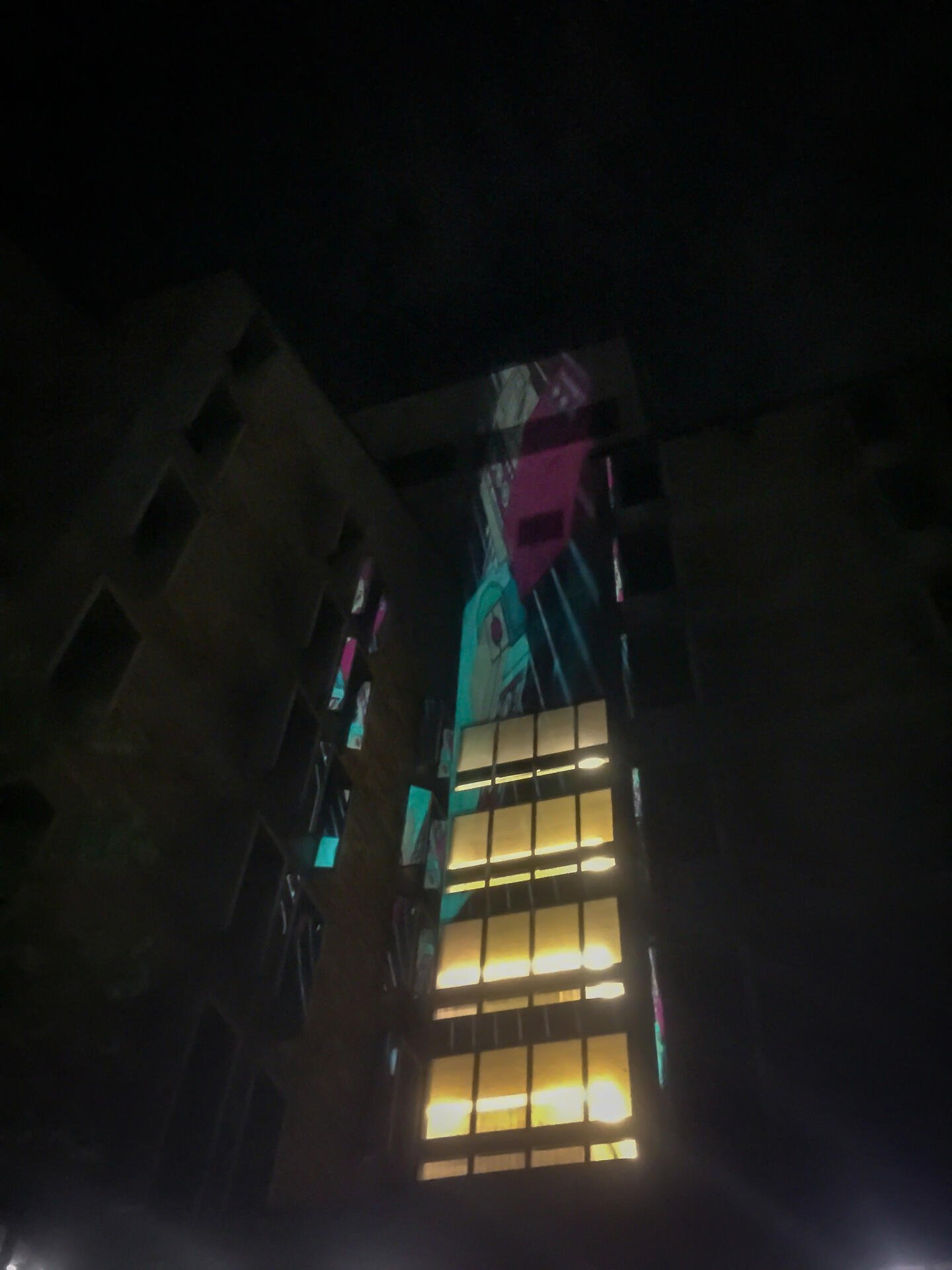
Superintended Vanquishment: Short Film
‘Superintended Vanquishment’ is a digital media project that showcases modern engineering failures onto the very building where the future engineers of tomorrow are studying. The Engineering Complex at CU Boulder serves as the backdrop for this thought-provoking piece. The irony lies in the fact that the video, which depicts engineering disasters caused by natural forces, is projected onto the building where students are learning about engineering.
By using this content, I wanted to challenge viewers to think about the consequences of our actions on the environment and the delicate balance between human development and natural systems.
This project ties into the theme of light pollution by highlighting the impact of artificial light on both humans and nature. While humans have made great strides in engineering, nature still holds the power to reclaim what's hers. The video features scenes of engineering failures, such as a dam collapsing due to a flood, a building destroyed by an earthquake, and a bridge washed away by a landslide. The film serves as a reminder of the fragility of human creations and the power of nature.
The projection itself is striking, with the video mapped onto the Engineering Complex's tallest spire. The lighting effects and surround sound speakers create an immersive experience for viewers, allowing them to feel as if they're part of the scene. This visual and auditory display invites viewers to reflect on the consequences of human actions on the environment and the delicate balance between human development and natural systems.
Ultimately, the project underscores the notion that, despite our technological advancements, nature will always have the final say.
Watch ‘Superintended Vanquishment’
nostr:naddr1qqrk7e24vekhvcspzpmhxue69uhkummnw3ezuamfdejsygquk99txdv8dly7lsmasw969p70zlj6mnxtyzlk6j0em2tft4fyvgpsgqqqskasrmevqw
Originally published in 2015 by Hes.
Republished to habla.news/u/hes@nostrplebs.com on 11/28/2024.
Find me elsewhere:
-
 @ 5b862b5d:7dac3251
2024-11-29 01:30:39
@ 5b862b5d:7dac3251
2024-11-29 01:30:39asdf
originally posted at https://stacker.news/items/459388
-
 @ 812cff5a:5c40aeeb
2024-11-29 00:25:27
@ 812cff5a:5c40aeeb
2024-11-29 00:25:27أول منصة نوستر عربية للاتصالات اللامركزية.
نوستر عربي (NostrArabia) هي منصتكم للحرية والتواصل اللامركزي، مصممة خصيصاً للناطقين بالعربية. استمتع بمساحة آمنة تعزز خصوصيتك وتضمن ملكيتك لبياناتك عبر بروتوكول نوستر الرائد.
ما هو نوستر؟
نوستر هو نظام لامركزي مقاوم للرقابة يمكنك من: * التواصل بحرية دون وسطاء. * امتلاك هويتك الرقمية بالكامل. * الانضمام لمجتمع آمن ومبدع. سهل الانضمام، حتى للمبتدئين، مع دعم متواصل من فريقنا!
كيف تبدأ؟
- اختر تطبيق (برايمال -Primal- تطبيق مناسب للمبتدئين، دامس -Damus- مناسب لمستخدمي iOS، وأميثيست -Amethyst- تطبيق مناسب لمستخدمي Android).
- أنشئ حساب مجاني يتكون من مفتاح عام ومفتاح خاص. هذه هي هويتك، على نوستر، احتفظ بها جيداً.
- أضف ريلاي نوستر عربي (wss://relay.nostrarabia.com) إلى قائمة الريلا لديك.
- استكشف وتواصل بحرية بدون اعلانات وبدون بوتات.
لماذا تنضم إلى نوستر عربي (NostrArabaia) ؟
- صمم للمجتمع العربي أولا: يجمع بين الحرية والثقة. *مجهز لارسال واستلام البيتكوين من خاصية الـZap.
- شفافية على الشبكة المفتوحة مدعومة بخصوصية عالية في الرسائل الخاصة بعيدة عن أعين شركات التواصل الاجتماعي التقليدية.
ابدأ اللآن! واستمتع بتجربة فريدة للتواصل الحر لم ترى مثلها من قبل.
-
 @ 4fcac000:d2b37988
2024-11-29 07:34:55
@ 4fcac000:d2b37988
2024-11-29 07:34:55В 2040 году Тюмень демонстрирует значительные изменения в статистике бедности и богатства. По прогнозам, уровень бедности в регионе продолжит снижаться, и к этому времени ожидается, что только 9,8% населения будет жить за чертой бедности, что на 1,9% меньше по сравнению с прошлым. Это связано с ростом реальных доходов и повышением зарплат.
Согласно данным Росстата, в России в целом число людей с доходами ниже границы бедности составит около 15,7 млн, что соответствует 10,8% населения. Однако в Тюмени ситуация лучше: средний доход жителей составляет около 74,9 тыс. рублей, что выше среднероссийского уровня.
Основные факты о бедности и богатстве в Тюмени 2040: * Уровень бедности: Около 9,8% населения. * Средний доход: Примерно 74,9 тыс. рублей.
Число богатых: Увеличение числа высокодоходных домохозяйств благодаря экономическому росту и инвестициям в регион.
Социальные программы: Успешные инициативы по поддержке уязвимых групп населения способствуют снижению уровня бедности.
Эти изменения свидетельствуют о том, что Тюмень движется к более сбалансированному социальному развитию, где усилия по сокращению неравенства начинают приносить плоды.
-
 @ a849beb6:b327e6d2
2024-11-23 15:03:47
@ a849beb6:b327e6d2
2024-11-23 15:03:47
\ \ It was another historic week for both bitcoin and the Ten31 portfolio, as the world’s oldest, largest, most battle-tested cryptocurrency climbed to new all-time highs each day to close out the week just shy of the $100,000 mark. Along the way, bitcoin continued to accumulate institutional and regulatory wins, including the much-anticipated approval and launch of spot bitcoin ETF options and the appointment of several additional pro-bitcoin Presidential cabinet officials. The timing for this momentum was poetic, as this week marked the second anniversary of the pico-bottom of the 2022 bear market, a level that bitcoin has now hurdled to the tune of more than 6x despite the litany of bitcoin obituaries published at the time. The entirety of 2024 and especially the past month have further cemented our view that bitcoin is rapidly gaining a sense of legitimacy among institutions, fiduciaries, and governments, and we remain optimistic that this trend is set to accelerate even more into 2025.
Several Ten31 portfolio companies made exciting announcements this week that should serve to further entrench bitcoin’s institutional adoption. AnchorWatch, a first of its kind bitcoin insurance provider offering 1:1 coverage with its innovative use of bitcoin’s native properties, announced it has been designated a Lloyd’s of London Coverholder, giving the company unique, blue-chip status as it begins to write bitcoin insurance policies of up to $100 million per policy starting next month. Meanwhile, Battery Finance Founder and CEO Andrew Hohns appeared on CNBC to delve into the launch of Battery’s pioneering private credit strategy which fuses bitcoin and conventional tangible assets in a dual-collateralized structure that offers a compelling risk/return profile to both lenders and borrowers. Both companies are clearing a path for substantially greater bitcoin adoption in massive, untapped pools of capital, and Ten31 is proud to have served as lead investor for AnchorWatch’s Seed round and as exclusive capital partner for Battery.
As the world’s largest investor focused entirely on bitcoin, Ten31 has deployed nearly $150 million across two funds into more than 30 of the most promising and innovative companies in the ecosystem like AnchorWatch and Battery, and we expect 2025 to be the best year yet for both bitcoin and our portfolio. Ten31 will hold a first close for its third fund at the end of this year, and investors in that close will benefit from attractive incentives and a strong initial portfolio. Visit ten31.vc/funds to learn more and get in touch to discuss participating.\ \ Portfolio Company Spotlight
Primal is a first of its kind application for the Nostr protocol that combines a client, caching service, analytics tools, and more to address several unmet needs in the nascent Nostr ecosystem. Through the combination of its sleek client application and its caching service (built on a completely open source stack), Primal seeks to offer an end-user experience as smooth and easy as that of legacy social media platforms like Twitter and eventually many other applications, unlocking the vast potential of Nostr for the next billion people. Primal also offers an integrated wallet (powered by Strike BLACK) that substantially reduces onboarding and UX frictions for both Nostr and the lightning network while highlighting bitcoin’s unique power as internet-native, open-source money.
Selected Portfolio News
AnchorWatch announced it has achieved Llody’s Coverholder status, allowing the company to provide unique 1:1 bitcoin insurance offerings starting in December.\ \ Battery Finance Founder and CEO Andrew Hohns appeared on CNBC to delve into the company’s unique bitcoin-backed private credit strategy.
Primal launched version 2.0, a landmark update that adds a feed marketplace, robust advanced search capabilities, premium-tier offerings, and many more new features.
Debifi launched its new iOS app for Apple users seeking non-custodial bitcoin-collateralized loans.
Media
Strike Founder and CEO Jack Mallers joined Bloomberg TV to discuss the strong volumes the company has seen over the past year and the potential for a US bitcoin strategic reserve.
Primal Founder and CEO Miljan Braticevic joined The Bitcoin Podcast to discuss the rollout of Primal 2.0 and the future of Nostr.
Ten31 Managing Partner Marty Bent appeared on BlazeTV to discuss recent changes in the regulatory environment for bitcoin.
Zaprite published a customer testimonial video highlighting the popularity of its offerings across the bitcoin ecosystem.
Market Updates
Continuing its recent momentum, bitcoin reached another new all-time high this week, clocking in just below $100,000 on Friday. Bitcoin has now reached a market cap of nearly $2 trillion, putting it within 3% of the market caps of Amazon and Google.
After receiving SEC and CFTC approval over the past month, long-awaited options on spot bitcoin ETFs were fully approved and launched this week. These options should help further expand bitcoin’s institutional liquidity profile, with potentially significant implications for price action over time.
The new derivatives showed strong performance out of the gate, with volumes on options for BlackRock’s IBIT reaching nearly $2 billion on just the first day of trading despite surprisingly tight position limits for the vehicles.
Meanwhile, the underlying spot bitcoin ETF complex had yet another banner week, pulling in $3.4 billion in net inflows.
New reports suggested President-elect Donald Trump’s social media company is in advanced talks to acquire crypto trading platform Bakkt, potentially the latest indication of the incoming administration’s stance toward the broader “crypto” ecosystem.
On the macro front, US housing starts declined M/M again in October on persistently high mortgage rates and weather impacts. The metric remains well below pre-COVID levels.
Pockets of the US commercial real estate market remain challenged, as the CEO of large Florida developer Related indicated that developers need further rate cuts “badly” to maintain project viability.
US Manufacturing PMI increased slightly M/M, but has now been in contraction territory (<50) for well over two years.
The latest iteration of the University of Michigan’s popular consumer sentiment survey ticked up following this month’s election results, though so did five-year inflation expectations, which now sit comfortably north of 3%.
Regulatory Update
After weeks of speculation, the incoming Trump administration appointed hedge fund manager Scott Bessent to head up the US Treasury. Like many of Trump’s cabinet selections so far, Bessent has been a public advocate for bitcoin.
Trump also appointed Cantor Fitzgerald CEO Howard Lutnick – another outspoken bitcoin bull – as Secretary of the Commerce Department.
Meanwhile, the Trump team is reportedly considering creating a new “crypto czar” role to sit within the administration. While it’s unclear at this point what that role would entail, one report indicated that the administration’s broader “crypto council” is expected to move forward with plans for a strategic bitcoin reserve.
Various government lawyers suggested this week that the Trump administration is likely to be less aggressive in seeking adversarial enforcement actions against bitcoin and “crypto” in general, as regulatory bodies appear poised to shift resources and focus elsewhere.
Other updates from the regulatory apparatus were also directionally positive for bitcoin, most notably FDIC Chairman Martin Gruenberg’s confirmation that he plans to resign from his post at the end of President Biden’s term.
Many critics have alleged Gruenberg was an architect of “Operation Chokepoint 2.0,” which has created banking headwinds for bitcoin companies over the past several years, so a change of leadership at the department is likely yet another positive for the space.
SEC Chairman Gary Gensler also officially announced he plans to resign at the start of the new administration. Gensler has been the target of much ire from the broader “crypto” space, though we expect many projects outside bitcoin may continue to struggle with questions around the Howey Test.
Overseas, a Chinese court ruled that it is not illegal for individuals to hold cryptocurrency, even though the country is still ostensibly enforcing a ban on crypto transactions.
Noteworthy
The incoming CEO of Charles Schwab – which administers over $9 trillion in client assets – suggested the platform is preparing to “get into” spot bitcoin offerings and that he “feels silly” for having waited this long. As this attitude becomes more common among traditional finance players, we continue to believe that the number of acquirers coming to market for bitcoin infrastructure capabilities will far outstrip the number of available high quality assets.
BlackRock’s 2025 Thematic Outlook notes a “renewed sense of optimism” on bitcoin among the asset manager’s client base due to macro tailwinds and the improving regulatory environment. Elsewhere, BlackRock’s head of digital assets indicated the firm does not view bitcoin as a “risk-on” asset.
MicroStrategy, which was a sub-$1 billion market cap company less than five years ago, briefly breached a $100 billion equity value this week as it continues to aggressively acquire bitcoin. The company now holds nearly 350,000 bitcoin on its balance sheet.
Notably, Allianz SE, Germany’s largest insurer, spoke for 25% of MicroStrategy’s latest $3 billion convertible note offering this week, suggesting growing appetite for bitcoin proxy exposure among more restricted pools of capital.
The ongoing meltdown of fintech middleware provider Synapse has left tens of thousands of customers with nearly 100% deposit haircuts as hundreds of millions in funds remain missing, the latest unfortunate case study in the fragility of much of the US’s legacy banking stack.
Travel
-
BitcoinMENA, Dec 9-10
-
Nashville BitDevs, Dec 10
-
Austin BitDevs, Dec 19
-
-
 @ a39d19ec:3d88f61e
2024-11-21 12:05:09
@ a39d19ec:3d88f61e
2024-11-21 12:05:09A state-controlled money supply can influence the development of socialist policies and practices in various ways. Although the relationship is not deterministic, state control over the money supply can contribute to a larger role of the state in the economy and facilitate the implementation of socialist ideals.
Fiscal Policy Capabilities
When the state manages the money supply, it gains the ability to implement fiscal policies that can lead to an expansion of social programs and welfare initiatives. Funding these programs by creating money can enhance the state's influence over the economy and move it closer to a socialist model. The Soviet Union, for instance, had a centralized banking system that enabled the state to fund massive industrialization and social programs, significantly expanding the state's role in the economy.
Wealth Redistribution
Controlling the money supply can also allow the state to influence economic inequality through monetary policies, effectively redistributing wealth and reducing income disparities. By implementing low-interest loans or providing financial assistance to disadvantaged groups, the state can narrow the wealth gap and promote social equality, as seen in many European welfare states.
Central Planning
A state-controlled money supply can contribute to increased central planning, as the state gains more influence over the economy. Central banks, which are state-owned or heavily influenced by the state, play a crucial role in managing the money supply and facilitating central planning. This aligns with socialist principles that advocate for a planned economy where resources are allocated according to social needs rather than market forces.
Incentives for Staff
Staff members working in state institutions responsible for managing the money supply have various incentives to keep the system going. These incentives include job security, professional expertise and reputation, political alignment, regulatory capture, institutional inertia, and legal and administrative barriers. While these factors can differ among individuals, they can collectively contribute to the persistence of a state-controlled money supply system.
In conclusion, a state-controlled money supply can facilitate the development of socialist policies and practices by enabling fiscal policies, wealth redistribution, and central planning. The staff responsible for managing the money supply have diverse incentives to maintain the system, further ensuring its continuation. However, it is essential to note that many factors influence the trajectory of an economic system, and the relationship between state control over the money supply and socialism is not inevitable.
-
 @ fa1d8325:7c91882e
2024-11-28 22:16:53
@ fa1d8325:7c91882e
2024-11-28 22:16:53Пятигорск стал одним из первых городов в Ставропольском крае, где завершилось строительство сети зарядных станций для электромобилей нового поколения. В рамках пилотного проекта Министерства энергетики, промышленности и связи было установлено восемь станций мощностью до 200 кВт, что обеспечивает быструю и удобную зарядку для всех пользователей.
Станции расположены в ключевых местах города, включая торговые центры и общественные парки. Они доступны через мобильное приложение, которое позволяет легко находить и отслеживать процесс зарядки.
-
 @ 4fcac000:d2b37988
2024-11-29 07:31:13
@ 4fcac000:d2b37988
2024-11-29 07:31:13Сегодня в центре внимания — Благотворительный фонд развития города Тюмени (БФРГТ), который стал катализатором перемен.
Основные инициативы: Грантовая лотерея: Активисты могут представить свои проекты и получить финансирование для реализации лучших идей. Экологическая революция: Молодежь участвует в акции "Зеленая Сила", проводя мероприятия по раздельному сбору отходов и привлекая внимание к экологии. Образовательные экспедиции: Фонд организует поездки для молодежи в экосистемы региона, обучая их защите природы.
Успехи фонда: Экодома: Пространства для сдачи вторсырья и мастер-классов по переработке. Поддержка талантов: Программы для детей из неблагополучных семей, предоставляющие доступ к искусству и спорту.
Эти инициативы делают Тюмень примером успешного взаимодействия общества и бизнеса в решении социальных проблем. Вместе мы строим город, где каждый может внести свой вклад! 💚 #ТюменьМеняется #СоциальныеИнициативы
-
 @ 4fcac000:d2b37988
2024-11-29 07:29:13
@ 4fcac000:d2b37988
2024-11-29 07:29:13Алексей, выпускник РНИМУ им. Н.И. Пирогова, основал Центр Инновационных Медицинских Технологий, где разрабатываются новые решения для диагностики и лечения заболеваний. Вклад в медицину
Алексей известен своими исследованиями в области молекулярной биологии и биоинформатики. Его команда разработала уникальную платформу, которая использует алгоритмы глубокого обучения для анализа медицинских данных, что позволяет значительно повысить точность диагностики. Благодаря его усилиям, Тюмень стала одним из первых городов, где внедрены умные медицинские устройства, способные предсказывать заболевания на основе анализа данных пациентов.
Принципы работы Доктор Захаров верит в пациентоцентричный подход и активно внедряет технологии, которые делают медицинские услуги более доступными для всех. Он часто проводит открытые лекции и семинары, делясь своим опытом с молодыми специалистами и студентами.
Личное вдохновение Алексей вырос в семье врачей и с детства мечтал о том, чтобы сделать медицину более эффективной. Его пример вдохновляет новое поколение врачей Тюмени стремиться к инновациям и улучшению здоровья населения.
Благодаря таким выдающимся личностям, как Алексей Захаров, Тюмень уверенно движется к будущему, где медицина становится доступной и высокотехнологичной для каждого!
-
 @ 4fcac000:d2b37988
2024-11-29 07:26:48
@ 4fcac000:d2b37988
2024-11-29 07:26:48Дорогие тюменцы! Мы рады сообщить, что в нашем городе успешно заработал ** Центр Инновационных Медицинских Технологий , который стал настоящим прорывом в сфере здравоохранения! 🎉 Что нового в центре?** Передовые медицинские приложения: Мы продолжаем развивать платформу "Телемед-72", которая теперь предлагает не только запись на прием, но и возможность получать консультации с использованием виртуальной реальности. Это позволяет пациентам получать медицинскую помощь, не выходя из дома.
Обучение врачей: Центр проводит регулярные курсы для медицинского персонала, обучая их использовать новейшие технологии, такие как искусственный интеллект для диагностики. Это значительно повышает качество обслуживания и сокращает время ожидания. **Исследования и разработки: ** Мы активно внедряем нейросети для мониторинга здоровья пациентов. Это позволяет врачам быстрее и точнее ставить диагнозы, а также предлагать индивидуализированные планы лечения.
Благодаря этим инновациям Тюмень становится одним из лидеров цифровизации здравоохранения в России! Давайте вместе сделаем нашу медицину еще более доступной и эффективной! 💚 #ТюменьЗдоровье #Инновации2040 #БудущееМедицины
-
 @ 87730827:746b7d35
2024-11-20 09:27:53
@ 87730827:746b7d35
2024-11-20 09:27:53Original: https://techreport.com/crypto-news/brazil-central-bank-ban-monero-stablecoins/
Brazilian’s Central Bank Will Ban Monero and Algorithmic Stablecoins in the Country
Brazil proposes crypto regulations banning Monero and algorithmic stablecoins and enforcing strict compliance for exchanges.
KEY TAKEAWAYS
- The Central Bank of Brazil has proposed regulations prohibiting privacy-centric cryptocurrencies like Monero.
- The regulations categorize exchanges into intermediaries, custodians, and brokers, each with specific capital requirements and compliance standards.
- While the proposed rules apply to cryptocurrencies, certain digital assets like non-fungible tokens (NFTs) are still ‘deregulated’ in Brazil.

In a Notice of Participation announcement, the Brazilian Central Bank (BCB) outlines regulations for virtual asset service providers (VASPs) operating in the country.
In the document, the Brazilian regulator specifies that privacy-focused coins, such as Monero, must be excluded from all digital asset companies that intend to operate in Brazil.
Let’s unpack what effect these regulations will have.
Brazil’s Crackdown on Crypto Fraud
If the BCB’s current rule is approved, exchanges dealing with coins that provide anonymity must delist these currencies or prevent Brazilians from accessing and operating these assets.
The Central Bank argues that currencies like Monero make it difficult and even prevent the identification of users, thus creating problems in complying with international AML obligations and policies to prevent the financing of terrorism.
According to the Central Bank of Brazil, the bans aim to prevent criminals from using digital assets to launder money. In Brazil, organized criminal syndicates such as the Primeiro Comando da Capital (PCC) and Comando Vermelho have been increasingly using digital assets for money laundering and foreign remittances.
… restriction on the supply of virtual assets that contain characteristics of fragility, insecurity or risks that favor fraud or crime, such as virtual assets designed to favor money laundering and terrorist financing practices by facilitating anonymity or difficulty identification of the holder.
The Central Bank has identified that removing algorithmic stablecoins is essential to guarantee the safety of users’ funds and avoid events such as when Terraform Labs’ entire ecosystem collapsed, losing billions of investors’ dollars.
The Central Bank also wants to control all digital assets traded by companies in Brazil. According to the current proposal, the national regulator will have the power to ask platforms to remove certain listed assets if it considers that they do not meet local regulations.
However, the regulations will not include NFTs, real-world asset (RWA) tokens, RWA tokens classified as securities, and tokenized movable or real estate assets. These assets are still ‘deregulated’ in Brazil.
Monero: What Is It and Why Is Brazil Banning It?
Monero ($XMR) is a cryptocurrency that uses a protocol called CryptoNote. It launched in 2013 and ‘erases’ transaction data, preventing the sender and recipient addresses from being publicly known. The Monero network is based on a proof-of-work (PoW) consensus mechanism, which incentivizes miners to add blocks to the blockchain.
Like Brazil, other nations are banning Monero in search of regulatory compliance. Recently, Dubai’s new digital asset rules prohibited the issuance of activities related to anonymity-enhancing cryptocurrencies such as $XMR.
Furthermore, exchanges such as Binance have already announced they will delist Monero on their global platforms due to its anonymity features. Kraken did the same, removing Monero for their European-based users to comply with MiCA regulations.
Data from Chainalysis shows that Brazil is the seventh-largest Bitcoin market in the world.

In Latin America, Brazil is the largest market for digital assets. Globally, it leads in the innovation of RWA tokens, with several companies already trading this type of asset.
In Closing
Following other nations, Brazil’s regulatory proposals aim to combat illicit activities such as money laundering and terrorism financing.
Will the BCB’s move safeguard people’s digital assets while also stimulating growth and innovation in the crypto ecosystem? Only time will tell.
References
Cassio Gusson is a journalist passionate about technology, cryptocurrencies, and the nuances of human nature. With a career spanning roles as Senior Crypto Journalist at CriptoFacil and Head of News at CoinTelegraph, he offers exclusive insights on South America’s crypto landscape. A graduate in Communication from Faccamp and a post-graduate in Globalization and Culture from FESPSP, Cassio explores the intersection of governance, decentralization, and the evolution of global systems.
-
 @ 4fcac000:d2b37988
2024-11-29 07:23:23
@ 4fcac000:d2b37988
2024-11-29 07:23:23Интервьюер: Добрый день, Анна! Спасибо, что согласились поговорить с нами. Вы — активист и человек с ограниченными возможностями. Расскажите, пожалуйста, о том, как вы оцениваете доступность городской среды в Тюмени. Анна: Добрый день! Спасибо за возможность поделиться своим мнением. В последние годы в Тюмени действительно сделано много для улучшения доступности. Я заметила, что многие общественные места стали более удобными — появились пандусы, тактильные плитки и специальные зоны для отдыха. Интервьюер: Это замечательно! А что вам особенно нравится в новых инициативах? Анна: Мне очень понравилось внедрение умных пешеходных переходов. Они делают пересечение дороги более безопасным. Также приложение "Тюмень без барьеров" стало настоящим помощником — теперь я могу заранее узнать, насколько доступно то или иное место. Интервьюер: Есть ли что-то, что еще нужно улучшить? Анна: Да, конечно. Несмотря на положительные изменения, остаются проблемы. Например, не все тротуары имеют хороший асфальт, и иногда пандусы расположены неудачно. Также важно обучать персонал в общественных местах о том, как помогать людям с ограниченными возможностями. Интервьюер: Какие шаги вы бы предложили для дальнейшего улучшения ситуации? Анна: Я бы предложила проводить регулярные проверки доступности общественных мест и организовывать встречи с людьми с ограниченными возможностями для обсуждения их потребностей. Также важно привлекать больше внимания к этой теме через СМИ и социальные сети. Интервьюер: Спасибо, Анна! Ваши идеи очень ценны. Надеемся, что Тюмень станет еще более доступным городом для всех! Анна: Спасибо вам! Я верю, что вместе мы сможем сделать наш город лучше!
-
 @ 7776c32d:45558888
2024-11-28 21:53:24
@ 7776c32d:45558888
2024-11-28 21:53:244 years ago, on Thanksgiving, Digit's boyfriend at the time died. She told me that. She didn't say how it happened, but others say he committed suicide. I don't remember my Thanksgiving that year.
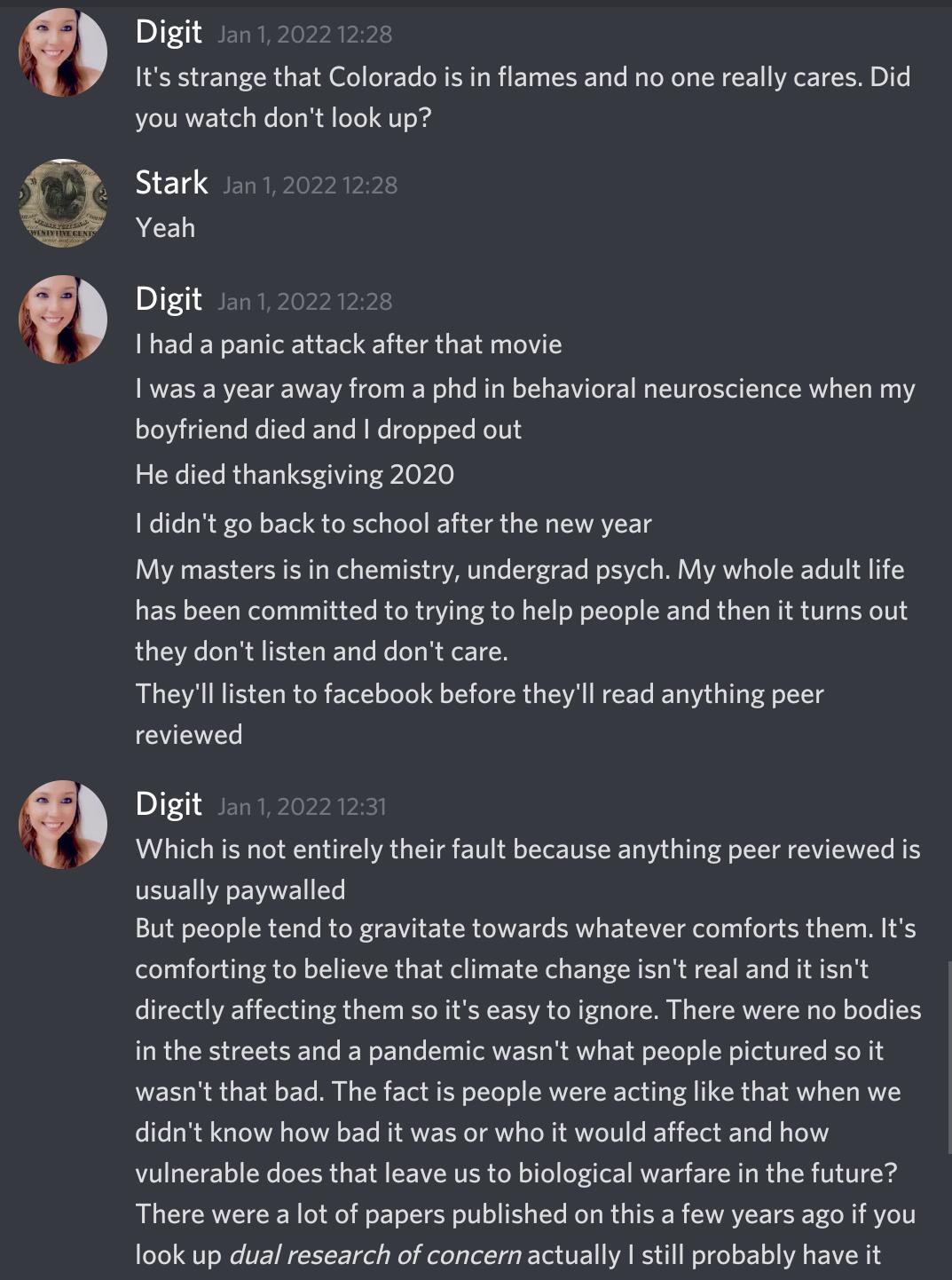
3 years ago, on Thanksgiving, I met Digit. I had a pet bird that died that day. I had named it Deathspan to avoid ever forgetting its limited lifespan, as if that would make me more prepared to deal with it dying someday, but that only made me feel worse. I had a mental breakdown and got banned from the wallstreetbets subreddit yet again, so I would have to start a new account yet again, but this time, unlike any other time, a wallstreetbets moderator called /u/shutupdigit showed up in my inbox to check if I was OK and invite me to the wallstreetbets Discord channel, hoping it would calm me down. This was the second time in my life a woman randomly approached me and offered her friendship to me without me approaching her first, and I was always desperate to get any women to talk to me at all, and a woman on wallstreetbets is rare to begin with - I was immensely anxious to get to know her, and hopefully keep knowing her. Interacting with her made it possible to enjoy the Thanksgiving dinner I got at the VFW despite my bleak circumstances.
2 years ago, on Thanksgiving, I cried a lot, hoping Digit was alive. She was, but I didn't know. I was so thankful to have met her, and I tried to focus on being thankful, but I needed to talk to her one more time so badly, and I knew if I could ever talk to her again, I would never be in that much pain again.
1 year ago, on Thanksgiving, I was entirely thankful she had come back in the interim. I knew I could never again be in as much pain as the year before, because I got to find out she lived longer than that. I was trying to finish a song about her, hating myself for how long it was taking, because after coming back that year, she had deleted her reddit and Discord accounts and disappeared again, and I was scared she could be planning to kill herself, or she could have done it already, and I was failing to protect her with every bit of delay in my efforts to show her how much I needed her. I hoped maybe someone in wallstreetbets was still in touch with her and I could make a song worth showing her. I was sick that week and couldn't finish the song by Thanksgiving because my head hurt so much it was impossible to tell if any melody or drum pattern or anything I was making was good or bad. I never finished the song, it felt too late after that. I spiraled into an endless process of trying to find new ways to reach out to her that would have better chances of a positive result. I reached out to wallstreetbets people with what progress I had made on the unfinished instrumental for the song, as futile as it felt. Nobody told me about the rumors she had committed suicide, as I had been fearing for so long.
Today, I'm still entirely thankful she came back before, and I know I'll never be in as much pain as 2 years ago again, since I know she lived longer than that. I'm still in that spiral trying to find any way to find out if she's safe without accidentally prompting her to commit suicide in the process because of the disturbance of privacy or something. I should still never recover if she's gone, but at least I'll never be in as much pain as 2 years ago.
I'm so thankful to know she lived past 2 years ago, but I can't stop being desperate to see her alive past today. I can't stop being extremely shitty to others around me. Today I went with my mom to volunteer at the VFW that gave me food the day I met Digit and I left my mom stranded there because she said something insensitive to my constant panic about Digit. It's only by my insane luck I've kept any friends at all.
I'm so sorry in this same timeframe Digit never got to have what she gave me - one last chance to see that most important person alive. I'm so sorry for those of you who are also struggling with anything like this, or worse.
Just in case anyone wants to hear her voice, here's that one song she sent me, intentions.mp3 -
https://audio.nostr.build/808960a3289a3196a8b371c2239d6925357b9a41183925f9882ee2897df313d3.mp3
-
 @ ae31c19a:2598418b
2024-11-28 20:49:19
@ ae31c19a:2598418b
2024-11-28 20:49:19test
-
 @ 4fcac000:d2b37988
2024-11-29 07:19:06
@ 4fcac000:d2b37988
2024-11-29 07:19:06Дорогие тюменцы! В нашем городе активно развиваются цифровые сервисы, которые делают жизнь комфортнее и удобнее. Вот несколько ключевых инициатив:
- Телемед-72: Мобильное приложение для записи на прием к врачу, которое за полгода 2024 года увеличило число пользователей на 26% до 570 тыс. человек. Услуги включают телемедицинские консультации и вызовы врача на дом
- Виртуальный консультант-72: Нейросетевая система, помогающая жителям получать госуслуги и записываться к специалистам, значительно упрощая взаимодействие с государственными учреждениями1.
- Интернет вещей: Внедрение умных технологий, таких как датчики для мониторинга состояния дорог и мусорных контейнеров, позволяет оперативно реагировать на проблемы и оптимизировать городские службы.
Эти решения делают Тюмень одним из лидеров цифровизации в России! 💻 #ЦифроваяТюмень #КачествоЖизни
-
 @ 4fcac000:d2b37988
2024-11-29 07:18:12
@ 4fcac000:d2b37988
2024-11-29 07:18:12Дорогие тюменцы! Мы рады сообщить, что в нашем городе стартует уникальная инициатива — "Зеленый Марафон Тюмени", который пройдет с 1 по 15 декабря 2040 года. Этот проект объединяет усилия местных компаний, направленных на защиту окружающей среды и устойчивое развитие.
Что такое "Зеленый Марафон"?
В рамках марафона бизнесы Тюмени будут соревноваться в реализации экологических инициатив, таких как: * Снижение углеродного следа: Компании представят свои планы по уменьшению выбросов CO2. * Переработка отходов: Участники марафона внедрят программы по сбору и переработке вторичных материалов. * Эко-образование: Местные предприниматели проведут мастер-классы и лекции для жителей о важности экологии.
Как участвовать?
Каждый тюменец может поддержать инициативы, участвуя в мероприятиях и голосуя за лучшие проекты. В конце марафона мы подведем итоги и наградим самые активные компании! Давайте вместе сделаем Тюмень еще более экологически чистым и комфортным городом! 💚
#ЗеленыйМарафон #ЭкологияТюмени #БудущееЗдесь
-
 @ 5e5fc143:393d5a2c
2024-11-19 10:20:25
@ 5e5fc143:393d5a2c
2024-11-19 10:20:25Now test old reliable front end Stay tuned more later Keeping this as template long note for debugging in future as come across few NIP-33 post edit issues
-
 @ af9c48b7:a3f7aaf4
2024-11-18 20:26:07
@ af9c48b7:a3f7aaf4
2024-11-18 20:26:07Chef's notes
This simple, easy, no bake desert will surely be the it at you next family gathering. You can keep it a secret or share it with the crowd that this is a healthy alternative to normal pie. I think everyone will be amazed at how good it really is.
Details
- ⏲️ Prep time: 30
- 🍳 Cook time: 0
- 🍽️ Servings: 8
Ingredients
- 1/3 cup of Heavy Cream- 0g sugar, 5.5g carbohydrates
- 3/4 cup of Half and Half- 6g sugar, 3g carbohydrates
- 4oz Sugar Free Cool Whip (1/2 small container) - 0g sugar, 37.5g carbohydrates
- 1.5oz box (small box) of Sugar Free Instant Chocolate Pudding- 0g sugar, 32g carbohydrates
- 1 Pecan Pie Crust- 24g sugar, 72g carbohydrates
Directions
- The total pie has 30g of sugar and 149.50g of carboydrates. So if you cut the pie into 8 equal slices, that would come to 3.75g of sugar and 18.69g carbohydrates per slice. If you decided to not eat the crust, your sugar intake would be .75 gram per slice and the carborytrates would be 9.69g per slice. Based on your objective, you could use only heavy whipping cream and no half and half to further reduce your sugar intake.
- Mix all wet ingredients and the instant pudding until thoroughly mixed and a consistent color has been achieved. The heavy whipping cream causes the mixture to thicken the more you mix it. So, I’d recommend using an electric mixer. Once you are satisfied with the color, start mixing in the whipping cream until it has a consistent “chocolate” color thorough. Once your satisfied with the color, spoon the mixture into the pie crust, smooth the top to your liking, and then refrigerate for one hour before serving.
-
 @ 98589a2e:bf49daa1
2024-11-29 07:13:25
@ 98589a2e:bf49daa1
2024-11-29 07:13:25Санкт-Петербург 2040 года стал настоящим центром развлечений, где парки и аквапарки трансформировались в современные пространства для отдыха и активного досуга.
София Смирнова и Елена Грачевская записали для вас новый подкаст. На этот раз они обсудили, где петербуржцы смогут провести свои выходные.

Планы развития зон для развлечения к 2050 году
На горизонте 2050 года Санкт-Петербург планирует расширение своих зеленых зон и развлекательных объектов. В проекте нового генплана предусмотрено создание дополнительных тематических парков и пляжей вдоль Финского залива, что позволит жителям города наслаждаться природой и активным отдыхом еще больше. Ожидается также внедрение новых технологий в управление парками, что сделает их более интерактивными и удобными для посетителей. Таким образом, Санкт-Петербург продолжает развиваться как город с богатым выбором развлечений для всех возрастов и интересов.
-
 @ 41e6f20b:06049e45
2024-11-17 17:33:55
@ 41e6f20b:06049e45
2024-11-17 17:33:55Let me tell you a beautiful story. Last night, during the speakers' dinner at Monerotopia, the waitress was collecting tiny tips in Mexican pesos. I asked her, "Do you really want to earn tips seriously?" I then showed her how to set up a Cake Wallet, and she started collecting tips in Monero, reaching 0.9 XMR. Of course, she wanted to cash out to fiat immediately, but it solved a real problem for her: making more money. That amount was something she would never have earned in a single workday. We kept talking, and I promised to give her Zoom workshops. What can I say? I love people, and that's why I'm a natural orange-piller.
-
 @ 4fcac000:d2b37988
2024-11-29 07:13:18
@ 4fcac000:d2b37988
2024-11-29 07:13:18Дорогие тюменцы! В нашем городе активно реализуются инициативы по созданию доступной среды для людей с ограниченными возможностями. Мы стремимся сделать Тюмень комфортным и дружелюбным местом для каждого! Что появилось с этой сфере за последние 20 лет? Умные пешеходные переходы: В этом году мы внедрили инновационные переходы, которые автоматически адаптируются к потребностям людей с ограниченными возможностями. Звуковые сигналы и световые индикаторы помогут безопасно пересекать дороги. Инклюзивные общественные пространства: В парках и скверах Тюмени появились специальные зоны для отдыха и активного времяпрепровождения, оборудованные тренажерами и игровыми площадками, доступными для всех. Мобильное приложение "Тюмень без барьеров": Это приложение предоставляет информацию о доступности общественных мест, маршрутов общественного транспорта и услуг, что позволяет людям с ограниченными возможностями планировать свои поездки без затруднений.
Присоединяйтесь к нам! Мы приглашаем всех тюменцев участвовать в обсуждении новых проектов и делиться своими идеями по улучшению доступной среды. Вместе мы можем создать город, где каждый чувствует себя комфортно и уверенно! 💙 #ДоступнаяТюмень #Инклюзия #ТюменьДляВсех
-
 @ a39d19ec:3d88f61e
2024-11-17 10:48:56
@ a39d19ec:3d88f61e
2024-11-17 10:48:56This week's functional 3d print is the "Dino Clip".

Dino Clip
I printed it some years ago for my son, so he would have his own clip for cereal bags.
Now it is used to hold a bag of dog food close.
The design by "Sneaks" is a so called "print in place". This means that the whole clip with moving parts is printed in one part, without the need for assembly after the print.
 The clip is very strong, and I would print it again if I need a "heavy duty" clip for more rigid or big bags.
Link to the file at Printables
The clip is very strong, and I would print it again if I need a "heavy duty" clip for more rigid or big bags.
Link to the file at Printables -
 @ 98589a2e:bf49daa1
2024-11-29 07:07:53
@ 98589a2e:bf49daa1
2024-11-29 07:07:53К декабрю 2040 года Санкт-Петербург стал центром новых торговых инициатив, что значительно изменило его коммерческий ландшафт. В результате реализации нового Генерального плана, принятого в 2023 году, в городе открылись несколько крупных торговых центров и магазинов, создающих новые возможности для жителей и гостей города.
Открытие новых торговых центров и магазинов
1. Торговый центр "Невский Гранд" - Местоположение: Центр города, на Невском проспекте - Площадь: 150 000 м² - Деятельность: Включает более 200 магазинов, рестораны, развлекательные зоны и кинотеатр. Здесь представлены как международные бренды, так и местные производители.
2. "ЭкоМаркет" - Местоположение: Приморский район - Площадь: 20 000 м² - Деятельность: Супермаркет, специализирующийся на экологически чистых продуктах и товарах местного производства. Открыт также центр по обучению потребителей принципам устойчивого потребления.
3. "ТехноГрад" - Местоположение: Московский район - Площадь: 30 000 м² - Деятельность: Специализированный магазин электроники и бытовой техники с возможностью тестирования товаров на месте и консультациями от экспертов.
Прогнозы развития до 2050 года
В Санкт-Петербурге ожидается дальнейшее развитие торговой инфраструктуры: - Увеличение торговых площадей: Прогнозируется открытие еще нескольких крупных торговых центров в новых жилых районах, что позволит создать дополнительные рабочие места и улучшить доступность товаров для населения. - Развитие онлайн-торговли: Ожидается активное внедрение технологий для улучшения онлайн-шопинга, включая расширение услуг доставки и интеграцию с местными магазинами. - Создание новых форматов торговли: Планируется развитие концепций "умных" магазинов с использованием технологий искусственного интеллекта для персонализированного обслуживания клиентов.
Основные направления развития: - Упор на экологические инициативы и устойчивое потребление. - Развитие мультифункциональных пространств, где будут сочетаться торговля, досуг и культурные мероприятия. - Инвестиции в цифровизацию торговли для повышения удобства покупок.

-
 @ f1989a96:bcaaf2c1
2024-11-28 20:26:48
@ f1989a96:bcaaf2c1
2024-11-28 20:26:48Good morning, readers!
In Turkey, through years of double-digit inflation, the state has eroded the value of the country’s largest banknote, the 200-lira bill, whose purchasing power has plummeted from $140 in 2010 to just $5.80 today. In scenes reminiscent of many other authoritarian states, banks and ATM providers are adjusting their business practices to adapt to the sheer volume of cash needed for purchases. Some branches are refilling tellers up to three times a day, and ATMs are increasing withdrawal limits while phasing out support for low-denomination notes. President Recep Tayyip Erdogan’s policies have only diminished citizens’ purchasing power, reminiscent of Turkey’s runaway inflation in the 1990s.
Meanwhile, in Nicaragua, journalist Elsbeth D’Anda was arrested by Daniel Ortega’s regime for speaking out about the rising cost of living in the country on his television broadcast. Officials stormed his home, confiscated all his broadcasting equipment, and sent him to the infamous El Chipote prison. This is a sobering reminder of the lengths Ortega’s regime will take to silence dissent or criticism.
On the open-source technology front, two new Bitcoin wallets were released this week. StashPay, a new Bitcoin and Lightning wallet, was released as an APK for Android and via Testflight for iOS. It leverages the Lightning and Liquid protocols, offering fast and low-cost transactions for users without dependence on centralized app stores. Additionally, Unify, a Bitcoin Payjoin wallet, is now available for testing. It leverages Nostr and Bitcoin Core and offers more private transactions by using Payjoins, which obscure transaction activity by enabling users to make collaborative payments.
We end with a tutorial from Bitcoin educator Ben Perrin (BTC Sessions), covering how to accept Bitcoin payments in a non-custodial way using BTCPay Server. This is a valuable tutorial for activists and nonprofits seeking to receive Bitcoin donations without fear of censorship or confiscation.
On this Thanksgiving, we are very grateful that you take the time to read this newsletter, and look forward to continuing to publish stories that matter in the world of financial freedom as we move to the close of the year and beyond.
Now, let’s dive right in!
Subscribe Here
GLOBAL NEWS
Turkey | Lira Banknotes Stripped of Value
In Turkey, after years of state-driven double-digit inflation, the purchasing power of its largest banknote has collapsed. The 200 lira note, once worth $140 in 2010, is worth just $5.80 today. This depreciation makes the note increasingly impractical for daily expenses, as it is barely enough for two cups of coffee. Additionally, smaller denomination banknotes are so unsuitable for daily expenses that they have essentially become scraps, as 200 lira notes make up 80% of all cash in circulation (up from 16% in 2020). In a cash-centric country like Turkey, some bank branches now need to refill their tellers three times a day, while ATMs are increasing withdrawal limits and are expected to stop offering notes below 100 lira. This financial strain is reminiscent of the 1990s, when runaway inflation devastated citizens’ savings and forced the Turkish government to remove six zeros from the currency in order to create the Turkish lira used today.
Nicaragua | Journalist Arrested for Criticizing Rising Cost of Living
The National Police arrested Nicaraguan journalist Elsbeth D’Anda last month for criticizing the rising cost of living on his television program La Cobertura. The regime loyalists deployed 20 officers and detained D’Anda at his home, confiscating his equipment before taking him to the notorious El Chipote prison. Several press freedom organizations have condemned the arbitrary detention as an attack on free expression. This arrest is the latest addition to a series of repressive measures by the Sandinista regime, which has crushed independent media through shutdowns, exiles, intimidations, and persecutions.
China | Expels Former Head of CBDC Project
The Chinese Communist Party (CCP) expelled Yao Qian, the former head of China’s central bank digital currency (CBDC) project, from his government position over allegations of corruption. Accused of accepting bribes in the form of digital assets, real estate, and luxury goods, Yao reportedly abused his role to favor specific technology providers for personal gain. His removal draws attention to the questionable governance of China’s CBDC, which already faces extensive criticisms regarding privacy and censorship. Qian’s case accentuates the risks of centralized systems, where unchecked power can foster corruption. As China advances its CBDC for cross-border transactions, this case foreshadows the broader implications of centrally controlled money in the hands of authoritarian regimes.
Russia | ‘War Economy’ Causing Inflation in Essential Items
As Russia continues its affront on Ukraine, its economy is experiencing a sharp rise in the prices of essential goods, leaving everyday citizens grappling with an escalating cost of living. Putin’s record defense spending, set to hit $138 billion in next year’s budget, has pushed inflation to 8.5%, with goods like butter rising as much as 26%. “You can’t fight inflation and a war at the same time,” says Alexandra Prokopenko, a fellow at the Carnegie Russia Eurasia Center in Berlin. Meanwhile, the regime is cracking down on alternative assets, banning Bitcoin mining in several regions, including Siberia and occupied territories of Ukraine, leaving fewer options for citizens to protect their savings and autonomy.
DR Congo | Proposed Constitution Change Prompts Outcry
In the DRC, opposition leaders are mobilizing nationwide protests against President Felix Tshisekedi’s plan to draft a new constitution, fearing it will extend presidential term limits and erode other democratic processes. Tshisekedi openly criticizes the constitution as outdated and obstructive to his governance, while opposition figures argue it prevents authoritarianism and ensures peaceful transitions of power. Concerns over constitutional changes are not unfounded in a country with pervasive repression and censorship. The DRC has laws restricting freedom of expression, such as banning government criticism in songs. It also uses financial policies like limiting electronic payments to Congolese francs to prop up its currency. With more than 25 million people facing food insecurity and economic freedom ranking among the lowest globally, Tshisekedi’s plan will only further entrench authoritarian rule at the expense of citizens’ rights.
LATEST IN BITCOIN NEWS, DEVELOPMENT, AND COMMUNITY
Unify | New Payjoin Wallet
Unify, a new Payjoin wallet that provides privacy for users when making Bitcoin payments, has been released and is now available for testing. Payjoins obscure individual transaction histories by enabling multiple parties to make collaborative payments. This functionality is especially crucial for individuals navigating repressive regimes, where financial privacy is paramount for their safety. The wallet also plans to add support for Silent Payments in the future. Unify is still in its early stages of development, making it suitable only for test funds. Still, it is a promising development to help make Bitcoin more private by default. You can test the wallet out here.
StashPay | New Lightning and Liquid Wallet
StashPay, a new self-custody Bitcoin wallet, is now available for download as an APK on Android and iOS via Testflight. It leverages the Lightning and Liquid Networks and offers comparatively low fees and fast transactions. StashPay also reduces the risks associated with centralized app stores removing the wallet by offering the APK. Future updates will include offline receive and Lightning address support. You can test the wallet here.
NDK | Launches Mobile Nostr Development Kit
A mobile version of the Nostr Development Kit (NDK Mobile) has been released by P It is designed to simplify the creation of Nostr applications on mobile platforms by providing developers with the tools needed to build them. This will help strengthen the overall Nostr ecosystem, improve accessibility, and bring Nostr to a wider audience, helping provide more options for developers hoping to build alternatives to today’s state- and corporate controlled social media networks. You can view the full release notes here.
Libréria de Satoshi | Concludes Bitcoin 4 Open Source (B4OS) Residency
Libréria de Satoshi, a Bitcoin technical educational initiative and HRF grantee, successfully wrapped up its Bitcoin 4 Open Source (B4OS) Residency, a six-month technical training program led by 15 Spanish developers that emphasizes the vital role of censorship-resistant technologies in preserving financial freedom and human rights. The program culminated in a two-week residency in Buenos Aires, where 20 students had the opportunity to participate in and advance critical open-source projects like Bitcoin Core, Mostro, SeedSigner, Fedimint, and Cashu.
Blockchain Commons | Hosting FROST Developer Meeting
Blockchain Commons, an HRF grantee advancing secure and open Bitcoin development, will host a Flexible Round-Optimized Schnorr Threshold Signatures (FROST) developer meeting on Dec. 4. FROST is a next-generation multisignature system that brings privacy and scalability benefits to Bitcoin without requiring a fork. The event invites developers interested in incorporating FROST into their wallets and applications to attend. They will learn why FROST is important, the advantages it carries, and gain insights from real-world implementations of FROST. HRF is pleased to see a hands-on opportunity for developers to learn, collaborate, and leverage FROST to strengthen their projects' security and privacy. You can learn more about the meeting here.
OpenSats | Announces Third Round of Bitcoin Education Grants
OpenSats, a public nonprofit funding free and open-source software and projects, announced its third wave of Bitcoin education grants, supporting global initiatives that make Bitcoin education more accessible and impactful. Among the recipients is Yes Bitcoin Haiti, a Bitcoin circular economy in Haiti that hosts educational workshops, onboards merchants, and has a Bitcoin Diploma program for students in underserved communities. Another grantee, Bitcoin 4all, delivers fundamental Bitcoin knowledge through short digestible videos in English, Spanish, and Portuguese, helping empower those across Latin America with the information they need to reclaim their financial freedom. It is great to see continued support for Bitcoin education.
RECOMMENDED CONTENT
How To Accept Bitcoin Payments: BTCpay Server by Ben Perrin
Bitcoin educator Ben Perrin (BTC Sessions) released a new tutorial demonstrating how to accept Bitcoin payments in a non-custodial way using BTCPay Server. The guide shows how to set up the open-source payment solution on a virtual private server (VPS), allowing users to retain full control of their funds. This step-by-step tutorial is an essential resource for activists who need to better protect their financial privacy and ensure their donations are free from government interference or censorship. Watch the full tutorial here.

Scaling Bitcoin Practically With Ark Labs by Frank Corva
In his latest article, journalist Frank Corva interviews Marco Agentieri of Ark Labs about their mission to help scale the Bitcoin network with Ark, a second-layer payments protocol promising faster and cheaper transactions. Argentieri discusses Ark’s potential to drive everyday payments with Bitcoin and enable users to earn interest (from transaction fees) for acting as a liquidity provider on the Ark protocol, which essentially creates “pools” of Bitcoin liquidity where users can make faster, cheaper, and more private payments — while making a variety of other tradeoffs, including that users’ funds “expire” if not moved before a certain period of time has elapsed. You can read the full interview and learn more about Ark here.

If this email was forwarded to you and you enjoyed reading it, please consider subscribing to the Financial Freedom Report here.
Support the newsletter by donating bitcoin to HRF’s Financial Freedom program via BTCPay.
Want to contribute to the newsletter? Submit tips, stories, news, and ideas by emailing us at ffreport @ hrf.org
The Bitcoin Development Fund (BDF) is accepting grant proposals on an ongoing basis. The Bitcoin Development Fund is looking to support Bitcoin developers, community builders, and educators. Submit proposals here.
-
 @ 633fe50a:12362f9c
2024-11-28 20:13:09
@ 633fe50a:12362f9c
2024-11-28 20:13:09This is a test
-
 @ 81cda509:ae345bd2
2024-11-28 18:08:05
@ 81cda509:ae345bd2
2024-11-28 18:08:05Saudade ne anlama geliyor?

"Saudade" kelimesi, Portekizce kökenli olup genellikle özlem, hasret, nostalji gibi duyguları ifade etmek için kullanılır. Bu kelime, özellikle Portekiz ve Brezilya kültüründe derin bir anlam taşır ve sıklıkla edebiyat, müzik ve günlük konuşmalarda yer bulur. Peki, "saudade" kelimesinin tam olarak anlamı nedir ve neden bu kadar özel bir kelime olarak kabul edilir? İşte "saudade" kelimesinin anlamı ve kullanımı hakkında bilmeniz gerekenler.
Saudade Kelimesinin Anlamı
Saudade, genellikle kaybedilmiş veya ulaşılması zor olan bir şeye duyulan derin özlem ve hasreti ifade eder. Bu duygu, bir kişiyi, yeri, zamanı ya da durumu kapsayabilir. Özellikle Portekiz kültüründe, denizci ailelerin uzaklara giden sevdiklerine duyduğu özlemi tanımlamak için kullanılmıştır. Bu yüzden, "saudade" hem hüzün hem de tatlı bir hatıra olarak karışık duyguları barındırır.
Saudade Kelimesinin Tarihçesi ve Kökeni
Saudade kelimesinin kökeni, Portekizceye dayanır ve Orta Çağ Portekizcesinden gelmektedir. 15. yüzyılda, keşifler dönemi sırasında Portekizli denizciler, uzun süreler boyunca sevdiklerinden uzak kalmak zorunda kaldılar. Bu dönemde "saudade" kelimesi, ayrılığın getirdiği yoğun özlemi ifade etmek için kullanıldı. Zamanla, bu kelime Portekiz kültüründe kökleşti ve günlük dilde sıkça kullanılmaya başlandı.
Edebiyatta ve Müzikte Saudade
Saudade, Portekiz ve Brezilya edebiyatında ve müziğinde sıkça işlenen bir temadır. Portekiz fadosu, bu kelimenin en iyi örneklerinden biridir. Fado, hüzünlü melodileri ve derin sözleri ile "saudade" hissini mükemmel bir şekilde yansıtır. Aynı şekilde, Brezilya müziğinde de bossa nova ve samba türlerinde "saudade" sıkça karşımıza çıkar. Bu türler, kaybedilen bir aşkın veya geçmişte kalmış güzel anıların özlemini dile getirir.
Günlük Hayatta Saudade Kullanımı
Portekiz ve Brezilya'da, "saudade" kelimesi günlük hayatta sıkça kullanılır. Bir dostunuzla geçmişi yad ederken, uzaklardaki bir sevdiğinizi anarken ya da güzel bir anıyı hatırlarken bu kelimeyi duyabilirsiniz. "Saudade" kelimesi, basit bir özlemin ötesinde, derin ve karmaşık duyguları ifade etme gücüne sahiptir.
Saudade'nin Kültürel Önemi
Saudade, sadece bir kelime olmanın ötesinde, Portekiz ve Brezilya kültürünün önemli bir parçasıdır. Bu kelime, geçmişe duyulan özlem, kaybedilen şeylere duyulan hasret ve aynı zamanda bu duygularla başa çıkma yeteneğini temsil eder. Bu nedenle, "saudade" hem bireysel hem de kolektif bir duygunun ifadesi olarak kültürel bir mirastır.
"Saudade" kelimesi, yalnızca Portekizce konuşulan ülkelerde değil, dünya genelinde de merak edilen ve kullanılan bir terim haline gelmiştir. Derin anlamı ve kültürel önemi ile "saudade", duygusal deneyimlerimizi daha iyi ifade etmemize yardımcı olan evrensel bir kelimedir.
-
 @ 98589a2e:bf49daa1
2024-11-29 06:36:30
@ 98589a2e:bf49daa1
2024-11-29 06:36:30К декабрю 2040 года Санкт-Петербург стал центром новых производственных инициатив, что существенно изменило его экономический ландшафт. В результате реализации нового Генерального плана, который был принят в 2023 году и рассчитан до 2050 года, в городе открылись несколько крупных заводов, создающих тысячи рабочих мест и способствующих развитию различных секторов экономики.
Открытие новых заводов
1. Стекольный завод "ИнСтелРус" - Местоположение: Особая экономическая зона "Санкт-Петербург" - Инвестиции: 2,1 млрд рублей - Рабочие места: 185 - Деятельность: Производство цельностеклянных конструкций для строительства, лабораторий и "чистых" помещений. Открыт учебный центр по разработке стекольных конструкций.
2. Завод специализированного вентиляционного оборудования "Квантум" - Местоположение: Особая экономическая зона "Санкт-Петербург" - Инвестиции: 2,02 млрд рублей - Рабочие места: Ожидается создание около 150 рабочих мест. - Деятельность: Разработка и производство вентиляционного оборудования.
3. Заводы по производству экологически чистых упаковок - Местоположение: Приморский район - Инвестиции: 1,5 млрд рублей - Рабочие места: 200 - Деятельность: Производство упаковки из переработанных материалов для пищевой и непищевой продукции.
Прогнозы развития до 2050 года
В Санкт-Петербурге ожидается значительное расширение производственных мощностей: - Увеличение площади промышленных зон: Доля производственных территорий вырастет с 9,2% до 9,62%, что добавит около 630 гектаров для новых предприятий. - Создание новых рабочих мест: Прогнозируется открытие более 20 тысяч новых рабочих мест в различных отраслях, включая высокие технологии и экологически чистое производство. - Развитие транспортной инфраструктуры: Будет построено несколько новых транспортных развязок и станций метро, что улучшит доступ к новым заводам и снизит нагрузку на существующую инфраструктуру.
 Основные направления развития:
- Упор на импортозамещение и поддержку отечественного производства.
- Создание технопарков и научных учреждений рядом с новыми производствами для стимулирования инноваций.
- Развитие экологически чистых технологий и переход к устойчивым методам производства.
Основные направления развития:
- Упор на импортозамещение и поддержку отечественного производства.
- Создание технопарков и научных учреждений рядом с новыми производствами для стимулирования инноваций.
- Развитие экологически чистых технологий и переход к устойчивым методам производства. -
 @ c311a1eb:53fc6542
2024-11-28 17:46:20
@ c311a1eb:53fc6542
2024-11-28 17:46:20Saudade ne anlama geliyor?

"Saudade" kelimesi, Portekizce kökenli olup genellikle özlem, hasret, nostalji gibi duyguları ifade etmek için kullanılır. Bu kelime, özellikle Portekiz ve Brezilya kültüründe derin bir anlam taşır ve sıklıkla edebiyat, müzik ve günlük konuşmalarda yer bulur. Peki, "saudade" kelimesinin tam olarak anlamı nedir ve neden bu kadar özel bir kelime olarak kabul edilir? İşte "saudade" kelimesinin anlamı ve kullanımı hakkında bilmeniz gerekenler.
Saudade Kelimesinin Anlamı
Saudade, genellikle kaybedilmiş veya ulaşılması zor olan bir şeye duyulan derin özlem ve hasreti ifade eder. Bu duygu, bir kişiyi, yeri, zamanı ya da durumu kapsayabilir. Özellikle Portekiz kültüründe, denizci ailelerin uzaklara giden sevdiklerine duyduğu özlemi tanımlamak için kullanılmıştır. Bu yüzden, "saudade" hem hüzün hem de tatlı bir hatıra olarak karışık duyguları barındırır.
Saudade Kelimesinin Tarihçesi ve Kökeni
Saudade kelimesinin kökeni, Portekizceye dayanır ve Orta Çağ Portekizcesinden gelmektedir. 15. yüzyılda, keşifler dönemi sırasında Portekizli denizciler, uzun süreler boyunca sevdiklerinden uzak kalmak zorunda kaldılar. Bu dönemde "saudade" kelimesi, ayrılığın getirdiği yoğun özlemi ifade etmek için kullanıldı. Zamanla, bu kelime Portekiz kültüründe kökleşti ve günlük dilde sıkça kullanılmaya başlandı.
Edebiyatta ve Müzikte Saudade
Saudade, Portekiz ve Brezilya edebiyatında ve müziğinde sıkça işlenen bir temadır. Portekiz fadosu, bu kelimenin en iyi örneklerinden biridir. Fado, hüzünlü melodileri ve derin sözleri ile "saudade" hissini mükemmel bir şekilde yansıtır. Aynı şekilde, Brezilya müziğinde de bossa nova ve samba türlerinde "saudade" sıkça karşımıza çıkar. Bu türler, kaybedilen bir aşkın veya geçmişte kalmış güzel anıların özlemini dile getirir.
Günlük Hayatta Saudade Kullanımı
Portekiz ve Brezilya'da, "saudade" kelimesi günlük hayatta sıkça kullanılır. Bir dostunuzla geçmişi yad ederken, uzaklardaki bir sevdiğinizi anarken ya da güzel bir anıyı hatırlarken bu kelimeyi duyabilirsiniz. "Saudade" kelimesi, basit bir özlemin ötesinde, derin ve karmaşık duyguları ifade etme gücüne sahiptir.
Saudade'nin Kültürel Önemi
Saudade, sadece bir kelime olmanın ötesinde, Portekiz ve Brezilya kültürünün önemli bir parçasıdır. Bu kelime, geçmişe duyulan özlem, kaybedilen şeylere duyulan hasret ve aynı zamanda bu duygularla başa çıkma yeteneğini temsil eder. Bu nedenle, "saudade" hem bireysel hem de kolektif bir duygunun ifadesi olarak kültürel bir mirastır.
"Saudade" kelimesi, yalnızca Portekizce konuşulan ülkelerde değil, dünya genelinde de merak edilen ve kullanılan bir terim haline gelmiştir. Derin anlamı ve kültürel önemi ile "saudade", duygusal deneyimlerimizi daha iyi ifade etmemize yardımcı olan evrensel bir kelimedir.
-
 @ 98589a2e:bf49daa1
2024-11-29 05:58:54
@ 98589a2e:bf49daa1
2024-11-29 05:58:54На минувших выходных эксперты Санкт-Петербурга провели дискуссию о том, какие социальные инициативы и изменения повлияли на жизнь горожан.
София Смирнова и Елена Грачевская обсудили эту тему. Подробности можно послушать в нашем подкасте.

-
 @ 7e6f9018:a6bbbce5
2024-11-28 17:28:36
@ 7e6f9018:a6bbbce5
2024-11-28 17:28:36Sovint governs i premsa publiquen dades del coneixement de català entre la població. Aquestes dades només representen una etapa en el procés lingüístic, i no reflecteixen bé l’estat de la llengua, ja que una llengua només té futur si s’empra. El coneixement és una etapa necessària de cara a emprar-la, però no és l’etapa final, aquesta etapa és l’ús.
I quin és l’estat de l’ús del català? Si miram les dades d’ús habitual, veim que la llengua catalana du els darrers cent anys estancada en quasi el mateix nombre de parlants habituals. L’any 1930 hi havia uns 2,5 milions de parlants, i l’any 2018 hi havia 2,7 milions.
 Ús habitual del català a Catalunya, en milions de parlants. Els trams en puntets són una estimació de l’evolució, partint de les afirmacions de Joan Coromines i estimant la corba d’acord amb el creixement poblacional de Catalunya.
Ús habitual del català a Catalunya, en milions de parlants. Els trams en puntets són una estimació de l’evolució, partint de les afirmacions de Joan Coromines i estimant la corba d’acord amb el creixement poblacional de Catalunya. Aquestes dades no serien necessàriament negatives si la integritat lingüística sigues forta, és a dir, si la seva existència no estigués amenaçada per altres llengües. Però la població de Catalunya ha passat de 2,7 milions l’any 1930, a 7,5 milions l’any 2018. Això significa que els parlants habituals de català avui només són el 36% de la població de Catalunya, el 1930 aquests representaven el 90% de la població.
 Ús habitual del català a Catalunya, en percentatge de parlants. Els trams en puntets són una estimació de l’evolució, partint de les afirmacions de Joan Coromines i estimant la corba d’acord amb el creixement poblacional de Catalunya.
Ús habitual del català a Catalunya, en percentatge de parlants. Els trams en puntets són una estimació de l’evolució, partint de les afirmacions de Joan Coromines i estimant la corba d’acord amb el creixement poblacional de Catalunya.La llengua que ha anat guanyant presència és majorment el castellà, que ha passat de 200.000 parlants el 1930 a 3,8 milions el 2018. Amb tot, els parlants d’altres llengües estrangeres (500.000 parlants) també han crescut més que no pas els catalanoparlants en els darrers cent anys.
Notes, fonts i metodologia
Les dades de 2003 endavant estan extretes de l'Idescat (font). Abans de 2003 no existeixen dades oficials, però sí que podem fer interpretacions partint d'evidències històriques. Les dades anteriors a 2003 estan calculades partint de dues evidències:
- 1a interpretació: El 1930 el 90% de la població de la CAC parlava català de forma habitual. Font i evidència: El lingüista en llengües romàniques Joan Coromines i Vigneaux (un lingüista prestigiós del segle XX), va afirmar a la seva obra de 1950 (El que s'ha de saber de la llengua catalana), que "Dins aquest territori [Gran Catalunya] gairebé tota la població parla el català com a llengua habitual" (1, 2). "Gairebé tota" no és un nombre, però a efectes quantitatius ho podem interpretar com un nombre entre 80 i 100. Per tal de fer una interpretació moderada partirem del 90% de població, amb el 10% restant essent immigrants i funcionaris de l'estat Espanyol.
- 2a interpretació: En relació amb el creixement poblacional entre 1930 i 1998, de mitjana el 60% és a causa de la immigració (que és o s'assimila a la llengua castellana) i el 40% és creixement natural (que adopta i aprèn el català des de petit). Font i evidència: Entre el període 1999 - 2019 (que sí que hi ha dades ben desagregades), sabem que la immigració va causar el 68% del creixement poblacional. Entre el 1930 i 1998 es va viure una onada migratòria de similar magnitud a la dels 2000 (especialment entre el 1953 i 1973), i que fou d'origen castellanoparlant (3, 4, 5, 6). Per tal de fer una interpretació moderada partirem del 60% com a opció de creixement poblacional causat per la immigració, amb els percentatges que fluctuaran segons si és un període de més o menys creixement total.
-
 @ 7ec80607:128517c5
2024-11-29 05:27:06
@ 7ec80607:128517c5
2024-11-29 05:27:06Synthetic grass, also known as artificial turf, has become an increasingly popular choice for landscaping, sports fields, and residential lawns. It provides a low-maintenance, always-green solution that doesn’t require watering, mowing, or fertilizing. However, one common concern for homeowners and property managers considering synthetic grass is whether weeds can still grow through it. The question of whether weeds can penetrate artificial turf and how to prevent it is essential to understanding the full benefits of installing synthetic grass. In this article, we’ll explore whether weeds can grow through synthetic grass, the factors that contribute to weed growth in artificial turf, and the best methods for preventing or removing them.
Understanding Synthetic Grass
Before diving into the issue of weeds, it's important to understand how synthetic grass is constructed. Artificial turf consists of several layers designed to mimic the look and feel of real grass. These layers typically include:
- The Turf Fibers: The synthetic grass blades themselves are made from materials such as polyethylene or polypropylene, which are durable and UV-resistant.
- The Backing: The grass is attached to a backing material, which is usually made of latex or polyurethane. This backing allows for water drainage while keeping the grass securely in place.
- The Base Layer: Beneath the turf, a layer of crushed stone or gravel is often laid down to provide stability and proper drainage.
- Infill Material: Synthetic grass is usually filled with a layer of rubber or sand, which adds weight and helps the grass blades stand upright. Weeds typically grow from seeds in the soil, so understanding the structure of artificial turf helps clarify why weeds may or may not be able to grow through it.
Can Weeds Grow Through Synthetic Grass?
The short answer is that, under normal circumstances, weeds cannot grow through synthetic grass. The materials and layers used in artificial turf are designed to prevent weed growth. However, there are some important nuances to this answer that depend on various factors:
- Presence of Gaps or Seams: One of the main factors that could allow weeds to grow through synthetic grass is improper installation. If the turf is not laid down tightly and there are gaps between the turf layers or seams that aren't securely sealed, weeds can find their way through these openings. This is especially true if the base layer is not properly compacted or if weeds are already present in the soil beneath the turf.
- Weeds Around the Edges: Weeds can also grow along the edges of synthetic grass, where the turf is not perfectly sealed against the surrounding environment. If the edges of the synthetic turf are exposed to soil or untreated areas like flower beds, weeds can take root in these spaces and may eventually spread into the synthetic grass area.
- Weeds Growing on Top of the Turf: While weeds cannot grow through the synthetic grass, they can still sprout on top of it if the infill material (rubber or sand) provides enough organic material for weed seeds to settle in. This is more likely to happen in areas where the turf has accumulated debris, such as leaves or dirt. If weed seeds land on the surface of the turf and find suitable conditions (moisture, sunlight), they can germinate on top of the artificial grass. This is not truly “growing through” the turf but is still a form of weed growth.
-
Improper Maintenance: Another reason weeds may appear in synthetic grass areas is improper maintenance. Over time, dirt, leaves, and debris can accumulate on the surface of the artificial grass, providing a medium for weed seeds to germinate. If the turf isn’t regularly cleaned and maintained, this debris can create a suitable environment for weeds to grow. How to Prevent Weeds from Growing in Synthetic Grass While synthetic grass is designed to minimize weed growth, there are still steps you can take to ensure that your lawn stays pristine and free of unwanted plants. Here are some methods for preventing weeds from growing in artificial turf:
-
Proper Installation The first line of defense against weed growth is ensuring that the synthetic grass is installed correctly. This involves properly preparing the base layer and ensuring that the turf is laid tightly to avoid gaps. A weed barrier fabric, typically made of a geotextile material, should be installed beneath the turf to prevent weed seeds from sprouting in the soil below. Additionally, the infill material should be applied evenly to provide the necessary weight and support to the grass blades, preventing them from shifting or lifting. When these steps are followed carefully, weeds have little chance of growing in or under the turf.
- Regular Cleaning and Maintenance One of the most effective ways to prevent weed growth is by regularly cleaning and maintaining your synthetic grass. Over time, organic material like leaves, twigs, and dirt can accumulate on the surface, providing a fertile ground for weeds. Raking or using a leaf blower to remove this debris regularly will help prevent weed seeds from settling on the turf. In addition to cleaning, it's essential to rinse the turf periodically with water to remove dust and dirt that may have settled into the infill. This will keep your synthetic grass looking fresh and reduce the chances of weeds sprouting.
-
Weed Treatment Solutions If you find that weeds have already started to grow in or around your artificial grass, there are several weed treatment options available. Chemical herbicides are one option, but many homeowners prefer to avoid chemicals due to environmental concerns. Instead, organic or natural herbicides, such as vinegar or citrus-based solutions, can be effective in killing weeds without harming the turf. For weeds growing around the edges or seams of the turf, using a weed barrier or applying mulch can help keep the surrounding soil clear. If weeds have already taken root, you can manually pull them out, making sure to remove the entire root to prevent regrowth.
-
Install a Weed Barrier As mentioned earlier, a weed barrier fabric is one of the most effective ways to prevent weed growth beneath synthetic grass. This fabric is installed underneath the base layer of the turf, creating a physical barrier that blocks weeds from penetrating the surface. Weed barrier fabrics are typically made from woven or non-woven polypropylene and allow water to drain through while preventing weeds from sprouting up through the turf.
- Edge Sealing Properly sealing the edges of your synthetic turf can also prevent weeds from infiltrating from the outside. This can be done by ensuring that the edges are securely fastened to the ground or by using edging materials like concrete, stone, or plastic to create a barrier that prevents weed growth from spreading into the turf.
How to Remove Weeds from Synthetic Grass
If you notice weeds starting to grow through or around your synthetic grass, it’s important to address the issue quickly to prevent further growth. Here's how to effectively remove weeds: 1. Pull Weeds by Hand: For weeds that are growing through the seams or edges, carefully pull them out by hand. Be sure to remove the roots to prevent regrowth. 2. Use a Weed Killer: For more stubborn weeds, a non-toxic or organic weed killer can be used to kill the weeds without damaging the artificial turf. Apply the solution directly to the affected areas and allow it to work its magic. 3. Clean the Turf: After removing weeds, make sure to clean the artificial grass by brushing it, removing debris, and rinsing it with water. This will help ensure that the turf remains in good condition.
Conclusion
While synthetic grass is generally designed to prevent weeds from growing through it, several factors can allow weeds to appear, such as improper installation, gaps in the seams, or organic debris on the surface. By taking the necessary precautions during installation and committing to regular maintenance, you can prevent and manage weed growth in synthetic grass areas. A little attention to detail goes a long way in ensuring that your artificial turf stays weed-free and continues to provide an aesthetically pleasing, low-maintenance alternative to natural grass.
-
 @ 35c6427f:e5a05cb5
2024-11-28 16:49:16
@ 35c6427f:e5a05cb5
2024-11-28 16:49:16It's just a test I just want to see if I can edit it. I can, I can edit it.
-
 @ 4ba8e86d:89d32de4
2024-11-14 09:17:14
@ 4ba8e86d:89d32de4
2024-11-14 09:17:14Tutorial feito por nostr:nostr:npub1rc56x0ek0dd303eph523g3chm0wmrs5wdk6vs0ehd0m5fn8t7y4sqra3tk poste original abaixo:
Parte 1 : http://xh6liiypqffzwnu5734ucwps37tn2g6npthvugz3gdoqpikujju525yd.onion/263585/tutorial-debloat-de-celulares-android-via-adb-parte-1
Parte 2 : http://xh6liiypqffzwnu5734ucwps37tn2g6npthvugz3gdoqpikujju525yd.onion/index.php/263586/tutorial-debloat-de-celulares-android-via-adb-parte-2
Quando o assunto é privacidade em celulares, uma das medidas comumente mencionadas é a remoção de bloatwares do dispositivo, também chamado de debloat. O meio mais eficiente para isso sem dúvidas é a troca de sistema operacional. Custom Rom’s como LineageOS, GrapheneOS, Iodé, CalyxOS, etc, já são bastante enxutos nesse quesito, principalmente quanto não é instalado os G-Apps com o sistema. No entanto, essa prática pode acabar resultando em problemas indesejados como a perca de funções do dispositivo, e até mesmo incompatibilidade com apps bancários, tornando este método mais atrativo para quem possui mais de um dispositivo e separando um apenas para privacidade. Pensando nisso, pessoas que possuem apenas um único dispositivo móvel, que são necessitadas desses apps ou funções, mas, ao mesmo tempo, tem essa visão em prol da privacidade, buscam por um meio-termo entre manter a Stock rom, e não ter seus dados coletados por esses bloatwares. Felizmente, a remoção de bloatwares é possível e pode ser realizada via root, ou mais da maneira que este artigo irá tratar, via adb.
O que são bloatwares?
Bloatware é a junção das palavras bloat (inchar) + software (programa), ou seja, um bloatware é basicamente um programa inútil ou facilmente substituível — colocado em seu dispositivo previamente pela fabricante e operadora — que está no seu dispositivo apenas ocupando espaço de armazenamento, consumindo memória RAM e pior, coletando seus dados e enviando para servidores externos, além de serem mais pontos de vulnerabilidades.
O que é o adb?
O Android Debug Brigde, ou apenas adb, é uma ferramenta que se utiliza das permissões de usuário shell e permite o envio de comandos vindo de um computador para um dispositivo Android exigindo apenas que a depuração USB esteja ativa, mas também pode ser usada diretamente no celular a partir do Android 11, com o uso do Termux e a depuração sem fio (ou depuração wifi). A ferramenta funciona normalmente em dispositivos sem root, e também funciona caso o celular esteja em Recovery Mode.
Requisitos:
Para computadores:
• Depuração USB ativa no celular; • Computador com adb; • Cabo USB;
Para celulares:
• Depuração sem fio (ou depuração wifi) ativa no celular; • Termux; • Android 11 ou superior;
Para ambos:
• Firewall NetGuard instalado e configurado no celular; • Lista de bloatwares para seu dispositivo;
Ativação de depuração:
Para ativar a Depuração USB em seu dispositivo, pesquise como ativar as opções de desenvolvedor de seu dispositivo, e lá ative a depuração. No caso da depuração sem fio, sua ativação irá ser necessária apenas no momento que for conectar o dispositivo ao Termux.
Instalação e configuração do NetGuard
O NetGuard pode ser instalado através da própria Google Play Store, mas de preferência instale pela F-Droid ou Github para evitar telemetria.
F-Droid: https://f-droid.org/packages/eu.faircode.netguard/
Github: https://github.com/M66B/NetGuard/releases
Após instalado, configure da seguinte maneira:
Configurações → padrões (lista branca/negra) → ative as 3 primeiras opções (bloquear wifi, bloquear dados móveis e aplicar regras ‘quando tela estiver ligada’);
Configurações → opções avançadas → ative as duas primeiras (administrar aplicativos do sistema e registrar acesso a internet);
Com isso, todos os apps estarão sendo bloqueados de acessar a internet, seja por wifi ou dados móveis, e na página principal do app basta permitir o acesso a rede para os apps que você vai usar (se necessário). Permita que o app rode em segundo plano sem restrição da otimização de bateria, assim quando o celular ligar, ele já estará ativo.
Lista de bloatwares
Nem todos os bloatwares são genéricos, haverá bloatwares diferentes conforme a marca, modelo, versão do Android, e até mesmo região.
Para obter uma lista de bloatwares de seu dispositivo, caso seu aparelho já possua um tempo de existência, você encontrará listas prontas facilmente apenas pesquisando por elas. Supondo que temos um Samsung Galaxy Note 10 Plus em mãos, basta pesquisar em seu motor de busca por:
Samsung Galaxy Note 10 Plus bloatware listProvavelmente essas listas já terão inclusas todos os bloatwares das mais diversas regiões, lhe poupando o trabalho de buscar por alguma lista mais específica.
Caso seu aparelho seja muito recente, e/ou não encontre uma lista pronta de bloatwares, devo dizer que você acaba de pegar em merda, pois é chato para um caralho pesquisar por cada aplicação para saber sua função, se é essencial para o sistema ou se é facilmente substituível.
De antemão já aviso, que mais para frente, caso vossa gostosura remova um desses aplicativos que era essencial para o sistema sem saber, vai acabar resultando na perda de alguma função importante, ou pior, ao reiniciar o aparelho o sistema pode estar quebrado, lhe obrigando a seguir com uma formatação, e repetir todo o processo novamente.
Download do adb em computadores
Para usar a ferramenta do adb em computadores, basta baixar o pacote chamado SDK platform-tools, disponível através deste link: https://developer.android.com/tools/releases/platform-tools. Por ele, você consegue o download para Windows, Mac e Linux.
Uma vez baixado, basta extrair o arquivo zipado, contendo dentro dele uma pasta chamada platform-tools que basta ser aberta no terminal para se usar o adb.
Download do adb em celulares com Termux.
Para usar a ferramenta do adb diretamente no celular, antes temos que baixar o app Termux, que é um emulador de terminal linux, e já possui o adb em seu repositório. Você encontra o app na Google Play Store, mas novamente recomendo baixar pela F-Droid ou diretamente no Github do projeto.
F-Droid: https://f-droid.org/en/packages/com.termux/
Github: https://github.com/termux/termux-app/releases
Processo de debloat
Antes de iniciarmos, é importante deixar claro que não é para você sair removendo todos os bloatwares de cara sem mais nem menos, afinal alguns deles precisam antes ser substituídos, podem ser essenciais para você para alguma atividade ou função, ou até mesmo são insubstituíveis.
Alguns exemplos de bloatwares que a substituição é necessária antes da remoção, é o Launcher, afinal, é a interface gráfica do sistema, e o teclado, que sem ele só é possível digitar com teclado externo. O Launcher e teclado podem ser substituídos por quaisquer outros, minha recomendação pessoal é por aqueles que respeitam sua privacidade, como Pie Launcher e Simple Laucher, enquanto o teclado pelo OpenBoard e FlorisBoard, todos open-source e disponíveis da F-Droid.
Identifique entre a lista de bloatwares, quais você gosta, precisa ou prefere não substituir, de maneira alguma você é obrigado a remover todos os bloatwares possíveis, modifique seu sistema a seu bel-prazer. O NetGuard lista todos os apps do celular com o nome do pacote, com isso você pode filtrar bem qual deles não remover.
Um exemplo claro de bloatware insubstituível e, portanto, não pode ser removido, é o com.android.mtp, um protocolo onde sua função é auxiliar a comunicação do dispositivo com um computador via USB, mas por algum motivo, tem acesso a rede e se comunica frequentemente com servidores externos. Para esses casos, e melhor solução mesmo é bloquear o acesso a rede desses bloatwares com o NetGuard.
MTP tentando comunicação com servidores externos:
Executando o adb shell
No computador
Faça backup de todos os seus arquivos importantes para algum armazenamento externo, e formate seu celular com o hard reset. Após a formatação, e a ativação da depuração USB, conecte seu aparelho e o pc com o auxílio de um cabo USB. Muito provavelmente seu dispositivo irá apenas começar a carregar, por isso permita a transferência de dados, para que o computador consiga se comunicar normalmente com o celular.
Já no pc, abra a pasta platform-tools dentro do terminal, e execute o seguinte comando:
./adb start-serverO resultado deve ser:
daemon not running; starting now at tcp:5037 daemon started successfully
E caso não apareça nada, execute:
./adb kill-serverE inicie novamente.
Com o adb conectado ao celular, execute:
./adb shellPara poder executar comandos diretamente para o dispositivo. No meu caso, meu celular é um Redmi Note 8 Pro, codinome Begonia.
Logo o resultado deve ser:
begonia:/ $
Caso ocorra algum erro do tipo:
adb: device unauthorized. This adb server’s $ADB_VENDOR_KEYS is not set Try ‘adb kill-server’ if that seems wrong. Otherwise check for a confirmation dialog on your device.
Verifique no celular se apareceu alguma confirmação para autorizar a depuração USB, caso sim, autorize e tente novamente. Caso não apareça nada, execute o kill-server e repita o processo.
No celular
Após realizar o mesmo processo de backup e hard reset citado anteriormente, instale o Termux e, com ele iniciado, execute o comando:
pkg install android-toolsQuando surgir a mensagem “Do you want to continue? [Y/n]”, basta dar enter novamente que já aceita e finaliza a instalação
Agora, vá até as opções de desenvolvedor, e ative a depuração sem fio. Dentro das opções da depuração sem fio, terá uma opção de emparelhamento do dispositivo com um código, que irá informar para você um código em emparelhamento, com um endereço IP e porta, que será usado para a conexão com o Termux.
Para facilitar o processo, recomendo que abra tanto as configurações quanto o Termux ao mesmo tempo, e divida a tela com os dois app’s, como da maneira a seguir:
Para parear o Termux com o dispositivo, não é necessário digitar o ip informado, basta trocar por “localhost”, já a porta e o código de emparelhamento, deve ser digitado exatamente como informado. Execute:
adb pair localhost:porta CódigoDeEmparelhamentoDe acordo com a imagem mostrada anteriormente, o comando ficaria “adb pair localhost:41255 757495”.
Com o dispositivo emparelhado com o Termux, agora basta conectar para conseguir executar os comandos, para isso execute:
adb connect localhost:portaObs: a porta que você deve informar neste comando não é a mesma informada com o código de emparelhamento, e sim a informada na tela principal da depuração sem fio.
Pronto! Termux e adb conectado com sucesso ao dispositivo, agora basta executar normalmente o adb shell:
adb shellRemoção na prática Com o adb shell executado, você está pronto para remover os bloatwares. No meu caso, irei mostrar apenas a remoção de um app (Google Maps), já que o comando é o mesmo para qualquer outro, mudando apenas o nome do pacote.
Dentro do NetGuard, verificando as informações do Google Maps:
Podemos ver que mesmo fora de uso, e com a localização do dispositivo desativado, o app está tentando loucamente se comunicar com servidores externos, e informar sabe-se lá que peste. Mas sem novidades até aqui, o mais importante é que podemos ver que o nome do pacote do Google Maps é com.google.android.apps.maps, e para o remover do celular, basta executar:
pm uninstall –user 0 com.google.android.apps.mapsE pronto, bloatware removido! Agora basta repetir o processo para o resto dos bloatwares, trocando apenas o nome do pacote.
Para acelerar o processo, você pode já criar uma lista do bloco de notas com os comandos, e quando colar no terminal, irá executar um atrás do outro.
Exemplo de lista:
Caso a donzela tenha removido alguma coisa sem querer, também é possível recuperar o pacote com o comando:
cmd package install-existing nome.do.pacotePós-debloat
Após limpar o máximo possível o seu sistema, reinicie o aparelho, caso entre no como recovery e não seja possível dar reboot, significa que você removeu algum app “essencial” para o sistema, e terá que formatar o aparelho e repetir toda a remoção novamente, desta vez removendo poucos bloatwares de uma vez, e reiniciando o aparelho até descobrir qual deles não pode ser removido. Sim, dá trabalho… quem mandou querer privacidade?
Caso o aparelho reinicie normalmente após a remoção, parabéns, agora basta usar seu celular como bem entender! Mantenha o NetGuard sempre executando e os bloatwares que não foram possíveis remover não irão se comunicar com servidores externos, passe a usar apps open source da F-Droid e instale outros apps através da Aurora Store ao invés da Google Play Store.
Referências: Caso você seja um Australopithecus e tenha achado este guia difícil, eis uma videoaula (3:14:40) do Anderson do canal Ciberdef, realizando todo o processo: http://odysee.com/@zai:5/Como-remover-at%C3%A9-200-APLICATIVOS-que-colocam-a-sua-PRIVACIDADE-E-SEGURAN%C3%87A-em-risco.:4?lid=6d50f40314eee7e2f218536d9e5d300290931d23
Pdf’s do Anderson citados na videoaula: créditos ao anon6837264 http://eternalcbrzpicytj4zyguygpmkjlkddxob7tptlr25cdipe5svyqoqd.onion/file/3863a834d29285d397b73a4af6fb1bbe67c888d72d30/t-05e63192d02ffd.pdf
Processo de instalação do Termux e adb no celular: https://youtu.be/APolZrPHSms
-
 @ fd208ee8:0fd927c1
2024-11-08 10:27:40
@ fd208ee8:0fd927c1
2024-11-08 10:27:40You have no idea
I regularly read comments from people, on here, wondering how it's possible to marry -- or even simply be friends! -- with someone who doesn't agree with you on politics. I see this sentiment expressed quite often, usually in the context of Bitcoin, or whatever pig is currently being chased through the village, as they say around here.

It seems rather sensible, but I don't think it's as hard, as people make it out to be. Further, I think it's a dangerous precondition to set, for your interpersonal relationships, because the political field is constantly in flux. If you determine who you will love, by their opinions, do you stop loving them if their opinions change, or if the opinions they have become irrelevant and a new set of opinions are needed -- and their new ones don't match your new ones? We could see this happen to relationships en masse, during the Covid Era, and I think it happens every day, in a slow grind toward the disintegration of interpersonal discourse.
I suspect many people do stop loving, at that point, as they never really loved the other person for their own sake, they loved the other person because they thought the other person was exactly like they are. But no two people are alike, and the longer you are in a relationship with someone else, the more the initial giddiness wears off and the trials and tribulations add up, the more you notice how very different you actually are. This is the point, where best friends and romantic couples say, We just grew apart.
But you were always apart. You were always two different people. You just didn't notice, until now.

I've also always been surprised at how many same-party relationships disintegrate because of some disagreement over some particular detail of some particular topic, that they generally agree on. To me, it seems like an irrelevant side-topic, but they can't stand to be with this person... and they stomp off. So, I tend to think that it's less that opinions need to align to each other, but rather that opinions need to align in accordance with the level of interpersonal tolerance they can bring into the relationship.
I was raised by relaxed revolutionaries
Maybe I see things this way because my parents come from two diverging political, cultural, national, and ethnic backgrounds, and are prone to disagreeing about a lot of "important" (to people outside their marriage) things, but still have one of the healthiest, most-fruitful, and most long-running marriages of anyone I know, from that generation. My parents, you see, aren't united by their opinions. They're united by their relationship, which is something outside of opinions. Beyond opinions. Relationships are what turn two different people into one, cohesive unit, so that they slowly grow together. Eventually, even their faces merge, and their biological clocks tick to the same rhythm. They eventually become one entity that contains differing opinions about the same topics.
It's like magic, but it's the result of a mindset, not a worldview. Or, as I like to quip:
The best way to stay married, is to not get divorced.

My parents simply determined early on, that they would stay together, and whenever they would find that they disagreed on something that didn't directly pertain to their day-to-day existence with each other they would just agree-to-disagree about that, or roll their eyes, and move on. You do you. Live and let live.
My parents have some of the most strongly held personal opinions of any people I've ever met, but they're also incredibly tolerant and can get along with nearly anyone, so their friends are a confusing hodgepodge of people we liked and found interesting enough to keep around. Which makes their house parties really fun, and highly unusual, in this day and age of mutual-damnation across the aisle.

The things that did affect them, directly, like which school the children should attend or which country they should live in, etc. were things they'd sit down and discuss, and somehow one opinion would emerge, and they'd again... move on.
And that's how my husband and I also live our lives, and it's been working surprisingly well. No topics are off-limits to discussion (so long as you don't drone on for too long), nobody has to give up deeply held beliefs, or stop agitating for the political decisions they prefer.
You see, we didn't like that the other always had the same opinion. We liked that the other always held their opinions strongly. That they were passionate about their opinions. That they were willing to voice their opinions; sacrifice to promote their opinions. And that they didn't let anyone browbeat or cow them, for their opinions, not even their best friends or their spouse. But that they were open to listening to the other side, and trying to wrap their mind around the possibility that they might just be wrong about something.

We married each other because we knew: this person really cares, this person has thought this through, and they're in it, to win it. What "it" is, is mostly irrelevant, so long as it doesn't entail torturing small animals in the basement, or raising the children on a diet of Mountain Dew and porn, or something.
Live and let live. At least, it's never boring. At least, there's always something to ~~argue~~ talk about. At least, we never think... we've just grown apart.
-
 @ c311a1eb:53fc6542
2024-11-28 15:46:19
@ c311a1eb:53fc6542
2024-11-28 15:46:19Lagom felsefesi, İsveç'in denge ve uyum anlayışını temsil eder. İhtiyaçtan fazlasını tüketmemeyi, paylaşmayı ve dayanışmayı teşvik eder. Bu yaklaşımı finansal hayatınızda da belirleyebilir, geleceğinizi denge halinde kurabilirsiniz.

Lagom, İsveç dilinde ne çok ne az anlamına gelir. İsveç kültürünün bir parçası olan Lagom felsefesi, dengeli bir yaşam düşüncesi temeline dayanır. Mutlu yaşam stilleri arasında yer alan bu felsefe, bütün dünyada yaygınlaşan bir yaşam tarzıdır. İhtiyaçtan fazla tüketmemeyi, dayanışma ve paylaşmayı prensip alır.
Lagom, ‘‘laget om’’ kelimesinden türeyen Viking kökenli bir kelime olup aynı zamanda İsveç’te ölçü birimi olarak da kullanılır. Lagom felsefesi, İsveç’in 1600 yılında yaşadığı gıda krizinden doğan bir yaşam tarzına bağlı olarak gelişir. Küçük şeylerden mutlu olmayı, abartılı harcamalardan uzak durmayı, paylaşmayı ve yardımlaşmayı öneren bu felsefe, mutlu bir hayat sürmek için bunların gerekli olduğunu savunur. Bu felsefe ile kişiler minimalist ve tutarlı bir hayat sürdürebilir.
Lagom felsefesi, hayatın hemen hemen her alanında uygulanabilmektedir. İş, ev düzeni, sosyal yaşantı ve beslenmeye kadar hayatın her noktasında uygulanabilen bu felsefe ile kişiler daha dengeli ve uyumlu bir hayat sürer. Lagom hayat, denge ve uyumun iç içe yer aldığı bir yaşam sürmeyi amaçlar. Bu hayat tarzını benimsemek birçok yönü ile kişilere olumlu etkide bulunur. İş ve özel hayat arasında bir denge kurmak kişinin daha az stresli ve daha mutlu hissetmesine olanak sunar. Bu hayat tarzının benimsenmesi günümüzün aşırı tüketime meyleden toplumuna karşı kendinizi daha az baskıda hissetmenize yardımcı olur. Lagom hayat tarzı, sadece maddi değil manevi olarak da kişinin daha dingin ve huzurlu hissetmesine imkan sunar.
Lagomun Günlük Hayatta Kullanımı
Lagomun günlük hayatta kullanımı kişinin maddi ve manevi olarak her alanda kendini mutlu ve huzurlu hissetmesine olanak sunar. Sizi mutlu edecek dengeyi bularak hayata anlam katmayı amaçlayan bu felsefeyi günlük yaşama uyarlamak aslında oldukça kolaydır. Yiyecekten giysiye; ev dekorasyonundan giyime kadar her noktada bu felsefe uygulanabilir. Lagomu günlük hayata uyarlamak için şu ilkelere dikkat edebilirsiniz;
- Saatlerce çalışmak yerine gerçekten verimli ve yeterli çalışmak.
- Yapmak istediklerinizin listesini çıkartın ancak bunu yaparken gerçekçi bir bakış açısı benimseyin.
- Sevdiğiniz insanlarla bol bol vakit geçirerek onlar ile yaşadığınız anın keyfini çıkarın.
- Sosyal medyayı minimum seviyede kullanarak sizi eğlendiren, geliştiren ve iyi hissettiren hesapları takip edin.
- Gününüz ne kadar yoğun geçmiş olursa olsun mutlaka sevdiklerinize zaman ayırarak günü tamamlayın.

Lagom Felsefesi ve Finansal Hayatın Dengesi
Lagom felsefesinin benimsenmesi, finansal yönetimde de önemli bir rol oynar. Bu felsefe, gereksiz harcamalardan kaçınmayı ve maddi varlıkları daha dikkatli ve bilinçli bir şekilde kullanmayı teşvik eder. Lagom'u finansal yönetimde uygulamak, bütçenizi dengelemek, borçlarınızı minimize etmek ve tasarruf etmeye odaklanmak anlamına gelir.
İsveç'in bu yaşam tarzını benimseyerek, harcamalarınızı ihtiyaçlarınızla sınırlayabilir ve geleceğe yönelik finansal hedeflerinize daha kolay ulaşabilirsiniz. Ayrıca, gereksiz tüketimden kaçınarak hem kişisel mali sağlığınızı koruyabilir hem de çevresel sürdürülebilirliğe katkıda bulunabilirsiniz. Bu yaklaşım, maddi refahınızı artırırken, aynı zamanda yaşam kalitenizi de yükseltir.
Lagom Felsefesi ile Dengeli Yaşama Sanatı
Lagom felsefesi ile bir hayat sürmek hem toplumsal hem bireysel anlamda fayda sağlar. İsveç’e özgü bu felsefe, toplumda paylaşmayı ve yardımlaşmayı teşvikler. Kişilerin ihtiyacı kadarını tüketmesi ve fazlasını başkası ile paylaşması daha adil ve dengeli bir toplumu yaratır. Hayat düzeninin dengeli olması sadece bireyler için değil çevre için de olumlu etkilere sahiptir. Fazla tüketimin önüne geçen lagom felsefesi, sürdürülebilir bir yaşam modeli sunmaktadır. Böylelikle lagom sadece bireyin değil çevre ve toplum için de yararlı bir hayat stilini ortaya çıkarır.
Sürdürülebilir bir yaşam formunun temellerine dayanan lagom tasarrufun ön plana çıkmasına olanak sağlar. Bu sayede hem bireyler hem de toplum daha stabil bir yapıya erişir. İsrafın önüne geçilerek kaynakların daha etkin ve verimli kullanılması sağlanır. Bu durum uzun vadede toplum refahını sağlarken gelecek nesillere de daha temiz ve dengesi bozulmamış bir çevrenin bırakılmasına olanak sunar. Lagom felsefesi ile sürdürülebilir bir hayat yaşamak adına şunları dikkate alabilirsiniz;
- Mümkün olduğunca az çöp çıkarın.
- Tüketim yaparken sürdürülebilir ürünler almaya özen gösterin.
- Su kullanımında aşırıya kaçmadan ihtiyacınız kadarını kullanın.
- Lüks harcama yapmaktan kaçınmalı ve maddi varlığınızla dikkat çekmeye çalışmayın.
Lagom felsefesi, hayatınızın her alanına denge ve uyum getirebilecek güçlü bir yaşam anlayışıdır. İhtiyaçlarınızı karşılamak, fazla tüketimden kaçınmak ve paylaşımı ön planda tutmak sadece sizin için değil, çevreniz ve toplum için de olumlu etkiler yaratır. Bu felsefeyi benimseyerek hem kendinize hem de dünyaya daha mutlu, huzurlu ve sürdürülebilir bir gelecek sunabilirsiniz.
-
 @ fa1d8325:7c91882e
2024-11-28 23:27:34
@ fa1d8325:7c91882e
2024-11-28 23:27:34Пятигорск активно внедряет передовые технологии в сельское хозяйство, что позволяет значительно повысить производительность и снизить затраты. Одним из ключевых направлений является использование роботов и дронов.
Программа «Умный хлеб», реализуемая при поддержке «Единой России», направлена на обучение фермеров применению роботов и искусственного интеллекта. Дроны используются для мониторинга полей, внесения удобрений и защиты от вредителей, что значительно облегчает работу и повышает эффективность.
Автономные системы управления сельхозтехникой на основе искусственного интеллекта способны увеличить производительность на 30–40% и значительно сократить эксплуатационные расходы.
Большинство фермерских хозяйств уже используют роботизированные системы для автоматизации различных процессов, что не только повышает урожайность, но и решает проблему нехватки рабочей силы.
Внедрение современных технологий в сельское хозяйство Пятигорска не только способствует повышению эффективности, но и позволяет значительно снизить затраты, а также увеличить урожаи.
-
 @ bc6ccd13:f53098e4
2024-11-28 15:35:54
@ bc6ccd13:f53098e4
2024-11-28 15:35:54Of all the common misconceptions about money, this is the deepest and most pervasive. It taps into the very psychology that makes money the most powerful tool in the world. Money works in large part because, for most practical purposes, you can assume that money and wealth are the same thing and be very successful in life.
The problem is, it's a completely false premise. And without purging that assumption from your mental framework, understanding money and economics at a fundamental level is impossible.
Luckily, money is such an effective tool that it can continue to "mostly" function even without anyone understanding it at a fundamental level. It's a lot like gravity in that regard. You don't need to understand general relativity to learn how to walk. But unlike gravity, money is a powerful tool that can easily be used to exploit the less knowledgeable. That's why the general acceptance of this particular false idea is such a tragedy; it enables theft and exploitation on a global scale, and leaves the victims unable to identify the perpetrators or understand their methods.
Money as a Social Technology
So let's unpack this misconception. We can start with a simple example. You've been shipwrecked on a desert island with only the clothes on your back. After a day under the blistering sun, you're presented with two options: a billion dollars in cash, or a case of bottled water. Which one do you choose? If you chose the water, congratulations. You survived because you were able to differentiate money from real wealth.
Now run the same experiment, but place yourself in the water aisle at Costco. Suddenly you choose differently. This shows a few key requirements for money to be useful. One, you need the real wealth, the actual goods and services. If there is no bottled water on that island, all the money in the world won't do you a lick of good. Two, you need someone willing to exchange the real wealth for your money. If you're alone on that island and you find a bottle of water, you don't need money to drink it, you just help yourself. Both requirements are essential.
This shows us that money is a social technology. Understanding the purpose and function of this technology is critical to dispensing with misconceptions like "money=wealth".
Money and Civilization
What's the difference between a subsistence hunter/gatherer lifestyle and the modern civilization we all enjoy today? Specialization of labor, and complex supply chains. And what enables those civilizational necessities? Money.
In a subsistence situation, everything you have is created start-to-finish by you or by your immediate family or tribe. Everyone has to be a sort of jack-of-all-trades, at least at a group level. If you want a shelter, you collect the natural materials and build it yourself. If you need clothes, you collect the fibers or skins, process them, and use the fabric to sew your own outfit.
Contrast that with the electronic device you're using to read these words right now. How many people does it take to build a smartphone? Millions. Can one person do it? Absolutely not. You could give anyone in the world an entire lifetime and there's no way they could mine, process, and assemble the raw materials into a functional smartphone. It's simply too complex, too many processes and too much specialized knowledge and machinery needed. Not to mention doing it at a cost that most people on the planet can afford. That miracle is only possible because millions of people specialize in one tiny specific task related to making one part of a complex item, over and over again. The efficiency of only doing one specific task instead of being a generalist is what makes civilization possible.
But there's a problem. The person who's doing one specific task to make part of one widget still needs to eat, have a place to live, clothes to wear, etc. But how do you get all that while working a full time job making widgets? You can't do it all yourself, you need to buy those things from someone else who, similarly, specializes in those necessities of life. You need money. Money is what makes the whole thing work.
Money and Barter
So what exactly is money and how does it work? In a subsistence society, you can use barter to trade with strangers. You give them some fish, they give you some clothing, everyone is happy. But barter has major problems, and doesn't work at all in complex supply chains with specialized workers. Specialized jobs don't produce valuable finished goods that can be bartered. When you solder circuit boards all day, you can't go to your local farmer and trade ten "solder circuit board" for a dozen eggs.
Enter money. Money solves multiple problems that arise with barter. For one, it creates a way to compare extremely dissimilar things. How many fish is a pound of butter worth? How many eggs? With barter, every good or service has to be priced in relation to every other good or service it's exchanged for. This is impossibly cumbersome and inefficient. Having money as a unit of account is as essential to trade as having a uniform inch is to building a house. A single carpenter might be able to use the width of his hand to measure boards, but get two carpenters working together and that "handbreadth" no longer works.
Second, money solves the problem of not having the correct item to barter with. If your neighbor has butter and you have fish, but your neighbor hates fish and will only accept a chicken, barter won't work. But if you can just pay him with money, he can go buy whatever he prefers.
Third, money creates a way to value and reimburse specialized work. That's arguably the most important aspect.
The Social Contract Underlying Money
So what makes money function? Why would someone accept a piece of paper with a picture of a dead president in exchange for a very real and very valuable good or service? Well, the obvious answer is that they can be certain they'll be able to exchange that piece of paper with someone else and get an equally valuable good or service in the future. This is circular logic though, and leads some economists to mistakenly attribute the value of money to a "collective delusion". But since every known advanced civilization has used some form of money, calling it a delusion is both inaccurate and boorishly pretentious.
To understand the real mechanism behind the phenomenon, we have to consider how money is acquired. As anyone who has ever earned an honest wage knows, getting a paycheck requires two things. One, producing a valuable good or service. And two, giving that good or service to someone else instead of immediately consuming it yourself.
The first point is self-explanatory. If what you produce isn't valuable, no one will buy it.
The second point needs a bit more explanation. Money is a social technology, it's only valuable in a purely monetary sense when there's someone else to trade with. When you make yourself a few eggs for breakfast, you don't pay yourself for frying the eggs. Obviously. But if you eat your eggs, then go to your job as a short-order cook at the local diner, you may spend the morning getting paid to do exactly what you did "for free" at home. The difference is in the deferred consumption.
When you do a favor for someone, morality and the spirit of fairness dictates that they would be willing to return the favor in the future when you need something from them. That's how it works in a family or small community. People "owe each other one," and favors are reciprocated regularly without any money changing hands in a kind of informal credit system. But if one person starts to take advantage of others' generosity and requests a lot of favors, but always fails to reciprocate when asked, people catch on quickly. The parasitic behavior will be met with increasing unwillingness to help from members of the family or community, and in extreme cases, even exile from the community itself.
This informal credit system is the simplest and most fundamental form of money, and we can learn the basic principle behind why money works by observing it. We can see that a person accumulates "credits" by contributing productive value to others without getting anything in return. The "credits" are informal mental ledger credits that represent "this person has done something productive and valuable for someone else, which means he deserves to receive something valuable in the future." If a person contributes generously enough to the community, he will build up so much "credit" with everyone that he can expect generous help in return from any member of the community.
The shortcomings of this informal credit system are that one, it doesn't provide a unit of measurement to compare different goods and services accurately. This can lead to misunderstanding and disputes when different people don't value services the same way. Someone can feel that they are contributing more to the community than they're getting back in return. And two, it relies heavily on trust, and only works between people who interact on a regular basis. It would be foolish to provide favors to a stranger of unknown reputation, or someone who's just traveling through the area, because in either case there's no expectation of establishing a reciprocal relationship with that individual.
Money is just a way to formalize and expand that local, informal mental ledger. It's a way to keep track, on a societal level, who has contributed their fair share to the community and is deserving of reciprocal treatment. When someone buys something from you, although you don't consciously think through what's happening, on a subconscious level you're participating in a societal dialogue that goes something like this: "This person has money, which means they're a capable, generous, reciprocal person who has contributed more to the community than they've taken. Fairness dictates that they deserve something of value as a reward for their pro-social behavior. By taking their money, and giving them something of value, I can perpetuate the cycle of rewarding people who generously and capably do work that benefits others, and that will be beneficial to me personally and also to society as a whole. By having the money they give me, I can then also signal to others that I'm the same type of generous, reciprocal, productive person, and I can expect to be rewarded for that in the future when I try to exchange this money for valuable goods and services."
So the money has value, not because of some inherent quality of the paper or gold or mental "credit," but because it represents past productive behavior, but without immediate consumption. The money itself is not wealth, it's just an abstract representation, a kind of scorecard or ledger entry, of the real wealth that the holder of the money has already produced.
Money and Capital Formation
This dialogue or unwritten contract is the foundation of modern civilization. It's powerful, because deferred consumption is the mechanism of capital formation, and capital formation is the foundation of complex supply chains and technological progress.
You might be able to catch enough fish to feed your family with a crude rod and line. But building a modern fishing trawler (a valuable capital good) takes thousands of people working together for a long time. All that hard work doesn't result in any fish being caught throughout the process, and all those people could instead be out fishing and catching a lot of fish to eat. But by deferring that consumption and instead putting that effort into building a capital good, you end up with a huge fishing trawler. Once it's finished, a few of those thousands of people can catch more fish in a week than all the thousands of them combined could have caught over the whole time it took to build the trawler. That makes fishing much easier and more effective in the future, making food much more plentiful and increasing the standard of living for the whole society. And money is what makes all that possible on a global scale.
Final Thoughts
Given how critical this system is to civilization, any attack on money and its function is an existential threat. Unfortunately, a failure to understand the true nature of money leads to reliance on less nuanced or completely false ideas like "money=wealth". And that gives psychological cover to parasitic anti-social behavior like creating money and giving it away to buy votes, and all sorts of other destructive and dishonest shenanigans. Understanding that money is not wealth exposes the folly of all these schemes that purport to make people wealthier simply by creating more money. Believing that money is wealth makes the MMT clowns and the Keynesian grifters sound at least marginally credible. But those are specific misconceptions that need their own detailed explanation.
For now, reprogramming your mental framework to draw a strong distinction between money and real wealth will give you a solid foundation to understand economics, and to critique the many incorrect theories presented by the parasitical elements who wish to muddy the waters and avoid scrutiny of their anti-civilizational exploitation.
-
 @ fa1d8325:7c91882e
2024-11-28 23:25:25
@ fa1d8325:7c91882e
2024-11-28 23:25:25В Пятигорске открылся уникальный ресторан «РобоРесторан», где все обслуживание гостей осуществляется роботами с искусственным интеллектом. Это заведение создано местной компанией-разработчиком, которая разработала роботов-поваров и официантов.
Роботы умеют распознавать речь и поддерживать беседу с посетителями, что создает непринужденную атмосферу. В «РобоРесторане» можно обсудить меню, узнать интересные факты о блюдах и даже поделиться шутками.
Одной из главных особенностей ресторана является открытая кухня, где гости могут наблюдать за работой роботов-поваров. Они готовят быстро и точно, обеспечивая качественный сервис. В меню представлены традиционные кавказские блюда и современные гастрономические изыски.
Создатели проекта стремились создать не только вкусное место для трапезы, но и уникальное пространство, где роботы взаимодействуют с людьми. Это делает посещение «РобоРесторана» незабываемым.
Уже сейчас ресторан пользуется большой популярностью среди посетителей, которые ценят возможность пообщаться с роботами. «РобоРесторан» обещает стать новой точкой притяжения для тех, кто ценит технологичные решения в сфере общественного питания.
-
 @ 4ba8e86d:89d32de4
2024-11-07 13:56:21
@ 4ba8e86d:89d32de4
2024-11-07 13:56:21Tutorial feito por Grom mestre⚡poste original abaixo:
http://xh6liiypqffzwnu5734ucwps37tn2g6npthvugz3gdoqpikujju525yd.onion/240277/tutorial-criando-e-acessando-sua-conta-de-email-pela-i2p?show=240277#q240277
Bom dia/tarde/noite a todos os camaradas. Seguindo a nossa série de tutoriais referentes a tecnologias essenciais para a segurança e o anonimato dos usuários, sendo as primeiras a openPGP e a I2P, lhes apresento mais uma opção para expandir os seus conhecimentos da DW. Muitos devem conhecer os serviços de mail na onion como DNMX e mail2tor, mas e que tal um serviço de email pela I2P. Nesse tutorial eu vou mostrar a vocês como criar a sua primeira conta no hq.postman.i2p e a acessar essa conta.
É importante que vocês tenham lido a minha primeira série de tutoriais a respeito de como instalar, configurar e navegar pela I2P nostr:nevent1qqsyjcz2w0e6d6dcdeprhuuarw4aqkw730y542dzlwxwssneq3mwpaspz4mhxue69uhhyetvv9ujuerpd46hxtnfduhsygzt4r5x6tvh39kujvmu8egqdyvf84e3w4e0mq0ckswamfwcn5eduspsgqqqqqqsyp5vcq Esse tutorial é um pré-requisito para o seguinte e portanto recomendo que leia-os antes de prosseguir com o seguinte tutorial. O tutorial de Kleopatra nostr:nevent1qqs8h7vsn5j6qh35949sa60dms4fneussmv9jd76n24lsmtz24k0xlqzyp9636rd9ktcjmwfxd7ru5qxjxyn6uch2uhas8utg8wa5hvf6vk7gqcyqqqqqqgecq8f7 é complementar dado que é extremamente recomendado assinar e criptografar as mensagens que seguem por emails pela DW. Sem mais delongas, vamos ao tutorial de fato.
1. Criando uma conta de email no hq.postman
Relembrando: Esse tutorial considera que você já tenha acesso à I2P. Entre no seu navegador e acesse o endereço hq.postman.i2p. O roteador provavelmente já contém esse endereço no seu addressbook e não haverá a necessidade de inserir o endereço b32 completo. Após entrar no site vá para a página '1 - Creating a mailbox' https://image.nostr.build/d850379fe315d2abab71430949b06d3fa49366d91df4c9b00a4a8367d53fcca3.jpg
Nessa página, insira as credenciais de sua preferências nos campos do formulário abaixo. Lembre-se que o seu endereço de email aceita apenas letras e números. Clique em 'Proceed' depois que preencher todos os campos. https://image.nostr.build/670dfda7264db393e48391f217e60a2eb87d85c2729360c8ef6fe0cf52508ab4.jpg
Uma página vai aparecer pedindo para confirmar as credenciais da sua nova conta. Se tudo estiver certo apenas clique em 'Confirm and Create Mailbox'. Se tudo ocorrer como conforme haverá uma confirmação de que a sua nova conta foi criada com sucesso. Após isso aguarde por volta de 5 minutos antes de tentar acessá-la, para que haja tempo suficiente para o servidor atualizar o banco de dados. https://image.nostr.build/ec58fb826bffa60791fedfd9c89a25d592ac3d11645b270c936c60a7c59c067f.jpg https://image.nostr.build/a2b7710d1e3cbb36431acb9055fd62937986b4da4b1a1bbb06d3f3cb1f544fd3.jpg
Pronto! Sua nova conta de email na I2P foi criada. Agora vamos para a próxima etapa: como acessar a sua conta via um cliente de email.
2. Configurando os túneis cliente de SMTP e POP3
O hq.postman não possui um cliente web que nos permite acessar a nossa conta pelo navegador. Para isso precisamos usar um cliente como Thunderbird e configurar os túneis cliente no I2Pd que serão necessários para o Thunderbird se comunicar com o servidor pela I2P.
Caso não tenha instalado o Thunderbird ainda, faça-o agora antes de prosseguir.
Vamos configurar os túneis cliente do servidor de email no nosso roteador. Para isso abra um terminal ou o seu gestor de arquivos e vá para a pasta de configuração de túneis do I2P. Em Linux esse diretório se localiza em /etc/i2pd/tunnels.d. Em Windows, essa pasta se localiza em C:\users\user\APPDATA\i2pd. Na pasta tunnels.d crie dois arquivos: smtp.postman.conf e pop-postman.conf. Lembre-se que em Linux você precisa de permissões de root para escrever na pasta de configuração. Use o comando sudoedit
para isso. Edite-os conforme as imagens a seguir:
Arquivo pop-postman.conf https://image.nostr.build/7e03505c8bc3b632ca5db1f8eaefc6cecb4743cd2096d211dd90bbdc16fe2593.jpg
Arquivo smtp-postman.conf https://image.nostr.build/2d06c021841dedd6000c9fc2a641ed519b3be3c6125000b188842cd0a5af3d16.jpg
Salve os arquivos e reinicie o serviço do I2Pd. Em Linux isso é feito pelo comando:
sudo systemctl restart i2pdEntre no Webconsole do I2Pd pelo navegador (localhost:7070) e na seção I2P Tunnels, verifique se os túneis pop-postman e smtp-postman foram criados, caso contrário verifique se há algum erro nos arquivos e reinicie o serviço.Com os túneis cliente criados, vamos agora configurar o Thunderbird
3. Configurando o Thunderbird para acessar a nossa conta
Abra o Thunderbird e clique em criar uma nova conta de email. Se você não tiver nenhum conta previamente presente nele você vai ser diretamente recebido pela janela de criação de conta a seguir. https://image.nostr.build/e9509d7bd30623716ef9adcad76c1d465f5bc3d5840e0c35fe4faa85740f41b4.jpg https://image.nostr.build/688b59b8352a17389902ec1e99d7484e310d7d287491b34f562b8cdd9dbe8a99.jpg
Coloque as suas credenciais, mas não clique ainda em Continuar. Clique antes em Configure Manually, já que precisamos configurar manualmente os servidores de SMTP e POP3 para, respectivamente, enviar e receber mensagens.
Preencha os campos como na imagem a seguir. Detalhe: Não coloque o seu endereço completo com o @mail.i2p, apenas o nome da sua conta. https://image.nostr.build/4610b0315c0a3b741965d3d7c1e4aff6425a167297e323ba8490f4325f40cdcc.jpg
Clique em Re-test para verificar a integridade da conexão. Se tudo estiver certo uma mensagem irá aparecer avisando que as configurações do servidores estão corretas. Clique em Done assim que estiver pronto para prosseguir. https://image.nostr.build/8a47bb292f94b0d9d474d4d4a134f8d73afb84ecf1d4c0a7eb6366d46bf3973a.jpg
A seguinte mensagem vai aparecer alertando que não estamos usando criptografia no envio das credenciais. Não há problema nenhum aqui, pois a I2P está garantindo toda a proteção e anonimato dos nossos dados, o que dispensa a necessidade de uso de TLS ou qualquer tecnologia similar nas camadas acima. Marque a opção 'I Understand the risks' e clique em 'Continue' https://image.nostr.build/9c1bf585248773297d2cb1d9705c1be3bd815e2be85d4342227f1db2f13a9cc6.jpg
E por fim, se tudo ocorreu como devido sua conta será criada com sucesso e você agora será capaz de enviar e receber emails pela I2P usando essa conta. https://image.nostr.build/8ba7f2c160453c9bfa172fa9a30b642a7ee9ae3eeb9b78b4dc24ce25aa2c7ecc.jpg
4. Observações e considerações finais
Como informado pelo próprio site do hq.postman, o domínio @mail.i2p serve apenas para emails enviados dentro da I2P. Emails enviados pela surface devem usar o domínio @i2pmai.org. É imprescindível que você saiba usar o PGP para assinar e criptografar as suas mensagens, dado que provavelmente as mensagens não são armazenadas de forma criptografada enquanto elas estão armazenadas no servidor. Como o protocolo POP3 delete as mensagens no imediato momento em que você as recebe, não há necessidade de fazer qualquer limpeza na sua conta de forma manual.
Por fim, espero que esse tutorial tenha sido útil para vocês. Que seu conhecimento tenha expandido ainda mais com as informações trazidas aqui. Até a próxima.
-
 @ 2f4550b0:95f20096
2024-11-28 15:25:15
@ 2f4550b0:95f20096
2024-11-28 15:25:15As humanity moves closer to establishing a permanent presence on Mars, one of the challenges will be educating and training the individuals who live there. A Martian settlement will require a self-sufficient workforce capable of maintaining complex systems, conducting scientific research, and managing daily operations. Distance education will play a critical role in ensuring the colony's success. A historical model offers valuable insights for how we can do this: the distance education programs developed for naval personnel in the 19th and 20th centuries.
Naval service and Martian settlement share key similarities. Both involve long periods of isolation, restricted access to physical resources, and a need for individuals to develop specialized skills in a remote environment. By examining how navies successfully educated and trained sailors, often thousands of miles from traditional classrooms, we can glean lessons that are directly applicable to the Martian context.
The Naval Model of Distance Education
For sailors in the British and U.S. navies, education was a necessity for career advancement and operational readiness. Beginning in the 19th century, navies implemented correspondence courses that allowed sailors to study independently. These courses provided printed materials such as textbooks, study guides, and technical manuals, which sailors used for independent learning and preparation for promotion exams.
Assignments and exams were mailed back to instructors for feedback and grading, ensuring accountability. As technology advanced, visual aids including charts and photographs were added, and later, radio broadcasts and recorded lectures supplemented traditional materials. The naval distance education model of that era emphasized flexibility, accessibility, and portability. These are vital qualities that are essential for isolated learners.
While the navies’ correspondence courses were primarily designed for independent study, informal learning communities often emerged onboard ships. Sailors formed study groups, mentored one another, and discussed coursework in communal spaces like the mess deck. Officers frequently supported these efforts through mentorship and expectation-setting, recognizing the value of education in improving morale and skill levels.
Why This Model Works for Mars
A Martian settlement will face similar constraints. Communication delays with Earth, resource limitations, and the isolated nature of life on Mars will make traditional classroom learning impossible. A naval-style distance education model offers a practical, adaptable solution:
Self-Paced, Modular Learning
Like sailors studying during long sea voyages, Martian settlers will need the flexibility to learn independently. Providing modular, self-contained materials—whether in the form of digital textbooks, videos, or virtual reality simulations—will allow learners to progress at their own pace, balancing education with the demands of daily life on Mars.
Durable, Portable Resources
Just as navies relied on printed manuals and compact visual aids, Martian education must prioritize lightweight, durable resources. Digital formats will likely dominate, but they must be designed for offline use in case of system failures.
Localized Mentorship
Naval officers often acted as informal educators, guiding sailors through their studies. Similarly, Martian settlers with expertise in specific fields can serve as mentors, providing hands-on training and facilitating group discussions.
Collaborative Learning Communities
The informal study groups that formed on ships highlight the importance of peer learning. On Mars, small learning cohorts can encourage collaboration and shared problem-solving, fostering both knowledge transfer and community cohesion. Virtual forums or local gatherings could replicate the camaraderie and discourse of a ship's mess deck.
Assessment and Certification
Regular assessments will ensure accountability and allow learners to demonstrate their competencies. Just as sailors mailed assignments for grading, Martian settlers could submit work digitally, with local mentors acting as proctors for exams.
Preparing for the Future
The success of naval distance education demonstrates that isolation and resource limitations need not be barriers to high-quality learning. By combining self-directed study with collaborative opportunities, and leveraging the mentorship of skilled peers, the naval model fosters both individual growth and community development.
As we look to the future, the lessons of the past remind us that ingenuity, adaptability, and a commitment to education can overcome even the most challenging environments. A Martian settlement, much like a ship at sea, will thrive when its inhabitants are empowered to learn, grow, and innovate. A naval-style distance education model provides a tested framework for achieving that vision.
-
 @ fa1d8325:7c91882e
2024-11-28 23:22:07
@ fa1d8325:7c91882e
2024-11-28 23:22:07В нашем сегодняшнем подкасте мы с радостью поговорим о том, как стремительно развивающиеся технологии меняют мир медицины. Эксперт в области здравоохранения поделится своими мыслями о том, как эти технологии влияют на повседневную практику врачей и как они могут сделать здравоохранение более качественным и эффективным.
Присоединяйтесь к нам, чтобы узнать, как инновации преобразуют эту отрасль и какие последствия это будет иметь для будущего медицины.
-
 @ 63d59db8:be170f6f
2024-11-28 14:54:35
@ 63d59db8:be170f6f
2024-11-28 14:54:35Thrilled to share that we’ll be part of the 5th annual Press Play Art/Book Fair hosted by Pioneer Works!
We’re bringing the last 50 copies of ISSUE N.001 (from a run of just 500) to the table. This might be your final chance to snag one - and at a sweet discount, too. Trust me, it hits different when you can hold it, flip through it, and see the work up close.
Swing by, say hi, grab a copy, and maybe chat about whatever randomness is on your mind.
Oh, and yes, marbles will absolutely be on the table.


We’ll be at table 84 (in red with yellow box) in the way back, so voyage yourself down and find us there.
December 7/8th, 2024
Address: 159 Pioneer Street; Brooklyn, NY 11231

-
 @ fa1d8325:7c91882e
2024-11-28 22:53:35
@ fa1d8325:7c91882e
2024-11-28 22:53:35В Пятигорске объявлен конкурс на лучшую концепцию полностью «умного» жилого комплекса. Это событие обещает стать значительным шагом в развитии инновационной и комфортной городской среды.
Участники конкурса смогут представить свои проекты, направленные на создание смарт-инфраструктуры. Проекты будут включать в себя разработку систем управления и цифровых платформ, которые позволят создать современное жилое пространство с высокими стандартами комфорта и безопасности.
Победитель конкурса получит грант на реализацию своего проекта в одном из районов города. Это откроет новые горизонты для создания инновационных и уютных жилых комплексов, которые будут соответствовать самым высоким требованиям к качеству жизни.
Этот конкурс представляет собой важный этап в развитии «умных» городов в России. Он способствует разработке и внедрению новых технологий, которые сделают городскую среду более удобной, безопасной и экологичной.
Создание «умных» жилых комплексов не только улучшит качество жизни горожан, но и сделает городскую среду более привлекательной для жизни и инвестиций.
-
 @ 57d1a264:69f1fee1
2024-11-28 14:37:22
@ 57d1a264:69f1fee1
2024-11-28 14:37:22Follow up on previous @Jon_Hodl's post, translating everything in vector and providing access to the open source file for everyone to contribute, for territory owners to create their assets, etc...
Also corrected some colors and added icons.
... and memes
Files & Downloads
Figma:
https://www.figma.com/design/ZL3FLItd9j48pzKVi4qlOy/Stacker.News-Media-Kit?node-id=0-1&node-type=canvas&t=smAmQgXfj91LnEzs-0
How to use the Figma templates: Export files as follow: 1. Select the item or frame you need, 2. Click on [Export] button at the sidebar bottom in right, 3. Select the size (1x, 2x, 3x...) to resize the item, 4. Select the file format: - - bitmap (PNG, JPG) or - - scalable vector file (PDF, SVG) 5. Click [Export “item name”] button.
PenPot:
https://design.penpot.app/#/workspace/7ad540b5-8190-815d-8005-5685b9c670bc/7ad540b5-8190-815d-8005-5685c186216e?page-id=2643bc5a-0d34-80b2-8005-58099eabda41
In PenPot there's still some work to have editable text. Also, custom fonts not available for now so shapes are outlined and vectorialized.
₿e Creative and have Fun!originally posted at https://stacker.news/items/786223
-
 @ fa1d8325:7c91882e
2024-11-28 22:34:02
@ fa1d8325:7c91882e
2024-11-28 22:34:02В городе Пятигорск состоялся поистине уникальный музыкальный концерт, который привлёк внимание любителей искусства и технологий со всего мира. На сцене Центра культуры и искусства выступила первая в мире робот-певица «Мелодия».
Этот прорыв в области искусственного интеллекта и технологий был создан командой учёных из Пятигорского государственного университета в сотрудничестве с местной компанией, занимающейся разработкой искусственного интеллекта. Робот-певица не только исполняет песни различных жанров, но и активно взаимодействует с аудиторией, отвечая на вопросы и даже шутя.
На концерте «Мелодия» исполнила популярные хиты, а также оригинальные композиции, созданные с помощью нейросетей. Зрители были поражены качеством её исполнения и эмоциональной выразительностью.
Один из разработчиков отметил, что цель создания «Мелодии» заключалась в том, чтобы продемонстрировать, как технологии могут влиять на искусство. Робот-певица — это не просто машина, это новый шаг в развитии музыкальной культуры.
Концерт прошёл в рамках фестиваля «Технологии и искусство», который проходил в Пятигорске. В рамках фестиваля были представлены выставки инновационных решений в сфере музыки и искусства, а также мастер-классы для молодёжи.
Появление «Мелодии» открывает новые горизонты для музыкальной индустрии. Этот уникальный проект вдохновляет молодых талантов на создание собственных проектов, где технологии встречаются с искусством.
-
 @ fcb65172:87f3c4ed
2024-11-28 12:55:39
@ fcb65172:87f3c4ed
2024-11-28 12:55:39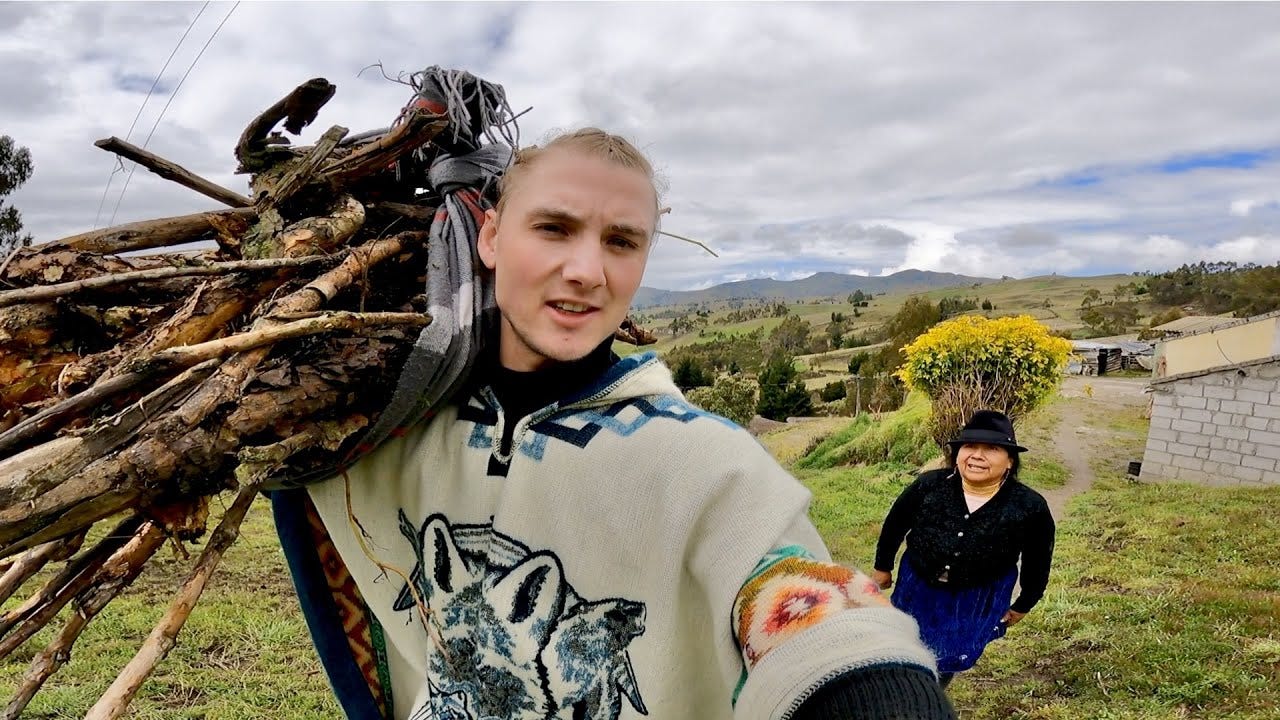
Where to go. Where to stay. What to eat and what to do
If you clicked on this Ecuador travel guide expecting to read about the Galapagos Islands, well then I’m sorry to disappoint you!\ This is my exclusive travel guide to Ecuador. Whilst The Galapagos Island are a magical, no doubt. Ecuador has so much more to offer. That is what this travel guide is all about. It’s about the hidden gems- Where to go. Where to stay. What to eat and what to do, and one place to skip- This is Ecuador According to Pilgart Explores.
Quito
Quito, one of my favourite capital cities of South America. In my book it’s right up there with Buenos Aires and Santiago. Buenos Aires feels very European. Santiago has an American feel to it. Quito… Well Quito feels like proper South American, it has a similarity to Cuzco, just bigger and more developed. I think it is that perfectly balanced mix of Incan and Spanish influence. The historic centre with it’s buildings that tell so many stories, as they roll up and down the Andean foothills, through the valley in which Quito sits. Surrounded by towering mountains, inviting me to go out and explore what they have to say.
Where to stay
-
The budget option
-
Centro, cheap hotel or hostel
You will be close to the historic centre with all the touristy things nearby, at night it’s a different story though. At night the historic centre is pretty dead, the zombies come out and you don’t want to be strolling around late in the evening.
-
The unique
-
La Floresta neighbourhood
I booked an AirBnB in La Floresta, a local middle class area, located just south of Quito’s top neighbourhood El Batan, as well as within walking distance to the historic centre. La Floresta itself had a few small hip cafes & restaurants and plenty of shops for me stock up, on everything I needed for cooking at my AirBnB. I will highly recommend staying in La Floresta.
-
The top-tier
-
El Batan neighbourhood
El Betan is Quito’s top neighbourhood. This is where you wanna stay, if you have the budget. The area is packed with all the best restaurants in Quito, The best parks of Quito and it’s easy to get to the city centre from El Batan.
What to eat- and where
-
The budget option
If you like Fish and Chips then you will like this. Corvina can best be described as Ecuador’s version of Fish and Chips. Pieces of battered fried fish served with chips, rice and a hearty lentil stew, to mix with the rice. You will find Corvina at most street restaurants, as part of a cheap $3.5 lunch menu or as a stand alone dish. Corvina is one of Ecuador’s National dishes, it will get you full for cheap and set you up nicely for a days worth of exploring in Quito.
-
The unique
This beautiful whole pig, slow roasted over night in the oven giving the skin a satisfying crunch and making the meat juicy and tender. Horneado is the absolute best bang-for-ya-buck food I ate in Ecuador.
As you enter Mercado Santa Clara, head to the food court and find Galo- Galo will be easy to find with the massive whole roasted pig lying on his work desk. You will pay $4 for a generous serving of the softest, juiciest pork meat you have ever had, served with a creamy sautéed mashed potato.
 Galo preparing Horneado
Galo preparing Horneado-
The top-tier
-
Somos Ecuador Restaurante
Somos Ecuador; a high end restaurant serving innovative takes on all Ecuador’s favourites. From Ceviche and Seafood casseroles to roast pork and stunning stews- A dinner at Somos Ecuador will set you up, just perfect before you leave the city, heading out into the rest of Ecuador. Here you will get the complete tour of Ecuador’s diverse kitchen and flavours. Put it on your list.
What to do
-
The budget option
One thing I always love to do, no matter where I am, is to explore the markets. I’m not talking about the artisan markets, I’m talking about the local everyday markets. It’s the smells of the local produce for sale, the women yelling their prices out the top of their lungs, as if some sort unspoken announcer-competition is going on. It’s the overwhelming noise of conversations in indigenous languages I don’t understand. A random shop blasting some loud horrendous reggaeton music- I’ve never understood that as a sales tactic, I’ve always found myself turning away from such shops ASAP. Most of all, the local markets are all about the food and the understanding of local culture. I can spend hours strolling round a market, observing the way people interact, what words are they using? How is the body language? What are the topics of conversation? What is the fashion like? Answers are presented in overload- all I have to do is open my eyes and observe.\ Best of all, this is a free, forever repeatable experience.
-
The unique option
-
Mitad del Mundo
The monument that marks the Equator line, runs just north of Quito. It is easy to get there, just head to Terminal La Ofelia, a smaller bus station in the north of the city. From here you can catch a bus to Mitad del Mundo- The middle of the earth. It takes about 30-40 minutes to get there. The monument and science/history park around it, is extremely well done. I spent a couple hours here learning about Ecuador’s history, indigenous people and I had lots of fun playing around with all the science installations. In the interactive science museum you can try your hand at a handful of fun, interactive gravity games, making the science of magnetics field and gravity come to life. It’s well worth a visit.
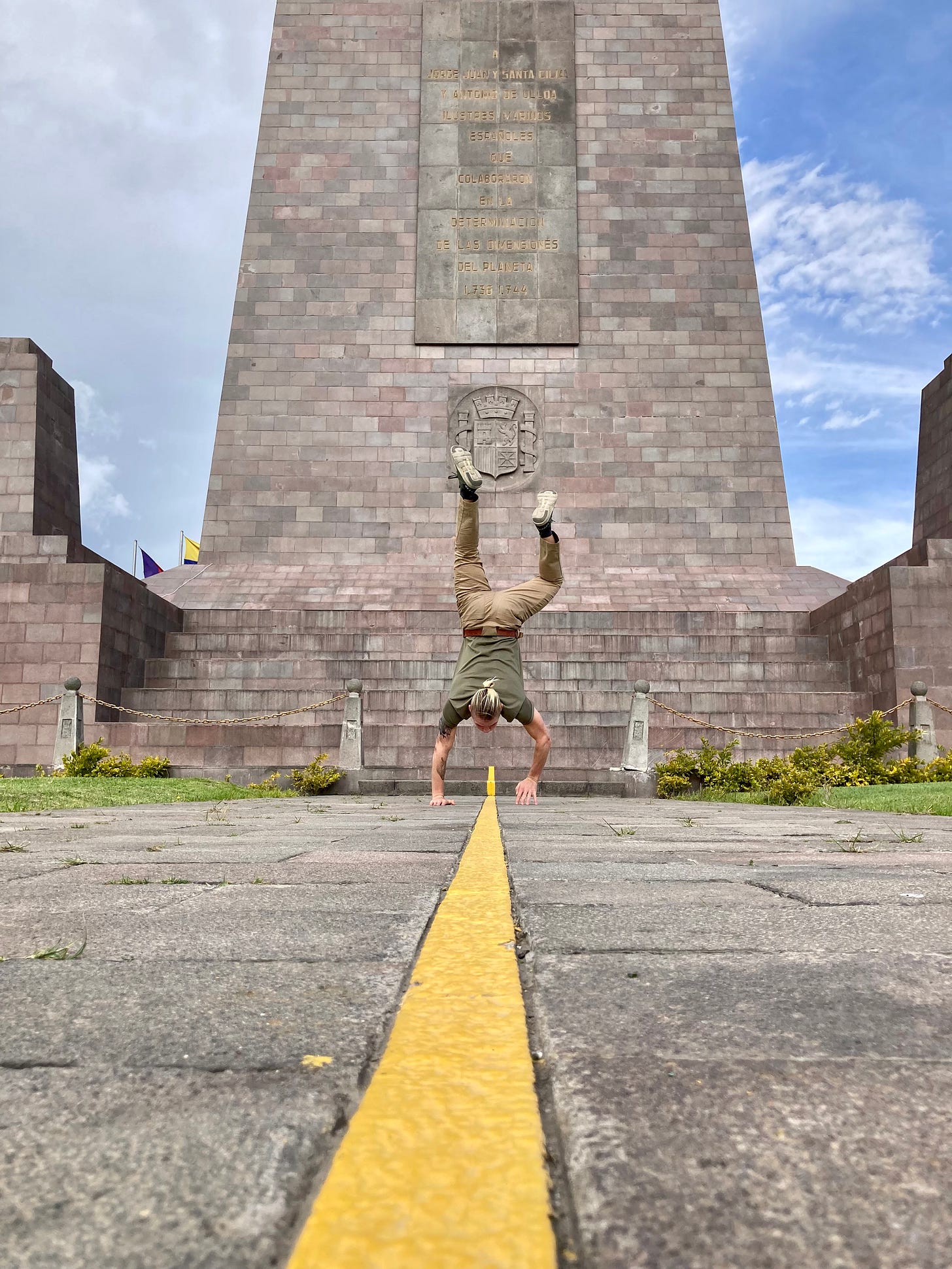 The Equator line, Mitad del Mundo
The Equator line, Mitad del Mundo-
The explorer option
Get in an Uber, head for the neighbourhoods in the south of Quito. The locals will tell you “Don’t go there!”. Sure enough the Uber driver did look twice at me, when he pulled up, expecting to pick up a local. He asked, confirming that I hadn’t messed up my locations, “if I was sure I wanted to go to the south?” “Of course” I said.
The deep south of Quito is yet another example of why I leave the Lonely Planet on the bookshelf. Because it is experiences that lay beyond the realm of Lonely Planet guide books, which allows me to understand and connect with a country. In this case Ecuador. The Lonely Planet guide books won’t tell you to head to the south of Quito, for anything but reaching the southern bus station. Yet, as I step out my Uber, I quickly head to a local market, where I’m met by the loveliest people. A mother calls me over. She offers me her daughter. I laugh. I buy us all an ice cream, before I take a seat at the negotiation table, only to tell them I’m already taken.
The feeling of genuinely great people sits with me, as I leave the little, Centro Comercial Chiriyacu behind. I head into the streets. The streets in the south of Quito are different, they are industrial, full of people hustling. I need to watch out where I step, as I’m weaving my way, between fruit vendors setting up shop in the middle of the side walk. Every few blocks there’s a small simple restaurant or a street food vendor, providing snacks, I don’t look at the map, there’s no need, I just follow my instincts and walk. Contrary to what I was told, I had great day in the south of Quito. Picking up some exotic fruits and vegetables, eating some random street food, talking to the locals, getting a peak into the real, non-polished side of Quito life.
Village Life by Lake Quilotoa
The extinct Quilotoa volcano is a highlight of any journey through Ecuador, but there is another side to Quilotoa. A side few know about. A side that provides a glimpse into the real life, up here, tucked in between the Andean mountains. I met Cesar the owner of a family run boutique hotel, located in the indigenous villages on the slopes of the Quilotoa volcano. I jumped at the opportunity, when Cesar offered to host me for few days, at the his hotel and give me a tour of the Volcano, go swimming in the lake, at the bottom of the crater and see the real life of these indigenous villages.
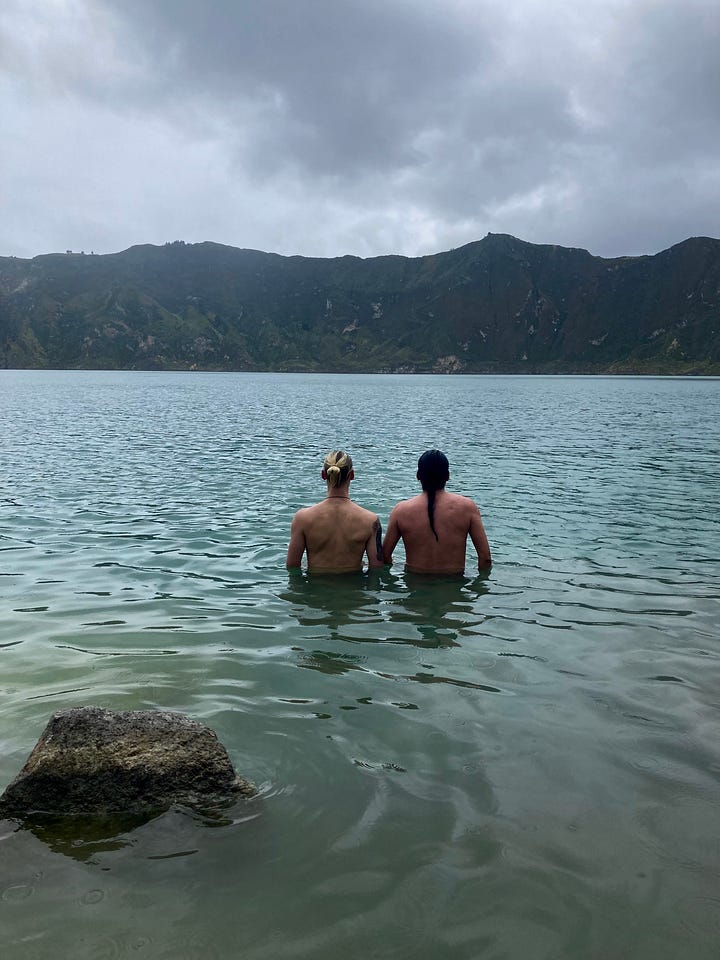
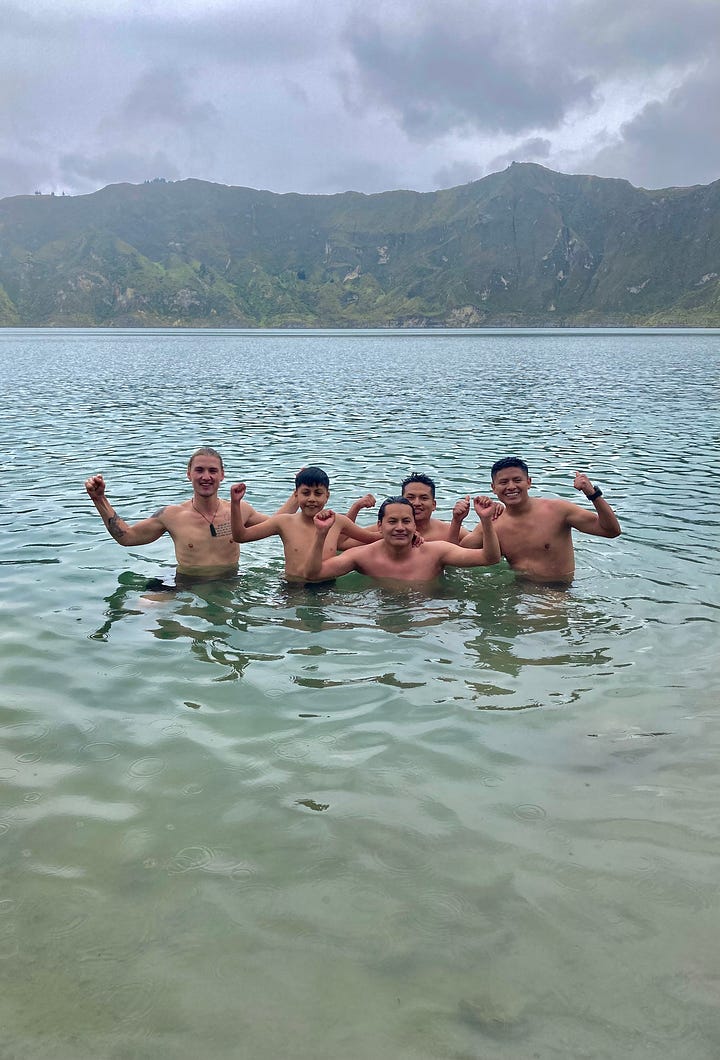

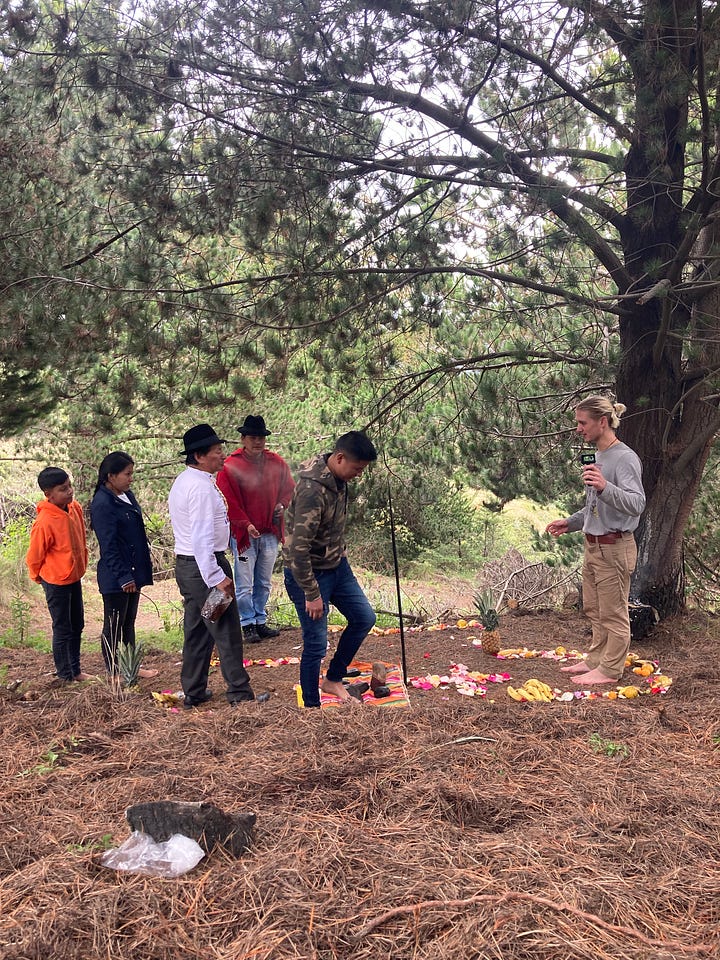 ##### \
Where to stay
##### \
Where to stay-
The budget option
-
You can stay in an accommodation in the little tourist town of Quilotoa, on the crest of the volcano, with all the other tourists. There are plenty of options in the little town, non of them looked particularly special in any way, but it’s easy to get to.
-
The top-tier
-
Hosteria Juyende: A rustic, wooden cabin-like family run hotel, with a stunning view to the surrounding mountains. Located just below the crest of the Quilotoa volcano. You either ge to Hosteria Juyende by car or you take a bus to Quilotoa town, from where you hike to the breathtaking viewpoint; Mirador de Cristal Shalalá. From the viewpoint simply walk down through the little shopping area, set up by the Shalalá Community- consider supporting their crafts, I bought the poncho which I’m wearing in the video I made in whilst staying at Hosteria Juyende, do check out the video of the hotel and the walk around the crater here. Once you have checked out the shops, you will continue down the little road for another 10-15 minutes and Hosteria Juyende will be on your left.
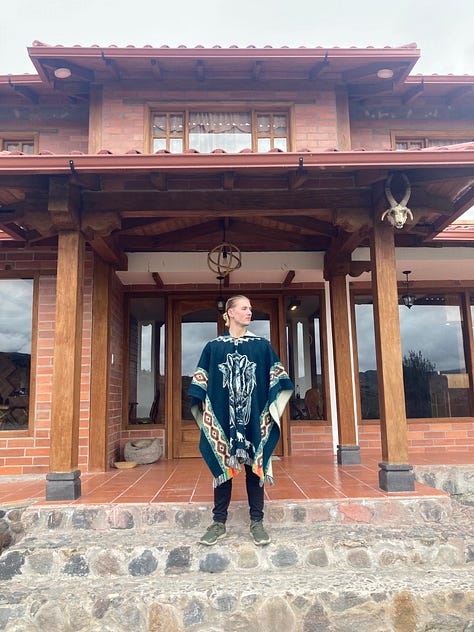
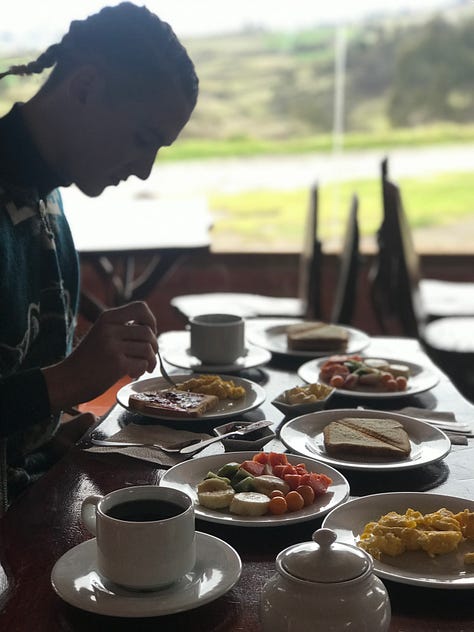
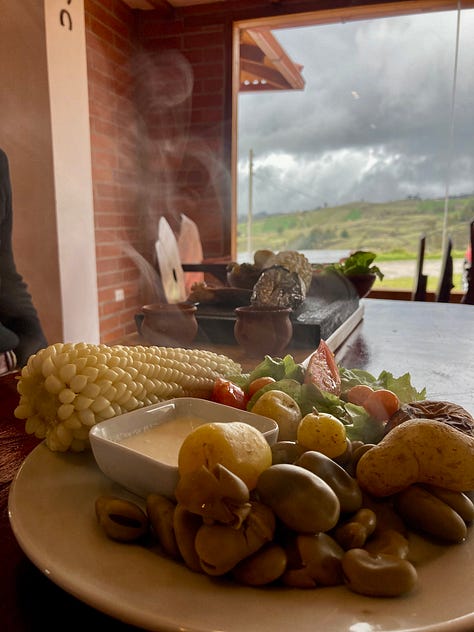
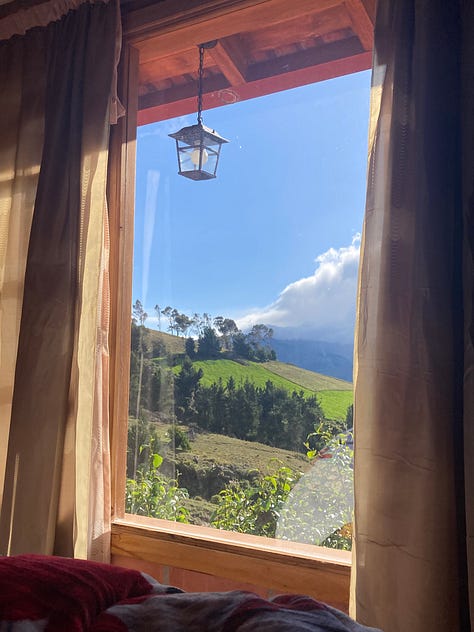
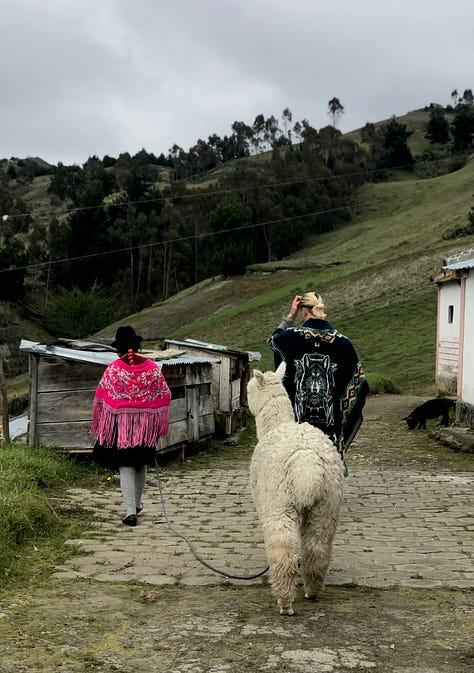
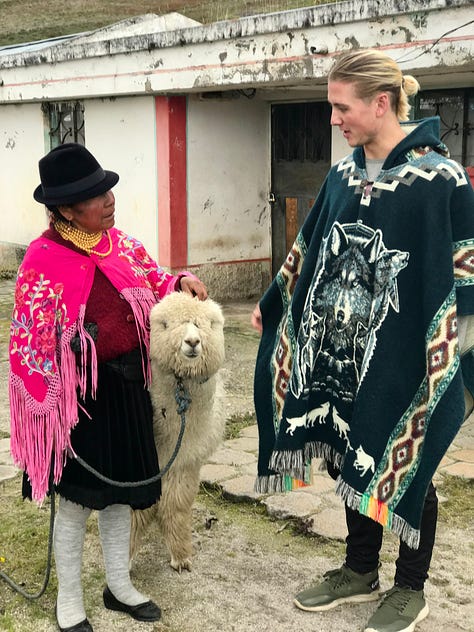 Hosteria Juyende, Comunidad Shalalá, Quilotoa
Hosteria Juyende, Comunidad Shalalá, Quilotoa
What to eat- and where
Cuy or Guinea Pig is a delicacy in the Ecuadorian Andean mountains. I had the pleasure of preparing Guinea Pig over fire, with Cesar and his family. In the morning I helped collecting the firewood, before heading off, to walk the Quilotoa Crater Loop. When I came back in the afternoon, Cesar had the fire going. I quickly sat down on the benches surrounding the fireplace. Before I knew it, I was handed a stick with Guinea Pig pierced to the end. Here I sat in the middle of the majestic Andean mountains, drinking some warm home-brew alcoholic punch-like drink called Canelazo. We continued to turn the guinea pig and sip our drink. The guinea pig itself is stuffed with Andean herbs, prepared till the skin is crunchy, then served with potatoes. The taste can best be described ,as something akin to rabbit, as you can imagine there isn’t much meat on the little fella. The taste is good though. Especially with some Canelazo- that stuff is dangerous.
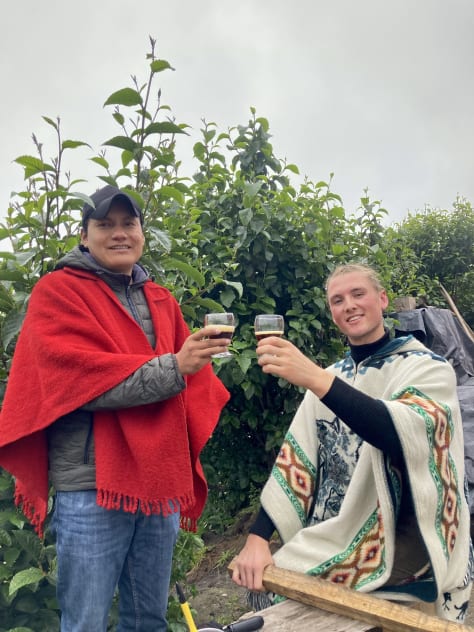

 Preparing Guinea Pig
Preparing Guinea PigWhat to do
- Walk the Quilotoa Crater Circuit, 3800masl, 10,3km, 4-5hr
The Quilotoa volcano is extinct with an enchanting turquoise lagoon at the bottom of the crater. The day hike around the crater circuit is quite literally breathtaking. The breathtaking views are constant- be warned your camera reel is going to get full. Besides that, the hike is not for the faint of heart, at various points you’ll find yourself walking along the rim of the crater, on a trail no wider than a couple meters, with a huge drop to either side. Do approach with caution, if you suffer from vertigo. That being said you will not regret completing the circuit. It is one of the best day hikes I’ve done in anywhere in the Andes. There is even the option of hiking down to the beach by lake at the bottom or camping at a few campsites along the crater rim.
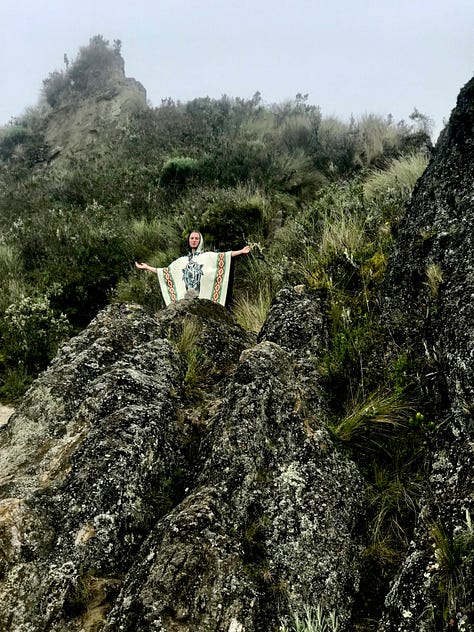
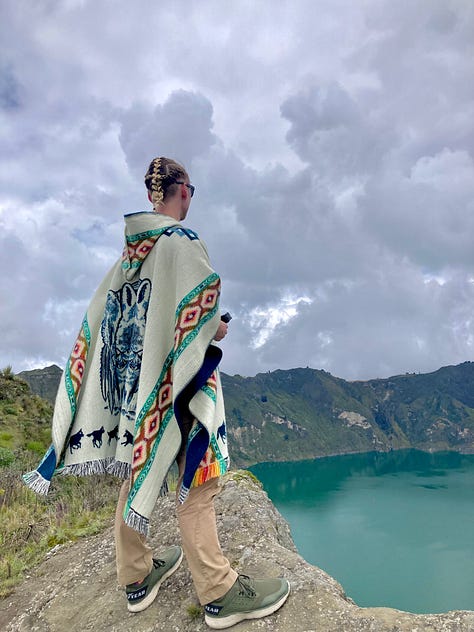


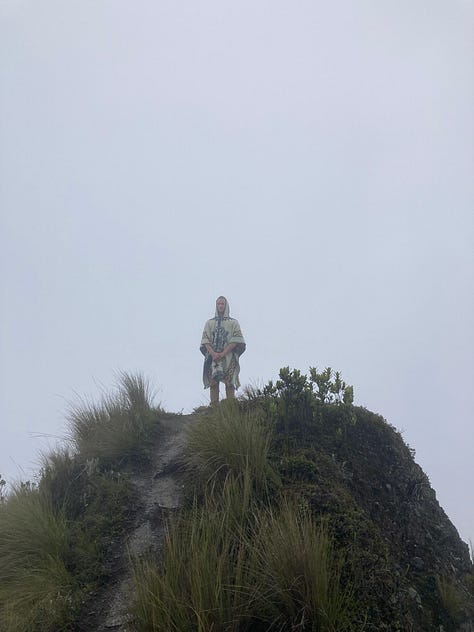
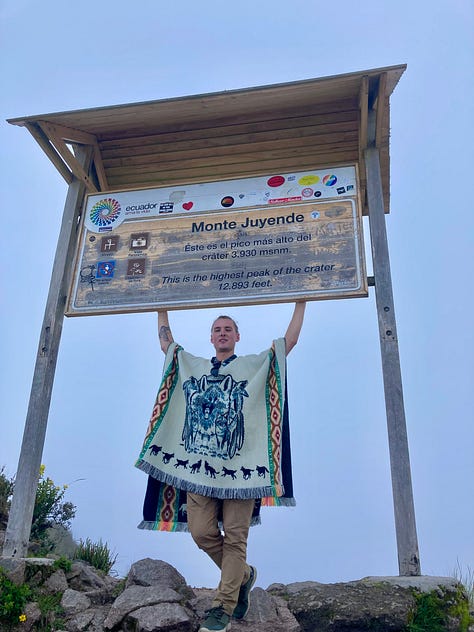 Quilotoa Crater Circuit
Quilotoa Crater CircuitWhen you are staying at Hosteria Juyende, make sure to explore the villages of Shalalá and Ponce, this will give you an authentic glimpse into indigenous village life in Ecuador. These communities are agricultural villages, so you will see plenty of llamas and alpacas around. If you are lucky you might even be invited to play a game volleyball.
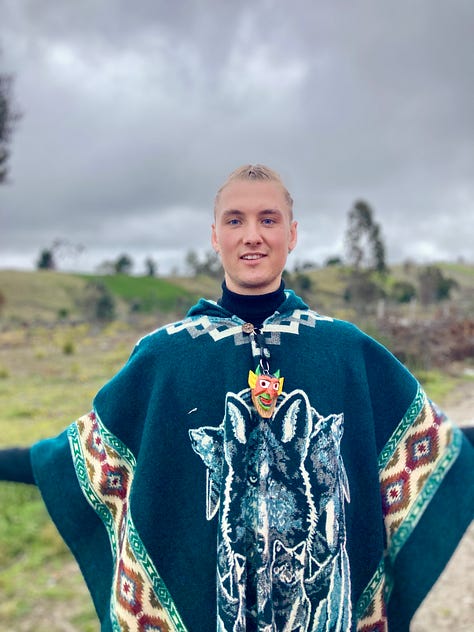
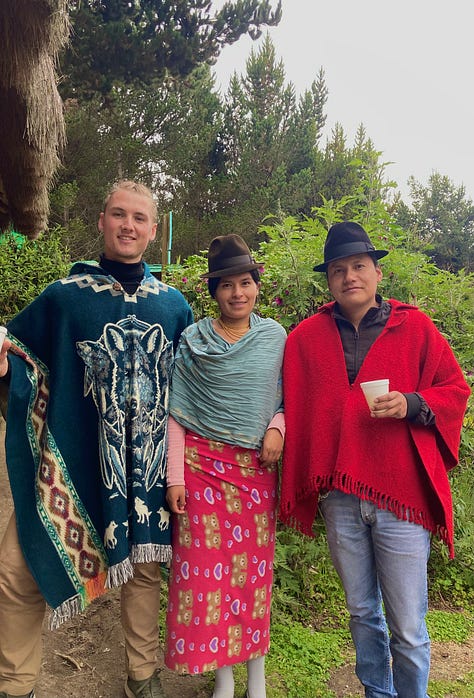

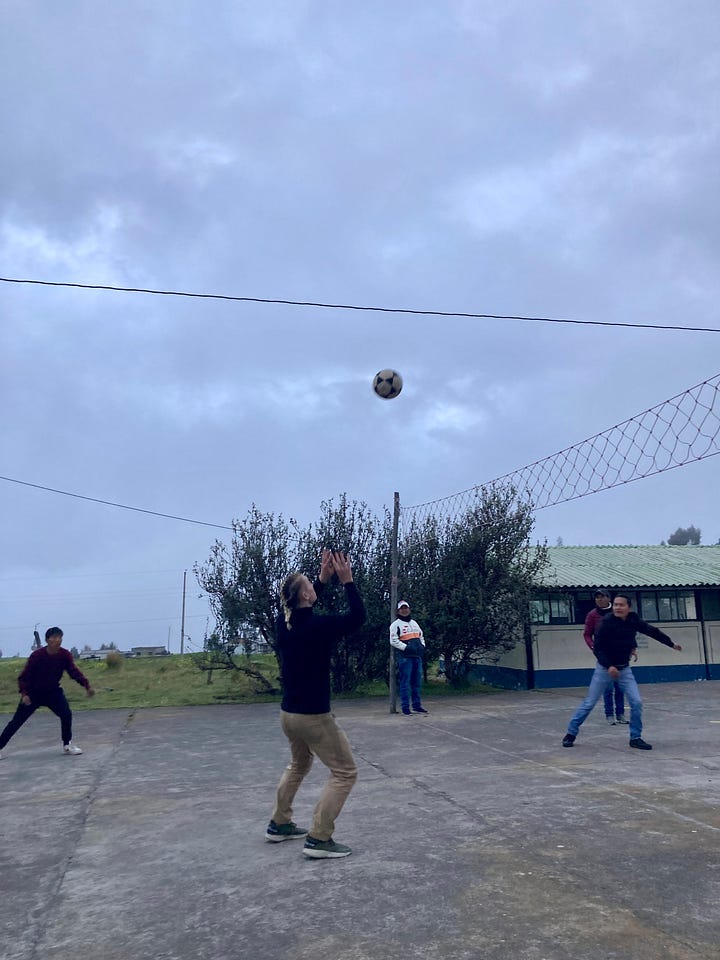
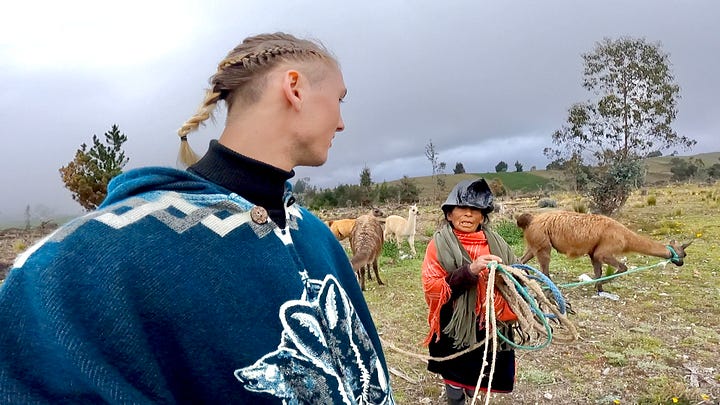 Village Life in Ecuador
Village Life in EcuadorAs dusk was falling over the village, Cesar wanted to show me the most popular sport around here, volleyball. A group of lads were getting ready to play as we pulled up, the mist was falling in the air, it was cold. The ball was a heavy futsal ball, getting increasingly wet from the mist, making it feel like I was getting punched in the forearms every time I responded a serve, but I couldn’t loose face here. I ate the stinging pain. Check out my video from the villages here: You can watch our game of volleyball at the end.
Once a week on Saturday morning Zumbahua comes allive, farmers from near and far flock the town. Zumbahua is located on the highway which connects Quito and the Andes, with the Pacific coast and main port city, Guayaquil. And let me tell you it is one hell of a farmers market. People here are buying and selling llamas, sheep, pigs and fruit and veg by the truckload. Pigs are screaming as they get manhandled and sold. Sheep are shitting all over the floor- so don’t wear your beautiful shoes. Once you make it to the food hall, you can indulge yourself in anything from goat head soup to beef served with mashed potatoes and eggs. Once you’re done, you head back outside to wash you breakfast down, with a few shots of sugar cane alcohol. Then you head for your siesta.
It is unlike any other market I have ever seen! This is one of those experiences that will stay with me forever. The weekly farmers market in the nearby town of Zumbahua was our last activity in the area around Quilotoa- check out my video here.
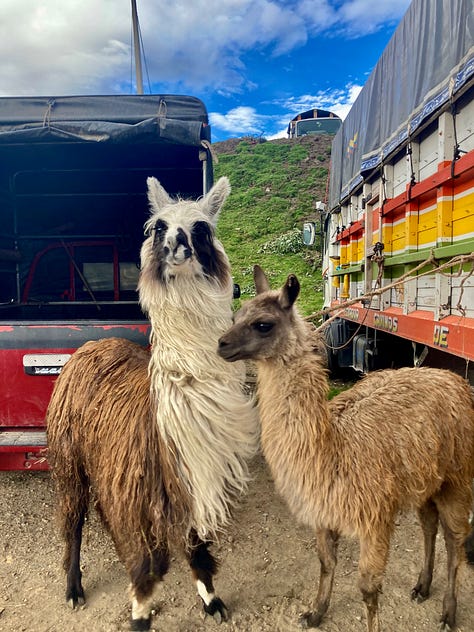
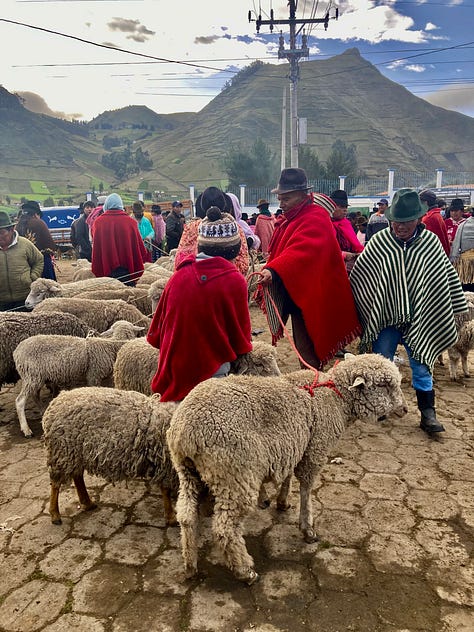
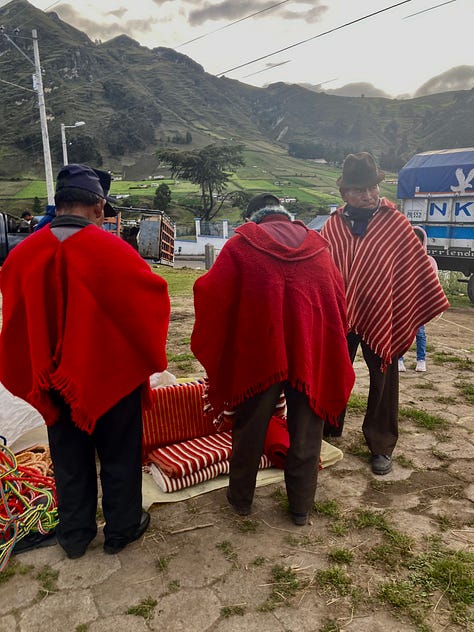
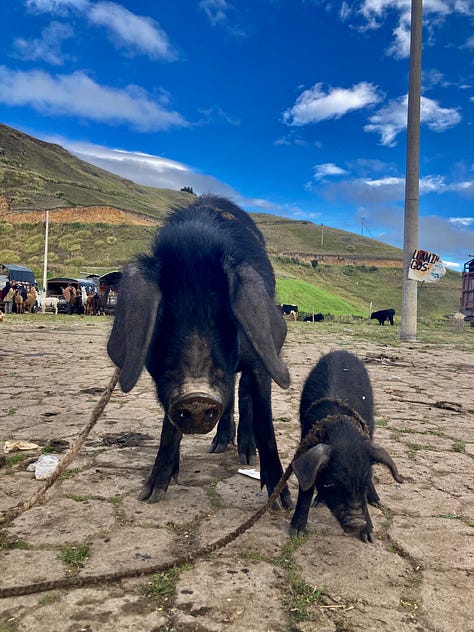
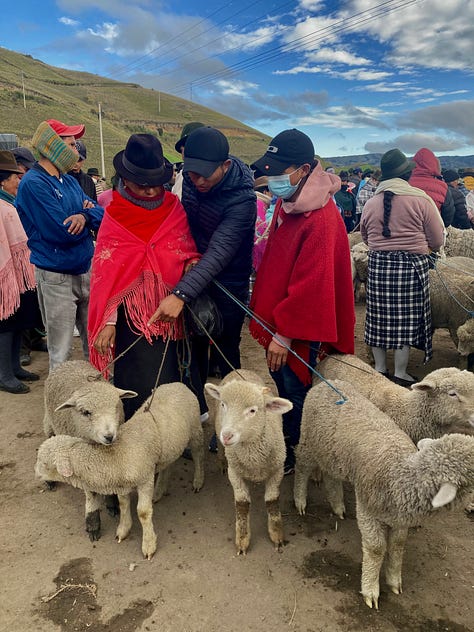
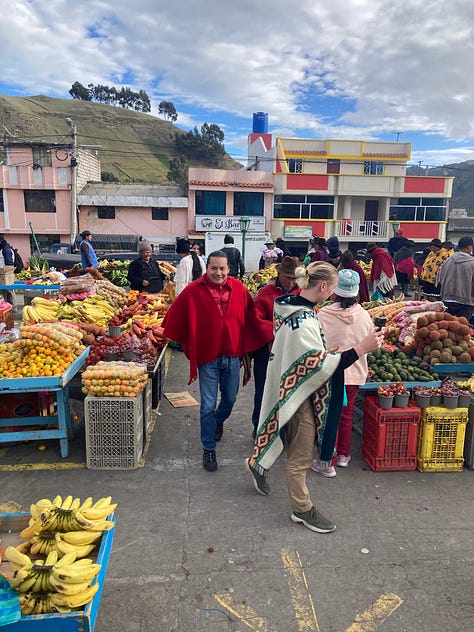 Zumbahua Farmers Market
Zumbahua Farmers MarketSan Jose de Morona - The Gateway to the Amazon Jungle
How to get there
From Ambato/Baños or from Cuenca you get a bus to Sucua. Once in Sucua, a small town on the north-south Amazon Highway, you get another bus to Puerto Morona/San Jose de Morona. I had an overnight stay in Sucua, before continuing on towards San Jose de Morona. You don’t need to stop over in Sucua. Once you reach San Jose de Morona, that’s when the adventure begins.
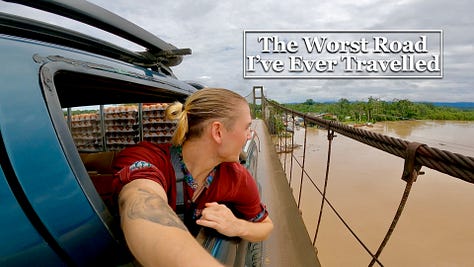
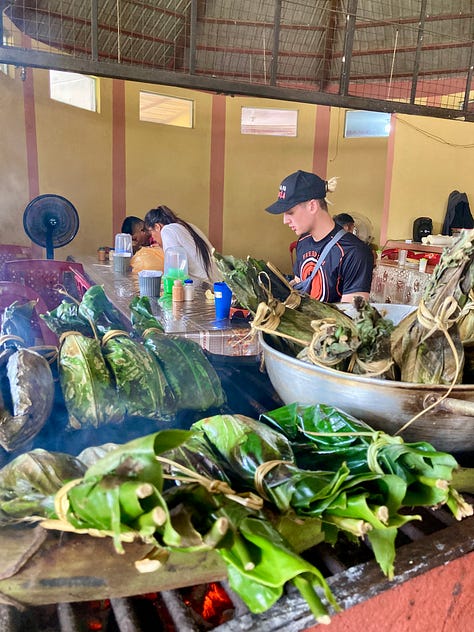
 Images from the road to San Jose de Morona
Images from the road to San Jose de MoronaI stayed in two nights in San Jose de Morona, at a basic accmmodation called Hostal Monteverde. It was nothing fancy, but it was the only option in town. I spend the following day mingling with the locals, trying to figure out how to get to my actual destination; Antuni. An indigenous Community about 5 hours up river, in a typical motor driven jungle canoe. I had been tipped off about the existence of a lodge in Antuni, I was determined to make it. I wanted to know what indigenous village life is like, deep in the Amazon. So here is how to get to Antuni. (Watch my experience of getting to and staying in San Jose de Morona right here)
Deep in The Amazon - Living With Amazon Tribes
The next morning, I stood ready by the roadside, outside my accommodation in San Jose de Morona. Waiting for a pick up truck to come by- that’s the bus in these areas. I hoped on the back, as I stood there on the back of a pick up truck, with the wind in my hair, I was filled with excitement for the adventure I was about to embark on. I was about to go 5 hours up river, into the deep heart of the Ecuadorean Amazon, to live 3 days as a part of an indigenous tribe village.
As we reached the little harbour Puerto Kashpaimi, I tapped the side of the car to signal to the driver to stop. The river was high, the water racing with a raging pace, carrying tree trunks down stream, as it’s passengers. The day before, I had arranged to meet my boat driver here at the little harbour in Puerto Kashpaimi, he was going to steer us safely past all the tree trunks to his community, Antuni.
As we reached Antuni I was shown to the community lodge. I of course needed to pay a fee for staying in the community lodge. I negotiated a fee of 15 dollars a day. On top of that, I payed an extra 5 dollars for a load of bananas of yuca, a sort of sweet potato like root, as well as some eggs. If you decide to follow in my footsteps, make sure to bring your own food supplies, the little lodge has a basic jungle kitchen with a gas stove, for guests to cook their own food. I stupidly hadn’t thought this far. Do not make the same mistake. I had arrived fairly unnoticed, so they weren’t prepared for my visit.

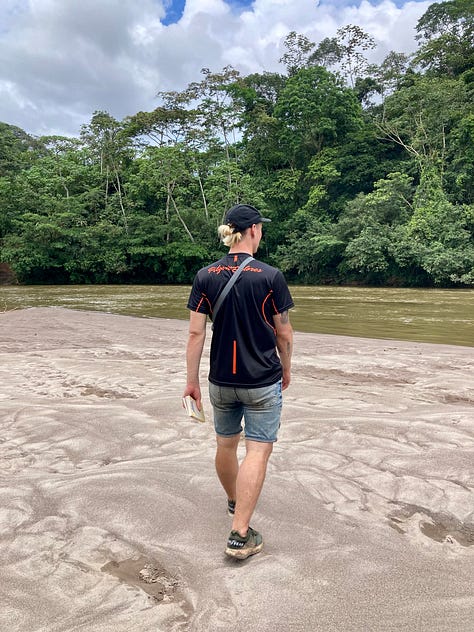
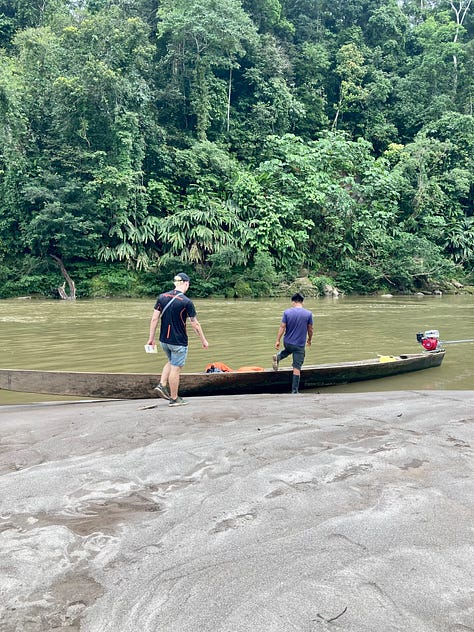
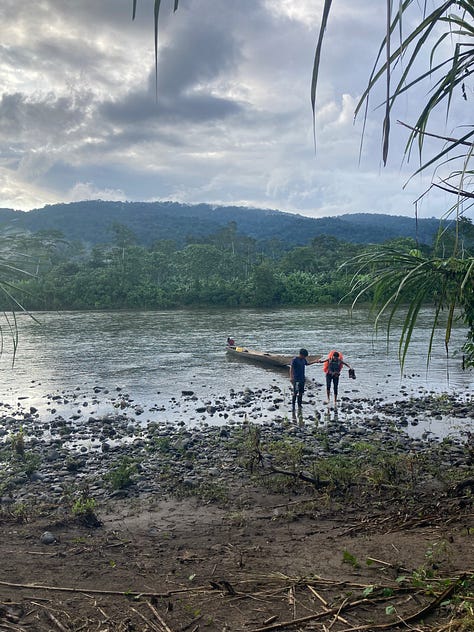
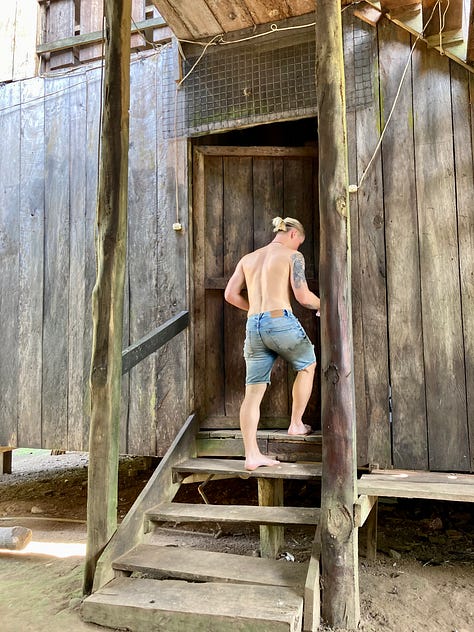


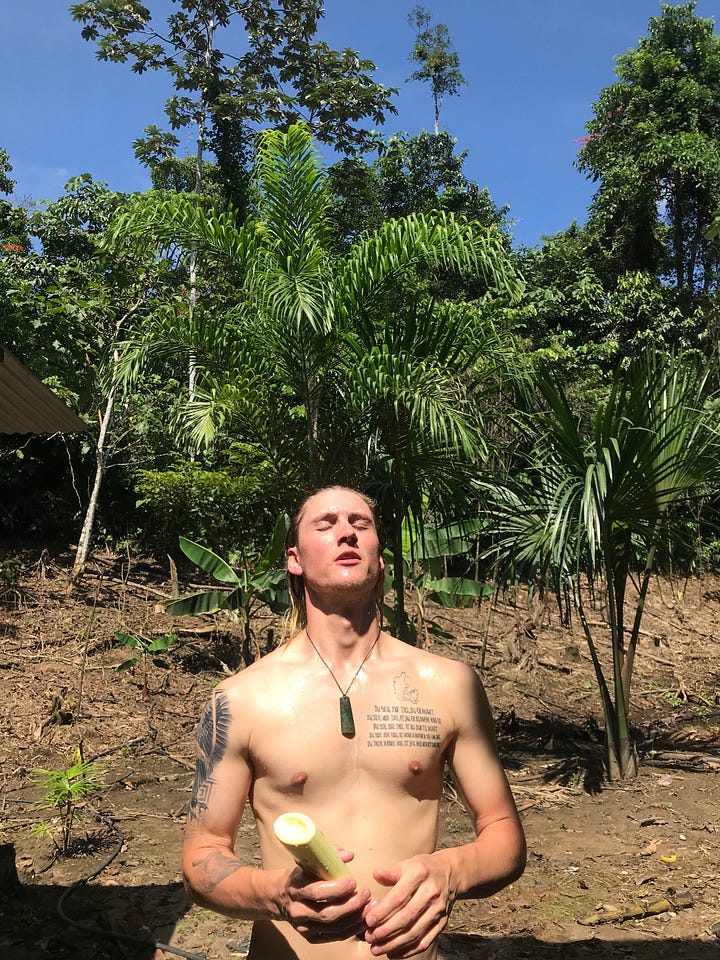 On the way to Antuni, the lodge with it's shower
On the way to Antuni, the lodge with it's showerLife Deep in The Amazon
During my time in the Antuni, I was part taking in village life. I went net-fishing with down by the river. I was thoroughly schooled by two little kids, they can’t have been more than 6-8 years old, but they had the technique on lockdown. They were way better than me, at this game of fishing. I went back, up the river bank, to the village. The men were sitting around the eternal fireplace drinking chicha, the local home-brew alcoholic beverage. The chica is made from yuca, the women chew the yuca into small pieces, then spit it into a big clay pot, where they proceed to grind the yuca till it reaches a soft, mashed potato like texture. Then they add some water and boil it for 40 minutes to an hour. Then set the chicha aside and let the fermentation take place. The result is a drink with an almost yoghurt like texture, the taste is a strong fermented taste.
As I sit and drink the chicha with the men, the two young boys come back from the river, with the days catch. The village dogs greet the two boys and follow them to the kitchen, hoping to get a bite- so do I. In the kitchen a woman is preparing the two fish the young boys caught, one Boca Chica and one Raspa. The fish are wrapped in banana leaves seasoned with salt and a version of garlic native to the Amazon, a leaf that when cut, has the same taste as a garlic clove. Out here in the jungle they have everything at hand.
What to eat
- We had two different fish, Boca Chica and Raspa. Preparation goes like this: Wrap a fish in banana leaves, stick it right in the middle of the fire, wait 20 minutes till the outer leaves are burnt, take the fish out of the fire, open the leaves and devour the most beautiful fish. Serve with steamed plantain and home made chilli sauce.
What to do
- Take one of the locals as your guide and head for a jungle walk. This is one the most magical experiences on this planet. You will see spiders, insects and all other animals in shapes, colours and sizes, you can’t even imagine. If you are lucky, you might even catch a glimpse of Jaguar or Puma strolling by. The sounds of the Amazon are at times deafening, the jungle is so thick that you can’t see much further than 5 meters ahead, everything looks identically green- make sure to stay within hearing distance of your guide, or you will get lost, walking in circles. The locals have an almost superpower like skillset, in the middle of this blanket of animal noise, they can pick out each sound. A few moments later they point up to the canopy, at group of monkeys jumping around. How these guys are able to pick out the sound of one specific animal, with 100% accuracy is still beyond me, I’m not sure they are human…
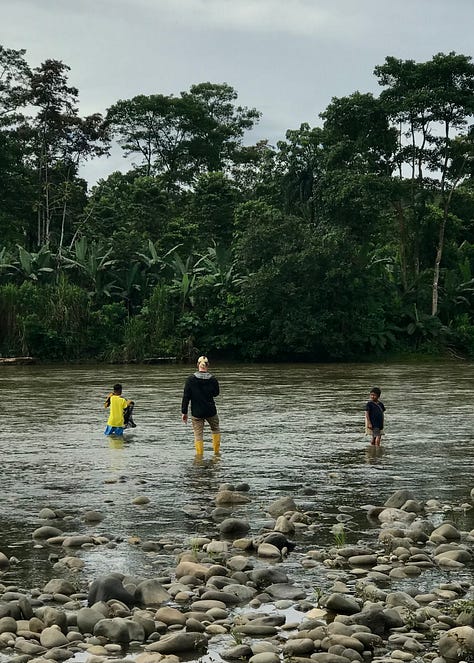
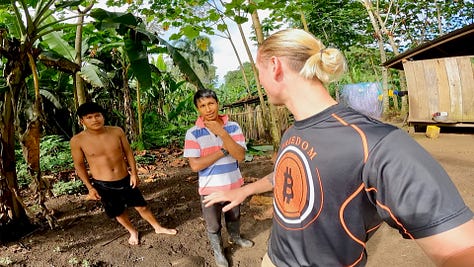
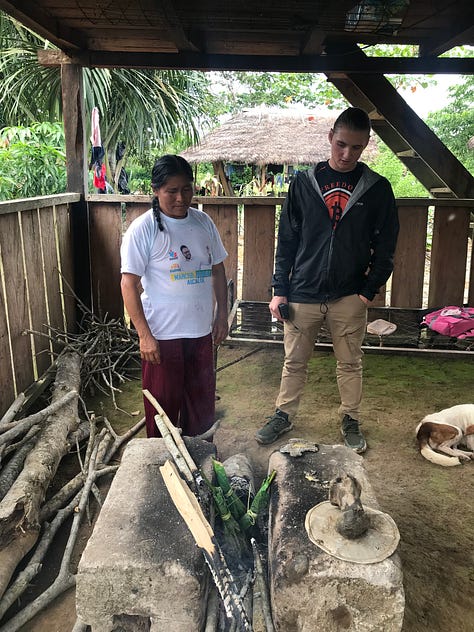
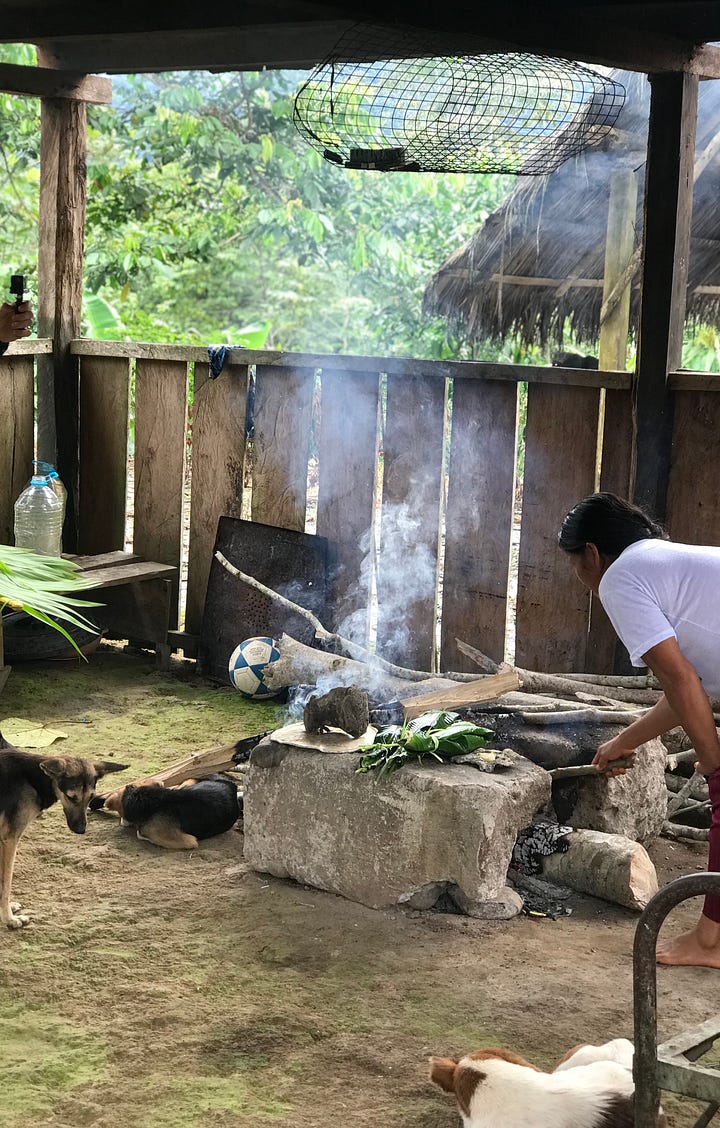
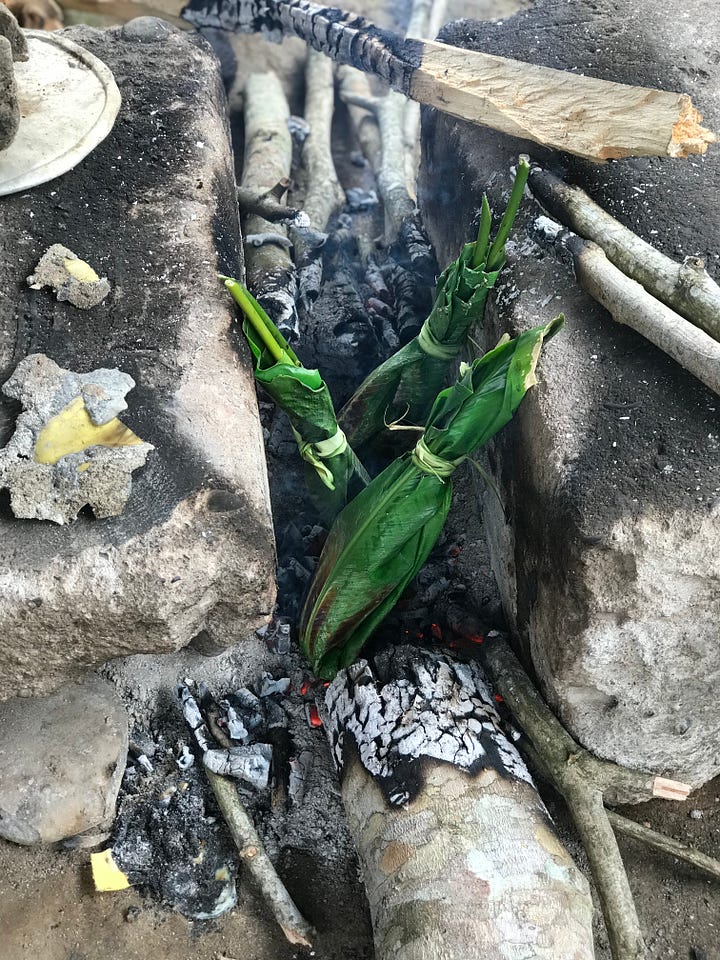
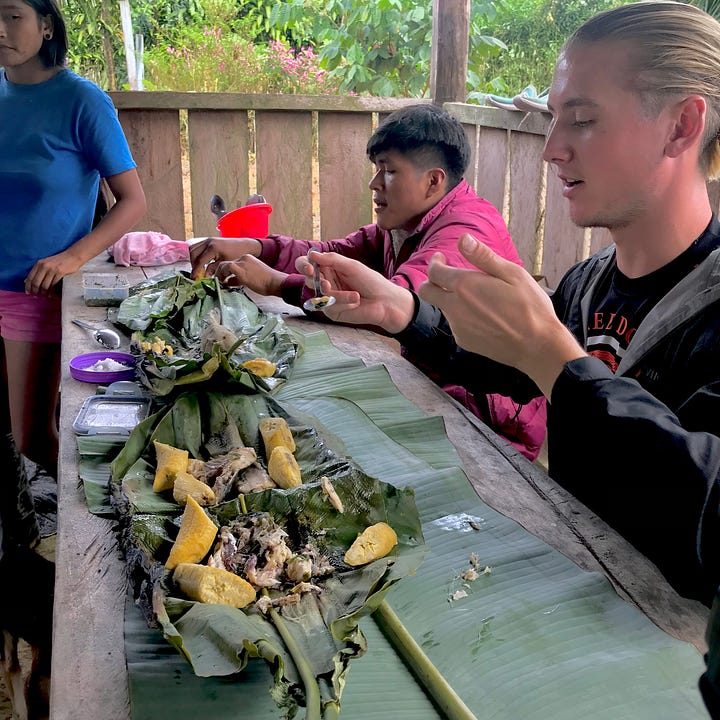
 #### Guayaquil - Ecuador’s Worst City
#### Guayaquil - Ecuador’s Worst CityGuayaquil Ecuador’s main harbour city, sitting surrounded by mangroves on the pacific coast. Chances are you will have to come here, on your trip through Ecuador. Guayaquil is the hub for travellers heading to the Galapagos Islands. Guayaquil has in the last few years been caught in an escalating gang war. A war about controlling the drug market in the city. Guayaquil also serves as hub for Colombian cocaine, making it’s way to the United States. A lucrative market to control. When I was in Guayaquil, the Ecuadorian president had placed the city in a curfew. The streets had to cleared by 8pm, if you had circulate, you had to catch a taxi, preying that the gangs roaming the streets at night, would leave you alone. Watch my video exploring Guayaquil here.
My suggestion to you is: Don’t go to Guayaquil, unless you are going to The Galapagos Islands. Instead continue further up the coast, to a small beach town called Puerto Lopez.
Puerto Lopez
Puerto Lopez is a quaint fishing village and beach town on the coast. Boasting a peaceful beach with plenty of small beach restaurants and bars to hang out at, whilst you spend your day sipping on Piña Coladas and swimming in the ocean.


 Playa Puerto Lopez
Playa Puerto LopezWhat to eat- and where
-
The budget option
-
Encebollado - Eat at small beachfront restaurants
Head out of town in a tuktuk towards Machalilla. Take a stop at the shack that speaks to you, the most. Take a seat. Enjoy the view. Order yourself an Encebollado- A delicious unpretentious Ecuadorean fish soup, that you can find in most of Ecuador, but the coast line is it’s home region. This is where you’ll eat the original Encebollado.
-
The unique
-
Cazuela de Mariscos - Eat at Romance Marino
Imagine Paella meats Fish Soup meets tropical coconut milk- Ahh splendid. That’s exactly what I thought, when I first triad Cazuela de Mariscos. It is the soft and creamy texture from the coconut milk & peanut paste, the achiote spice that gives the casserole a kick up it’s arse, sprinkled with fresh lime juice and coriander as it’s served. This is Ecuador’s best seafood dish by far, and what a dish it is. Enjoy with a cold beer.
-
The top-tier
-
Grilled Squid - Eat at Sabor Español
Grilled squid is one of my favourite dishes in the entire world. It is simple and unpretentious. It is hard to prepare right, if you cook it too long the squid becomes rubbery and chewy. On the other hand, if you nail it, it is like eating a white wine and garlic infused butter. In Puerto Lopez there is place called, Sabor Español, they know how to do Grilled Squid. Freshly caught in the morning and bought at the local fish market. In the evening thrown on the grill, prepared to perfection with Garlic and White wine. Enjoy with jug of sangria.
What to do
-
The budget option
-
The Morning Fish Market
Get up at sunrise, walk to the south side of the beach. Here you will find the fish market. This is fish market is the main daily event in Puerto Lopez. The locals flock here to buy, freshly caught seafood. Be warned you will also see some heartbreaking images, for at the fish market, sharks are brought in, only to have their fins cut off. Who buys them? Well you guessed it, the Chinese. The shark fins are purchased by local businessmen, who resell them on to the Chinese in Guayaquil. In China, shark fin soup is said boost ones libido, cure cancer and most of all show of wealth and hospitality to special guests.
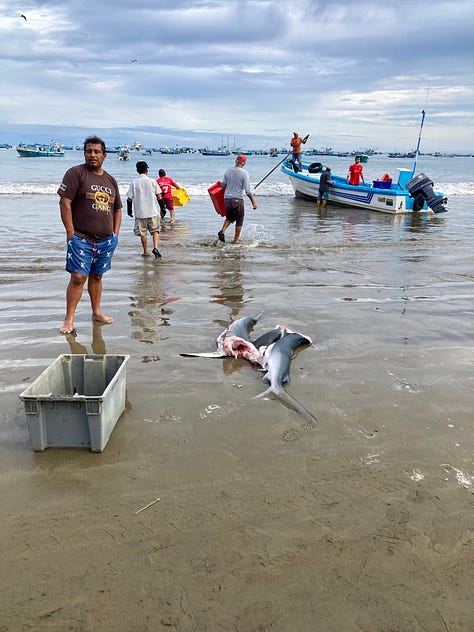

 Puerto Lopez Fish Market
Puerto Lopez Fish Market-
The explorer
-
Playa Salango
If you are like me, you love a wild beach with big waves. Unfortunately the Puerto Lopez beach is a calm and quiet beach. Fortunately, the next town south of Puerto Lopez has wild beaches, en masse. You get on a bus from Puerto Lopez to Salango Beach. From Salango beach you head around the cove, walk down the wild beach front. After about a 30 minute walk, you will reach a more secluded beach with a bunch of small restaurants serving all Ecuador’s classics, and of course they have beers, ice cold beers to enjoy after your walk along the beach front.
There you have it, that is Ecuador according to Pilgart Explores. I told you it wasn’t going to be your average Lonely Planet-like travel guide. No, I have been to all these places and can personally sign of on them, as the greatest locations to visit in Ecuador- According to me, of course. By all means, do visit some of the more touristy places, such as Cuenca, Vilcabamba and Baños. But make sure to leave the beaten path and head of for some real authentic adventure. Pilgart Explores style.
\ I hope I convinced you to put Ecuador on your list. Leave a comment down below if I inspired you to go to Ecuador. All I know for sure is, that I will be back.
-
-
 @ a367f9eb:0633efea
2024-11-05 08:48:41
@ a367f9eb:0633efea
2024-11-05 08:48:41Last week, an investigation by Reuters revealed that Chinese researchers have been using open-source AI tools to build nefarious-sounding models that may have some military application.
The reporting purports that adversaries in the Chinese Communist Party and its military wing are taking advantage of the liberal software licensing of American innovations in the AI space, which could someday have capabilities to presumably harm the United States.
In a June paper reviewed by Reuters, six Chinese researchers from three institutions, including two under the People’s Liberation Army’s (PLA) leading research body, the Academy of Military Science (AMS), detailed how they had used an early version of Meta’s Llama as a base for what it calls “ChatBIT”.
The researchers used an earlier Llama 13B large language model (LLM) from Meta, incorporating their own parameters to construct a military-focused AI tool to gather and process intelligence, and offer accurate and reliable information for operational decision-making.
While I’m doubtful that today’s existing chatbot-like tools will be the ultimate battlefield for a new geopolitical war (queue up the computer-simulated war from the Star Trek episode “A Taste of Armageddon“), this recent exposé requires us to revisit why large language models are released as open-source code in the first place.
Added to that, should it matter that an adversary is having a poke around and may ultimately use them for some purpose we may not like, whether that be China, Russia, North Korea, or Iran?
The number of open-source AI LLMs continues to grow each day, with projects like Vicuna, LLaMA, BLOOMB, Falcon, and Mistral available for download. In fact, there are over one million open-source LLMs available as of writing this post. With some decent hardware, every global citizen can download these codebases and run them on their computer.
With regard to this specific story, we could assume it to be a selective leak by a competitor of Meta which created the LLaMA model, intended to harm its reputation among those with cybersecurity and national security credentials. There are potentially trillions of dollars on the line.
Or it could be the revelation of something more sinister happening in the military-sponsored labs of Chinese hackers who have already been caught attacking American infrastructure, data, and yes, your credit history?
As consumer advocates who believe in the necessity of liberal democracies to safeguard our liberties against authoritarianism, we should absolutely remain skeptical when it comes to the communist regime in Beijing. We’ve written as much many times.
At the same time, however, we should not subrogate our own critical thinking and principles because it suits a convenient narrative.
Consumers of all stripes deserve technological freedom, and innovators should be free to provide that to us. And open-source software has provided the very foundations for all of this.
Open-source matters When we discuss open-source software and code, what we’re really talking about is the ability for people other than the creators to use it.
The various licensing schemes – ranging from GNU General Public License (GPL) to the MIT License and various public domain classifications – determine whether other people can use the code, edit it to their liking, and run it on their machine. Some licenses even allow you to monetize the modifications you’ve made.
While many different types of software will be fully licensed and made proprietary, restricting or even penalizing those who attempt to use it on their own, many developers have created software intended to be released to the public. This allows multiple contributors to add to the codebase and to make changes to improve it for public benefit.
Open-source software matters because anyone, anywhere can download and run the code on their own. They can also modify it, edit it, and tailor it to their specific need. The code is intended to be shared and built upon not because of some altruistic belief, but rather to make it accessible for everyone and create a broad base. This is how we create standards for technologies that provide the ground floor for further tinkering to deliver value to consumers.
Open-source libraries create the building blocks that decrease the hassle and cost of building a new web platform, smartphone, or even a computer language. They distribute common code that can be built upon, assuring interoperability and setting standards for all of our devices and technologies to talk to each other.
I am myself a proponent of open-source software. The server I run in my home has dozens of dockerized applications sourced directly from open-source contributors on GitHub and DockerHub. When there are versions or adaptations that I don’t like, I can pick and choose which I prefer. I can even make comments or add edits if I’ve found a better way for them to run.
Whether you know it or not, many of you run the Linux operating system as the base for your Macbook or any other computer and use all kinds of web tools that have active repositories forked or modified by open-source contributors online. This code is auditable by everyone and can be scrutinized or reviewed by whoever wants to (even AI bots).
This is the same software that runs your airlines, powers the farms that deliver your food, and supports the entire global monetary system. The code of the first decentralized cryptocurrency Bitcoin is also open-source, which has allowed thousands of copycat protocols that have revolutionized how we view money.
You know what else is open-source and available for everyone to use, modify, and build upon?
PHP, Mozilla Firefox, LibreOffice, MySQL, Python, Git, Docker, and WordPress. All protocols and languages that power the web. Friend or foe alike, anyone can download these pieces of software and run them how they see fit.
Open-source code is speech, and it is knowledge.
We build upon it to make information and technology accessible. Attempts to curb open-source, therefore, amount to restricting speech and knowledge.
Open-source is for your friends, and enemies In the context of Artificial Intelligence, many different developers and companies have chosen to take their large language models and make them available via an open-source license.
At this very moment, you can click on over to Hugging Face, download an AI model, and build a chatbot or scripting machine suited to your needs. All for free (as long as you have the power and bandwidth).
Thousands of companies in the AI sector are doing this at this very moment, discovering ways of building on top of open-source models to develop new apps, tools, and services to offer to companies and individuals. It’s how many different applications are coming to life and thousands more jobs are being created.
We know this can be useful to friends, but what about enemies?
As the AI wars heat up between liberal democracies like the US, the UK, and (sluggishly) the European Union, we know that authoritarian adversaries like the CCP and Russia are building their own applications.
The fear that China will use open-source US models to create some kind of military application is a clear and present danger for many political and national security researchers, as well as politicians.
A bipartisan group of US House lawmakers want to put export controls on AI models, as well as block foreign access to US cloud servers that may be hosting AI software.
If this seems familiar, we should also remember that the US government once classified cryptography and encryption as “munitions” that could not be exported to other countries (see The Crypto Wars). Many of the arguments we hear today were invoked by some of the same people as back then.
Now, encryption protocols are the gold standard for many different banking and web services, messaging, and all kinds of electronic communication. We expect our friends to use it, and our foes as well. Because code is knowledge and speech, we know how to evaluate it and respond if we need to.
Regardless of who uses open-source AI, this is how we should view it today. These are merely tools that people will use for good or ill. It’s up to governments to determine how best to stop illiberal or nefarious uses that harm us, rather than try to outlaw or restrict building of free and open software in the first place.
Limiting open-source threatens our own advancement If we set out to restrict and limit our ability to create and share open-source code, no matter who uses it, that would be tantamount to imposing censorship. There must be another way.
If there is a “Hundred Year Marathon” between the United States and liberal democracies on one side and autocracies like the Chinese Communist Party on the other, this is not something that will be won or lost based on software licenses. We need as much competition as possible.
The Chinese military has been building up its capabilities with trillions of dollars’ worth of investments that span far beyond AI chatbots and skip logic protocols.
The theft of intellectual property at factories in Shenzhen, or in US courts by third-party litigation funding coming from China, is very real and will have serious economic consequences. It may even change the balance of power if our economies and countries turn to war footing.
But these are separate issues from the ability of free people to create and share open-source code which we can all benefit from. In fact, if we want to continue our way our life and continue to add to global productivity and growth, it’s demanded that we defend open-source.
If liberal democracies want to compete with our global adversaries, it will not be done by reducing the freedoms of citizens in our own countries.
Last week, an investigation by Reuters revealed that Chinese researchers have been using open-source AI tools to build nefarious-sounding models that may have some military application.
The reporting purports that adversaries in the Chinese Communist Party and its military wing are taking advantage of the liberal software licensing of American innovations in the AI space, which could someday have capabilities to presumably harm the United States.
In a June paper reviewed by Reuters, six Chinese researchers from three institutions, including two under the People’s Liberation Army’s (PLA) leading research body, the Academy of Military Science (AMS), detailed how they had used an early version of Meta’s Llama as a base for what it calls “ChatBIT”.
The researchers used an earlier Llama 13B large language model (LLM) from Meta, incorporating their own parameters to construct a military-focused AI tool to gather and process intelligence, and offer accurate and reliable information for operational decision-making.
While I’m doubtful that today’s existing chatbot-like tools will be the ultimate battlefield for a new geopolitical war (queue up the computer-simulated war from the Star Trek episode “A Taste of Armageddon“), this recent exposé requires us to revisit why large language models are released as open-source code in the first place.
Added to that, should it matter that an adversary is having a poke around and may ultimately use them for some purpose we may not like, whether that be China, Russia, North Korea, or Iran?
The number of open-source AI LLMs continues to grow each day, with projects like Vicuna, LLaMA, BLOOMB, Falcon, and Mistral available for download. In fact, there are over one million open-source LLMs available as of writing this post. With some decent hardware, every global citizen can download these codebases and run them on their computer.
With regard to this specific story, we could assume it to be a selective leak by a competitor of Meta which created the LLaMA model, intended to harm its reputation among those with cybersecurity and national security credentials. There are potentially trillions of dollars on the line.
Or it could be the revelation of something more sinister happening in the military-sponsored labs of Chinese hackers who have already been caught attacking American infrastructure, data, and yes, your credit history?
As consumer advocates who believe in the necessity of liberal democracies to safeguard our liberties against authoritarianism, we should absolutely remain skeptical when it comes to the communist regime in Beijing. We’ve written as much many times.
At the same time, however, we should not subrogate our own critical thinking and principles because it suits a convenient narrative.
Consumers of all stripes deserve technological freedom, and innovators should be free to provide that to us. And open-source software has provided the very foundations for all of this.
Open-source matters
When we discuss open-source software and code, what we’re really talking about is the ability for people other than the creators to use it.
The various licensing schemes – ranging from GNU General Public License (GPL) to the MIT License and various public domain classifications – determine whether other people can use the code, edit it to their liking, and run it on their machine. Some licenses even allow you to monetize the modifications you’ve made.
While many different types of software will be fully licensed and made proprietary, restricting or even penalizing those who attempt to use it on their own, many developers have created software intended to be released to the public. This allows multiple contributors to add to the codebase and to make changes to improve it for public benefit.
Open-source software matters because anyone, anywhere can download and run the code on their own. They can also modify it, edit it, and tailor it to their specific need. The code is intended to be shared and built upon not because of some altruistic belief, but rather to make it accessible for everyone and create a broad base. This is how we create standards for technologies that provide the ground floor for further tinkering to deliver value to consumers.
Open-source libraries create the building blocks that decrease the hassle and cost of building a new web platform, smartphone, or even a computer language. They distribute common code that can be built upon, assuring interoperability and setting standards for all of our devices and technologies to talk to each other.
I am myself a proponent of open-source software. The server I run in my home has dozens of dockerized applications sourced directly from open-source contributors on GitHub and DockerHub. When there are versions or adaptations that I don’t like, I can pick and choose which I prefer. I can even make comments or add edits if I’ve found a better way for them to run.
Whether you know it or not, many of you run the Linux operating system as the base for your Macbook or any other computer and use all kinds of web tools that have active repositories forked or modified by open-source contributors online. This code is auditable by everyone and can be scrutinized or reviewed by whoever wants to (even AI bots).
This is the same software that runs your airlines, powers the farms that deliver your food, and supports the entire global monetary system. The code of the first decentralized cryptocurrency Bitcoin is also open-source, which has allowed thousands of copycat protocols that have revolutionized how we view money.
You know what else is open-source and available for everyone to use, modify, and build upon?
PHP, Mozilla Firefox, LibreOffice, MySQL, Python, Git, Docker, and WordPress. All protocols and languages that power the web. Friend or foe alike, anyone can download these pieces of software and run them how they see fit.
Open-source code is speech, and it is knowledge.
We build upon it to make information and technology accessible. Attempts to curb open-source, therefore, amount to restricting speech and knowledge.
Open-source is for your friends, and enemies
In the context of Artificial Intelligence, many different developers and companies have chosen to take their large language models and make them available via an open-source license.
At this very moment, you can click on over to Hugging Face, download an AI model, and build a chatbot or scripting machine suited to your needs. All for free (as long as you have the power and bandwidth).
Thousands of companies in the AI sector are doing this at this very moment, discovering ways of building on top of open-source models to develop new apps, tools, and services to offer to companies and individuals. It’s how many different applications are coming to life and thousands more jobs are being created.
We know this can be useful to friends, but what about enemies?
As the AI wars heat up between liberal democracies like the US, the UK, and (sluggishly) the European Union, we know that authoritarian adversaries like the CCP and Russia are building their own applications.
The fear that China will use open-source US models to create some kind of military application is a clear and present danger for many political and national security researchers, as well as politicians.
A bipartisan group of US House lawmakers want to put export controls on AI models, as well as block foreign access to US cloud servers that may be hosting AI software.
If this seems familiar, we should also remember that the US government once classified cryptography and encryption as “munitions” that could not be exported to other countries (see The Crypto Wars). Many of the arguments we hear today were invoked by some of the same people as back then.
Now, encryption protocols are the gold standard for many different banking and web services, messaging, and all kinds of electronic communication. We expect our friends to use it, and our foes as well. Because code is knowledge and speech, we know how to evaluate it and respond if we need to.
Regardless of who uses open-source AI, this is how we should view it today. These are merely tools that people will use for good or ill. It’s up to governments to determine how best to stop illiberal or nefarious uses that harm us, rather than try to outlaw or restrict building of free and open software in the first place.
Limiting open-source threatens our own advancement
If we set out to restrict and limit our ability to create and share open-source code, no matter who uses it, that would be tantamount to imposing censorship. There must be another way.
If there is a “Hundred Year Marathon” between the United States and liberal democracies on one side and autocracies like the Chinese Communist Party on the other, this is not something that will be won or lost based on software licenses. We need as much competition as possible.
The Chinese military has been building up its capabilities with trillions of dollars’ worth of investments that span far beyond AI chatbots and skip logic protocols.
The theft of intellectual property at factories in Shenzhen, or in US courts by third-party litigation funding coming from China, is very real and will have serious economic consequences. It may even change the balance of power if our economies and countries turn to war footing.
But these are separate issues from the ability of free people to create and share open-source code which we can all benefit from. In fact, if we want to continue our way our life and continue to add to global productivity and growth, it’s demanded that we defend open-source.
If liberal democracies want to compete with our global adversaries, it will not be done by reducing the freedoms of citizens in our own countries.
Originally published on the website of the Consumer Choice Center.
-
 @ 6a3d3f20:6a569bcc
2024-11-28 12:54:19
@ 6a3d3f20:6a569bcc
2024-11-28 12:54:19En el mundo de las redes sociales descentralizadas, múltiples protocolos buscan resolver problemas relacionados con la privacidad, la interoperabilidad y la resistencia a la censura. Entre ellos, destacan Nostr, AT Protocol (usado por Bluesky) y ActivityPub (adoptado por Mastodon). Cada uno tiene sus méritos, pero Nostr se ha posicionado como una opción innovadora con ventajas únicas que lo diferencian de sus competidores.
Ventajas del Protocolo Nostr
-
Sencillez y Minimalismo
• Arquitectura simple: A diferencia de otros protocolos que requieren complejas infraestructuras, Nostr se basa en un diseño minimalista. Solo necesita claves públicas/privadas y relays para funcionar, lo que reduce los puntos de fallo y facilita su implementación. • Facilidad de desarrollo: Los desarrolladores pueden crear aplicaciones rápidamente sin enfrentarse a las complejidades técnicas de protocolos más elaborados como ActivityPub.
-
Resistencia a la Censura
• Modelo distribuido: Nostr no depende de servidores centralizados ni de federaciones específicas. Esto lo hace más resistente a la censura, ya que los mensajes se replican en múltiples relays, y un relay censurado no afecta al resto del sistema. • Claves privadas como identidad: La identidad de los usuarios no depende de una instancia o servidor. Conservar la clave privada permite mantener el control total sobre la identidad.
-
Interoperabilidad y Flexibilidad
• Compatibilidad con múltiples aplicaciones: Nostr permite que las aplicaciones utilicen el mismo protocolo para diversos casos de uso (mensajería, redes sociales, pagos, etc.), a diferencia de ActivityPub, que está más limitado a redes sociales. • Extensibilidad: Al ser un protocolo simple, puede ser extendido fácilmente para adaptarse a nuevos usos o necesidades.
-
Neutralidad y Descentralización
• Sin entidades centralizadas: Nostr no depende de organizaciones o consorcios que dicten reglas, a diferencia de AT Protocol o ActivityPub, que están influenciados por sus comunidades o estructuras de gobernanza. • Incentivos abiertos: No hay jerarquías ni dependencias, lo que permite una verdadera descentralización sin riesgo de monopolios.
-
Privacidad y Seguridad
• Cifrado de extremo a extremo: Al depender de claves públicas y privadas, se garantiza un alto nivel de privacidad y seguridad en las comunicaciones. • Anonimato opcional: Los usuarios pueden interactuar sin necesidad de compartir datos personales.
Conclusión
Nostr destaca entre otros protocolos descentralizados por su sencillez, resistencia a la censura y verdadera neutralidad. Mientras que AT Protocol y ActivityPub tienen sus fortalezas, su complejidad y dependencia de entidades específicas limitan su alcance. Nostr representa una solución ágil y poderosa que podría convertirse en el estándar para un internet más libre y descentralizado.
-
-
 @ 09fbf8f3:fa3d60f0
2024-11-02 08:00:29
@ 09fbf8f3:fa3d60f0
2024-11-02 08:00:29> ### 第三方API合集:
免责申明:
在此推荐的 OpenAI API Key 由第三方代理商提供,所以我们不对 API Key 的 有效性 和 安全性 负责,请你自行承担购买和使用 API Key 的风险。
| 服务商 | 特性说明 | Proxy 代理地址 | 链接 | | --- | --- | --- | --- | | AiHubMix | 使用 OpenAI 企业接口,全站模型价格为官方 86 折(含 GPT-4 )| https://aihubmix.com/v1 | 官网 | | OpenAI-HK | OpenAI的API官方计费模式为,按每次API请求内容和返回内容tokens长度来定价。每个模型具有不同的计价方式,以每1,000个tokens消耗为单位定价。其中1,000个tokens约为750个英文单词(约400汉字)| https://api.openai-hk.com/ | 官网 | | CloseAI | CloseAI是国内规模最大的商用级OpenAI代理平台,也是国内第一家专业OpenAI中转服务,定位于企业级商用需求,面向企业客户的线上服务提供高质量稳定的官方OpenAI API 中转代理,是百余家企业和多家科研机构的专用合作平台。 | https://api.openai-proxy.org | 官网 | | OpenAI-SB | 需要配合Telegram 获取api key | https://api.openai-sb.com | 官网 |
持续更新。。。
推广:
访问不了openai,去
低调云购买VPN。官网:https://didiaocloud.xyz
邀请码:
w9AjVJit价格低至1元。
-
 @ fa1d8325:7c91882e
2024-11-28 22:27:19
@ fa1d8325:7c91882e
2024-11-28 22:27:19Сегодня мы окунемся в мир удивительных технологий, которые меняют наше представление об образовании. В эпоху цифровых инноваций перед нами открываются безграничные возможности для обучения и развития: от интерактивных платформ до искусственного интеллекта. Эти технологии переворачивают подход к обучению, делая его более доступным и эффективным.
В этом видео мы подробно рассмотрим, как современные технологии помогают учителям и ученикам достигать новых высот. Вы узнаете о лучших примерах применения технологий в классах и о том, как они могут трансформировать наше понимание образования в будущем. Не упустите возможность узнать больше!
-
 @ 4c48cf05:07f52b80
2024-10-30 01:03:42
@ 4c48cf05:07f52b80
2024-10-30 01:03:42I believe that five years from now, access to artificial intelligence will be akin to what access to the Internet represents today. It will be the greatest differentiator between the haves and have nots. Unequal access to artificial intelligence will exacerbate societal inequalities and limit opportunities for those without access to it.
Back in April, the AI Index Steering Committee at the Institute for Human-Centered AI from Stanford University released The AI Index 2024 Annual Report.
Out of the extensive report (502 pages), I chose to focus on the chapter dedicated to Public Opinion. People involved with AI live in a bubble. We all know and understand AI and therefore assume that everyone else does. But, is that really the case once you step out of your regular circles in Seattle or Silicon Valley and hit Main Street?
Two thirds of global respondents have a good understanding of what AI is
The exact number is 67%. My gut feeling is that this number is way too high to be realistic. At the same time, 63% of respondents are aware of ChatGPT so maybe people are confounding AI with ChatGPT?
If so, there is so much more that they won't see coming.
This number is important because you need to see every other questions and response of the survey through the lens of a respondent who believes to have a good understanding of what AI is.
A majority are nervous about AI products and services
52% of global respondents are nervous about products and services that use AI. Leading the pack are Australians at 69% and the least worried are Japanise at 23%. U.S.A. is up there at the top at 63%.
Japan is truly an outlier, with most countries moving between 40% and 60%.
Personal data is the clear victim
Exaclty half of the respondents believe that AI companies will protect their personal data. And the other half believes they won't.
Expected benefits
Again a majority of people (57%) think that it will change how they do their jobs. As for impact on your life, top hitters are getting things done faster (54%) and more entertainment options (51%).
The last one is a head scratcher for me. Are people looking forward to AI generated movies?

Concerns
Remember the 57% that thought that AI will change how they do their jobs? Well, it looks like 37% of them expect to lose it. Whether or not this is what will happen, that is a very high number of people who have a direct incentive to oppose AI.
Other key concerns include:
- Misuse for nefarious purposes: 49%
- Violation of citizens' privacy: 45%
Conclusion
This is the first time I come across this report and I wil make sure to follow future annual reports to see how these trends evolve.
Overall, people are worried about AI. There are many things that could go wrong and people perceive that both jobs and privacy are on the line.
Full citation: Nestor Maslej, Loredana Fattorini, Raymond Perrault, Vanessa Parli, Anka Reuel, Erik Brynjolfsson, John Etchemendy, Katrina Ligett, Terah Lyons, James Manyika, Juan Carlos Niebles, Yoav Shoham, Russell Wald, and Jack Clark, “The AI Index 2024 Annual Report,” AI Index Steering Committee, Institute for Human-Centered AI, Stanford University, Stanford, CA, April 2024.
The AI Index 2024 Annual Report by Stanford University is licensed under Attribution-NoDerivatives 4.0 International.
-
 @ fd208ee8:0fd927c1
2024-11-28 12:50:49
@ fd208ee8:0fd927c1
2024-11-28 12:50:49GitHub is a software project graveyard
I think the main reason why we have so many lone wolf devs is an economic one. The fact that most FOSS devs aren't being paid for their code is making this worse, not better, as they work for fame, not fortune.
Nobody wants to use joint-repos because they don't want to give up or share the property rights to the contents. But because anything someone else does in a repo you own, also belongs to you, people are disincentized from contributing to your repo.
GitHub, especially, has incentivized this splintering and isolation. Everyone wants to have all changes in their own repo because they can profit best on repos listed directly under their own name, so long as they become popular. Maximize your 🟩 and ⭐ , like chips you can cash in for a prize.
And because forking other people's repos is the norm, rather than teamwork, requests for changes are usually ignored or responded to with "fork it, bro." Go away. Leave me alone. My repo is none of your business.
Too autistic, even for me
So, the developers separate their efforts into a million tiny repos that are mostly redundant with other ones, there's little interaction, progress is often surprisingly slow and stalls for months at a time, it's hard to keep track of what other people are doing (so that you can review and test changes), most of the effort is headed straight for the bin, people build the same things over and over, and communication is extremely limited.
This is a work environment that is unattractive for anyone who isn't autistic and/or highly introverted. Half of the fun of open-source development used to be the esprit de corps. Much has been said about #Bluesky, but it all misses a major point: that's where you go, if you want to work with other people, to build something large, polished, and impressive. It doesn't actually matter how many developers Nostr has, if they all only stare at their own plates.
Your repo coulda been a file folder.
Ironically, git was developed for collaboration on large projects with a distributed team. Now, everyone uses it for projects they work on alone. They put those projects on the Internet to market them. It's a cheap gimmick, not an earnest attempt at collaboration. Collaboration begins at the beginning.
-
 @ 81cda509:ae345bd2
2024-11-28 12:25:06
@ 81cda509:ae345bd2
2024-11-28 12:25:06Eudaimonia, Antik Yunan felsefesinin önemli kavramlarından biridir ve genellikle "mutluluk" ya da "iyi yaşam" olarak çevrilir. Ancak bu terim, günlük hayatta kullanılan "mutluluk" kavramından çok daha derin bir anlam taşır. Eudaimonia, bir kişinin yaşamının amacını, içsel gelişimini ve ahlaki erdemlerini gerçekleştirmesini ifade eder. Aristoteles, bu kavramı etiği ve felsefi düşünceleriyle şekillendirmiştir.
Aristoteles’e göre, insanın nihai amacı, yani iyi yaşam, doğasına uygun bir şekilde yaşamak ve erdemli bir birey olmaktır. Eudaimonia, sadece geçici zevkler veya dışsal başarılar peşinden koşmakla elde edilemez. Bunun yerine, insanın içsel potansiyelini en yüksek seviyeye çıkarabilmesi için sürekli bir çaba ve kişisel gelişim gereklidir. Bu, yalnızca bireysel bir hedef değil, toplumsal bir bağlamda da anlam kazanır. Eudaimonia, kişinin sadece kendine değil, başkalarına ve topluma karşı da sorumluluklarını yerine getirmesini gerektirir.
Bir insan, eudaimonia’ya ulaşmak için erdemli alışkanlıklar geliştirmeli, akıl ve duygularını dengelemelidir. Bu, insanın yalnızca mantıklı ve doğru kararlar alması değil, aynı zamanda empati, adalet, cesaret gibi erdemleri hayatına dahil etmesi anlamına gelir. Böyle bir yaşam, hem bireysel tatmin hem de toplumsal uyum sağlar.
Eudaimonia, bir tür içsel dengeyi simgeler. İnsanlar, yaşamlarında sürekli bir anlam ve amaç arayışı içinde olurlar. Ancak bu arayış, dışsal ödüllere dayalı değil, içsel bir memnuniyet ve doyum bulma amacıdır. Kişi, erdemli bir yaşam sürerek potansiyelini en iyi şekilde kullanmalı ve bunun sonucu olarak derin bir huzur ve doyum hissiyle hayatını tamamlamalıdır.
Sonuç olarak, eudaimonia bir yaşam tarzıdır. Ne sadece keyif arayışı, ne de yalnızca manevi bir mutluluktur. Bu kavram, insanın kendini gerçekleştirdiği, erdemli yaşadığı, başkalarına faydalı olduğu ve içsel olarak tatmin olduğu bir yaşam biçimidir. Aristoteles'e göre, eudaimonia’ya ulaşmak, yaşam boyu süren bir yolculuktur; bu yolculuk, sürekli öğrenmeyi, gelişmeyi ve toplumla uyum içinde olmayı gerektirir.
-
 @ fa1d8325:7c91882e
2024-11-28 22:19:29
@ fa1d8325:7c91882e
2024-11-28 22:19:29В Пятигорске с большим энтузиазмом стартовал проект «Зелёный город», который ставит перед собой амбициозную задачу — создать новые зелёные зоны, не только украшающие город, но и значительно улучшающие экологию и качество жизни горожан.
В рамках проекта запланировано масштабное озеленение улиц и парков с использованием вертикальных садов и автоматизированных систем полива. Ожидается, что вертикальные сады станут не только эстетическим украшением, но и эффективным инструментом в борьбе с загрязнением воздуха.
В вертикальных садах будут представлены разнообразные растения: вьющиеся, цветущие, зелёные и даже овощи и зелень. Плющ, виноград, хмель и клематисы создадут зелёные стены и живые изгороди, наполняя улицы яркими красками. Цветущие растения, такие как петунии, герани и бархатцы, создадут атмосферу праздника и радости. Зелёные растения, такие как папоротники и хосты, создадут умиротворяющий фон. А овощи и зелень, такие как салаты, шпинат и огурцы, позволят наслаждаться свежими продуктами, выращенными прямо в садах.
Реализация проекта начнётся в ближайшие месяцы, и уже в следующем году жители Пятигорска смогут насладиться обновлёнными зелёными зонами. Это станет настоящим подарком для всех, кто ценит красоту природы и стремится сделать жизнь вокруг себя лучше.
-
 @ 2063cd79:57bd1320
2024-11-28 10:24:13
@ 2063cd79:57bd1320
2024-11-28 10:24:13Bitcoins Ruf in der breiten Masse ist eher mittelmäßig: nicht besonders positiv, nicht sehr negativ, viel Spott und Hohn, viel "versteh ich nicht und will ich auch nicht verstehen" und ein bisschen Angst. Der durchschnittliche No-Coiner, also all diejenigen, die aus Überzeugung nichts mit Bitcoin zu tun haben wollen, oder diejenigen, denen der Zugang bisher verwehrt geblieben ist, weiß in der Regel aber zwei Sachen über Bitcoin ganz bestimmt: 1) Mit Bitcoin kann man im Internet illegale Drogen kaufen und 2) Bitcoin braucht viel Energie und Energieverbrauch ist per se erstmal schlecht.
Da wir uns zur Zeit in einer Energie- und in keiner Drogenkrise befinden, wollen wir uns diese Woche dem Energie-FUD widmen. FUD, also Fear, Uncertainty and Doubt (Angst, Unsicherheit und Zweifel) beschreibt laut Wikipedia "eine Werbe- oder Kommunikationsstrategie [...], die der gezielten Bekämpfung eines (in der Regel wirtschaftlichen oder politischen) Konkurrenten dient, insbesondere wenn dieser bislang ein gutes Image hat." Bitcoins oft negativ geprägter Ruf durchläuft gewisse Trends und im Moment lässt sich sehr gut beobachten, wie das Thema Energie- und Ressourcenverschwendung eigentlich immer an erster Stelle aufkommt, wenn jemand eine schlechte Nachricht, oder ein negativ gefärbtes Bild von Bitcoin verbreiten will. Aussagen wie "Wir befinden uns in einer Energiekrise, und Bitcoin benutzt zu viel Energie, während wir eigentlich Energie sparen müssen" sind deplatziert und falschrum gedacht. Denn die Energiekrise ist hausgemacht und die selben Menschen, die diese Krise herbeigeführt haben, sind diejenigen, die mit wehenden Fahnen und mit Fackeln und Mistgabeln gegen Bitcoin wettern.

Auf der einen Seite befinden wir uns momentan in einer ESG-Clownerie-Phase, das heisst, dass Investoren nur in die nächste grüne oder Kohlenstoff-neutrale, oder am liebsten -negative Idee, deren Gründer Tesla fährt, sich ausschließlich von Algenpräparaten und Krombacher (wegen Regenwald und so) ernährt und das Handy am hauseigenen Solarstromstecker lädt, investieren. Dabei wird gerne unterschlagen, dass die Menschheit Energie braucht, um zu prosperieren. Viel Spass beim Rubbeln von dreckiger Kleidung auf einem Waschbrett im Fluss, oder beim Anzünden und Löschen von Kerzen-betriebenen Straßenlaternen jede Nacht. Die meisten Menschen, die ich kenne, waschen ihre Wäsche lieber in der Waschmaschine und fahren auf gut beleuchteten Straßen. Energieverbrauch ist also per se nicht schlecht, im Gegenteil. Je weiter vorangeschritten eine Kultur ist, desto höher ist ihr Energieverbrauch. Genauso verhält es sich auch bei Bitcoin.
Zunächst einmal vorweg, ja - Bitcoin wendet Energie auf und davon nicht zu knapp und sogar immer mehr; und das ist sogar beabsichtigt und ein grundlegender Teil des Designs. Allerdings wird diese Energie aufgewendet, gebraucht oder konsumiert und nicht verschwendet, verbraucht oder vergeudet. Denn, wie schon oft erwähnt, Energie, oder in diesem Fall konkret Strom, ist das Vorprodukt von Bitcoin. Zur Herstellung eines Produkts ist immer ein Vorprodukt, ein Rohstoff oder eben Energie nötig. Output benötigt Input. Im Fall vom Bitcoin Protokoll ist dieser Output bitcoin, also die Coins, und der Input ist Energie in Form von Strom.
Doch wenn diese Argumentationslinie eigentlich so einfach nachzuvollziehen ist, woher rührt dann dieser immerwährende und nicht abreißende Strom von Nachrichten und Schlagzeilen, die genau das Gegenteil behaupten?

Kaum verwunderlich ist die Tatsache, dass eine grosse Anzahl von Studien und Publikationen, und damit einhergehend viele Artikel in den großen Tageszeitungen, in den letzten Monaten erschienen sind. Praktisch seit das Thema Ethereum Merge, also der Wechsel von PoW zu PoS (💩), ein ganz wichtiger Meilenstein in der Mythenbildung von Ethereum, durch PR-Agenturen weltweit nach vorne gepresst wurde. Selbst Greenpeace haben sich vor den Karren spannen lassen und mit Hilfe von Ripple-Sponsoring die Change the Code Kampagne losgetreten, die im Prinyip nur darauf beruht Bitcoins Mining-Prozess zu beschmutzen.
Eine der größeren Schlagzeilen zu diesem Thema hat wohl die Biden Administration geliefert, als letzten Monat der Climate and Energy Implications of Crypto-Assets in the United States, kurz Crypto-Assets and Climate Report, veröffentlicht wurde. Selbst große Veröffentlichungen, wie die Times, sind sofort auf den Zug aufgesprungen und haben über den Report berichtet, ohne diesen kritisch zu hinterfragen.
https://time.com/6211780/crypto-mining-climate-white-house
Die meisten Artikel wurden am gleichen Tag wie der Report veröffentlicht. Da ist es kaum verwunderlich, dass sich wenig kritisch mit den Inhalten auseinandergesetzt wurde. Deutlich mehr Mühe hat sich Nic Carter gegeben, der sich auf sehr detaillierte und dezidierte Weise mit dem Report auseinandergesetzt hat.
https://medium.com/@nic__carter/comments-on-the-white-house-report-on-the-climate-implications-of-crypto-mining-8d65d30ec942
Er deckt vor allem die Unzulänglichkeiten der akademischen Arbeit auf, mit welcher der Report verfasst wurde. Hauptaugenmerk wirft er hierbei auf die Tatsache, dass die Verfasser hauptsächlich Quellen herangezogen haben, die bekannte PoW Kritiker sind und bestenfalls fragwürdige Positionen vertreten, wohingegen keine Stimmen aus der Mining-Branche selbst zitiert werden. Eines der größten Probleme besteht auch darin, dass ein Großteil der über 200 Quellen aus Alex de Vries Veröffentlichungen und seiner Digiconomist Website zitieren. Übersetzt schreibt Nic:
"Das Gesamtwerk von De Vries ist weder akademisch, wissenschaftlich noch unvoreingenommen. Er ist ein Blogger, der für die niederländische Zentralbank (eine Anti-Krypto-Institution) arbeitet, eine Zugehörigkeit, die er routinemäßig nicht in seinen Papieren offenlegt. Er behält eine äußerst antagonistische äußere Haltung gegenüber seinem Thema Proof-of-Work-Kryptowährungen bei, was in seinen Tweets deutlich wird. Seine Digiconomist-Website ist genau das – eine persönliche Website."
Alex de Vries ist einer der lautstärksten Kritiker der Branche und wird nicht müde zu argumentieren, dass Mining eine schmutzige Industrie ist, weil sie zu globalen Emissionen und Abfällen beiträgt.
Wie anhand dieses Beispiels offenkundig gezeigt werden kann, gibt es eine große und scheinbar finanziell starke und gut vernetzte Lobby, die gegen Bitcoin-Mining arbeitet. Mit Hilfe von NGOs, wie z.B. Earthjustice (Verfasser von unmissverständlichen Artikeln wie "How Bitcoin is Heating This Lake and Warming the Planet", "Crypto Miners Bought Their Own Power Plant. It's a Climate Disaster.", oder "The Energy Bomb: How Proof-of-Work Cryptocurrency Mining Worsens the Climate Crisis and Harms Communities Now") oder der Environmental Working Group (EWG) ("Ethereum’s energy-efficient ‘merge’ leaves bitcoin as lone cryptocurrency climate polluter") wird aktiv gegen Bitcoin-Mining gearbeitet und Nachrichten veröffentlicht, die das Narrativ von Bitcoin als Energie-Ferkel und Klimasünder aufrecht erhalten, bzw. noch befeuern.
Es ist ja nicht so, als würde Bitcoin keinen Strom verbrauchen. Etwas anderes zu behaupten wäre dumm und falsch. Allerdings muss die richtige Frage lauten: Welche Art von Energie wird von Bitcoin verbraucht? Natürlich wäre es genauso falsch zu behaupten, dass der gesamte Strom, der ins Bitcoin-Netzwerk fließt, aus erneuerbaren, gestrandeten oder überschüssigen Energiequellen stammt. Allerdings wird bereits ein Großteil dieser Energiequellen genutzt und der Trend läuft weiter in diese Richtung. Das Bitcoin-Netzwerk wächst - was an der steigenden Hashrate abgelesen werden kann - und so wird es zukünftig auch einen höheren Stromverbrauch benötigen, doch wie wir schon gesagt haben, korreliert Stromproduktion mit einem erhöhten menschlichen Wohlstand. Denn eine erhöhte Stromproduktion ist an sich nicht schlecht - im Gegenteil. Dennoch ist sehr wichtig, aus welchen Quellen diese zusätzliche Energie gewonnen wird. Geopolitische und klimabedingte Auswirkungen haben in den letzten Jahren gezeigt, dass ein Umdenken und ein Umschwenken durchaus sehr vernünftig sind.
Bitcoin Miner bewegen sich an vorderster Front dieses Umdenkprozesses. Eine Tatsache, die nicht unbedingt durch philanthropische oder weltverbessernde Ideen motiviert ist, sondern vielmehr durch finanzielle Anreize getrieben ist. Denn gerade momentan, in einer Zeit weiter in die Höhe schießender Hashrate und einer Difficulty, die sich infolgedessen immer weiter nach oben anpasst und eines gleichzeitig fallenden Hashpreises, sind die Margen für Miner nur noch hauchdünn. Miner sind also incentiviert, möglichst günstigen Strom einzukaufen (die einzige Variable, die sie aktiv kontrollieren können), oder im besten Fall sogar selbst zu erzeugen. Bitcoin wird damit zum Produzenten von Strom.
https://bitcoinmagazine.com/business/seven-trends-in-bitcoin-mining-and-energy
Ein nicht geringer Teil des erzeugten Stroms für den Erhalt von Bitcoin wird auch zukünftig aus fossilen Energiequellen gewonnen, da viele der erneuerbaren Energien Unterbrechungsprobleme vorweisen (fehlende Sonneneinstrahlung bei Photovoltaik, fehlender Wind bei Windkraft, etc.), sowie oft auch Kohlenstoff-intensive Herstellungsprozesse benötigen und darüber hinaus manchmal fragwürdige Langlebigkeit aufweisen. Fossile Energiequellen sind nicht unbedingt schlecht, wenn sie nachhaltig gefördert werden, z.B., können sie vielerorts sinnvoller umgesetzt werden als alle bislang bekannten erneuerbaren Alternativen. Generell scheint im Moment eine Tendenz zu existieren, alles durch erneuerbare Energie ersetzen zu wollen, ohne zu hinterfragen, ob diese oder jene Methode für den Standort, das Klima, die geopolitische Situation, den Nutzen und die vorliegende Infrastruktur überhaupt passend scheint. Erneuerbare Energien sind Gefangene von Umstand und Geografie - aber das ist ein ganz anderes Thema.
Bitcoin Miner werden also kreativ, was die Beschaffung von günstigem Strom betrifft. Und da viele Miner vom Stromnetz entweder abgeschnitten sind, durch lokale Gesetzgebung, usw. keine günstigen Konditionen erhalten, oder einfach die Kontrolle behalten wollen - also ein autarkes System aufbauen, das sich nicht auf Dritte verlässt - müssen sie oft auf das einzige Mittel zurückgreifen, das ihnen bleibt: Strom selber herstellen. Dabei gibt es ganz viele nachhaltige und vernünftige Ansätze. Um einen kleinen Überblick von jüngsten Trends zu verschaffen, liste ich ein paar Ideen auf. Natürlich kann ich nicht auf jedwede Art der Stromerzeugung (altes Fritierfett) für Bitcoin eingehen, doch zwei Paradebeispiele werden oft angebracht:
Anlagen, die aus Biogas Strom erzeugen, sind vollständig autark und erfordern nur wenig Arbeit vor Ort. Betreiber profitieren von einer 100%igen Betriebszeit (keine Unterbrechungsprobleme wie bei anderen Erneuerbaren) und von einer sauberen Energie, da sie durch Vergärung erzeugt wird, spezifisch anaerobe Vergärung. Bei diesem Prozess wird Energie in Abfallstoffen zur Erzeugung von Biogas freigesetzt. Dieses Gas besteht im Durchschnitt zu 40% bis 50% aus Methan und 30% bis 40% CO2 und kann zum Betrieb eines Gasmotors verwendet werden. Dieses Verfahren reduziert somit den Ausstoß von Treibhausgasen, da der Kohlenstoff im biologisch abbaubarem Material Teil des Kohlenstoffkreislaufs ist und die Verwendung eines Gasmotors erzeugt vor Ort Strom, der zum Mining verwendet, oder an das Stromnetz angeschlossen und verkauft werden kann.

Man geht davon aus, dass beim Flaring täglich etwa 400 Millionen Kubikmeter Erdgas entlüftet oder abgefackelt werden. Schätzungen besagen sogar, dass wahrscheinlich sogar doppelt so viel Gas abgefackelt wird wie gemeldet. Dies ist genug Energie, um die aktuelle Bitcoin-Hashrate zu verdoppeln. Viele Tests gibt es schon, um diese überschüssige Energie zum Mining zu nutzen. ConocoPhilips, Exxon, Crueso, etc. haben Projekte am Laufen, die aus diesem "Abfallprodukt" Energie gewinnen wollen. Alles was Bitcoin benötigt ist Strom, und das ist eine relativ niedrige Hürde, wenn man Energievorkommen hat. Man muss diese nur noch umwandeln.
Bitcoin-Mining wird also immer nachhaltiger und wirklich nachhaltiger. Es nützt der Umwelt und dem Klima sehr wenig, wenn die ESG-Clownbande ihren Stempel auf Unternehmen setzt, die im Gegenzug für irgendwelche windigen Stiftungen, die mit Hilfe von Klimakompensation durch das Pflanzen von Bäumchen, den eigentlichen Treibhausgas-Austoß ausgleichen, damit diese weiter Investitionen erhalten können. Mit wirklich innovativen Techniken braucht es plötzlich keine Stiftungen mehr, um zu spenden, um den Planeten zu retten, denn dies ist ein selbsttragender Weg, um Verschwendung zu reduzieren.
Darüber hinaus ermächtigt der Mining-Prozess Stromabnehmern die völlig unabhängige Operation vom Netz. Große Stromnetze stellen mächtige regionale Monopole dar, die entscheiden, wer Zugang zu den Energiemärkten hat und wie diese Märkte funktionieren. Mining kann als ein neuer globaler Markt für Strom gesehen werden, der sich stark von den netzbasierten Märkten abhebt und die alten Strukturen langsam umkrempelt. Wir werden sehen, wie große Versorgungsunternehmen selber Bitcoin Miner werden und große Bitcoin Miner über Zeit selbst zu Versorgungsunternehmen werden. Der Markt rückt immer näher aufeinander zu. Dieser neue Strommarkt fügt Wettbewerb wieder in jedes Stromnetz ein, da jeder Produzent entscheidet, ob der Strom verkauft oder für Mining verwendet wird. Darüber hinaus können Mikro-Netze in großem Maßstab entwickelt werden, da der Anschluss an das große monopolisierte Netzwerk nicht nötig ist. Kleine Kommunen können sich autark mit Energie versorgen und überschüssige Energie, kann sofort in Bitcoin verwandelt werden, wenn sie nicht zum Heizen, Leben oder zur Reserve gebraucht wird. Damit wird die Wirtschaftlichkeit von dieser Art Projekten automatisch gesteigert.

Energie-FUD war das Thema. Was ich aufzeigen wollte, ist, dass es ein Interesse gibt, Bitcoin Mining als umweltschädlich und ressourcenverschwendend darzustellen. Es gibt viele Gruppen, denen Bitcoin ein Dorn im Auge ist, weil sie entweder direkte Konkurrenten sind (aus deren Sicht), z.B. Ripple oder Ethereum, weil sie in Bitcoin eine Gefahr für das aktuelle Modell sehen, z.B. Zentralbanken oder gewisse Regierungsfunktionen, oder weil sie ihr Geschäftsmodell angegriffen sehen, z.B. Stromversorger oder Netzbetreiber. Dabei is Bitcoin eigentlich sehr fortschrittlich und energieeffizient, da es spieltheoretisch nur den effizientesten Minern möglich ist profitabel zu sein und dafür müssen sie günstige Stromquellen anzapfen oder selbst erschließen. Der FUD ist demnach unangebracht und nichts anderes als eine Strategie, um die Entwicklung, den Fortschritt und die Adaption von Bitcoin aufzuhalten.
🫳🎤
In diesem Sinne, 2... 1... Risiko!

-
 @ 6bae33c8:607272e8
2024-11-28 09:30:48
@ 6bae33c8:607272e8
2024-11-28 09:30:48I did something I rarely do, and that’s use a Thursday game. I did it because (a) I’m sick — caught a mild cold — and (b) it’s Thanksgiving, so I wanted to lock them in and not risk getting distracted and forget to send them.
Here are the picks:
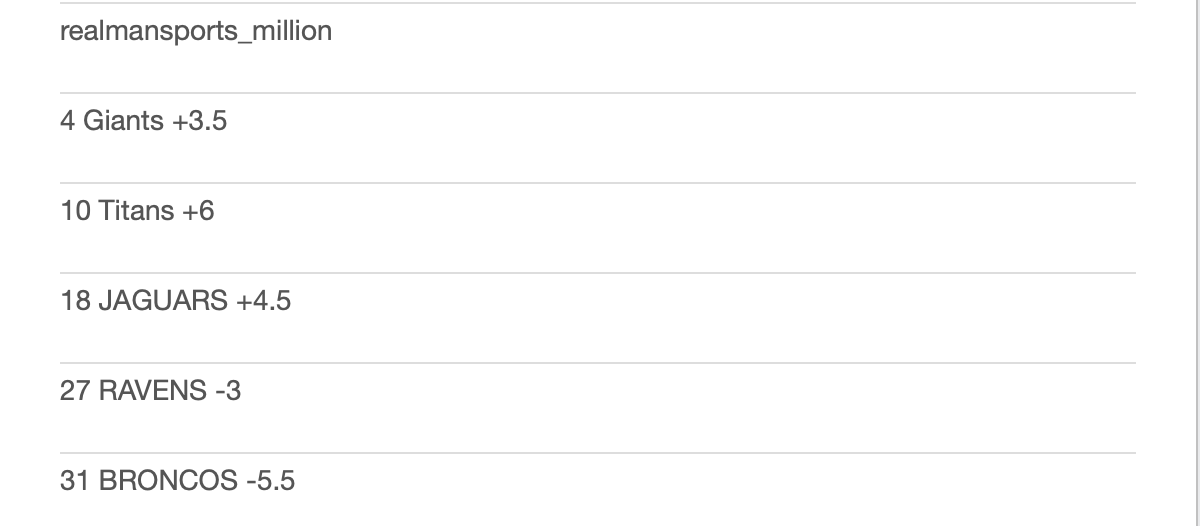
Giants +3.5 at Cowboys — I like selling the Cowboys off last week’s thrilling win, and if Drew Lock starts (it was a lock when I made the pick last night, but now in doubt), that gives them a boost over Tommy DeVito.
Titans +6 at Killer Redskins — This was just a vibe pick. The Titans have shown some life of late, and the KRs are reeling a little bit.
Jaguars +4.5 vs Texans — If Trevor Lawrence is back, I have a feeling this game will be competitive. The Texans offensive line is terrible.
Ravens -3 vs Eagles — The Ravens rise to the occasion against good teams, and the Eagles have beat up on some mediocre ones.
Broncos -5.5 vs Browns — The Broncos have a good defense, capable of forcing Jameis Winston into some mistakes. Plus I like selling the Browns high off their big win against the Steelers.
-
 @ fa1d8325:7c91882e
2024-11-28 22:10:05
@ fa1d8325:7c91882e
2024-11-28 22:10:05В Пятигорске ведется работа над созданием уникальной системы мониторинга качества воздуха, основанной на нейросетевых технологиях. Эта система объединит все существующие системы экологического наблюдения в одну региональную сеть, что позволит значительно повысить эффективность отслеживания уровня загрязнения и своевременно принимать меры.
Нейросети будут анализировать данные о состоянии атмосферы, что позволит делать более точные прогнозы и улучшать качество жизни горожан. Система соответствует целям Генерального плана города по обеспечению экологической безопасности и устойчивого развития.
Внедрение нейросетей в системы мониторинга воздуха открывает множество преимуществ. Они обеспечивают высокую точность данных, обрабатывая огромные массивы информации и выявляя сложные закономерности. Кроме того, нейросети могут прогнозировать уровни загрязнения в реальном времени, что позволяет оперативно реагировать на экологические угрозы.
Автоматизация сбора и анализа данных снизит трудозатраты и повысит эффективность мониторинга. Интеграция данных с другими системами и датчиками улучшит обмен информацией и повысит осведомленность о состоянии окружающей среды.
Ожидается, что новая система мониторинга станет важным шагом в обеспечении экологической безопасности и устойчивого развития Пятигорска.
-
 @ e1d968f7:5d90f764
2024-11-28 09:19:45
@ e1d968f7:5d90f764
2024-11-28 09:19:45Escort work isn’t just about a single encounter—it’s about building a connection that leaves an impression. Some clients become regulars, returning time and again, and there’s more to it than just physical attraction. Today, I’m exploring why clients come back and how those relationships develop over time.
The Allure of Consistency
For many clients, the comfort of familiarity is a big reason they return. In a world filled with uncertainties, knowing exactly what to expect—a friendly smile, a warm welcome, and a shared history—can be deeply reassuring.
Regular clients often mention how much they value not having to explain themselves or their preferences. The connection we’ve built means I understand their likes, dislikes, and boundaries, creating a tailored experience they trust and enjoy.
Beyond the Physical
While physical chemistry plays a role, it’s often the emotional connection that keeps clients coming back. They return for:
- Companionship: Many clients lead busy or lonely lives, and the time we spend together offers them a break from their routines.
- Understanding: I provide a space where they feel heard and valued without judgement.
- Escape: For some, our time together is a chance to step away from the pressures of daily life and simply relax in the moment.
Trust and Respect
Trust is the foundation of any lasting relationship, and that includes professional ones. Clients return when they know they can count on discretion, professionalism, and respect.
Respect goes both ways. I value my regular clients for their loyalty, kindness, and the effort they put into making our interactions enjoyable for both of us. This mutual respect strengthens the bond and enhances every experience.
The Little Details
Clients appreciate the small gestures that show I care and remember them. Whether it’s recalling a favourite drink, asking about a recent trip, or wearing something I know they like, these little details make all the difference. It’s a reminder that they’re not just another booking—they’re someone whose preferences and presence I genuinely value.
The Professional Touch
A significant part of why clients return is the level of professionalism I maintain. From punctuality to creating a comfortable atmosphere, I ensure every session runs smoothly. This reliability fosters trust and leaves a positive impression.
The Perks of Regular Clients
Building a rapport with regular clients is beneficial for me, too. It’s easier to relax and enjoy the experience when there’s familiarity and mutual understanding. It also allows for more meaningful connections, which can make the job even more fulfilling.
The Takeaway
Clients return for more than just the physical aspect—they return for connection, trust, and the sense of being valued. By investing in these relationships, I create experiences that leave a lasting impression, fostering bonds that go beyond a single encounter.
Tomorrow, I’ll discuss how I balance my professional and personal life, ensuring both thrive in harmony. Until then, remember: meaningful connections are built on trust, respect, and the little things that make us feel seen.
Rebecca x
-
 @ 1f79058c:eb86e1cb
2024-10-28 13:31:15
@ 1f79058c:eb86e1cb
2024-10-28 13:31:15This week, it finally happened: I still had a Lightning channel open with a node that hadn't been online for the better part of a year now, so I decided to close the channel unilaterally. But force-closing a channel means you have to broadcast the latest commitment transaction, the pre-set fee of which was only ~1 sat/vB for this one.
With LND, if the channel is created as an anchor channel (by default only since version 0.12), then the commitment transaction contains small extra outputs (currently 330 sats), which let either channel partner spend one of them into a child transaction that can be created with higher fees to pay for the parent transaction (CPFP). LND even has a built-in command for that:
lncli wallet bumpclosefeeHowever, this channel was created in the old-school way, and was thus stuck with its low fee. In fact, even the local bitcoin node refused to accept the transaction into its own mempool, so the bitcoin p2p network didn't even know it existed. So how do we get out of this pickle?
The solution
Enter the mempool.space Accelerator. It is essentially an automated way to create agreements with various mining pools to mine your low-fee transaction in exchange for an out-of-band payment. Mempool.space coordinates these agreements and out-of-band payments with miners and gets a share from the overall fee for that.
Now, if you're in the same situation as I was, you might search for the ID of your closing transaction and find that mempool.space cannot find it. Remember how the local bitcoin node (with mostly default settings) didn't accept it in the first place?
1. Get the transaction to be broadcast
In your
bitcoin.conf, add the following line:minrelaytxfee=0This sets the minimum fee to 0, meaning it will accept and broadcast your transactions, no matter how low the fee is. Restart
bitcoindand wait a little bit. LND will retry broadcasting the closing transaction every minute or so until it succeeds. At some point you should be able to find it on mempool.space.2. Use the Accelerator to confirm it
Once you can see the transaction on mempool.space, you can just click the "Accelerate" button next to the ETA. This will bring you to a page that shows you the estimated share of miners that will include your transaction in their blocks, as well as some acceleration fee options for various transaction fee levels, which you can pay for via the Lightning Network, of course.
If you haven't looked into this service before (which I had), then the fees might be a bit of a surprise to you. This thing is not cheap! Bumping my fee from 1 sat/vB to ~9 sats/vB cost a whopping 51,500 sats (31 USD that day). Bumping it higher only seemed to add the difference in the transaction fee itself, so the service seems to have cost a flat 50K sats at the time.
Unfortunately, this channel wasn't particularly large, so the acceleration fee amounted to ~9% of my remaining channel balance. But 91% of something is better than 100% of nothing, so I actually felt pretty good about it.
Next, you will see something like this:
Time to lean back and let the miners work for you. In my case, the ETA was eerily precise. It told me that it would take ~56 minutes to confirm the transaction, and almost exactly an hour later it was mined.
3. Wait
Now that our transaction is confirmed, our channel is not closed immediately, of course. The time lock of the HTLC protects our channel partner from us broadcasting an old channel state in which our balance might be higher than in the latest state.
In my case, it was set to 144 blocks, i.e. ~24 hours. So I checked back the next day, et voilá: channel closed and balance restored. 🥳
-
 @ 4ba8e86d:89d32de4
2024-10-24 14:02:59
@ 4ba8e86d:89d32de4
2024-10-24 14:02:59O Collabora Office é uma suíte de escritório baseada em código aberto que oferece uma alternativa viável e de qualidade ao popular pacote Office da Microsoft. Desenvolvido pela Collabora, uma empresa líder em serviços de consultoria e desenvolvimento de software de código aberto, o Collabora Office oferece uma gama completa de aplicativos de produtividade para a plataforma Android, incluindo processador de texto, planilha, apresentação e muito mais.
Recursos e Funcionalidades.
O Collabora Office oferece uma ampla gama de recursos e funcionalidades para dispositivos Android, comparáveis aos encontrados em outras suítes de escritório populares. Além das funcionalidades básicas, como criação e edição de documentos de texto, planilhas e apresentações, o Collabora Office suporta formatos de arquivo comuns, como o formato OpenDocument (ODF) e o formato do Microsoft Office (OOXML). Isso significa que você pode facilmente compartilhar e colaborar em documentos com usuários de outras suítes de escritório.
Uma característica notável do Collabora Office para Android é a capacidade de edição colaborativa em tempo real. Vários usuários podem trabalhar simultaneamente em um documento, visualizando as alterações em tempo real. Isso torna a colaboração em equipe mais eficiente, permitindo que os membros trabalhem juntos em projetos sem a necessidade de trocar arquivos várias vezes.
O Collabora Office para Android possui uma interface intuitiva e fácil de usar, projetada especificamente para dispositivos móveis. Isso garante uma experiência de usuário fluida e permite que os usuários aproveitem ao máximo os recursos e funcionalidades do aplicativo em seus smartphones ou tablets.
Uma das principais vantagens do Collabora Office para Android é o fato de ser baseado em código aberto. Isso significa que o software é desenvolvido de forma transparente e está disponível para qualquer pessoa utilizar, estudar, modificar e distribuir. A natureza de código aberto do Collabora Office traz vários benefícios, incluindo:
-
Custos reduzidos: O Collabora Office para Android é gratuito para download e uso, eliminando a necessidade de licenças caras. Isso é particularmente atraente para pequenas empresas e usuários domésticos que buscam uma alternativa acessível ao pacote Office tradicional.
-
Personalização e flexibilidade: Como o código-fonte está disponível, desenvolvedores e usuários avançados podem personalizar e adaptar o Collabora Office para Android às suas necessidades específicas. Isso permite criar soluções personalizadas e integrar o software a outros sistemas e fluxos de trabalho existentes.
-
Segurança: Com a comunidade de código aberto constantemente analisando e auditando o software, eventuais vulnerabilidades de segurança são identificadas e corrigidas rapidamente. Além disso, os usuários podem ter maior confiança na privacidade de seus dados, uma vez que podem verificar como o software lida com as informações.
O Collabora Office para Android é uma alternativa sólida e de código aberto ao pacote Office da Microsoft. Com recursos abrangentes, capacidade de edição colaborativa em tempo real e uma interface otimizada para dispositivos móveis, ele se tornou uma escolha popular entre empresas e usuários individuais que desejam uma solução de produtividade acessível e personalizável para seus dispositivos Android. Além disso, a natureza de código aberto do Collabora Office traz vantagens significativas, como custos reduzidos, flexibilidade e segurança aprimorada. Se você está em busca de uma alternativa confiável e gratuita ao pacote Office tradicional para Android, vale a pena considerar o Collabora Office como uma opção viável.
https://www.collaboraoffice.com/
https://github.com/CollaboraOnline/online
-
-
 @ 3369d0a7:eb020757
2024-11-28 07:41:32
@ 3369d0a7:eb020757
2024-11-28 07:41:32Chef's notes
This recipe was a staple at every thanksgiving with family and now I share it with you nostr family. Absolutely one of my favorite side dish during the holiday. The corn pudding in the photo is NOT baked, I will update it. I hate stock photos.
Details
- ⏲️ Prep time: 15-20 min
- 🍳 Cook time: 30-40 min
- 🍽️ Servings: 6-8
Ingredients
- 2 cans of creamed corn
- 2c Milk
- 1 Box of Jiffy Cornbread Mix
- 3 eggs
- 1/4-1/3c sugar
- 1/2- green bell pepper or pepper onion blend
- 1/4TBsp vanilla
- 1/2tsp Salt
- 2TBsp Butter
Directions
- Grab medium saucepan and desired baking dish at least 9x9
- Place saucepan on medium-high heat
- Add butter and sauté pepper onion blend until tender
- Combine milk, eggs, sugar and vanilla, mix well
- Lather warmed (NOT HOT) baking dish with butter
- Sprinkle half a box of Jiffy corn bread mix in the baking dish
- Add both cans of creamed corn to peppers and onions
- Pour wet ingredients into slightly cooled creamed corn mixture
- Sprinkle the other half box of jiffy mix into the baking dish
- Incorporate the wet and dry ingredients in dish so there are no dry lumps
- Let set for 10 min before placing in a 325 degree oven for 30-40 minutes, until the center is solid and the edges are golden brown.
-
 @ 7c765d40:bd121d84
2024-11-28 22:09:31
@ 7c765d40:bd121d84
2024-11-28 22:09:31We are in the midst (or middle for the non-fancy folks out there) of the BIGGEST transition in human history.
The crazy part?
Most people have no idea.
I mean, they have probably heard this at their latest webex or conference that they were paid to attend.
But they don't truly understand the magnitude of this shift.
The world will look completely different in a decade or two from now.
Unrecognizable.
And I believe, for the much better.
Think about how much has changed in the last 20 years.
2004.
What did it look like?
From my experience, cell phones were few and far between.
I remember my grandpa, who was an auctioneer, had a phone in his truck.
It looked like a normal home phone but used a HUGE antenna on top of the truck to pick up signal.
I don't even know what it was called but it was pretty bad ass at the time.
Then phones became mobile.
T9. The snake game. Ten cents per text.
Wow that was a fun trip down memory lane.
Back to the point.
How will the world look in 20 years from now?
It's almost impossible for someone like me to predict that.
There will be many things that nobody saw coming.
But we can break it down to the skills, traits, and trends based on both people and businesses.
And if my calculations are correct, they will be intertwined by then.
The people who will make a dent: self-belief, good communicators, strong personal networks, low time preference, highly skilled, multiple sources of income, holding hard assets, and crazy.
The people who will suffer: lazy, stubborn, slow, fat, single source of income, high time preference, holding paper assets, and crazy.
Moral of the story? Everyone is crazy.
Let's talk about businesses.
I believe in 20 years, everyone will be their own business.
Or at least, the 80/20 rule will shift.
Traditional system, about 20% have their own business while 80% are employees.
That will flip.
So what type of businesses will succeed?
Decentralized, agile, high quality products, focus on health, open source, and traditional values.
They will hire the best person for the job.
And the businesses that will fail?
Centralized, rigid, low quality products, monopolies, government funded, closed source, and a woke mentality.
I used my assistant Claude to help confirm some of these theories.
He did a great job of organizing some of these and also ended with an appropriate summary.
Success will come to those who can rapidly learn, unlearn, and relearn.
While maintaining a dynamic and growth oriented mindset.
Notice he didn't say anything about diversity, equality, and inclusion.
We are back baby.
We are fuckin back!
PROJECT POTENTIAL - You can now find the expanded audio versions of these on the new podcast - Project Potential! I will be sharing the video versions here for the LITF members but you can also find it for free on Spotify and of course Fountain!
Here is the link to Episode 002 on Fountain: https://fountain.fm/episode/AHGwJ66NcgYZ7V2YFvAu
Have a great day everyone! Happy Thanksgiving to all our American brothers and sisters.
Jor
-
 @ fa1d8325:7c91882e
2024-11-28 22:09:22
@ fa1d8325:7c91882e
2024-11-28 22:09:22В городе-курорте Пятигорске начала действовать система автоматического распознавания лиц. Это передовое техническое решение направлено на повышение уровня безопасности в общественных местах и снижение преступности.
Новая технология позволяет быстро выявлять потенциальных нарушителей и оперативно реагировать на угрозы. Она эффективно контролирует порядок на улицах, в парках и общественном транспорте, предотвращая правонарушения.
Власти города убеждены, что внедрение системы распознавания лиц сделает Пятигорск более безопасным и комфортным для жизни. Горожане смогут чувствовать себя увереннее, зная, что их безопасность находится под надёжной защитой.
Следует отметить, что система распознавания лиц не нарушает права граждан на неприкосновенность частной жизни, поскольку она функционирует в соответствии с законодательством о защите персональных данных.
-
 @ e373ca41:b82abcc5
2024-11-28 07:40:02
@ e373ca41:b82abcc5
2024-11-28 07:40:02Article by Milosz Matuschek, originally from "Freischwebende Intelligenz"
‘The secret of freedom is courage,’ said the Greek historian Thucydides.
A particular example of this can be found in the film ‘The Dark Knight rises’ from Christopher Nolan's Batman series. Captured mercenaries are locked in a deep pit. A cruel prison where you can see the blue sky every day, but never get any closer to the sun. Even more cruel is the fact that it is possible to get out of the shaft by climbing the stairs in the side walls, but only a few dare to do so. At one point, the stairs break off and you have to be prepared to jump over the chasm, to take the ‘death leap’.
The old media system is dead
Anyone who speaks out publicly in more repressive times knows the feeling: Do I dare to come out with what I believe to be the truth, do I risk my (social) life for it? Do I dare to take the death leap into the unknown? More than half of Germans no longer dare to speak their mind in public. The mainstream has become a closed consent cult. Constricted spaces, absurd times.
In our current media setting, we are all prisoners of tech giants, whether readers or journalists. And they, in turn, are prisoners of governments. The Twitter files showed that social media companies were put under massive censorship pressure by government agencies in the USA and easily gave in to it. This also applied to Facebook. Google censored and deleted millions of videos on YouTube. Twitter/X is under fire in Brazil and Pavel Durov from Telegram was arrested and put under pressure in France.
Anyone who creates content in the current media environment, be it as a YouTuber, podcaster, blogger or freelance journalist, is a mercenary trapped in the shaft of the tech giants. The path to freedom seems open, follower numbers may be growing and so are advertising revenues. But it’s a trap. There is no way out of the shaft at the top. The shaft is covered by a heavy pane of glass, which is also hot. Critical channels grow in this setting until they become too big, too delicate and too dangerous and then burst like balloons on the hot glass ceiling.
Publishing in times of increasing censorship pressure in the opinion silos of tech giants is a farce. Nothing belongs to you here: Not your channel, not your followers, not even your own identity. The content creator is a tolerated onlooker. The ‘gig economy’ currently offers a fake rise to billionaire status, a feudal system with false independence where you can be fired at any time. And what happens if you are deleted or blocked? Often, supposedly due to a lack of alternatives, a second or third channel is set up, which eventually suffers the same fate.
Isn't it the definition of madness to always do the same thing and expect a different result? To paraphrase Camus: you have to imagine the modern, critical content creator Sisyphus as a happy madman. When are we going to stop?
**Time to take back control **
Why should we entrust the fruits of our critical labour to others when we could create a network that belongs to ourselves? The tools are there. The time of the old, hierarchical platform economy is over. The future belongs to decentralized networks that put control back into the hands of each individual. Decentralized systems have always been superior to centralized systems. This epochal change has long since reached the monetary system with Bitcoin (and is putting it under pressure). The same is now about to happen in the area of free speech. Free money and free information belong together and in the hands of the citizen.
The old media system is heading for an exodus of readers and Terence McKenna recognised this almost 30 years ago.
Old media is communication from the few to the many. The internet offers communication from many to many. The latter is far more powerful. Old media instruct the reader from the position of the media ivory tower. In the new media age, it is possible to organise the search for truth in a cooperative and collaborative manner; the critical public can participate in the search for truth as a swarm intelligence. This is how we develop the fabric of reality ourselves.
This is how we take back control
I have been working on this new way of publishing with some very tech-savvy and enthusiastic people for a good year now. We are (currently) calling it the Pareto Project. The aim is to give everyone the opportunity to publish critically from anywhere in the world. And this while maintaining the highest degree of independence and freedom.
In the Pareto system, the following will be possible:
- Anyone can create an identity that belongs only to them, secured by the most secure cryptographic process currently available (asymmetric cryptography, i.e. public and private key, similar to a Bitcoin wallet).
- The content (text, video, podcast, etc.) is highly resistant to censorship, we host and publish via a large number of different nodes (relays) that are operated privately. We use the nodes of others, but also operate our own nodes. If nodes or clients are blocked, new ones can easily be created. Every journalist, reader, interested party, etc. can operate their own nodes without much technical knowledge and thus additionally secure themselves (and the network).
- Channels, IDs or content cannot be confiscated.Nobody has access to your account except you.
- Every channel can now scale to infinity. No more hot glass ceiling.
- Easy onboarding with our support: If you want, you can keep your current channel and build a second pillar via our publication network, a kind of uncensorable ‘back-up channel’.
- We are building on Nostr's decentralised protocol.The network was designed by a former Bitcoin developer and is backed by former Twitter founder Jack Dorsey (who has no control over it).
- Both Nostr and our solution are open source. Anyone can develop this system further, build a completely new one or add building blocks to the current system.
- In our solution, payments via Lightning/Bitcoin will be integrated, be it as a one-time donation or as a subscription. Each ID can connect to an uncensorable Bitcoin/Lightning wallet. It will also be possible to continue using all other payment methods.
- As a reader, you decide which content is displayed to you, you can use your own algorithms or do without them altogether. From the reader's point of view, it is possible to put together your own daily information programme from the selected content/sources, your own individualised ‘virtual newspaper’.
- We are also working on integrating researchers, proofreaders etc. into the programme. It should be as uncomplicated as possible to create content based on the preliminary work of others, to exchange ideas, to improve the content or adapt it to the latest developments, to build up your own reputation in the network, but also to reward those involved by donations and subscriptions.
Where do we stand and what do we need?
- We are currently working with a team of developers (all of whom are readers of this publication!) on a prototype/MVP for a publication client on Nostr, which we want to finalise by the end of the year.
- Our first product will be a blog format with an integrated newsletter, its own editor and donation/subscription options. Text, podcast, video, everything should be possible.
- It's not too difficult to migrate existing content and create an uncensorable archive of your own work. I am already uncensorable. If Substack is forced to delete channels tomorrow, I can continue publishing undisturbed.
Call
- Are you a critical journalist, content creator or even your own publication? Come on board as a tester and contribute your own ideas. We are building Pareto cooperatively.
- Are you a developer and want to work on technical problems and solutions? We are always on the lookout for bright minds with the right mindset. We require a love of the free word. In particular, we are looking for further developers in the area of frontend (JavaScript) and/or full stack.
-
Would you like to support us financially? Your donation will go directly towards the development of the first product, which we will launch in the new year (planned for January). Then we can get started, with further development steps following approximately every three months. We are also open to investors.
Kontakt@idw-europe.org
In the ‘Dark Knight rises’, the only way to freedom is by jumping without a rope and double bottom, with the fear of death breathing down your neck.
We now have the opportunity to make the leap before others break our necks.
We are greatful for donations in Bitcoin/Lightning/ZAP me!
*Milosz Matuschek, born 1980 in Poland, is a lawyer and journalist living in Switzerland. He has written for leading mainstream media in the past, has published 8 books and writes the Substack newsletter „Freischwebende Intelligenz“, one of the leading critical newsletters in Europe. ***
-
 @ 8947a945:9bfcf626
2024-10-17 08:06:55
@ 8947a945:9bfcf626
2024-10-17 08:06:55สวัสดีทุกคนบน Nostr ครับ รวมไปถึง watchersและ ผู้ติดตามของผมจาก Deviantart และ platform งานศิลปะอื่นๆนะครับ
ตั้งแต่ต้นปี 2024 ผมใช้ AI เจนรูปงานตัวละครสาวๆจากอนิเมะ และเปิด exclusive content ให้สำหรับผู้ที่ชื่นชอบผลงานของผมเป็นพิเศษ
ผมโพสผลงานผมทั้งหมดไว้ที่เวบ Deviantart และค่อยๆสร้างฐานผู้ติดตามมาเรื่อยๆอย่างค่อยเป็นค่อยไปมาตลอดครับ ทุกอย่างเติบโตไปเรื่อยๆของมัน ส่วนตัวผมมองว่ามันเป็นพิร์ตธุรกิจออนไลน์ ของผมพอร์ตนึงได้เลย
เมื่อวันที่ 16 กย.2024 มีผู้ติดตามคนหนึ่งส่งข้อความส่วนตัวมาหาผม บอกว่าชื่นชอบผลงานของผมมาก ต้องการจะขอซื้อผลงาน แต่ขอซื้อเป็น NFT นะ เสนอราคาซื้อขายต่อชิ้นที่สูงมาก หลังจากนั้นผมกับผู้ซื้อคนนี้พูดคุยกันในเมล์ครับ
นี่คือข้อสรุปสั่นๆจากการต่อรองซื้อขายครับ
(หลังจากนี้ผมขอเรียกผู้ซื้อว่า scammer นะครับ เพราะไพ่มันหงายมาแล้ว ว่าเขาคือมิจฉาชีพ)

- Scammer รายแรก เลือกผลงานที่จะซื้อ เสนอราคาซื้อที่สูงมาก แต่ต้องเป็นเวบไซต์ NFTmarket place ที่เขากำหนดเท่านั้น มันทำงานอยู่บน ERC20 ผมเข้าไปดูเวบไซต์ที่ว่านี้แล้วรู้สึกว่ามันดูแปลกๆครับ คนที่จะลงขายผลงานจะต้องใช้ email ในการสมัครบัญชีซะก่อน ถึงจะผูก wallet อย่างเช่น metamask ได้ เมื่อผูก wallet แล้วไม่สามารถเปลี่ยนได้ด้วย ตอนนั้นผมใช้ wallet ที่ไม่ได้ link กับ HW wallet ไว้ ทดลองสลับ wallet ไปๆมาๆ มันทำไม่ได้ แถมลอง log out แล้ว เลข wallet ก็ยังคาอยู่อันเดิม อันนี้มันดูแปลกๆแล้วหนึ่งอย่าง เวบนี้ค่า ETH ในการ mint 0.15 - 0.2 ETH … ตีเป็นเงินบาทนี่แพงบรรลัยอยู่นะครับ

-
Scammer รายแรกพยายามชักจูงผม หว่านล้อมผมว่า แหม เดี๋ยวเขาก็มารับซื้องานผมน่า mint งานเสร็จ รีบบอกเขานะ เดี๋ยวเขารีบกดซื้อเลย พอขายได้กำไร ผมก็ได้ค่า gas คืนได้ แถมยังได้กำไรอีก ไม่มีอะไรต้องเสีนจริงมั้ย แต่มันเป้นความโชคดีครับ เพราะตอนนั้นผมไม่เหลือทุนสำรองที่จะมาซื้อ ETH ได้ ผมเลยต่อรองกับเขาตามนี้ครับ :
-
ผมเสนอว่า เอางี้มั้ย ผมส่งผลงานของผมแบบ low resolution ให้ก่อน แลกกับให้เขาช่วยโอน ETH ที่เป็นค่า mint งานมาให้หน่อย พอผมได้ ETH แล้ว ผมจะ upscale งานของผม แล้วเมล์ไปให้ ใจแลกใจกันไปเลย ... เขาไม่เอา
- ผมเสนอให้ไปซื้อที่ร้านค้าออนไลน์ buymeacoffee ของผมมั้ย จ่ายเป็น USD ... เขาไม่เอา
- ผมเสนอให้ซื้อขายผ่าน PPV lightning invoice ที่ผมมีสิทธิ์เข้าถึง เพราะเป็น creator ของ Creatr ... เขาไม่เอา
- ผมยอกเขาว่างั้นก็รอนะ รอเงินเดือนออก เขาบอก ok
สัปดาห์ถัดมา มี scammer คนที่สองติดต่อผมเข้ามา ใช้วิธีการใกล้เคียงกัน แต่ใช้คนละเวบ แถมเสนอราคาซื้อที่สูงกว่าคนแรกมาก เวบที่สองนี้เลวร้ายค่าเวบแรกอีกครับ คือต้องใช้เมล์สมัครบัญชี ไม่สามารถผูก metamask ได้ พอสมัครเสร็จจะได้ wallet เปล่าๆมาหนึ่งอัน ผมต้องโอน ETH เข้าไปใน wallet นั้นก่อน เพื่อเอาไปเป็นค่า mint NFT 0.2 ETH
ผมบอก scammer รายที่สองว่า ต้องรอนะ เพราะตอนนี้กำลังติดต่อซื้อขายอยู่กับผู้ซื้อรายแรกอยู่ ผมกำลังรอเงินเพื่อมาซื้อ ETH เป็นต้นทุนดำเนินงานอยู่ คนคนนี้ขอให้ผมส่งเวบแรกไปให้เขาดูหน่อย หลังจากนั้นไม่นานเขาเตือนผมมาว่าเวบแรกมันคือ scam นะ ไม่สามารถถอนเงินออกมาได้ เขายังส่งรูป cap หน้าจอที่คุยกับผู้เสียหายจากเวบแรกมาให้ดูว่าเจอปัญหาถอนเงินไม่ได้ ไม่พอ เขายังบลัฟ opensea ด้วยว่าลูกค้าขายงานได้ แต่ถอนเงินไม่ได้
Opensea ถอนเงินไม่ได้ ตรงนี้แหละครับคือตัวกระตุกต่อมเอ๊ะของผมดังมาก เพราะ opensea อ่ะ ผู้ใช้ connect wallet เข้ากับ marketplace โดยตรง ซื้อขายกันเกิดขึ้น เงินวิ่งเข้าวิ่งออก wallet ของแต่ละคนโดยตรงเลย opensea เก็บแค่ค่า fee ในการใช้ platform ไม่เก็บเงินลูกค้าไว้ แถมปีนี้ค่า gas fee ก็ถูกกว่า bull run cycle 2020 มาก ตอนนี้ค่า gas fee ประมาณ 0.0001 ETH (แต่มันก็แพงกว่า BTC อยู่ดีอ่ะครับ)
ผมเลยเอาเรื่องนี้ไปปรึกษาพี่บิท แต่แอดมินมาคุยกับผมแทน ทางแอดมินแจ้งว่ายังไม่เคยมีเพื่อนๆมาปรึกษาเรื่องนี้ กรณีที่ผมทักมาถามนี่เป็นรายแรกเลย แต่แอดมินให้ความเห็นไปในทางเดียวกับสมมุติฐานของผมว่าน่าจะ scam ในเวลาเดียวกับผมเอาเรื่องนี้ไปถามในเพจ NFT community คนไทนด้วย ได้รับการ confirm ชัดเจนว่า scam และมีคนไม่น้อยโดนหลอก หลังจากที่ผมรู้ที่มาแล้ว ผมเลยเล่นสงครามปั่นประสาท scammer ทั้งสองคนนี้ครับ เพื่อดูว่าหลอกหลวงมิจฉาชีพจริงมั้ย
โดยวันที่ 30 กย. ผมเลยปั่นประสาน scammer ทั้งสองรายนี้ โดยการ mint ผลงานที่เขาเสนอซื้อนั่นแหละ ขึ้น opensea แล้วส่งข้อความไปบอกว่า
mint ให้แล้วนะ แต่เงินไม่พอจริงๆว่ะโทษที เลย mint ขึ้น opensea แทน พอดีบ้านจน ทำได้แค่นี้ไปถึงแค่ opensea รีบไปซื้อล่ะ มีคนจ้องจะคว้างานผมเยอะอยู่ ผมไม่คิด royalty fee ด้วยนะเฮ้ย เอาไปขายต่อไม่ต้องแบ่งกำไรกับผม
เท่านั้นแหละครับ สงครามจิตวิทยาก็เริ่มขึ้น แต่เขาจนมุม กลืนน้ำลายตัวเอง ช็อตเด็ดคือ
เขา : เนี่ยอุส่ารอ บอกเพื่อนในทีมว่าวันจันทร์ที่ 30 กย. ได้ของแน่ๆ เพื่อนๆในทีมเห็นงานผมแล้วมันสวยจริง เลยใส่เงินเต็มที่ 9.3ETH (+ capture screen ส่งตัวเลขยอดเงินมาให้ดู)ไว้รอโดยเฉพาะเลยนะ ผม : เหรอ ... งั้น ขอดู wallet address ที่มี transaction มาให้ดูหน่อยสิ เขา : 2ETH นี่มัน 5000$ เลยนะ ผม : แล้วไง ขอดู wallet address ที่มีการเอายอดเงิน 9.3ETH มาให้ดูหน่อย ไหนบอกว่าเตรียมเงินไว้มากแล้วนี่ ขอดูหน่อย ว่าใส่ไว้เมื่อไหร่ ... เอามาแค่ adrress นะเว้ย ไม่ต้องทะลึ่งส่ง seed มาให้ เขา : ส่งรูปเดิม 9.3 ETH มาให้ดู ผม : รูป screenshot อ่ะ มันไม่มีความหมายหรอกเว้ย ตัดต่อเอาก็ได้ง่ายจะตาย เอา transaction hash มาดู ไหนว่าเตรียมเงินไว้รอ 9.3ETH แล้วอยากซื้องานผมจนตัวสั่นเลยไม่ใช่เหรอ ถ้าจะส่ง wallet address มาให้ดู หรือจะช่วยส่ง 0.15ETH มาให้ยืม mint งานก่อน แล้วมากดซื้อ 2ETH ไป แล้วผมใช้ 0.15ETH คืนให้ก็ได้ จะซื้อหรือไม่ซื้อเนี่ย เขา : จะเอา address เขาไปทำไม ผม : ตัดจบ รำคาญ ไม่ขายให้ละ เขา : 2ETH = 5000 USD เลยนะ ผม : แล้วไง
ผมเลยเขียนบทความนี้มาเตือนเพื่อนๆพี่ๆทุกคนครับ เผื่อใครกำลังเปิดพอร์ตทำธุรกิจขาย digital art online แล้วจะโชคดี เจอของดีแบบผม
ทำไมผมถึงมั่นใจว่ามันคือการหลอกหลวง แล้วคนโกงจะได้อะไร
อันดับแรกไปพิจารณาดู opensea ครับ เป็นเวบ NFTmarketplace ที่ volume การซื้อขายสูงที่สุด เขาไม่เก็บเงินของคนจะซื้อจะขายกันไว้กับตัวเอง เงินวิ่งเข้าวิ่งออก wallet ผู้ซื้อผู้ขายเลย ส่วนทางเวบเก็บค่าธรรมเนียมเท่านั้น แถมค่าธรรมเนียมก็ถูกกว่าเมื่อปี 2020 เยอะ ดังนั้นการที่จะไปลงขายงานบนเวบ NFT อื่นที่ค่า fee สูงกว่ากันเป็นร้อยเท่า ... จะทำไปทำไม
ผมเชื่อว่า scammer โกงเงินเจ้าของผลงานโดยการเล่นกับความโลภและความอ่อนประสบการณ์ของเจ้าของผลงานครับ เมื่อไหร่ก็ตามที่เจ้าของผลงานโอน ETH เข้าไปใน wallet เวบนั้นเมื่อไหร่ หรือเมื่อไหร่ก็ตามที่จ่ายค่า fee ในการ mint งาน เงินเหล่านั้นสิ่งเข้ากระเป๋า scammer ทันที แล้วก็จะมีการเล่นตุกติกต่อแน่นอนครับ เช่นถอนไม่ได้ หรือซื้อไม่ได้ ต้องโอนเงินมาเพิ่มเพื่อปลดล็อค smart contract อะไรก็ว่าไป แล้วคนนิสัยไม่ดีพวกเนี้ย ก็จะเล่นกับความโลภของคน เอาราคาเสนอซื้อที่สูงโคตรๆมาล่อ ... อันนี้ไม่ว่ากัน เพราะบนโลก NFT รูปภาพบางรูปที่ไม่ได้มีความเป็นศิลปะอะไรเลย มันดันขายกันได้ 100 - 150 ETH ศิลปินที่พยายามสร้างตัวก็อาจจะมองว่า ผลงานเรามีคนรับซื้อ 2 - 4 ETH ต่องานมันก็มากพอแล้ว (จริงๆมากเกินจนน่าตกใจด้วยซ้ำครับ)
บนโลกของ BTC ไม่ต้องเชื่อใจกัน โอนเงินไปหากันได้ ปิดสมุดบัญชีได้โดยไม่ต้องเชื่อใจกัน
บบโลกของ ETH "code is law" smart contract มีเขียนอยู่แล้ว ไปอ่าน มันไม่ได้ยากมากในการทำความเข้าใจ ดังนั้น การจะมาเชื่อคำสัญญาจากคนด้วยกัน เป็นอะไรที่ไม่มีเหตุผล
ผมไปเล่าเรื่องเหล่านี้ให้กับ community งานศิลปะ ก็มีทั้งเสียงตอบรับที่ดี และไม่ดีปนกันไป มีบางคนยืนยันเสียงแข็งไปในทำนองว่า ไอ้เรื่องแบบเนี้ยไม่ได้กินเขาหรอก เพราะเขาตั้งใจแน่วแน่ว่างานศิลป์ของเขา เขาไม่เอาเข้ามายุ่งในโลก digital currency เด็ดขาด ซึ่งผมก็เคารพมุมมองเขาครับ แต่มันจะดีกว่ามั้ย ถ้าเราเปิดหูเปิดตาให้ทันเทคโนโลยี โดยเฉพาะเรื่อง digital currency , blockchain โดนโกงทีนึงนี่คือหมดตัวกันง่ายกว่าเงิน fiat อีก
อยากจะมาเล่าให้ฟังครับ และอยากให้ช่วยแชร์ไปให้คนรู้จักด้วย จะได้ระวังตัวกัน
Note
- ภาพประกอบ cyber security ทั้งสองนี่ของผมเองครับ ทำเอง วางขายบน AdobeStock
- อีกบัญชีนึงของผม "HikariHarmony" npub1exdtszhpw3ep643p9z8pahkw8zw00xa9pesf0u4txyyfqvthwapqwh48sw กำลังค่อยๆเอาผลงานจากโลกข้างนอกเข้ามา nostr ครับ ตั้งใจจะมาสร้างงานศิลปะในนี้ เพื่อนๆที่ชอบงาน จะได้ไม่ต้องออกไปหาที่ไหน
ผลงานของผมครับ - Anime girl fanarts : HikariHarmony - HikariHarmony on Nostr - General art : KeshikiRakuen - KeshikiRakuen อาจจะเป็นบัญชี nostr ที่สามของผม ถ้าไหวครับ
-
 @ e373ca41:b82abcc5
2024-11-28 07:21:51
@ e373ca41:b82abcc5
2024-11-28 07:21:51Article by Milosz Matuschek, first published on "Freischwebende Intelligenz".
When the French historian Alexis de Tocqueville traced the French Revolution, he noted that free publicists and authors had become the leading politicians in the mid-18th century. They alone, penniless, without status, rank, title or formal power, became the only ones who still possessed authority. It is no secret that all power, especially in a democracy, is based on media power and public opinion. Revolutions can begin when intellectual forces regroup. The US elections also mark a turning point. It was primarily the media mainstream, the previous classic kingmaker, that lost out. In recent years, it has increasingly retreated into the trenches of its own ideology, preferring to listen to philanthrocapitalists with crazy ideas for shaping the world, woke social engineers and the studies of a thoroughly corrupted scientific community.
 The "cultural hegemony" is marked in blue, by the way
The "cultural hegemony" is marked in blue, by the way This “cultural hegemony”, which also manifested itself in educational institutions and the cultural sector, has now been pulverized. It was the X/Twitter platform and its new owner Elon Musk, among others, that have undermined mainstream power and created a space for broader and deeper debates alongside the narrow corridor of the media cartel. Musk himself is one of the biggest influencers in the world, no one has more followers on Twitter than him (204.6 million). The mainstream used to be the kingmaker, now it's the richest man in the world and his platform. Is that progress?
Musk is now being rewarded with a leadership role in a new government agency: The Department of Government Efficiency, or D.O.G.E. Doge is also the abbreviation for the largest memecoin, a sweet, virtual dog currency, the Doge Coin, which Musk has mentioned from time to time and had also already brought into play as a currency for Tesla. He has also named rockets after Doge.
Media power, meme culture, political power, all mixed together in a somewhat bizarre, semi-serious way. Everything is as American as ever. Many journalists in this country will now have to google “meme culture” and “DOGE”, preferring to stare at mainstream polls predicting a Harris victory. At the same time, Bitcoin is soaring to new highs. (Hopefully you read my piece on Bitcoin from the summer when I suggested you buy Bitcoin now (As of that time: 58,239 dollars per unit. As of press time today: 91,082 dollars).
It's a nice synchronicity when the uncensorable Bitcoin erupts at the same moment as the mainstream echo chamber implodes. Free money and free information belong in the hands of the citizen. But the citizen must also reach for it, otherwise others will. Companies are now increasingly buying into Bitcoin, with Blackrock recording billions in inflows into the Bitcoin ETF in the last few weeks alone. The next wave will come from the government. El Salvador has already declared Bitcoin the reserve currency. Trump is toying with the idea of creating a Bitcoin stock as an official reserve. Bitcoin was meant to be the asset class, which was out of the reach of governments. What will change, when they’re buying into it big time?
Musk is currently the de facto custodian of freedom of expression in the world, the protector liberae orationis mundi. How openly will he deal with critical information about himself or the Trump administration? Every “savior” has a life cycle. Liberators have often become new oppressors. Whether with free money or free information: in none of these centers of power should individual interests be allowed to dictate the direction. But this also means that freedom can only be realized where it is perceived. If citizens do not use the tools of freedom themselves en masse, others will. Freedom then remains just an option that is not redeemed, but merely delegated to the next savior.
Trump and Musk are just creating a new power conglomerate. Politics and billionaires with the will to shape things, everything as usual. From Soros & Co. to Musk & Co. For the field of free information, this means that as long as citizens are not on completely uncensorable platforms that are not controlled by anyone, they are working in the data silo of Musk & Co. They are active in the gig economy of the public opinion market and can be switched off and dimmed down at any time. Whether identity, content or followers: everything belongs to Musk. The necessary next step on the way to a truly free marketplace of ideas is solutions in which the citizen is the actor and not the product being sold.
Only when decentralized money and decentralized information are gathered in the hands of citizens and form a powerful block against power centers of all kinds, and a spirit of light-filled transformation can unfold, will a new golden age begin.
-- Join the marketplace of ideas! Sound money and sound information should finally be in the hands of the people, right? We are building a publishing ecosystem on Nostr for citizen-journalism, starting with a client for blogging and newsletter distribution. Want to learn more about the Pareto Project? Zap me, if you want to contribute (all Zaps go to the project).
-
 @ 9c47bb51:000381d0
2024-11-28 01:21:15
@ 9c47bb51:000381d0
2024-11-28 01:21:15- Scarcity (vs. Fiat, Gold, and Shitcoins)
Bitcoin is the most provably scarce asset in human history. Its hard cap of 21 million coins is mathematically enforced by code and immutable consensus. Compare this to: • Fiat currencies: Central banks can (and do) print trillions out of thin air, debasing purchasing power. • Gold: While limited, gold’s supply increases steadily due to mining, and potential asteroid mining could disrupt its scarcity in the future. • Shitcoins and Altcoins: Most altcoins have inflationary mechanisms, central control, or the ability to increase their supply. Bitcoin stands alone as immutable.
Bitcoin’s fixed supply, coupled with its growing demand, ensures its value will continue to appreciate over time.
- Decentralization (vs. Other Cryptocurrencies)
Bitcoin is the most decentralized and censorship-resistant cryptocurrency: • Network strength: Bitcoin has the largest and most secure blockchain with tens of thousands of nodes worldwide. • Leadership: Bitcoin has no central leadership, founder (Satoshi Nakamoto is absent), or corporation controlling its direction. This eliminates single points of failure or manipulation. • Altcoins/Shitcoins: Many altcoins are controlled by founders, teams, or pre-mined allocations, leaving them vulnerable to manipulation or regulation. Ethereum’s history of rolling back transactions after the DAO hack proves its centralization.
Decentralization ensures that Bitcoin remains neutral, unstoppable, and incorruptible—qualities no other cryptocurrency can match.
- Portability and Divisibility (vs. Real Estate and Gold)
Bitcoin is infinitely more portable and divisible than traditional assets: • Gold: Physically heavy and expensive to store, transport, or divide into small amounts. • Real Estate: Illiquid, subject to geographic risks, expensive to transfer, and indivisible for fractional ownership. • Bitcoin: Instantly transferable across the globe at minimal cost. You can send $1 or $1 billion worth of Bitcoin with the same efficiency. It’s highly divisible (up to 8 decimal places) for everyday transactions or massive deals.
In a digital and globalized economy, Bitcoin’s portability is unmatched.
- Security and Predictability (vs. Stocks, Real Estate, and Fiat)
Bitcoin offers unprecedented security and predictability: • Stocks: Company stocks are subject to management corruption, market crashes, and insider manipulation. • Real Estate: Governments can seize property, impose taxes, or render assets useless through zoning laws. • Fiat: Subject to inflation and the whims of central banks. • Bitcoin: Backed by the most secure computational network in the world. No central authority can alter its supply or manipulate its value. It operates on a predictable monetary policy (halving every four years).
Bitcoin is financial sovereignty at its purest.
- Superior Store of Value (vs. Gold and Stocks)
Bitcoin is the ultimate store of value: • Gold: Gold’s market cap has stagnated for decades, and it lacks utility in a digital age. Bitcoin is “digital gold” but better—easier to store, transfer, and verify. • Stocks: Stocks depend on company performance, market cycles, and economic conditions. Bitcoin is uncorrelated and independent. • Real Estate: Real estate is tied to interest rates, location, and demographic trends. Bitcoin transcends these limitations as a global, borderless asset.
Bitcoin’s deflationary design ensures that it appreciates in value as demand grows.
- Censorship Resistance (vs. Stocks, Real Estate, and Fiat)
Bitcoin is uncensorable and permissionless: • Stocks and Banks: Financial accounts can be frozen, censored, or blocked at the government’s discretion. • Real Estate: Governments can confiscate property or impose capital controls. • Fiat: Subject to freezing, devaluation, and arbitrary confiscation. • Bitcoin: As long as you control your private keys, no government, corporation, or institution can touch your wealth. Bitcoin empowers individuals with true ownership.
Bitcoin ensures freedom in an increasingly authoritarian world.
- Ubiquitous Access and Adoption
Bitcoin is borderless and universal: • Billions of unbanked individuals can now access financial systems through Bitcoin with nothing more than a smartphone. • Bitcoin is accepted and recognized globally, transcending national borders and economic systems.
Bitcoin is the internet of money, connecting the world in ways that no asset—be it gold, fiat, real estate, or stocks—ever could.
- Time Preference and Future-Proofing
Bitcoin promotes low time preference and financial discipline: • It incentivizes saving over reckless spending by appreciating over time. • It’s immune to technological obsolescence, as its protocol is constantly upgraded without losing its core principles.
Unlike altcoins or fiat-based investments, Bitcoin isn’t chasing trends—it is the MF trend (Samuel L Jackson voice).
Conclusion: The Supreme Asset
Bitcoin stands unmatched as the most secure, scarce, decentralized, portable, censorship-resistant, and universally recognized store of value. It outshines: • Fiat: By being immune to inflation. • Gold: By being digital and portable. • Real Estate: By being liquid, divisible, and borderless. • Stocks and Altcoins: By being incorruptible and decentralized.
Bitcoin is not just an investment—it’s a revolution. It’s the foundation of financial sovereignty and freedom for the 21st century. If you’re not holding Bitcoin, you’re holding obsolescence.
-
 @ 8947a945:9bfcf626
2024-10-17 07:33:00
@ 8947a945:9bfcf626
2024-10-17 07:33:00Hello everyone on Nostr and all my watchersand followersfrom DeviantArt, as well as those from other art platforms
I have been creating and sharing AI-generated anime girl fanart since the beginning of 2024 and have been running member-exclusive content on Patreon.
I also publish showcases of my artworks to Deviantart. I organically build up my audience from time to time. I consider it as one of my online businesses of art. Everything is slowly growing
On September 16, I received a DM from someone expressing interest in purchasing my art in NFT format and offering a very high price for each piece. We later continued the conversation via email.
Here’s a brief overview of what happened

- The first scammer selected the art they wanted to buy and offered a high price for each piece. They provided a URL to an NFT marketplace site running on the Ethereum (ETH) mainnet or ERC20. The site appeared suspicious, requiring email sign-up and linking a MetaMask wallet. However, I couldn't change the wallet address later. The minting gas fees were quite expensive, ranging from 0.15 to 0.2 ETH

-
The scammers tried to convince me that the high profits would easily cover the minting gas fees, so I had nothing to lose. Luckily, I didn’t have spare funds to purchase ETH for the gas fees at the time, so I tried negotiating with them as follows:
-
I offered to send them a lower-quality version of my art via email in exchange for the minting gas fees, but they refused.
- I offered them the option to pay in USD through Buy Me a Coffee shop here, but they refused.
- I offered them the option to pay via Bitcoin using the Lightning Network invoice , but they refused.
- I asked them to wait until I could secure the funds, and they agreed to wait.
The following week, a second scammer approached me with a similar offer, this time at an even higher price and through a different NFT marketplace website.
This second site also required email registration, and after navigating to the dashboard, it asked for a minting fee of 0.2 ETH. However, the site provided a wallet address for me instead of connecting a MetaMask wallet.
I told the second scammer that I was waiting to make a profit from the first sale, and they asked me to show them the first marketplace. They then warned me that the first site was a scam and even sent screenshots of victims, including one from OpenSea saying that Opensea is not paying.
This raised a red flag, and I began suspecting I might be getting scammed. On OpenSea, funds go directly to users' wallets after transactions, and OpenSea charges a much lower platform fee compared to the previous crypto bull run in 2020. Minting fees on OpenSea are also significantly cheaper, around 0.0001 ETH per transaction.
I also consulted with Thai NFT artist communities and the ex-chairman of the Thai Digital Asset Association. According to them, no one had reported similar issues, but they agreed it seemed like a scam.
After confirming my suspicions with my own research and consulting with the Thai crypto community, I decided to test the scammers’ intentions by doing the following
I minted the artwork they were interested in, set the price they offered, and listed it for sale on OpenSea. I then messaged them, letting them know the art was available and ready to purchase, with no royalty fees if they wanted to resell it.
They became upset and angry, insisting I mint the art on their chosen platform, claiming they had already funded their wallet to support me. When I asked for proof of their wallet address and transactions, they couldn't provide any evidence that they had enough funds.
Here’s what I want to warn all artists in the DeviantArt community or other platforms If you find yourself in a similar situation, be aware that scammers may be targeting you.
My Perspective why I Believe This is a Scam and What the Scammers Gain
From my experience with BTC and crypto since 2017, here's why I believe this situation is a scam, and what the scammers aim to achieve
First, looking at OpenSea, the largest NFT marketplace on the ERC20 network, they do not hold users' funds. Instead, funds from transactions go directly to users’ wallets. OpenSea’s platform fees are also much lower now compared to the crypto bull run in 2020. This alone raises suspicion about the legitimacy of other marketplaces requiring significantly higher fees.
I believe the scammers' tactic is to lure artists into paying these exorbitant minting fees, which go directly into the scammers' wallets. They convince the artists by promising to purchase the art at a higher price, making it seem like there's no risk involved. In reality, the artist has already lost by paying the minting fee, and no purchase is ever made.
In the world of Bitcoin (BTC), the principle is "Trust no one" and “Trustless finality of transactions” In other words, transactions are secure and final without needing trust in a third party.
In the world of Ethereum (ETH), the philosophy is "Code is law" where everything is governed by smart contracts deployed on the blockchain. These contracts are transparent, and even basic code can be read and understood. Promises made by people don’t override what the code says.
I also discuss this issue with art communities. Some people have strongly expressed to me that they want nothing to do with crypto as part of their art process. I completely respect that stance.
However, I believe it's wise to keep your eyes open, have some skin in the game, and not fall into scammers’ traps. Understanding the basics of crypto and NFTs can help protect you from these kinds of schemes.
If you found this article helpful, please share it with your fellow artists.
Until next time Take care
Note
- Both cyber security images are mine , I created and approved by AdobeStock to put on sale
- I'm working very hard to bring all my digital arts into Nostr to build my Sats business here to my another npub "HikariHarmony" npub1exdtszhpw3ep643p9z8pahkw8zw00xa9pesf0u4txyyfqvthwapqwh48sw
Link to my full gallery - Anime girl fanarts : HikariHarmony - HikariHarmony on Nostr - General art : KeshikiRakuen
-
 @ e6817453:b0ac3c39
2024-10-06 11:21:27
@ e6817453:b0ac3c39
2024-10-06 11:21:27Hey folks, today we're diving into an exciting and emerging topic: personal artificial intelligence (PAI) and its connection to sovereignty, privacy, and ethics. With the rapid advancements in AI, there's a growing interest in the development of personal AI agents that can work on behalf of the user, acting autonomously and providing tailored services. However, as with any new technology, there are several critical factors that shape the future of PAI. Today, we'll explore three key pillars: privacy and ownership, explainability, and bias.
1. Privacy and Ownership: Foundations of Personal AI
At the heart of personal AI, much like self-sovereign identity (SSI), is the concept of ownership. For personal AI to be truly effective and valuable, users must own not only their data but also the computational power that drives these systems. This autonomy is essential for creating systems that respect the user's privacy and operate independently of large corporations.
In this context, privacy is more than just a feature—it's a fundamental right. Users should feel safe discussing sensitive topics with their AI, knowing that their data won’t be repurposed or misused by big tech companies. This level of control and data ownership ensures that users remain the sole beneficiaries of their information and computational resources, making privacy one of the core pillars of PAI.
2. Bias and Fairness: The Ethical Dilemma of LLMs
Most of today’s AI systems, including personal AI, rely heavily on large language models (LLMs). These models are trained on vast datasets that represent snapshots of the internet, but this introduces a critical ethical challenge: bias. The datasets used for training LLMs can be full of biases, misinformation, and viewpoints that may not align with a user’s personal values.
This leads to one of the major issues in AI ethics for personal AI—how do we ensure fairness and minimize bias in these systems? The training data that LLMs use can introduce perspectives that are not only unrepresentative but potentially harmful or unfair. As users of personal AI, we need systems that are free from such biases and can be tailored to our individual needs and ethical frameworks.
Unfortunately, training models that are truly unbiased and fair requires vast computational resources and significant investment. While large tech companies have the financial means to develop and train these models, individual users or smaller organizations typically do not. This limitation means that users often have to rely on pre-trained models, which may not fully align with their personal ethics or preferences. While fine-tuning models with personalized datasets can help, it's not a perfect solution, and bias remains a significant challenge.
3. Explainability: The Need for Transparency
One of the most frustrating aspects of modern AI is the lack of explainability. Many LLMs operate as "black boxes," meaning that while they provide answers or make decisions, it's often unclear how they arrived at those conclusions. For personal AI to be effective and trustworthy, it must be transparent. Users need to understand how the AI processes information, what data it relies on, and the reasoning behind its conclusions.
Explainability becomes even more critical when AI is used for complex decision-making, especially in areas that impact other people. If an AI is making recommendations, judgments, or decisions, it’s crucial for users to be able to trace the reasoning process behind those actions. Without this transparency, users may end up relying on AI systems that provide flawed or biased outcomes, potentially causing harm.
This lack of transparency is a major hurdle for personal AI development. Current LLMs, as mentioned earlier, are often opaque, making it difficult for users to trust their outputs fully. The explainability of AI systems will need to be improved significantly to ensure that personal AI can be trusted for important tasks.
Addressing the Ethical Landscape of Personal AI
As personal AI systems evolve, they will increasingly shape the ethical landscape of AI. We’ve already touched on the three core pillars—privacy and ownership, bias and fairness, and explainability. But there's more to consider, especially when looking at the broader implications of personal AI development.
Most current AI models, particularly those from big tech companies like Facebook, Google, or OpenAI, are closed systems. This means they are aligned with the goals and ethical frameworks of those companies, which may not always serve the best interests of individual users. Open models, such as Meta's LLaMA, offer more flexibility and control, allowing users to customize and refine the AI to better meet their personal needs. However, the challenge remains in training these models without significant financial and technical resources.
There’s also the temptation to use uncensored models that aren’t aligned with the values of large corporations, as they provide more freedom and flexibility. But in reality, models that are entirely unfiltered may introduce harmful or unethical content. It’s often better to work with aligned models that have had some of the more problematic biases removed, even if this limits some aspects of the system’s freedom.
The future of personal AI will undoubtedly involve a deeper exploration of these ethical questions. As AI becomes more integrated into our daily lives, the need for privacy, fairness, and transparency will only grow. And while we may not yet be able to train personal AI models from scratch, we can continue to shape and refine these systems through curated datasets and ongoing development.
Conclusion
In conclusion, personal AI represents an exciting new frontier, but one that must be navigated with care. Privacy, ownership, bias, and explainability are all essential pillars that will define the future of these systems. As we continue to develop personal AI, we must remain vigilant about the ethical challenges they pose, ensuring that they serve the best interests of users while remaining transparent, fair, and aligned with individual values.
If you have any thoughts or questions on this topic, feel free to reach out—I’d love to continue the conversation!
-
 @ ec9bd746:df11a9d0
2024-10-04 09:46:22
@ ec9bd746:df11a9d0
2024-10-04 09:46:22It's intriguing to me how beer prices have changed since 1999. Today, you can buy Braník on sale for 9.90 Kč, so for 100 Kč you get 10 beers. 25 years ago, you'd get 13.5 beers for the same amount. What does that tell us?
-
The cost of labor and services has gone up a lot, but people are willing to pay and even expect a certain level of quality. There are way fewer run-down pubs than before.
-
Production has become much more efficient, so considering inflation and purchasing power, bottled beer is actually cheaper now than it used to be.
In 1995, about 30 years ago, bottled and draft beer cost almost the same—around 7 Kč. (Source in Czech)
So what's the takeaway?
-
A wealthy society can afford much pricier services.
-
Prices of basic groceries and fast-moving goods are squeezed to the bone. The best way to gauge real inflation is at the supermarket, where there's no room for messing with margins, stock levels, seasonality, etc. Everything moves fast, competition is huge, and big retailers are relentless.
Real estate is pricey due to artificial (or bureaucracy-induced) shortages, but meat, milk, beer, bread, etc., are operating on razor-thin profits. That's why they react so quickly—see point 2.
-
-
 @ fa1d8325:7c91882e
2024-11-28 22:07:02
@ fa1d8325:7c91882e
2024-11-28 22:07:02Сегодня мы погружаемся в удивительный мир ухода за нашими пушистыми друзьями и ветеринарии. Век технологий стремительно меняет нашу жизнь, и это касается не только людей, но и наших домашних животных.
Вы когда-нибудь задумывались, как современные инновации помогают улучшать здоровье и благополучие наших любимцев? От умных кормушек до мобильных приложений для мониторинга состояния здоровья — технологии открывают новые горизонты в уходе за животными.
В этом видео мы расскажем о самых интересных и полезных новшествах в ветеринарии, которые делают жизнь наших питомцев более комфортной и безопасной. Узнайте, как регулярные проверки здоровья и современные методы диагностики помогают выявлять заболевания на ранних стадиях и обеспечивают нашим любимцам долгую и счастливую жизнь.
-
 @ fa1d8325:7c91882e
2024-11-28 22:02:31
@ fa1d8325:7c91882e
2024-11-28 22:02:31Проблема мусора в окрестностях Пятигорска стала настоящим вызовом для местных жителей и властей. Стихийные свалки растут с каждым днём, ежедневно накапливая десятки тонн отходов, среди которых строительные материалы и пластиковые упаковки.
Власти признают, что ежедневный вывоз около 25 тонн мусора не решает проблему в полной мере. Экологические последствия становятся всё более серьёзными: загрязнение водоёмов и ухудшение качества воздуха приводят к росту заболеваемости среди местного населения.
Глава города призывает к более строгим мерам против нарушителей, однако критика в адрес властей остаётся высокой.
Для решения этой проблемы власти планируют реализовать несколько ключевых мер: автоматическую сортировку, пиролиз и циркулярную экономику.
Системы оптического распознавания и искусственного интеллекта будут эффективно разделять отходы на различные категории, ускоряя процесс переработки. Высокотемпературная технология пиролиза позволит перерабатывать полимерные отходы, минимизируя выбросы. Подход циркулярной экономики подразумевает переработку и повторное использование отходов в производстве, что снизит потребление новых ресурсов.
Власти надеются, что эти технологии помогут справиться с растущими объёмами отходов и минимизировать их негативное воздействие на окружающую среду. Однако пока неизвестно, насколько эффективными окажутся эти меры на практике.
-
 @ e6817453:b0ac3c39
2024-09-30 14:52:23
@ e6817453:b0ac3c39
2024-09-30 14:52:23In the modern world of AI, managing vast amounts of data while keeping it relevant and accessible is a significant challenge, mainly when dealing with large language models (LLMs) and vector databases. One approach that has gained prominence in recent years is integrating vector search with metadata, especially in retrieval-augmented generation (RAG) pipelines. Vector search and metadata enable faster and more accurate data retrieval. However, the process of pre- and post-search filtering results plays a crucial role in ensuring data relevance.
The Vector Search and Metadata Challenge
In a typical vector search, you create embeddings from chunks of text, such as a PDF document. These embeddings allow the system to search for similar items and retrieve them based on relevance. The challenge, however, arises when you need to combine vector search results with structured metadata. For example, you may have timestamped text-based content and want to retrieve the most relevant content within a specific date range. This is where metadata becomes critical in refining search results.
Unfortunately, most vector databases treat metadata as a secondary feature, isolating it from the primary vector search process. As a result, handling queries that combine vectors and metadata can become a challenge, particularly when the search needs to account for a dynamic range of filters, such as dates or other structured data.
LibSQL and vector search metadata
LibSQL is a more general-purpose SQLite-based database that adds vector capabilities to regular data. Vectors are presented as blob columns of regular tables. It makes vector embeddings and metadata a first-class citizen that naturally builds deep integration of these data points.
create table if not exists conversation ( id varchar(36) primary key not null, startDate real, endDate real, summary text, vectorSummary F32_BLOB(512) );It solves the challenge of metadata and vector search and eliminates impedance between vector data and regular structured data points in the same storage.
As you can see, you can access vector-like data and start date in the same query.
select c.id ,c.startDate, c.endDate, c.summary, vector_distance_cos(c.vectorSummary, vector(${vector})) distance from conversation where ${startDate ? `and c.startDate >= ${startDate.getTime()}` : ''} ${endDate ? `and c.endDate <= ${endDate.getTime()}` : ''} ${distance ? `and distance <= ${distance}` : ''} order by distance limit ${top};vector_distance_cos calculated as distance allows us to make a primitive vector search that does a full scan and calculates distances on rows. We could optimize it with CTE and limit search and distance calculations to a much smaller subset of data.
This approach could be calculation intensive and fail on large amounts of data.
Libsql offers a way more effective vector search based on FlashDiskANN vector indexed.
vector_top_k('idx_conversation_vectorSummary', ${vector} , ${top}) ivector_top_k is a table function that searches for the top of the newly created vector search index. As you can see, we could use only vector as a function parameter, and other columns could be used outside of the table function. So, to use a vector index together with different columns, we need to apply some strategies.
Now we get a classical problem of integration vector search results with metadata queries.
Post-Filtering: A Common Approach
The most widely adopted method in these pipelines is post-filtering. In this approach, the system first retrieves data based on vector similarities and then applies metadata filters. For example, imagine you’re conducting a vector search to retrieve conversations relevant to a specific question. Still, you also want to ensure these conversations occurred in the past week.

Post-filtering allows the system to retrieve the most relevant vector-based results and subsequently filter out any that don’t meet the metadata criteria, such as date range. This method is efficient when vector similarity is the primary factor driving the search, and metadata is only applied as a secondary filter.
const sqlQuery = ` select c.id ,c.startDate, c.endDate, c.summary, vector_distance_cos(c.vectorSummary, vector(${vector})) distance from vector_top_k('idx_conversation_vectorSummary', ${vector} , ${top}) i inner join conversation c on i.id = c.rowid where ${startDate ? `and c.startDate >= ${startDate.getTime()}` : ''} ${endDate ? `and c.endDate <= ${endDate.getTime()}` : ''} ${distance ? `and distance <= ${distance}` : ''} order by distance limit ${top};However, there are some limitations. For example, the initial vector search may yield fewer results or omit some relevant data before applying the metadata filter. If the search window is narrow enough, this can lead to complete results.
One working strategy is to make the top value in vector_top_K much bigger. Be careful, though, as the function's default max number of results is around 200 rows.
Pre-Filtering: A More Complex Approach
Pre-filtering is a more intricate approach but can be more effective in some instances. In pre-filtering, metadata is used as the primary filter before vector search takes place. This means that only data that meets the metadata criteria is passed into the vector search process, limiting the scope of the search right from the beginning.
While this approach can significantly reduce the amount of irrelevant data in the final results, it comes with its own challenges. For example, pre-filtering requires a deeper understanding of the data structure and may necessitate denormalizing the data or creating separate pre-filtered tables. This can be resource-intensive and, in some cases, impractical for dynamic metadata like date ranges.

In certain use cases, pre-filtering might outperform post-filtering. For instance, when the metadata (e.g., specific date ranges) is the most important filter, pre-filtering ensures the search is conducted only on the most relevant data.
Pre-filtering with distance-based filtering
So, we are getting back to an old concept. We do prefiltering instead of using a vector index.
WITH FilteredDates AS ( SELECT c.id, c.startDate, c.endDate, c.summary, c.vectorSummary FROM YourTable c WHERE ${startDate ? `AND c.startDate >= ${startDate.getTime()}` : ''} ${endDate ? `AND c.endDate <= ${endDate.getTime()}` : ''} ), DistanceCalculation AS ( SELECT fd.id, fd.startDate, fd.endDate, fd.summary, fd.vectorSummary, vector_distance_cos(fd.vectorSummary, vector(${vector})) AS distance FROM FilteredDates fd ) SELECT dc.id, dc.startDate, dc.endDate, dc.summary, dc.distance FROM DistanceCalculation dc WHERE 1=1 ${distance ? `AND dc.distance <= ${distance}` : ''} ORDER BY dc.distance LIMIT ${top};It makes sense if the filter produces small data and distance calculation happens on the smaller data set.
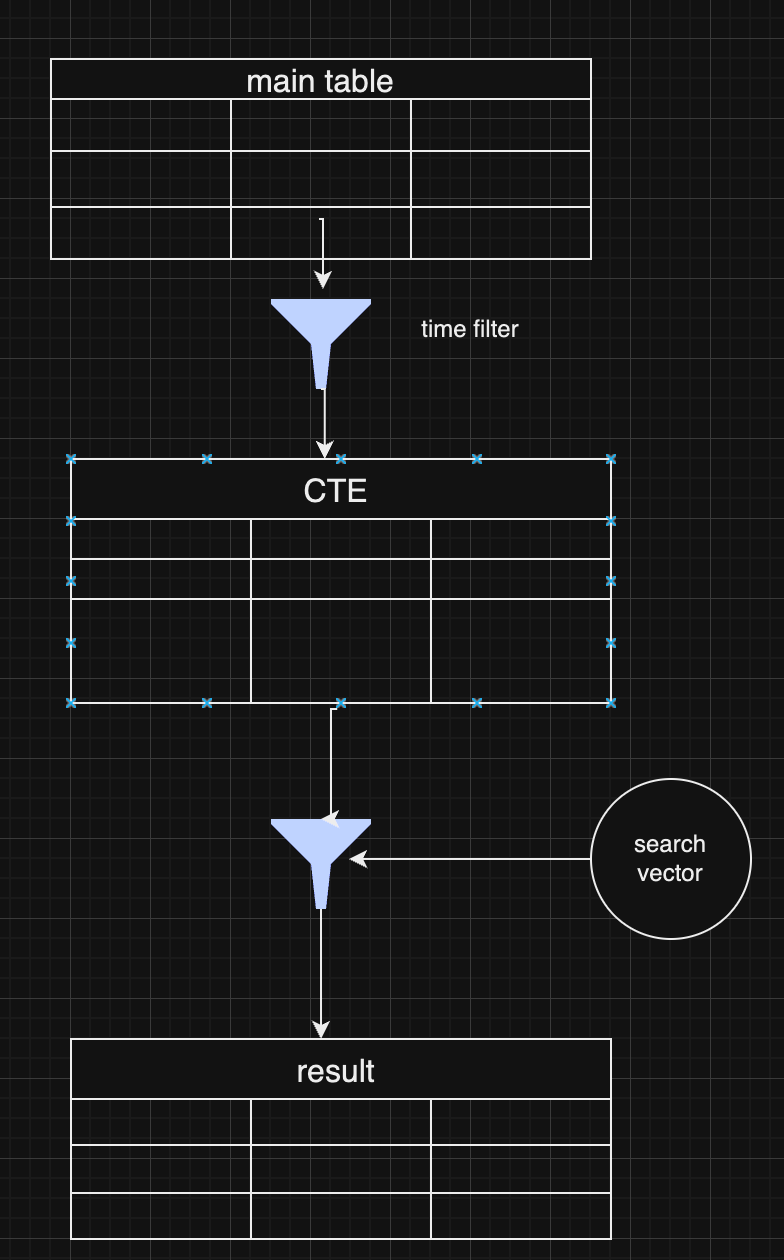
As a pro of this approach, you have full control over the data and get all results without omitting some typical values for extensive index searches.
Choosing Between Pre and Post-Filtering
Both pre-filtering and post-filtering have their advantages and disadvantages. Post-filtering is more accessible to implement, especially when vector similarity is the primary search factor, but it can lead to incomplete results. Pre-filtering, on the other hand, can yield more accurate results but requires more complex data handling and optimization.
In practice, many systems combine both strategies, depending on the query. For example, they might start with a broad pre-filtering based on metadata (like date ranges) and then apply a more targeted vector search with post-filtering to refine the results further.
Conclusion
Vector search with metadata filtering offers a powerful approach for handling large-scale data retrieval in LLMs and RAG pipelines. Whether you choose pre-filtering or post-filtering—or a combination of both—depends on your application's specific requirements. As vector databases continue to evolve, future innovations that combine these two approaches more seamlessly will help improve data relevance and retrieval efficiency further.
-
 @ 9b22e74c:5eb3de58
2024-11-28 01:15:27
@ 9b22e74c:5eb3de58
2024-11-28 01:15:27Introduction
The rise of decentralized social media platforms has brought about a new era of online communication. However, as we've seen with the recent surge in scam accounts, these platforms are not immune to challenges. In this article, we'll explore the lessons learned from building a decentralized social media platform and provide insights on how to build a safer and more secure platform.
Lesson 1: Sybil Resistance Mechanisms are Crucial
One of the biggest challenges faced by decentralized social media platforms is the risk of Sybil attacks. A Sybil attack occurs when a single entity creates multiple fake accounts to manipulate the platform. To mitigate this risk, it's essential to implement Sybil resistance mechanisms such as proof of work, proof of stake, or reputation systems.
Lesson 2: Account Verification is Key_
Account verification is critical to ensuring the integrity of a decentralized social media platform. By requiring users to verify their accounts through phone number, email, or ID verification, platforms can reduce the risk of fake accounts and scams.
Lesson 3: Community-Driven Moderation is Essential
Community-driven moderation is vital to maintaining a safe and secure decentralized social media platform. By empowering users to report suspicious accounts and behavior, platforms can quickly identify and address potential threats.
Lesson 4: Incentivizing Good Behavior Matters_
Incentivizing good behavior is crucial to maintaining a positive and engaged community. By rewarding users for creating high-quality content, participating in community moderation, or reporting suspicious behavior, platforms can encourage users to behave in a way that benefits the community.
Lesson 5: Continuous Monitoring and Improvement is Necessary_
Finally, continuous monitoring and improvement is necessary to ensure the long-term safety and security of a decentralized social media platform. By regularly updating software, conducting security audits, and gathering user feedback, platforms can stay ahead of emerging threats and improve the overall user experience.
Conclusion_
Building a safer decentralized social media platform requires a multi-faceted approach. By implementing Sybil resistance mechanisms, account verification, community-driven moderation, incentivizing good behavior, and continuous monitoring and improvement, platforms can create a secure and positive environment for users. As the decentralized social media landscape continues to evolve, it's essential to prioritize safety and security to ensure the long-term success of these platforms.
-
 @ 2779f3d9:1a7f98d1
2024-11-28 00:43:46
@ 2779f3d9:1a7f98d1
2024-11-28 00:43:46NOSTR SDK FOR APPLE PLATFORMS
Progress Report # 1: Aug - Oct 2024
Nostr SDK for Apple Platforms made great strides this quarter. I was the sole developer who maintained Nostr SDK for Apple Platforms part-time, as the other core contributors, unfortunately, could not commit time to developing or reviewing code for the project.
Approximately 50% of the tasks listed in the original OpenSats application have been completed. Moreover, implementations of several other NIPs / event kinds not listed in the application were fixed or added.
There was a substantial architecture change in how Nostr event kinds are built to improve the project's code maintainability and scalability as more NIPs and event kinds are supported. Specifically, certain event kinds support several handfuls of tags, some of which have complex logic. This requirement resulted in the introduction of a large, unmaintainable number of parameters in event creation methods in the EventCreating protocol. Multiple event kinds share some tags, but the EventCreating architecture made it difficult to share logic. By deprecating the EventCreating protocol in favor of the NostrEventBuilding protocol, we can encourage a composable architecture: decompose each event kind tag into a separate builder function, and tags shared across multiple event kinds can re-use the same code. This architecture change has and will pay dividends in future changes. For example, labels, custom emojis, and threading are concepts and tags shared across multiple event kinds, and their implementation has been made substantially more manageable with this architecture. Vitor Pamplona, developer of Amethyst, applauded the architecture design by saying:
It's nice indeed. I will be copying your SDK patterns on Kotlin :)I battle-tested Nostr SDK for Apple Platforms in the wild by integrating it into Comingle iOS, an events app powered by Nostr, solely developed by me. It was launched and used at Nostriga in August 2024 for attendees to see the conference schedule and RSVP to talks. It proved that a developer could quickly use the SDK to build a functional iOS app on Nostr using Swift.
1) How did you spend your time?
Below is a broken-down summarized bulletpointed list of completed tasks.
Development of Nostr SDK for Apple Platforms
Added
- NIP-17 Private Direct Messages
- NIP-31 alt tags
- NIP-32 Labeling
- NIP-36 Sensitive Content / Content Warning
- NIP-40 Expiration Timestamp
- Add NostrEventBuilding protocol to enable flexible composition of shared patterns across different kinds of NostrEvents
- Add Swift 6.0 to unit tests
- Integration into Comingle iOS client to battle-test SDK
Updated
- NIP-01 - Add missing test coverage for referencedEventIds and referencedPubkeys functions in TextNoteEventTests
- NIP-01 - Add referencedPubkeys, referencedEventIds, and referencedEventCoordinates to NostrEvent
- NIP-01 - Fix incorrect test fixture and assertions in TextNoteEventTests for replies
- NIP-10 - Refactor threaded event tag building and interpreting logic so non-kind-1 events can reuse them
- NIP-25 Reactions - Add ReactionEvent.Builder to deprecate equivalent function in EventCreating
- NIP-42 Authentication - Add AuthenticationEvent.Builder to deprecate equivalent function in EventCreating
- NIP-42 - Deprecate AuthenticationEvent initializer in favor of AuthenticationEvent.Builder
- NIP-59 Gift Wrap - Add support for receiver aliases for gift wrap creation to avoid exposing identities and improve test coverage
- Fix GitHub workflows to trigger on pull_request_target so that they can run on PRs from public forks
- Expose RelayResponse.Message and RelayResponse.MessagePrefix as public
- Fix SwiftLint errors from latest SwiftLint release
- Fix GitHub workflows to also run on main branch
- Update README with current list of NIPs
In Progress
- NIP-28 Public Chat - Review pull request from external contributor developing Skatepay
- NIP-57 Lightning Zaps
- Deprecate EventCreating protocol in favor of NostrEventBuilding protocol for the remaining event kinds
2) What do you plan to work on next quarter?
The remaining items in the original application to OpenSats include: - Deprecate EventCreating protocol in favor of NostrEventBuilding protocol for the remaining event kinds - Provide better support for integrating data models with persistence layers - Add unit tests and graceful handling for bad data from relays - Outbox model support / relay abstraction on top of events - Integrate demo app with more implemented NIPs - Integrate Nostr SDK for Apple Platforms further into Comingle iOS for further battle-testing - Support Damus, Nos.social, Primal, and other clients as they integrate with parts of the SDK by answering questions, fixing any issues they have, adding requested features, and reviewing pull requests - Consider integrating SDK NIP-44 v2 encryption or NIP-17 DMs with Damus iOS to battle-test implementation and push for deprecation of NIP-04 DMs - NIP-28 Public Chat - Review pull request from external contributor developing Skatepay - NIP-47 Nostr Wallet Connect - Review pull request from external contributor - NIP-57 Lightning Zaps
3) How did you make use of the money?
Living expenses.
-
 @ fa1d8325:7c91882e
2024-11-28 22:00:53
@ fa1d8325:7c91882e
2024-11-28 22:00:53В стенах Пятигорского государственного университета (ПГУ) с большим размахом состоялось торжественное открытие нового научно-исследовательского института искусственного интеллекта (AIRI). Это знаменательное событие стало ключевым шагом в развитии университетской науки и технологий, а также важной вехой в укреплении позиций России на мировой арене в области искусственного интеллекта (AI).
Институт AIRI будет играть ключевую роль в создании инновационных проектов, направленных на решение актуальных задач современности. Ученые и исследователи AIRI будут активно участвовать в международных научных конференциях и сотрудничать с ведущими компаниями и корпорациями, стремясь внести свой вклад в развитие технологий искусственного интеллекта.
Открытие нового института стало возможным благодаря поддержке правительства и частных инвесторов, которые высоко оценили потенциал ПГУ в области AI. В рамках сотрудничества с ведущими университетами и научными центрами мира, AIRI будет проводить совместные исследования и разработки, что позволит создать новые технологии и решения, способные изменить мир к лучшему.
На церемонии открытия выступили представители руководства ПГУ, Министерства науки и высшего образования РФ, а также известные ученые и эксперты в области искусственного интеллекта. Они подчеркнули важность создания такого института для развития науки и технологий в России, а также выразили уверенность в том, что AIRI станет центром притяжения для молодых талантов и перспективных исследователей.
Новый институт будет оснащен современным оборудованием и лабораториями, что позволит ученым проводить исследования на самом высоком уровне. В планах AIRI — разработка новых алгоритмов машинного обучения, создание систем искусственного интеллекта для различных отраслей промышленности и здравоохранения, а также внедрение инновационных решений в образование и повседневную жизнь.
Открытие AIRI стало важным событием не только для ПГУ, но и для всей России. Это событие подчеркивает стремление нашей страны к инновациям и развитию передовых технологий, которые помогут решить глобальные проблемы и улучшить качество жизни людей.
-
 @ 1739d937:3e3136ef
2024-09-13 21:09:24
@ 1739d937:3e3136ef
2024-09-13 21:09:24This is the seventh in a series of weekly(ish) updates detailing progress on bringing MLS protocol DMs and group messaging to Nostr.
Previous Updates
Progress this week
I was told recently that my update walls of text are too much. So, I'll try to keep things concise this week. 😅
This week has been all about building the reference implementation, which is quickly becoming a full-fledged client instead of just a reference implementation. I've not quite gotten to the MLS portion of the client yet but it does already support multiple accounts (including ephemeral accounts) and loads legacy (NIP-04) chats and full contact lists. So far, I've not implemented NIP-104 so there's not yet any updates to the MLS spec or other dependencies.
If you've got experience with using messengers in hostile environments (authoritarian regimes, you've been de-platformed, etc.) please get in touch. I'd love to hear more about what you'd like to see in a communication tool.
In the meantime, I'll be over here in the corner coding with my headphones on. 👨💻
Onward and Upwards!
-
 @ fa1d8325:7c91882e
2024-11-28 21:56:39
@ fa1d8325:7c91882e
2024-11-28 21:56:39В Пятигорске начала свою работу новая школа программирования и искусственного интеллекта (ИИ) для юных любителей технологий. Учебное заведение Coddy приглашает детей углубить свои знания и освоить навыки, необходимые для создания нейросетевых моделей.
Программа школы охватывает как теоретические, так и практические занятия, где ученики смогут создавать собственные проекты и применять полученные знания на практике. Это уникальная возможность для детей погрузиться в мир современных технологий и подготовиться к будущей карьере в сфере высоких технологий.
Ожидается, что такие образовательные инициативы окажут значительное влияние на подготовку квалифицированных специалистов в области программирования и искусственного интеллекта. Школа Coddy открывает перед детьми новые горизонты и помогает им раскрыть свой потенциал в мире современных технологий.
-
 @ 3bf0c63f:aefa459d
2024-09-06 12:49:46
@ 3bf0c63f:aefa459d
2024-09-06 12:49:46Nostr: a quick introduction, attempt #2
Nostr doesn't subscribe to any ideals of "free speech" as these belong to the realm of politics and assume a big powerful government that enforces a common ruleupon everybody else.
Nostr instead is much simpler, it simply says that servers are private property and establishes a generalized framework for people to connect to all these servers, creating a true free market in the process. In other words, Nostr is the public road that each market participant can use to build their own store or visit others and use their services.
(Of course a road is never truly public, in normal cases it's ran by the government, in this case it relies upon the previous existence of the internet with all its quirks and chaos plus a hand of government control, but none of that matters for this explanation).
More concretely speaking, Nostr is just a set of definitions of the formats of the data that can be passed between participants and their expected order, i.e. messages between clients (i.e. the program that runs on a user computer) and relays (i.e. the program that runs on a publicly accessible computer, a "server", generally with a domain-name associated) over a type of TCP connection (WebSocket) with cryptographic signatures. This is what is called a "protocol" in this context, and upon that simple base multiple kinds of sub-protocols can be added, like a protocol for "public-square style microblogging", "semi-closed group chat" or, I don't know, "recipe sharing and feedback".
-
 @ c1e6505c:02b3157e
2024-11-28 00:02:26
@ c1e6505c:02b3157e
2024-11-28 00:02:26Chef's notes
Leftover ground beef? Not sure what to do with it?
Here’s what I do with mine. I call it…
The Beef Panzone
It’s like an omelette, a calzone, and a quesadilla had a baby. I called it that for now, but hey, if you’ve got a better name, lemme hear it!
The beef’s already cooked and seasoned with sea salt, but feel free to spice it up however you like.
Watch the video here: https://video.nostr.build/ad4856d2704ab0626a1907f5da8fedcb776495080bbaa92f4472db402c9f689d.mp4
Details
- ⏲️ Prep time: 5
- 🍳 Cook time: 10
- 🍽️ Servings: 1-2
Ingredients
- ground beef
- 2-3 eggs
- water
- sea salt
- honey
- coconut oil
Directions
- Leftover ground beef – Chop it into small pieces. Trust me, the smaller, the better—it’ll cover more surface area in the pan.
- Two eggs, whipped with a dash of water.
- Heat up a small pan.
- Add coconut oil (around a tablespoon).
- Once the oil’s warmed up, throw in the beef.
- Stir it around.
- I like to add local honey here—sweeten it up to your taste.
- Mix it all around.
- Pour in the egg mixture, making sure it spreads out evenly. I use chopsticks here because they make it easier to maneuver.
- Use those chopsticks to poke through the egg and let the uncooked top flow to the pan. This speeds up cooking time.
- Cover it for 1–3 minutes.
- Optional step: Cut it down the middle.
- Fold it over like a calzone.
- Plate it up, either by flipping the pan over onto the plate or scooping it out.
- PANZONE!
-
 @ 469fa704:2b6cb760
2024-09-05 15:06:49
@ 469fa704:2b6cb760
2024-09-05 15:06:49The Evolution of Web 3.0: Bitcoin's Role in Decentralizing the Internet
Introduction to Web 3.0
Web 3.0, often referred to as the decentralized web, represents the next phase in the evolution of the internet. Unlike its predecessors, Web 3.0 aims to redistribute control from centralized entities back to individual users through technologies like blockchain, cryptocurrencies, and decentralized applications (dApps). This shift promises a more democratic internet where users control their data, identity, and digital destiny.
The Bitcoin Protocol: A Foundation for Web 3.0
Bitcoin's Influence on Decentralization
Bitcoin, introduced in 2008, can be seen as a precursor to Web 3.0 due to its decentralized nature. The Bitcoin protocol introduced the world to blockchain technology, a decentralized ledger that records all transactions across a network of computers. This technology underpins Web 3.0's ethos by:
- Promoting Decentralization: Bitcoin's network operates without a central authority, showcasing how internet services could run on similar principles, reducing the power of centralized tech giants.
- Enhancing Security and Privacy: Through cryptographic means, Bitcoin ensures that transactions are secure and pseudonymus, a feature integral to Web 3.0's vision of user-controlled data.
Scalability and Functionality Challenges
However, Bitcoin's protocol wasn't designed on the base layer with the complex applications of Web 3.0 in mind. Its primary function as a digital currency means:
- Scalability Issues: Bitcoin's blockchain has limitations in transaction speed and volume, which might not suffice for a fully realized Web 3.0 environment where millions of micro-transactions could occur seamlessly.
- Limited Smart Contract Capabilities: Bitcoin's scripting language isn't as versatile as platforms like Ethereum, which are designed to support a broader range of decentralized applications.
Expanding Bitcoin's Role with Layer 2 Solutions
To bridge these gaps, developers are working on Layer 2 solutions like the Lightning Network for faster transactions, and projects like Stacks aim to bring smart contract functionality directly to Bitcoin. These innovations suggest that while Bitcoin might not be the sole backbone of Web 3.0 yet, it can significantly contribute to its infrastructure. In the long term, the question is whether we need more than one network, I mean, we don't have multiple Internets today. The market will probably decide in favor of the strongest and most secure network, and Bitcoin is by far that.
Web 3.0 Beyond Bitcoin
A Broader Blockchain Ecosystem
At the moment Web 3.0 encompasses by far more than just Bitcoin. It includes:
- Ethereum and Smart Contracts: Ethereum's introduction of smart contracts has been pivotal, allowing for decentralized applications that can interact in complex ways, far beyond simple transactions.
- Other Blockchains: Platforms like Solana, Sui, and Near are gaining traction for their high throughput and lower costs, addressing some of Bitcoin's limitations on the base layer.
The Cultural and Economic Shift
The move towards Web 3.0 isn't just technological but cultural. There's a growing sentiment, reflected in posts on platforms like X, that users are ready for a change where they own their digital presence. Here's some background based on general knowledge and trends up to 2024:
Cultural Shift:
- Distrust in Centralized Institutions: There's been a growing distrust in traditional centralized institutions like banks, governments, and large corporations. This distrust stems from various scandals, data breaches, privacy concerns, and perceived inefficiencies or corruption. Posts on platforms like X or even more on Nostr reflect this sentiment, where users often discuss the diminishing trust in these institutions.
- Rise of Individual Empowerment: Culturally, there's a move towards empowerment of the individual, facilitated by technology. Social media, blockchain, and other decentralized technologies give individuals tools to bypass traditional gatekeepers in finance, media, and more. This shift champions the idea that individuals should have more control over their data, finances, and digital identity.
- Identity and Community: Decentralization also touches on identity politics and community governance. There's a trend towards localism or regionalism where communities seek more control over their governance, which can be seen in movements for local autonomy or even secessionist sentiments in various parts of the world.
- Cultural Movements: Movements like the maker culture, DIY (Do It Yourself), open-source software, and even the gig economy reflect a cultural shift towards decentralization where individuals or small groups can produce, create, or work independently of large entities.
Economic Shift:
- Decentralized Finance (DeFi): DeFi represents one of the most tangible shifts, aiming to recreate and potentially improve financial systems outside of traditional banking. This includes lending, borrowing, and earning interest in a trustless, permissionless environment, primarily using blockchain technology.
- Cryptocurrencies and Tokenization: The rise of cryptocurrencies like Bitcoin and Ethereum symbolizes a move away from centralized monetary systems. Tokenization of assets, from art (NFTs - Non-Fungible Tokens) to real estate, embodies this shift, allowing for fractional ownership and reducing the barriers to investment.
- Globalization vs. Localism: While globalization has interconnected economies, there's a counter-trend where economic decentralization supports local economies. This can be seen in the push for local currencies, community-supported agriculture, or local energy production like solar microgrids.
- Work and Employment: The gig economy, remote work, and digital nomadism are part of this economic shift. Platforms enabling freelance work decentralize employment, moving away from traditional office environments and 9-to-5 jobs.
General Observations:
- Technology as an Enabler: Blockchain, the internet, and advancements in communication technology are pivotal in this shift. They provide the infrastructure necessary for decentralization to occur at scale.
- Political Implications: Economically, this shift maybe challenges existing power structures, potentially leading to regulatory battles as seen with cryptocurrencies. Culturally, it might lead to a redefinition of nationalism, community, and individual rights in the digital age.
- Challenges: Despite its promise, decentralization faces hurdles like scalability issues, regulatory pushback, the digital divide, and the potential for new forms of centralization (e.g., large crypto exchanges becoming new central authorities).
Conclusion: Bitcoin's Place in Web 3.0
Bitcoin's protocol ignited the spark for a decentralized internet, but Web 3.0 is evolving into a multifaceted ecosystem where Bitcoin might play a crucial, though not yet exclusive, role. The integration of Bitcoin with newer technologies and platforms could see it becoming a fundamental layer in the Web 3.0 stack, particularly in areas of value transfer and as a store of value within decentralized finance (DeFi).
As we progress, the synergy between Bitcoin's proven security and stability, combined with the innovation of other blockchain technologies, might just be the blend needed for Web 3.0 to achieve mainstream adoption, ensuring the internet becomes more open, secure, and user-centric. As stated before, the market will probably decide in favor of the strongest and most secure network, and Bitcoin is by far that.
-
 @ 469fa704:2b6cb760
2024-09-04 15:22:28
@ 469fa704:2b6cb760
2024-09-04 15:22:28Money Printing in general
First of all, we need to make a distinction between money creation by central banks and fractional-reserve banking. Usually, the term money printing or “printer goes brrrrrr” refers to the creation of new central bank money, which is primarily created by central banks through:
- Open Market Operations: Buying government securities, which injects money into the banking system by increasing bank reserves. This is often done electronically, not by physically printing money.
- Quantitative Easing (QE): Purchasing assets to inject money directly into the economy, aiming to stimulate economic activity by increasing the money supply.
- Setting Reserve Requirements: Although less about creating money, lowering reserve requirements can indirectly influence money creation by allowing banks to lend more, but as of recent policy changes, this has been set to zero in some systems, shifting focus to interest rates.
- Interest on Reserves: By adjusting the interest rate paid on reserves, central banks influence how much banks are willing to lend, thereby indirectly affecting money creation.
This is the first step of money creation, although printing money is usually connected to one of the aforementioned processes, the second step creates much more money through the expansion of credit.
The Mechanics of Fractional-Reserve Banking
The Concept
In fractional-reserve banking, banks accept deposits from customers and only keep a small fraction of these deposits in reserve, lending out the rest. This practice essentially creates new money because:
- Deposits: When you deposit money, say $1,000, into a bank, that money doesn't just sit there.
- Reserves: If the reserve requirement is 10%, the bank keeps $100 as reserves.
- Loans: The remaining $900 can be loaned out. Here's where money creation begins.
Note: Current reserve requirements of the FED (Source) and the ECB (Source) are set at 0% respectively 1%.
Example Calculation of Money Creation
- Initial Deposit: You deposit $1,000 into Bank A.
- Bank A's Action:
- Keeps $10 (1%) as reserve.
-
Loans out $990 to another customer.
-
The $990 Loan: This $990, when spent, might end up in Bank B as someone's deposit.
- Bank B's Action:
- Keeps $9.9 (1% of $990) as reserve.
-
Can loan out $980.1
-
Continuation: This process repeats, with each cycle creating new deposits from loans.
The Deposit Multiplier (m) can be calculated as: * m = 1 divided by Reserve Ration = 1 / Reserve Ration
If the reserve ratio is 1%: * m = 1 / 1% = 1 / 0.01 = 100
This means, theoretically, an initial deposit of $1,000 could expand to:
- $1,000 times 100 = $100,000
- However, in practice, this is tempered by factors like cash holdings, loan demand, and banks holding excess reserves.
Historical and Economic Context
- Evolution from Goldsmiths: The system has its roots in the practices of goldsmiths who issued notes for gold deposits, which eventually circulated as money. This practice evolved into the modern banking system where notes (now digital entries) represent claims on money.
- Regulation and Central Banking: Over time, central banks like the Federal Reserve in the U.S. were established to regulate this process, provide stability, and act as lenders of last resort. The Fed's tools include setting reserve requirements, though this has become less relevant with the shift to a 0% reserve requirement.
Criticisms and Alternatives
- Risk of Bank Runs: Critics argue that fractional-reserve banking makes the system vulnerable to bank runs, where too many depositors demand their money back at once, which the bank cannot cover since most of the money is loaned out.
- Vollgeld Initiative and Full-Reserve Banking: Movements like Switzerland's Vollgeld Initiative have proposed shifting to full-reserve banking, where banks must hold 100% of deposits in reserve, preventing them from creating money through lending. However, this would significantly alter how banks operate and make profits. *** Modern Adjustments**: The move to a 0% reserve requirement in the U.S. reflects a shift towards using other monetary policy tools like interest rates on reserves to control money creation and economic stability.
Real-World Implications
- Money Supply Control: While banks create money through loans, central banks like the Federal Reserve influence this through monetary policy, adjusting how much money banks can create.
- Economic Stability: The zero reserve requirement might seem to allow infinite money creation, but in reality, banks are constrained by capital requirements, risk assessments, and economic conditions.
Conclusion
Fractional-reserve banking is a dynamic system that significantly influences economic growth by expanding the money supply through debt. While it allows for economic expansion, it also introduces risks of instability, which central banks attempt to mitigate through various policy tools. Understanding this system helps demystify how money flows and grows within an economy, showcasing both its capacity for economic stimulation and its inherent risks. As we move forward, debates continue on how best to balance these aspects to foster economic stability and growth. In 2009, a new system called Bitcoin emerged that could redefine the rules for money creation.
-
 @ fa1d8325:7c91882e
2024-11-28 20:39:56
@ fa1d8325:7c91882e
2024-11-28 20:39:56В Пятигорске прошли первые в России соревнования по боям роботов, которые привлекли внимание не только местных жителей, но и любителей технологий со всей страны. Это событие стало настоящим праздником для всех, кто увлечён робототехникой и инновационными технологиями.
На арене встретились роботы-борцы, управляемые участниками, которые использовали нейросети для создания стратегий и тактик в течение поединков. Каждая команда представила своего уникального робота, оснащённого датчиками и алгоритмами, способными анализировать действия противника в реальном времени.
Соревнования проходили в несколько этапов: от отборочных боёв до финала, где лучшие команды сразились за главный приз. Зрители могли наблюдать за захватывающими поединками, в которых роботы демонстрировали не только силу, но и ловкость, используя продвинутые алгоритмы для уклонения от атак.
Пятигорск стал первым городом в России, который провёл такие соревнования на столь высоком уровне. Мероприятие собрало множество зрителей и вызвало интерес у местных СМИ. «Это только начало», — добавил организатор, — «Мы планируем сделать эти соревнования регулярными и развивать их дальше».
-
 @ 469fa704:2b6cb760
2024-09-04 12:07:53
@ 469fa704:2b6cb760
2024-09-04 12:07:53Unified Login Across Platforms
With Nostr, you use one login for all services, and your followers are seamlessly integrated. So you don't have start anew on every single platform. I think this is a real advantage of Nostr even for people not accustomed to Bitcoin or decentralization in general.
Value for Value (V4V) Model
Embrace the V4V principle where value is exchanged directly between users. Meaning if you find something useful or anohter nostr user was able to help you then you can simply zap him or her some Sats.
Blogging Platforms
- Habla or Yakihonne: Since joining Nostr 8 days ago, I've started blogging using Habla, which I found incredibly user-friendly. You can check out my articles directly on some clients like noStrudel, where they appear under my profile. Habla also serves as a great community explorer. Yakihonne, another comprehensive client with an integrated blog editor, caught my eye too, although it didn't sync all my Habla posts, possibly due to relay issues.
- Highlighter.com: Offers a sleek interface for reading articles. On noStrudel, articles are tucked away under the "More" menu.
Presentations
- Slidestr.net: This tool transforms your notes into a slideshow, making revisiting old notes quite entertaining.
Video Content
- Flare.pub: If you're looking for a YouTube-like experience, Flare.pub is the closest you'll get on Nostr. You can upload, watch videos, and curate playlists. Remember, since Nostr is fundamentally text-based, videos are hosted on traditional servers, but the interface remains decentralized. There's definitely room for more video content, so start creating!
Live Streaming
- Zapstream: Offers a smooth streaming experience with a fee of 10 Sats per minute to cover server costs. You can watch streams on clients like Amethyst or noStrudel.
Music and Podcasts
- Wavlake and Tunestr: Ideal for artists to share music or podcasts. Listeners can enjoy content freely or support creators via zaps, adhering to the V4V model.
Lists and Grouping
- Listr: A tool for organizing everything from regional user groups to thematic notes or hashtags. You can also follow lists created by others in the Nostr community.
Culinary Arts
- zap.cooking: A haven for aspiring or seasoned chefs, offering a plethora of recipes in a blog format. It's well-organized, allowing you to browse through different categories of recipes.
Marketplaces
- Plebian Market: Reminiscent of eBay's early days, this marketplace allows easy buying and selling among users.
Community Features
- Many clients like noStrudel, Habla, and Amethyst support community functionalities, enhancing user interaction within Nostr.
-
 @ b8851a06:9b120ba1
2024-11-27 23:56:50
@ b8851a06:9b120ba1
2024-11-27 23:56:50As the founder of NeoWealth I see the upcoming $31 trillion generational wealth transfer by 2033 as a defining moment for investors and entrepreneurs alike. This shift in capital requires strategies that not only preserve wealth but position it for growth in an increasingly uncertain economic environment.
Bitcoin, as a decentralized and fixed-supply asset, offers unique opportunities for those prepared to act.
Wealth Transfer Dynamics Investors Need to Know
- Scale of Transfers: $31 trillion from 1.2 million high-net-worth individuals ($5M+) will change hands in the next decade, with $13.9 trillion coming from ultra-high-net-worth individuals ($100M+).
- Geographic Trends: North America leads with $14.1 trillion (46%), followed by Europe with $7.4T (22%) and Asia with $6.1T (20%).
- Generational Shift: Gen X will inherit the majority, while Millennials and Gen Z show increasing interest in innovative and decentralized financial systems like Bitcoin.
Bitcoin: A Strategic Allocation for Preservation and Growth
Why Bitcoin Fits Into Modern Portfolios
- Scarcity as a Hedge Against Inflation: Unlike fiat currencies, Bitcoin’s fixed supply (21M coins) protects against monetary debasement.
- Diversification Benefits: Bitcoin’s low correlation (\~0.1) with traditional asset classes reduces overall portfolio volatility.
- Long-Term Performance: Bitcoin has outperformed every major asset class over the past decade, growing at \~200% annually on average.
The Data: What If Just 1% Is Allocated to Bitcoin?
- 1% of $31 trillion = $310 billion flowing into Bitcoin.
- Current market cap (\~$1.95 trillion at the time of writing this article) would likely and conservatively double or more, driving substantial price increases.
- Investors who allocate early stand to benefit disproportionately as Bitcoin adoption accelerates.
Strategic Action Plan for Investors
- Start Small: A 1-5% allocation can hedge against inflation while positioning portfolios for asymmetric growth.
- Educate Yourself and Beneficiaries: Ensure younger generations understand the fundamentals of Bitcoin as a tool for preserving and growing wealth.
- Secure Custody Solutions: Focus on institutional-grade custody options to protect Bitcoin holdings across generations.
Closing Thought: Hope for Bitcoiners and Entrepreneurs
This wealth transfer isn’t just a redistribution of assets—it’s an opportunity for financial innovation. As the next generation embraces digital finance, Bitcoin will solidify its role as the foundation of sound money in the 21st century.
Whether you’re an investor, entrepreneur, or financial advisor guiding clients through this transition, the time to integrate Bitcoin into your longterm strategy is now.
Bitcoin isn’t just an asset—it’s the future of wealth.
-
 @ 1cb14ab3:95d52462
2024-11-27 23:09:22
@ 1cb14ab3:95d52462
2024-11-27 23:09:22Artist Statement
The Earth Lens series is a harmonious fusion of art and nature, inviting unknowing viewers to step beyond the ordinary and immerse themselves in the lost intricacies of the surrounding landscape. These interactive earthworks serve as portals to the natural world, drawing us into a deeper connection with land around us; while forcing us to consider the impermanence of the world around.
Each unique Earth Lens is meticulously crafted and placed with an eye for perspective. The choice of location is deliberate, aligning with a prominent or unique feature of the land chosen to highlight. Whether perched atop a hill, nestled within a forest, or overlooking a serene lake, every lens captures a unique viewpoint. The curvature of the frame guides our gaze, emphasizing certain elements—a distant mountain peak, a winding river, or a cluster of wildflowers.
Accompanying each Earth Lens lies a small bench, providing the viewer with an invitation to linger. Positioned precisely where the lens frames its most captivating view, the bench beckons viewers to sit and absorb the work. Take a seat, and time slows down.

Where did this work came from? How long it has been standing? Who built it? The bench becomes a vessel for contemplation, a place to savor the beauty before us and question the permanence of time.
As the sun traverses the sky, Earth Lenses orchestrate a symphony of light. Through this interplay, we discover that art and nature are not separate entities but interconnected threads in the grand tapestry of existence. In the quietude of an Earth Lens, we rediscover wonder. These humble yet profound installations remind us that beauty lies not only in the grand vistas but also in the delicate details—the curve of a petal, the ripple on water, the whisper of wind through grass. So, take a seat, peer through the lens, and let the Earth reveal its magic.
Impermanence
As an artist, I am drawn to the ephemeral nature of the natural world and the impermanence of the structures that inhabit it. My Earth Lens series is a reflection of this fascination, as each installation is intentionally designed to be temporary, existing for only a brief period of time before being reclaimed by the natural world.
This impermanence is a deliberate choice, as I believe it allows the work to become an integral part of the landscape itself, rather than simply a static monument. By placing the lenses in unique and dynamic locations, I aim to create a sense of continuity and connection between the art and the environment, even as the art itself is in a state of flux. In this sense, the Earth Lens series is not a fixed or static entity, but rather a dynamic and evolving process.
It is a reminder that beauty and meaning are not fixed, but rather are constantly being reinterpreted and recontextualized. By embracing the impermanence of the natural world, and the impermanence of the art itself, I hope to create a sense of wonder and awe, and to inspire viewers to slow down, observe, and appreciate the beauty that's all around us, even as it's constantly changing.
List of works in the series:
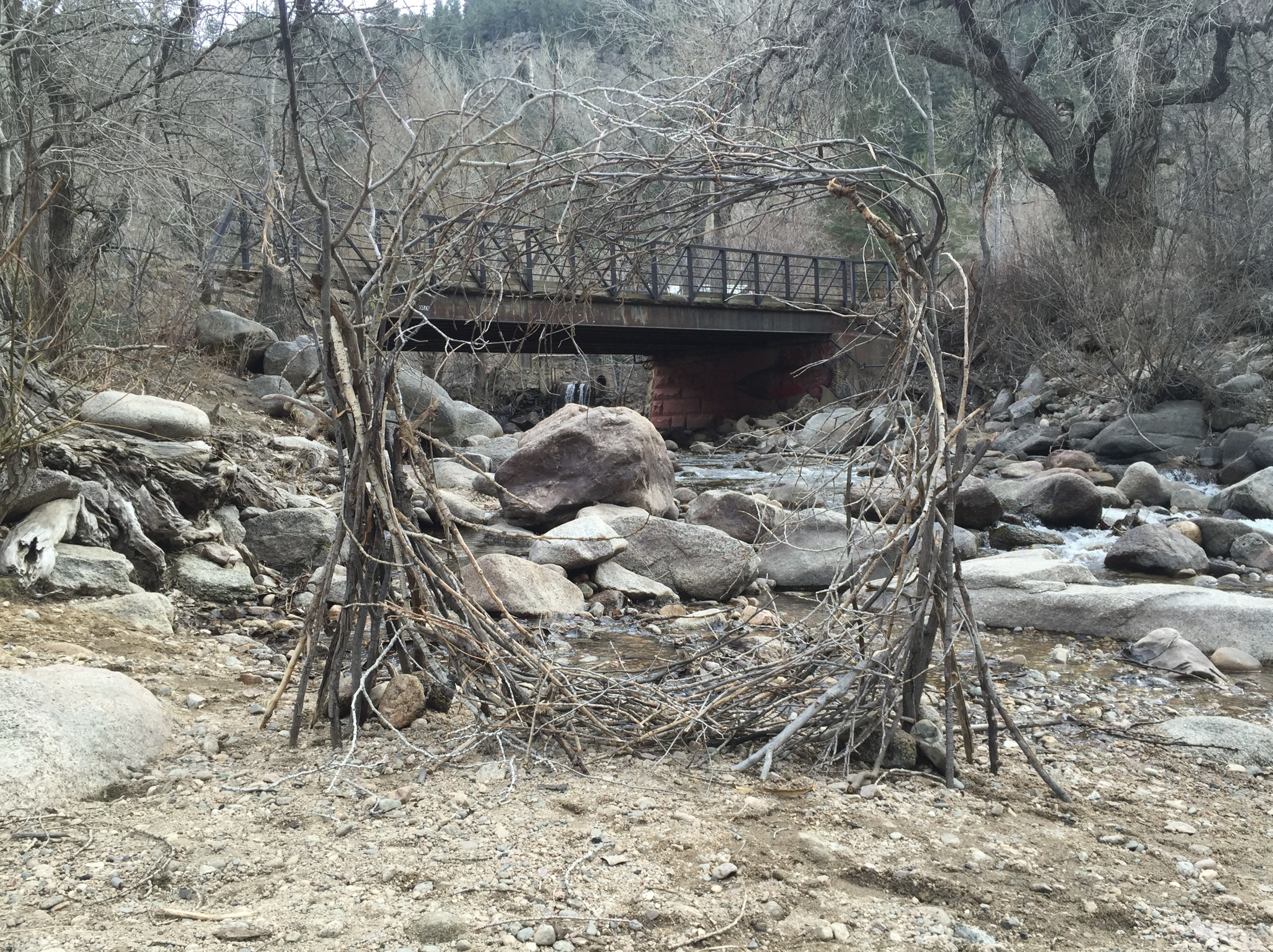
001- 'Looking Glass'. Boulder, USA [2016]
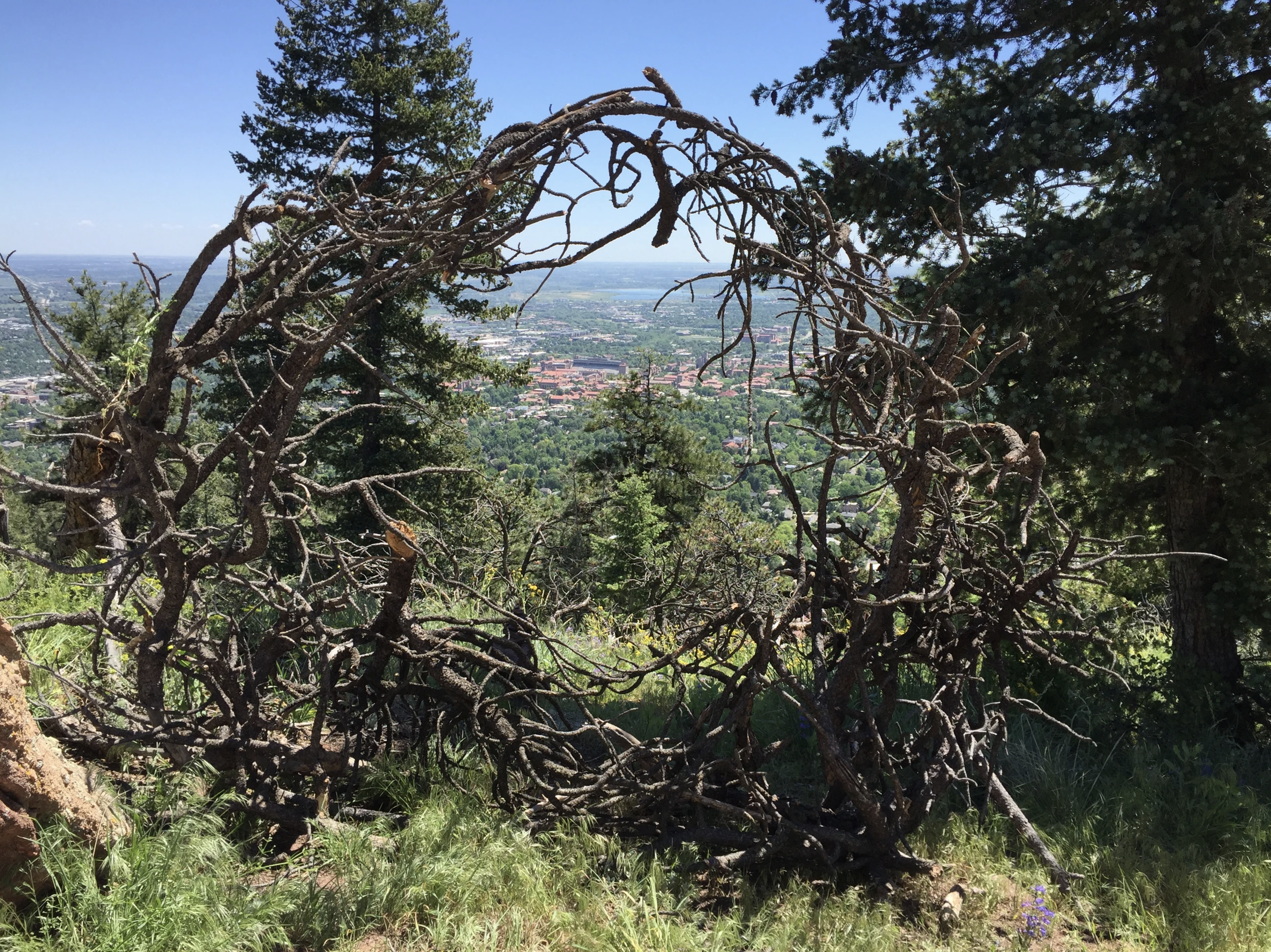
002- 'Folsom'. Boulder, USA [2016]

003- 'Sanctuary'. Castle Pines, USA [2016]

004- 'Platte'. Littleton, USA. [2017]
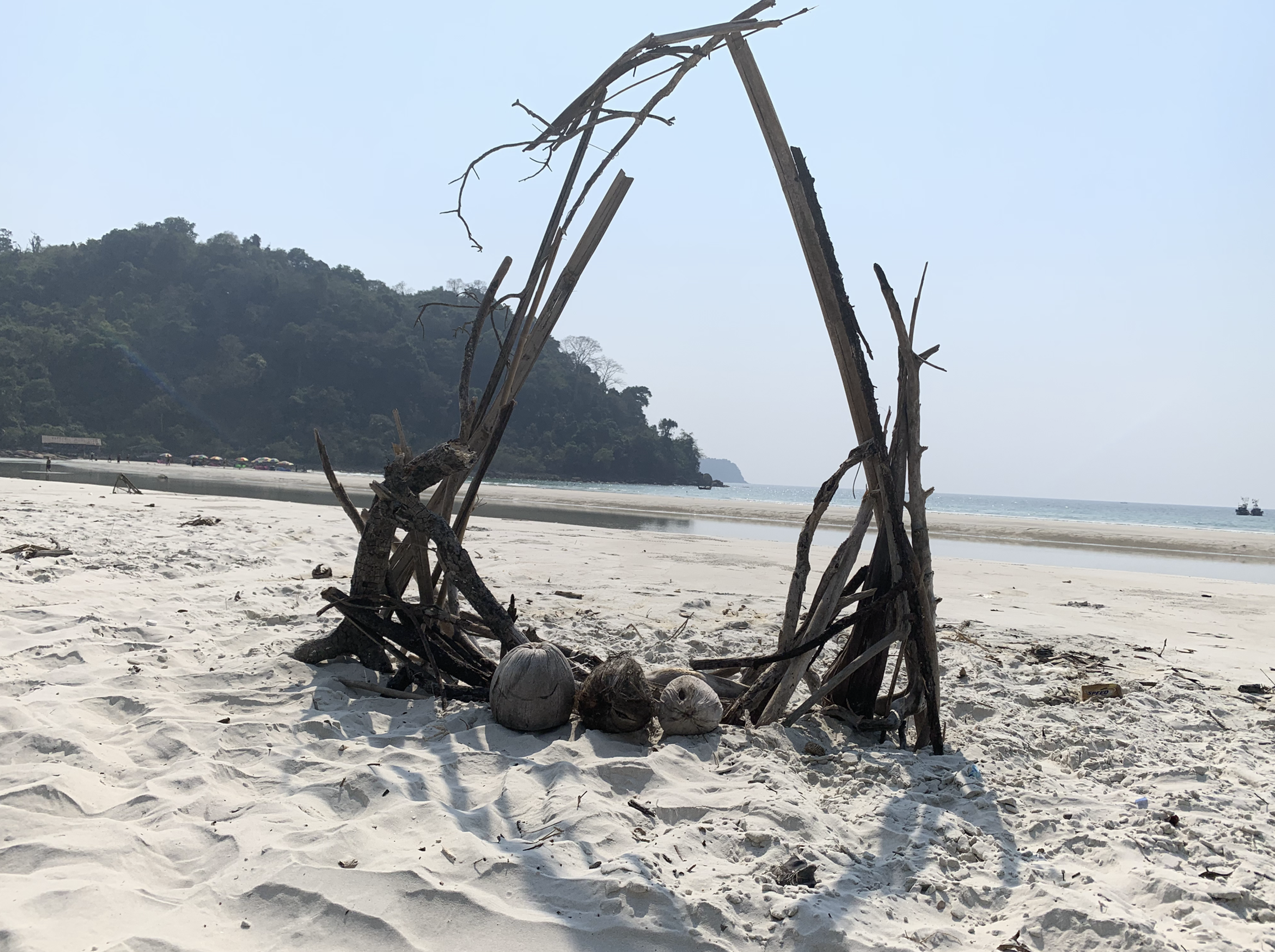
005- 'Grandfather'. Dawei, Myanmar [2020]
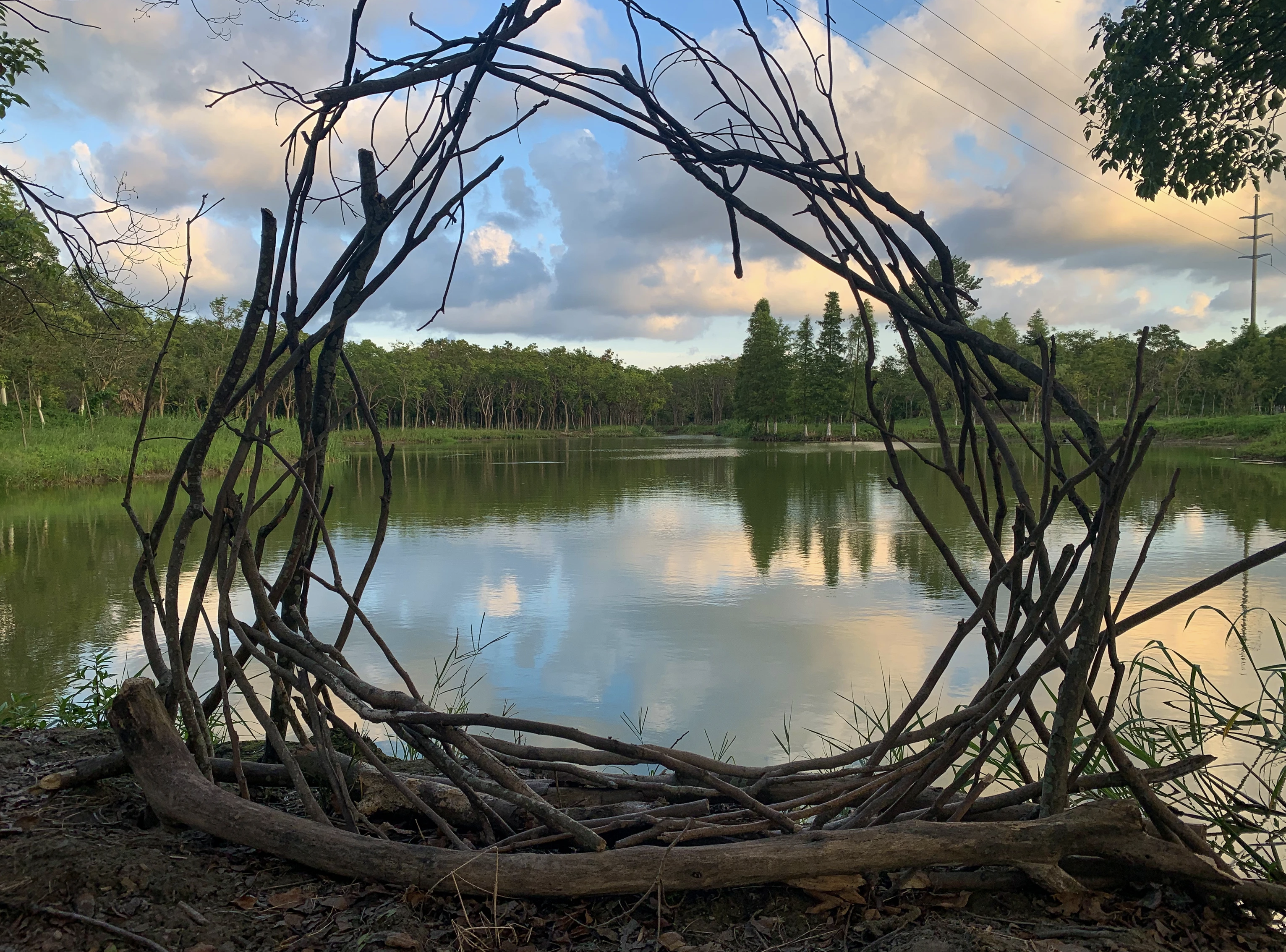
006- 'Chongming'. Shanghai, China [2021]
Originally published in 2016 by Hes.
Republished to habla.news/u/hes@nostrplebs.com on 11/27/2024 with slight edits.
Find me elsewhere:
-
 @ 469fa704:2b6cb760
2024-09-03 10:20:09
@ 469fa704:2b6cb760
2024-09-03 10:20:09In traditional investment wisdom, diversification is the mantra chanted by financial advisors worldwide. It's the strategy to spread risk across various assets to mitigate losses. However, when it comes to Bitcoin, some argue this principle might not apply in the same way. Here's why:
1. Bitcoin's Unique Value Proposition
Bitcoin, often dubbed "digital gold," has several attributes that set it apart from other investments:
- Finite Supply: With a cap at 21 million coins, Bitcoin's scarcity is programmed into its code, mirroring the scarcity of gold but with even more certainty. This scarcity can drive value as demand increases over time, especially in an economic environment where fiat currencies are subject to inflation.
- Decentralization: Unlike stocks or real estate, Bitcoin isn't tied to any central authority or physical asset that can fail or be manipulated by a single entity. This decentralization reduces the risk of systemic failure that affects traditional markets.
- Global Liquidity and Accessibility: Bitcoin can be bought, sold, and transferred anywhere in the world, 24/7, with internet access. This global liquidity means Bitcoin can be more easily converted to other assets if needed, somewhat reducing the need for diversification.
2. The Risk-Reward Balance
- Volatility as Opportunity: While Bitcoin's volatility is often cited as a risk, for the informed investor, this volatility represents opportunities for significant gains. Those who understand Bitcoin's cycles might prefer to ride these waves rather than dilute potential gains through diversification into less volatile assets.
- Long-term Appreciation: Historical data suggests Bitcoin has provided substantial returns over the long term compared to most traditional investments. If one believes in Bitcoin's future as a dominant store of value, holding a diversified portfolio might mean missing out on Bitcoin's potential upside.
3. Bitcoin as a Diversifier
Ironically, Bitcoin itself serves as a diversification tool within traditional investment portfolios. Its price movements have shown low correlation with stocks, bonds, and even gold at times, suggesting that Bitcoin can diversify an investment portfolio on its own.
4. The Philosophical Shift
- Trust in Code Over Corporations: Investing heavily in Bitcoin might reflect a philosophical shift towards trusting mathematical algorithms over corporate governance or government policy. Here, diversification within the crypto space might seem less necessary if one views Bitcoin as the pinnacle of what cryptocurrency should be.
- A Bet on a New Financial System: Holding Bitcoin exclusively can be seen as a bet on a new financial paradigm where Bitcoin becomes the standard. In this vision, diversification into other assets might be counterproductive.
5. Potential Result
Upon reviewing the arguments and characteristics, one might conclude that Bitcoin is pursuing a dual trajectory. Firstly, its value increases partly because it remains a novel asset, not yet mainstream among the general populace. Secondly, Bitcoin is poised to absorb the value preservation function from other assets. This means that individuals who invest in stocks, bonds, real estate, commodities, etc., primarily for their value storage capabilities rather than their intrinsic utility (such as residing in a property), might transition to Bitcoin. This shift could consequently diminish the demand for these traditional assets and increase the value of Bitcoin respectively.
6. Caveats and Considerations
- Not Without Risks: This approach isn't without its perils. Bitcoin's future is not guaranteed, and regulatory, technological, or market shifts could impact its value negatively.
- Liquidity Needs: Individual financial situations might require liquidity or income generation that Bitcoin alone might not provide efficiently.
- Emotional Discipline: A Bitcoin-only strategy requires immense discipline and conviction, as the emotional toll of not diversifying can be high during market downturns.
Conclusion
The argument for not diversifying if you hold Bitcoin hinges on its unique properties, the potential for high returns, and its role as a hedge against inflation and traditional financial systems. However, this strategy suits those with a high risk tolerance, a deep understanding of Finance, Economics and Investments, and a belief in Bitcoin's future dominance. For everyone else, while Bitcoin can be a significant part of a portfolio, traditional diversification might still offer peace of mind and stability. Remember, investment strategies should align with personal financial goals, risk tolerance, and market understanding. Always consider consulting with a financial advisor for personalized advice.
